Australian
and international
exploratory
performance and
media arts
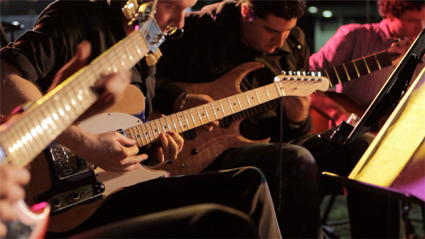
Amped, Chronology Arts and Ampere Quartet
photo Hospital Hill
Amped, Chronology Arts and Ampere Quartet
ANOTHER THURSDAY EVENING IN PENRITH: THE RETREATING SUN THROWING THE BLUE MOUNTAINS INTO SILHOUETTE, FLOCKS OF CHITTERING PARROTS SETTLING AMONG THE LEMON-SCENTED GUMS, A SEA OF BRAKE LIGHTS GLITTERING ALONG THE M4.
Meanwhile on the grass and raw dirt ‘community space’ between the plaza, the area’s venerable mall and the Joan Sutherland Centre (its more recent rechristening “The JOAN” sitting uneasily with its determinedly highbrow aspirations), groups of young people huddle in clusters, hanging out, catching up and filching cigarettes while experimental guitar quartet Ampere present Amped, a free performance of works recently commissioned through Chronology Arts.
Julian Day’s appropriately named Dusk matched the lengthening twilight, wrenching descending tones from Zane Banks’ solo electric guitar, punctuated only by the dull murmur of teenage courtship. Next was Steffan Ianigro’s Music of Symmetry, wailing dissonance counterbalanced with closely spaced, almost claustrophobic chords; a stepwise ascent suggesting impending horror. A strange atmosphere resulted, the well-mannered attention offered by dedicated nu-classical listeners on the grass sitting at odds with random yelps of female laughter, Ianigro’s careful conducting of the quartet (Banks, his brother Jy-Perry, Matt McGuigan and Mat Kurukchi) seeming overly precise beneath the fluorescent glare of the mall.
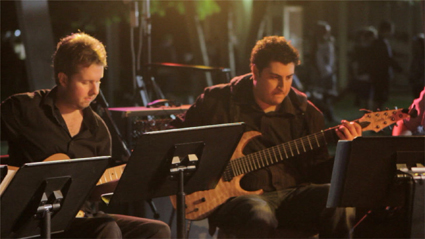
Matt McGuigan, Mat Kurukchi, Amped
photo Hospital Hill
Matt McGuigan, Mat Kurukchi, Amped
Fausto Romitelli’s TV Trash Trance, presented by Jy-Perry Banks on solo electric guitar, was apparently not to the liking of some, “Fuck you!” being yelled in the background— though it was unclear at whom the ‘you’ was directed. Although the volume was criminally low (Banks’ curly mop failed to flail nearly enough), the whirring loops of static established early in the piece provided ample basis over which to squeal and whine in the latter portion, the sound of a faulty connection being used to rhythmic effect before the lot collapsed into Lovecraftian sludge, eliciting some enthusiastic applause from at least one group of junior critics.
Alex Pozniak’s Small Black Hole, followed suit, the quartet gradually building a sliding, groaning texture redolent of the collapse of buildings or tectonic drift. Amid the shifting layers, tremolos suggested the distant ascent of a space shuttle, the hulking sound of aircraft engines emerging from dobro-style slides. While kids stole each other’s baseball caps, providing a clear invitation for a good chasing, a cataclysmic crash loomed in the air, the music spiralling towards an unavoidable impact before fading to nothing. Well received and highly effective.
The experiment in community engagement was rounded off with Phill Niblock’s Guitar two, for four. Emerging unhurriedly from its opening drones, the work was accompanied by a complementary black and white film (as is Niblock’s wont) featuring industrial imagery—gauges, whirring gears, liquid metal being poured—matched to piercing overtones, the guitar’s potential for violence finally unleashed, a blaring surface licked by flares of feedback perhaps unavoidably bringing to mind the consumption of workers’ bodies in Metropolis. And that was that, scattered applause dispersing amid puffs of underage smoke.
Aurora Festival of Living Music: Chronology Arts and Ampere Quartet, Amped, Joan Sutherland Performing Arts Centre, May 10; www.auroranewmusic.com.au
RealTime issue #109 June-July 2012 pg. web
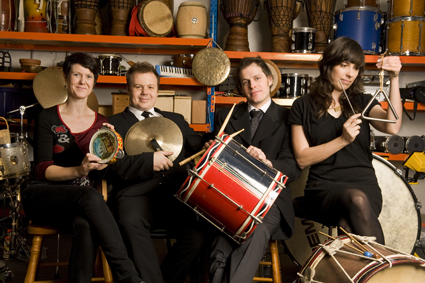
Synergy
photo Karen Steains
Synergy
SOME STRANGE CONJUNCTIONS THIS EVENING, AN INVIGORATING PROGRAMME OF NEW MUSIC PRESENTED BY SYNERGY PERCUSSION BEING PERFORMED ADJACENT TO A KICKBOXING AND PRO-WRESTLING MEET IN THE MAIN FOYER OF CASULA POWERHOUSE.
Though some seemed uncomfortable with this situation—“Oh my god!” the festival director was heard to mutter as muffled grunts and thuds mingled with the first sounds of James Rushford’s Go—the sound bleed added an element of indeterminacy to proceedings that was not entirely incongruous with the prevailing aesthetic, though the recording technicians from the ABC could probably have done without the challenge.
Rushford’s music conjured an eerie fragility, chirrups, squeaks, tinkles and chimes suggesting the cradle or even the emergent consciousness of the embryo. Utilising the soft hiss of gravel and sand as well as bowls of marbles, the performers busily created a sparse, playful texture, resting only as the swell of a pre-recorded electronica track, drowned the live sounds with menacing imminence—an effect somewhat undercut by the cheering next door.
No such problems with Alex Pozniak’s Groove Destruction. Taking its cues from “noise music [and] heavy metal,” Pozniak’s first piece for percussion aimed to explore the “extroverted” side of the ensemble, the four players attacking a phalanx of un-tuned drums with gusto. Establishing then annihilating rhythmic cycles, the piece moved through phases of instrumental delicacy before allowing the group to indulge an unadulterated joy in hitting things, Timothy Constable becoming so involved in the energy of the music that he inadvertently smashed a cymbal to the floor.
Inspired by Xenakis’ Pleiades, Amanda Cole’s Intermetallic provided a calming counterbalance. Writing for metallic blocks of ostensibly indeterminate pitch, Cole worked out at what frequency each vibrated, pairing “similarly dissimilar” tones to achieve a shimmering, not-quite-consonant effect. Growing from an almost-pure fifth, the piece seemed suspended in liminal space, redolent with the half-heard, the almost glimpsed. Armed with soft mallets, the performers offered some of their most sensitive playing of the evening, producing a gentle rippling that recalled all the dappled grace of the gamelan.
Synergy upped the energy once more with their own work, The Fives, with Alison Pratt taking a breather while Constable, Bree van Reyk and Joshua Hill returned to the drums. Using various items, including Constable’s suit jacket, as dampeners, the piece quickly descended into a Kurtzian nightmare, pounded skins suggesting the brutal certainty of a midnight jungle.
More whimsical, though perhaps less effective was Marcus Whale’s Puff, so called because of the composer’s instruction that toy harmonicas be breathed through by each performer for the duration of the piece. Gradually evolving patterns were articulated on wood blocks and thick golden cymbals to create an effect not dissimilar to “a year two’s birthday party,” as Whale drily put it. Although certainly unusual, it was difficult not to breath a sigh of relief once the incessant high-pitched whine of the harmonicas receded into silence once more, leaving nothing but the dull murmurs of ritualised violence next door.
Aurora Festival of Living Music: Synergy Percussion, performers Timothy Constable, Bree van Reyk, Alison Pratt, Joshua Hill; Casula Powerhouse, Sydney, May 5
RealTime issue #109 June-July 2012 pg. web
© Oliver Downes; for permission to reproduce apply to realtime@realtimearts.net
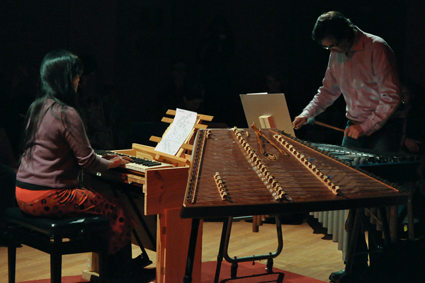
Terumi Narushima, Kraig Grady, Clocks and Clouds
photo Corrie Ancone
Terumi Narushima, Kraig Grady, Clocks and Clouds
WHILE FOLK OF VARIOUS ORIGINS CAME TOGETHER FOR THE STYLISED MACHISMO PROVIDED BY PRO-WRESTLING AUSTRALIA IN THE MAIN FOYER OF CASULA POWERHOUSE, EXPERIMENTAL PERCUSSION ENSEMBLE CLOCKS AND CLOUDS BROUGHT TOGETHER EXOTIC RITUALS OF AN ENTIRELY DIFFERENT NATURE IN THE MAIN THEATRE.
Drawing upon sources as diverse as Harry Partch’s 1973 work US Highball as well as his identification with the meta-culture of Anaphoria (a conceptual landmass whose inhabitants’ key characteristic is a “desire to be foreigners”), composer and general C&C head honcho Kraig Grady’s work, Terrains, Winds and Currents, provided an absorbing listen.
The centrepiece of the work was the set of twelve Meru Bars, an instrument of Grady’s own creation, that rose like mesas behind a harmonium and pair of vibraphones, all microtonally tuned. The Meru, which is fundamentally a set of gigantic bass vibraphone bars, lent the work a gripping solemnity, the hour-long through-composed piece remaining mesmerising for its duration, due in no small part to the skill with which it was approached by Grady as well as Terumi Narushima behind the harmonium and Finn Ryan on vibraphone.
With Narushima establishing a drone on the harmonium, Ryan trod carefully amid the Meru, striking each note with precise reverence, a liturgical quality being compounded by a single bowed note on the vibes. The sound of the Meru seemed to emanate from deep within the earth, its blended resonances suggesting imaginary ceremonies unfolding in forgotten caves. When this opening ‘terrain’ section closed with the exit of the Meru from the texture, the remaining instruments seemed bereft without its subterranean heat.
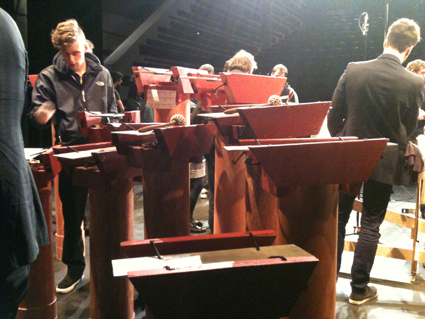
Meru bars, Clocks and Clouds
photo Gail Priest
Meru bars, Clocks and Clouds
This sense of desolation faded as Grady and Ryan generated a new urgency on the vibes, the harmonium providing flashes of melodic material, the effect being that of wind over wet rock, swift and indefinable. Indeed the music here was elemental, almost lysergic, the aesthetic bringing to mind the broken musician in Tim Winton’s Dirt Music. Consigned to hermitude, he finds solace in a makeshift drone, the sound of which seems to contain the world, “like the great open spaces of apnoea, the freedom he knows within the hard, clear bubble of the diver’s held breath. After a point there’s no swimming in it, just a calm glide through thermoclynes, something closer to flight. Within the drone, sound is temperature and taste and smell and memory, wucka-whang.” Grady seemed to be striving for something similar here, the rapidly oscillating tones suggesting rippling clusters of light, refractions in which the mind might become lost.
All of which would be so much twaddle were it not for the extreme discipline that Grady, Ryan and Narushima brought to the material, seamlessly coaxing distinct shifts in texture from the preceding flux. None more effective than the return of the Meru, the roiling bouyancy of the previous section giving way to a solemnity worthy of the disappearance of species, static vibe chords reverberating in isolation over the terrestrial groan of the bass bars. This was an hypnotic and moving song for the earth.
Aurora Festival of Living Music: Clocks and Clouds, Kraig Grady, Terumi Narushima, Finn Ryan, Casula Powerhouse, Sydney, May 5; www.auroranewmusic.com.au/
RealTime issue #109 June-July 2012 pg. web
© Oliver Downes; for permission to reproduce apply to realtime@realtimearts.net
In this video interview Australian Dance Theatre's Artistic Director Garry Stewart talks with Keith Gallasch about Be Your Self which recently played Sydney Theatre, May 31-June 3, 2012.
For more on the making of Be Your Self see RT94
For a review of Be Your Self in the 2010 Adelaide Festival see RT97
For a full profile of Garry Stewart and his works see realtimedance
RealTime issue #109 June-July 2012 pg.
© RealTime ; for permission to reproduce apply to realtime@realtimearts.net
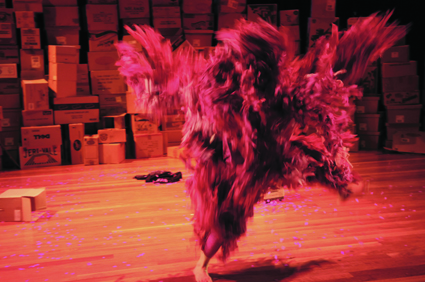
Lizzie Thomson, Panto, Campbelltown Arts Centre 2011 Dance Residency Project
photo Heidrun Löhr
Lizzie Thomson, Panto, Campbelltown Arts Centre 2011 Dance Residency Project
More and more dancing and more places to dance in Western Sydney: that’s the good news from Martin del Amo’s report in this edition of RealTime. The development of arts centres west of the city is one of the happy legacies of the Carr Labor Government. Campbelltown Arts Centre has a dance curator; in Parramatta FORM Dance Projects presents works in partnership with Riverside Theatres; and Blacktown Arts Centre includes dance in its performance program. Not only do these offer opportunities for dance artists and communities in the region but also engagements for Sydney-based artists as choreographers, teachers and mentors, enlarging the sense of community in NSW dance. There’s further good news from Angharad Wynne-Jones, the Creative Producer for City of Melbourne’s Arts House—Dance Massive will make its third appearance in 2013 thanks to the enduring partnership between Arts House, Dancehouse and Malthouse. It’s pretty much a sell-out event and a great opportunity for artists, audiences and presenters to connect. If you want to keep track of Australian contemporary dance, take a look at RealTimeDance on our website: this invaluable resource provides free access to all of the dance articles and reviews in RealTime from 1994 plus profiles of leading choreographers, video interviews and a feature on dance on film. Dance. Dance. Dance.
RealTime issue #109 June-July 2012 pg. 1
© Keith Gallasch; for permission to reproduce apply to realtime@realtimearts.net
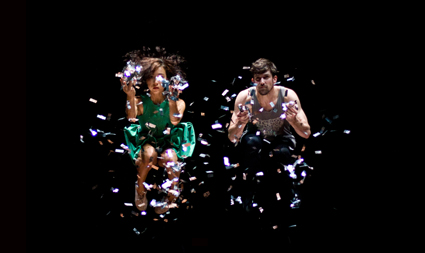
Kristina Chan, Timothy Ohl, SuperModern Dance of Distraction
photo Tim Thatcher
Kristina Chan, Timothy Ohl, SuperModern Dance of Distraction
FROM THE DARKNESS FOUR FIGURES EMERGE. THEY STAND CENTRED IN A LINE. THE LINE IS NEATLY FRAMED BY A SQUARE. FOUR FACES LOOK DIRECTLY OUT TO THE AUDIENCE, FINGERS TWITCH WHILE LIMBS TWIST. A CONGA LINE, OR STRANGE LIMB MACHINE.
Body parts hinge along creases: fingers, hands, elbows, arms—spoking out every which way. Their voices rise in unison from a whisper, repeating: “something is going on, while this is going on.” What is the “something?” What is the “this?” We are immediately drawn into choroegrapher Anton’s inquiry motivated by his question: “what is it to be human in our modern world?”
Pre-modern, postmodern and supermodern are terms turning upon and around the modern. The modern is a consistent descriptor of our present human condition, especially the cultural, economic and technological dimensions. If Frederic Jameson is right, then the modern is a reference point to be fragmented in its post-isms, nostalgically reflected from in its pre-isms, and tempo-spatially reoriented in its super-isms. SuperModern Dance of Distraction turns perceptively on the modern, describing the speeds, spaces and textures of human and human-machine relations in a techno-saturated world.
From formations of four to three observing one, the dancers (Kristina Chan, Timothy Ohl, Robbie Curtis, Sophia Ndaba) rapidly migrate from one configuration to the next, their histories wiped away with large Malevich-inspired blocks of light that scrape the black space. The lighting design (Guy Harding) is consistently constructivist in form, clean, deliberate, boldly white and, on occasion, epileptic and fractious.
When four, the dancers constitute a visual spectacle. In synchronous movements they generate images of a machinic ballet and tessellations of legs and faces spinning hypnotically in a Busby Berkeley water parade. In one sequence, the dancers raise white, hollowed-out squares above their heads, optically thickening their presence. Bodies calibrate: frames for looking through and graphically inscribing the space, frames to frame, shaping these carrier bodies into angular geometries. In another sequence, collapsed white trestle tables provide vertical surfaces that slide along rectilinear lines to block and bounce slamming bodies. The dancers take turns to operate the system, hiding, trapping and distorting the space: a concrete mediation implying a digital logic.
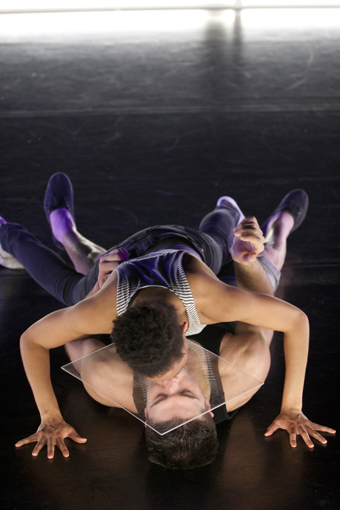
Robbie Curtis, Sophia Ndaba, SuperModern Dance of Distraction
photo Maylei Hunt
Robbie Curtis, Sophia Ndaba, SuperModern Dance of Distraction
In a more literal demonstration, clear perspex held between faces becomes a touch screen: connections are unequivocally established between fingers, glass and manipulated expression. The audience laughs rapturously (perhaps those with iPhone or iPad much harder). The perspex intercepts the kissing lips of two lovers in a moment of ‘distal loving.’ Pressed together they exaggerate the mediated space-time distance that Skype technology attempts to bridge. Their embrace lingering beyond comfortability, they take turns to ferociously straddle each other. The intimate made intensely public raises the real possibility that someone could be watching.
Communication. Upstage in blackout, torch lights flash intermittently, each emitting an idiosyncratic sound. We giggle in this close encounter of some kind. The dancers speak, sing and sound effortlessly, giving some vox to their pop. In an ingenious quartet of couples, they sing into long cabled microphones that swing and swoon like serenading lassos, supporting overall the seamlessly produced pop-inspired score by Nick Wales and Timothy Constable with vocals by Jai Pyne. Tracks of silky-synth smoothness ballasted by crisp hypnotic beats blow an asymmetrical fringe deeper into the eyes—all so distractingly modern.
Connection. The gags and prop-play exaggerate familiar scenarios, like the absurdity of the automated voice machine that never understands us. Caution must be taken, however, when the fast, fragmented and fleeting are both dramaturgical points of departure and justifications for the difficult experience in watching the episodic, disjointed and excessive. I wonder at what point structure and form should resist content. Luckily the more enduring solos reflect a deeper physical ontology (not a mere symptomatic engagement with a world on fast-forward) and so tap into what Raymond Williams calls the “structures of feeling.” Chan, delivered under a red haze, quivers in primordial gasps of arrest, every cell agitated in controlled contortions, tiny, gathered up to the bone, implosion imminent. Ndaba conversely convulses in jelly-like explosions, her jouissance, escalating into maddened laughter, a pressure-built response. Curtis wanders the stage with a disorganised body. Afflicted with “this something,” he is fuzzy and out of focus, snapping joints at the mercy of malfunction.
Refreshingly, there is nothing dystopic nor utopic said about ‘this’ condition, it is not Anton’s point. We are invited to experience, rather than critique. SuperModern is a work of fine collaboration, five dedicated years in development, with places to go, and hopefully in spaces where the carefully constructed geometries of the stage and lighting design can be realised.
FORM Dance Projects & Riverside Theatres, Dance Bites 2012: SuperModern Dance of Distraction, choreographer Anton, performers Kristina Chan, Timothy Ohl, Robbie Curtis, Sophia Ndaba, producer Michelle Silby, composers Nick Wales, Jai Pyne, Timothy Constable, lighting designer Guy Harding, dramaturg Joshua Tyler, set design consultant Julio Himede, Lennox Theatre, Riverside Theatres, Parramatta, March 28-32
RealTime issue #109 June-July 2012 pg. 4
© Jodie McNeilly; for permission to reproduce apply to realtime@realtimearts.net
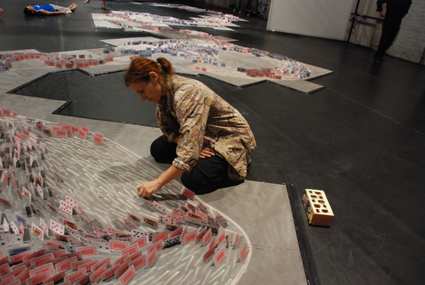
Vicki van Hout working on the installation/set of Briwyant
photo Marian Abboud
Vicki van Hout working on the installation/set of Briwyant
IN JUNE 2011, AFTER SEEING BRIWYANT I WROTE, “VICKI VAN HOUT’S CHOREOGRAPHY IS SOME OF THE MOST IDIOSYNCRATIC AND INVENTIVE SEEN IN AUSTRALIAN DANCE FOR A LONG TIME AND HER TEAM OF DEXTROUS DANCERS EXECUTE IT WITH HIGH PRECISION, UNBELIEVABLE ENERGY, HUMOUR AND ATTITUDE.”
Briwyant is touring to Melbourne and Brisbane, offering audiences the opportunity to experience something quite unique in contemporary dance. The choreographer, who also appears in the work, writes, “Briwyant is inspired by bir’yun: brilliance, shimmer and shine. In Yolngu traditional painting, bir’yun is the effect of intricate crosshatched patterns creating a sensation of shimmering movement over the painting’s surface, a manifestation of ancestral forces.” With her dancers, her own design and her media arts collaborators Van Hout creates resonating physical, aural and visual shimmerings in Briwyant. KG
Briwyant, Malthouse, Melbourne, July 4-14; Brisbane Powerhouse, Aug 1-4
RealTime issue #109 June-July 2012 pg. 4
© RealTime; for permission to reproduce apply to realtime@realtimearts.net
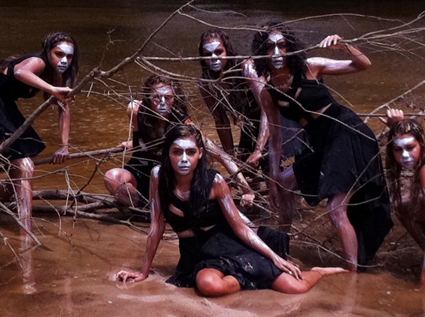
Jannawi Dance Theatre, Megamaras, film, Blacktown Arts Centre
photo Andrea James
Jannawi Dance Theatre, Megamaras, film, Blacktown Arts Centre
WHO WOULD EVER HAVE THOUGHT THAT WESTERN SYDNEY WOULD ONE DAY BECOME A BASTION OF INDEPENDENT CONTEMPORARY DANCE? SURE, THERE HAS LONG BEEN A TRADITION OF SOCIAL AND FOLKLORIC DANCE IN WESTERN SYDNEY, PARTLY DUE TO ITS STRONG LINGUISTICALLY AND CULTURALLY DIVERSE DEMOGRAPHIC. THERE HAS ALSO BEEN A LONG-TERM HIP HOP DEVELOPMENT IN THE REGION AND THE EMERGENCE OF PARKOUR CREWS IN BANKSTOWN AND THE FAIRFIELD AREA. BUT CONTEMPORARY DANCE?
It is true that artists such as Anandavalli (Lingalayam Dance Company) and Annalouise Paul have been presenting contemporary culturally diverse dance at venues like Riverside Parramatta for quite some time. And yet, there is no denying that in recent years a growing number of NSW-based independent dance artists have switched their attention to Western Sydney, where a variety of arts organisations and presenters offer ample opportunity to both develop and present new work. So what is the reason for this sudden boom.
According to Kim Spinks, who formerly managed state funding for theatre and dance and is currently Manager Capacity and Development at Arts NSW, there are several factors. One is the implementation of Arts NSW’s Western Sydney Arts Strategy, a long-range initiative drawn up and put into effect in 1999. It had a substantial funding program attached to it ($37m 2001-2010) and targeted all artforms. However, as Spinks points out, at the time the University of Western Sydney (UWS) offered the only tertiary dance degree in New South Wales which became a factor for organisations such as Ausdance NSW to invest in dance in Western Sydney and attempt to build an infrastructure around it. Ironically, the dance course at UWS folded after a few years but, by then, the rise of dance development in the area was well on its way.
Another great shift occurred through a major capital commitment of over $20m from the Carr government in the mid-2000s and a combined spend of over $55 Million from state and local governments. It affected the arts centres in Campbelltown, Blacktown and Casula and involved turning visual arts spaces into multi-art centres. As a result several of these organisations incorporated dance into their programming. So let’s have a look at some of the key players:
form dance projects
FORM Dance Projects, known until recently as Western Sydney Dance Action (WSDA), was founded in 2002, evolving from an outreach initiative Ausdance NSW set up in response to the Western Sydney Arts Strategy in the late 1990s. Since its inception, the organisation’s most important partnership has been with Riverside Theatres under the directorship of Robert Love. Initially an auspiced project, FORM now operates independently from Riverside but presents work in partnership with them. The cornerstone of its presentation program continues to be the long-running Dance Bites series. Initiated by WSDA’s inaugural director Kathy Baykitch in 2003, Dance Bites has gathered momentum in the last couple of years with highly successful productions such as Narelle Benjamin’s and Francis Ring’s Forseen, Craig Bary’s and Lisa Griffith’s Side to One (see interview, RT105) and most recently Anton’s SuperModern Dance of Distraction (see p4). Later in the year, Tess de Quincey will present Framed, a new instalment in her acclaimed “embrace” series.
In spite of the increasing number of high calibre artists seeking out FORM as presenting partner, the fragility of the organisation’s funding situation is an ongoing concern for its current director, Annette McLernon. She explains: “FORM’s core funding is very secure. We have just received triennial funding (2012-2014) from Arts NSW and Riverside Theatres is a key partner. However, the project funding for the Dance Bites presentations is less certain as the producers or individual independent choreographers are still very dependent on successful funding to develop and present their works.”
However, FORM does not only present work, it also offers a significant education program. Its various initiatives include master classes for young choreographers from Western Sydney and the popular Learn the Repertoire, See the Show series, as part of which presenting artists teach workshops and offer post show discussions.
campbelltown arts centre
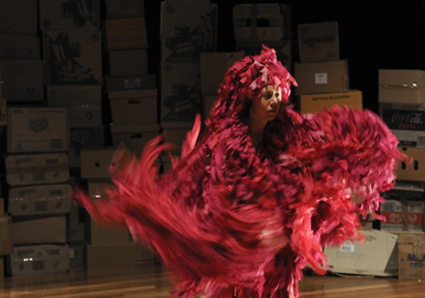
Lizzie Thomson, PANTO
photo Heidrun Löhr
Lizzie Thomson, PANTO
In the wake of the redevelopment of Campbelltown Arts Centre (CAC) into a multi-arts centre, Lisa Havilah, its director 2005-2010, put a five-year strategic plan into action that included dance alongside visual arts, theatre, new music and live art/performance. For the first couple of years, dance at CAC was mainly presented in the form of individual projects. This changed when Emma Saunders was appointed as dance curator in late 2008. She was given the brief to develop a three-year framework for a Contemporary Dance Program and curate artists as part of it. Saunders, a well-respected member of the NSW independent dance community, best known for her work with the irrepressible dance trio The Fondue Set, rose to the challenge and put a multi-strand model in place which combined long-term development projects and residencies for local and international artists with the presentation of new work, both full-length pieces and short work commissions. Saunders says about her curatorial approach, “The CAC Contemporary Dance Program promotes interdisciplinary and intercultural projects. We support artists interested in questions around process, form and community engagement.” As a prime example Saunders cites the work of dance artist Lizzie Thomson who collaborated with an ensemble of community participants drawn from local amateur dance and theatre companies during her 2010 residency and then featured them in the finished work, Panto (see RT105), the following year.
Now in its fourth year, CAC’s 2012 dance program will culminate in a three-day festival project in October titled Oh! I Wanna Dance With Somebody. It will showcase outcomes from the program’s various strands and include 20 Australian and international artists as well as 150 Campbelltown locals across 15 projects, occupying the entire arts centre.
blacktown arts centre
Unlike Campbelltown Arts Centre with its variety of artform specific programs, Blacktown Arts Centre (BAC) runs a multidisciplinary contemporary arts program, of which dance is part. According to Kiri Morecombe, Acting Performing Arts Development Officer until recently, BAC is largely focussed on the development of new work from local and Western Sydney artists. In 2010, for example, Katy Green, a young performance practitioner born and raised in Western Sydney, was awarded a three-week residency as part of BAC’s performing arts program to explore cross-artform collaboration together with composer and sound artist Tom Hogan. A second stage development will take place at BAC in August this year.
Another dance project recently supported by BAC was Megamaras by Indigenous dance artists Peta Strachan and Rayma Johnson, together with media artist Michelle Blakeney. Based on the story of Daringyule (dancing woman), who broke the law, and combining choreography with projected underwater imagery, the work was developed in residence at BAC in late 2011 and pitched at the Australian Performing Arts Market earlier this year. BAC has an Aboriginal Arts Development Officer, Andrea James.
Asked about the future of dance at Blacktown Arts Centre, Director Jenny Bisset, says, “With a stronger emphasis on dance in recent years, we have started to build an audience and expectation for this and will continue to look for new work through our performing arts residency program and our Aboriginal Arts program. We are particularly interested in hybrid work as we continue to build cross-disciplinary programming.”
youMove company
The Parramatta-based youMove Company was founded by dance artist Kay Armstrong in 2008, starting operations at the beginning of 2009. It is designed as a platform for emerging dancers and graduates. Even though strongly supported through a partnership with Western Sydney Dance Action, things didn’t go smoothly for Armstrong and her troupe initially, having missed out on funding during their first year. “The first year was about surviving basically,” Armstrong says. “The focus was on finding platforms for presentation, building our reputation and achieving industry credibility.” Gradually developing a repertoire of short works choreographed by herself and various independent choreographers such as Anton and Ian Colless, Armstrong worked tirelessly in the following years to raise public awareness for the company and create performance opportunities for her dancers. The company’s many gigs have included performances at the 2010 Under the Radar program (Brisbane Festival) and presenting work in a double bill with the Sydney Dance Company in Parramatta Park as part of the 2011 Sydney Festival. It didn’t take long until the company started to attract project funding and the business side of things consolidated. Last year the company incorporated and received program funding for the first time.
YouMove’s activities now comprise three strands: performance, mentorship and education. Of these strands, education is the most recent addition to the company’s program. It includes performance presentations and post-show workshops by the company for students (5-12 years) in Western Sydney schools. It’s an area Armstrong feels especially passionate about: “I’m a huge proponent of the idea of education being a transformative process. So what I’m hoping to do is to create and build future dance audiences. Now, the way to do that is to hit them young, you’ve got to get into the schools when they are at an impressionable age and give them really positive, expansive, unique, imaginative, inspiring dance experiences.”
RealTime issue #109 June-July 2012 pg. 2
© Martin del Amo; for permission to reproduce apply to realtime@realtimearts.net
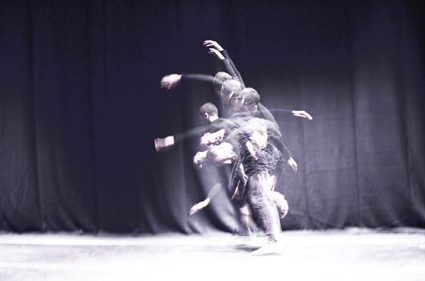
Matthew Day, Intermission
photo James Brown
Matthew Day, Intermission
THE FIRST TWO PARTS OF AN EVOLVING TRILOGY BY SELF-CHOREOGRAPHING DANCER MATTHEW DAY WILL SOON BE JOINED BY THE MUCH-ANTICIPATED THIRD WORK, INTERMISSION, AT THE PACT THEATRE IN SYDNEY. THOUSANDS AND CANNIBAL WERE AT ONCE CONTEMPLATIVE AND VISCERAL, MINIMALIST AND COMPLEX. I SPOKE WITH DAY ABOUT THE NEW WORK AND ITS RELATIONSHIP WITH ITS PARTNERS.
What was your motivation when you started out on the trilogy?
In Thousands (2010; see RT100 I was interested in stillness because I wanted to go back to something very simple, to what I was thinking of as the ‘degree zero’ of choreography because it was my first solo and I’d been reading Andre Lepecki and his writings on Nijinsky’s use of stillness. I was also interested in considering my position in dance history. So [it was] something about being still to allow other things to enter the space, for the audience to read the work in their own way—and also for other references to land on the body. Some of these I specifically choreographed into the work. There are Nijinsky references and then other things it’s up to the audience to project. But certainly it was about stillness or slow movement.
Steve Paxton is another reference and Vanessa Beecroft’s work—those models standing in galleries for long periods of time. It’s a bit different from Paxton but I thought, isn’t this interesting how there’s an unconscious choreography going on in the body.
When you say “unconscious choreography,” do you mean in the everyday or in stillness in dance?
My next project will be looking at the everyday. But I think in this series, the trilogy, they’re constructed theatrical settings. What I found looking at stillness was this vibration that’s happening without me producing it. What I’m doing is trying to be still. I try to think of this as the surface of the choreography or my intentional or conscious choreography as a score about stillness and how I do that.
That stillness is, I think, still evident in Cannibal (2011; see RT 102) although you’re moving in quite a large circuit. It’s still slow and there’s a sense of vibration.
The vibration that came up from underneath the stillness is what I consider the unconscious choreography, just in the sense that I’m not actively producing it.
Is that because, for instance, in the starting position of Thousands, you’re putting your body in a fairly stressful position?
The whole thing is stressful but I’m not interested in stress.
Is it more about intensity then?
Intensity. My objective with the piece is not to show any effort and to be as calm as I can be and not to fatigue. And the work should never look like I can’t continue. I’m not interested in failure or fatigue in that sense.
So they’re not endurance works?
They’re more about duration and what can happen if we just look at one thing for a long time and how something can change and how that reading of the same thing can change further if we sit with it for a long time. And I think this also came about by watching dance, where I feel like the dancers have just had a big shot of adrenaline backstage, run onto the stage and just go like move, move, move, go, go, go, counting to the count. Not that all dance does this any more. So it was really me challenging myself to make a choreographic work and not just dance, because that’s what I’d been trained to do and that’s what I love doing. So I got really excited about this vibrational quality.
It’s interesting that you made an observation about the stillness of Cannibal because while I was working on this, I started to think about the difference between the works. In Thousands I feel like I’m working very fast on a conscious level to refresh my attention and my perception. It’s happening very slowly and, to keep it alive, I need to work very fast, whereas with Cannibal, because there’s quite a lot of movement I drop into a much calmer place internally. Maybe that’s what you’re talking about.
The third part of the trilogy, what’s that springing from?
On the last day of Cannibal I had two performances to do and I’d done 10 shows altogether and it’s quite stressful to do twice in one day—or so I thought. But on the very last performance on the last day, I said to myself before I started, “Just take as much time as you need. This one’s for you. Find out what you can about the work. Do it and get what you can because this is the last chance you’ll have for a while.” And, while I was performing I started to discover a wave in the vibration. It’s just a very simple thing about the weight shifting between the right and the left foot, the transference of weight across the body and across space—the eternal wave that’s present underneath that. Waves are a pretty basic physical property and I just started to realise that it was present. It’s a feeling. So that kind of indentified that this would be the next thing. This is the future. The works each revealed themselves in different ways.
Thousands and Cannibal are both very sculptural, but Thousands is almost on a fixed point while Cannibal has a circuit and the works correlate with very different stage design and deployment of sound. In what way have you approached Intermission?
It’s a really good distinction you’re making—the movement’s relationship to pathways in space. I feel like maybe what I do is, I think about a wave—and it’s very naive the way I work. I just say okay, you’re going to do waves in the body for 10 minutes and see what happens and then I do it and I think this bit was interesting, or this happened. So I’ll do it again and maybe notice it again and just keep working. I’m realising this is not the way everyone works. I just do the piece when I rehearse. I just do the thing for about as long as I can. I do it for 30, 40 minutes and, okay, that’s what the thing is today. And then I slowly shape it over time.
I work with duration, which is the way I need to because it’s very hard for me to work on, say, a section. I think maybe the way a lot of people work is on sections: ‘I’m interested in this leg thing or this image here’ and maybe they look at ways of composing the order of these things. But when it comes to really making choreography and composing the thing, it happens as I’m doing it in the time that I’m doing it—performing the wave and seeing how it talks to me.
And in that process do you discover the space that you will occupy?
Yes. At first I start working just physically on, say, a wave and don’t worry too much where it goes in space. Then there’s a point where the pathway becomes the important thing that then determines the movement. So there’s this back and forth relationship. For example, I’ve had two main development periods and in the first I didn’t really think about the spatial map until the last couple of days and then started playing with something, mainly because I was having a showing. Then I had the Culture Lab residency [at Melbourne City Council’s Arts House] for two weeks and I kept that map and I said, okay, this is the map, how can I explore this as much as possible. Now I’m about to go back into the PACT Theatre [in Sydney where Day performed Thousands and Cannibal] and I’m actually going to question the pathway in space because I know more about the wave by articulating a pathway. Now it’s time to find out, to do it in reverse. There’s this constant negotiation between the pathway in space and the movement itself. In some ways they’re quite separate things.
There’s a design element that seems quite integral to your work. When do you start thinking about how you’ll create that space beyond the body?
Quite early I think but I don’t make decisions till quite late. With Thousands it was very pragmatic: I’ll make a piece with one spotlight and a backing track. That’s about touring the work; it’s about sustainability; it’s about keeping things simple; it’s about wanting the work to exist on its own terms choreographically. But these are also design principles: It’s also about minimalism. When I first did Thousands, it was in Northcote Town Hall, which has a massive gold velvet curtain. So I think of Thousands as a gold piece even though when it was shown at PACT, where you saw it, it was against a black wall. I wear gold sneakers. When it was at Dance Massive, it ended up looking quite orange.
So, what’s the future of the trilogy in terms of design. Cannibal is very white—floor, walls, outfit, your hair.
I’m trying to get white curtains made for Cannibal. So, they are in a sense an inversion of the usual black curtains of a space. Then the idea is that I can just request white tarket and chuck the white curtains in a normal touring suitcase. If that’s possible, then the future of Cannibal is quite open. And the thing is in Europe there are lots of white spaces anyway. As for the future of the trilogy, I’m going to present Thousands again in Melbourne in October and Cannibal in November and, hopefully, Intermission at Dance Massive in 2013. So this will be the first time that they’ll all be done within a five-month period and I think that’ll teach me a bit more about what it’s like to perform them back to back. The idea would be that they would be programmed across three nights. It’s impossible to do them all in one night and I don’t think it’s desirable either. They can tour as a trilogy across three nights so that each work has its own independence.
Why the title “Intermission”?
Intermission is about always being in the middle: never being here or there, never arriving completely, always being in a state of in-betweenness or becoming. It also problematises the idea of linearity. What is the order of these works? Even though we started out talking about how one work seeds the next, I found out things about Thousands by performing Cannibal. The works start to speak to each other in different ways. There are structural things I’ve discovered in Intermission that I’m going to retroactively apply to the other works. So they start to have this non-linear discussion with each other, which I find exciting.
The reason I liked the title was that I had this idea. We go and see a show and I was thinking of one of these big old amazing pros arch theatres. Everyone’s in there for the first half of the concert or ballet. And then everyone leaves. They’re outside drinking champagne or whatever in the foyer. And I just had this sense of what happens in the theatre in that intermission when no one is there. I like this idea of the life of the theatre without an audience, this in-between moment. What is the energy of this space at this moment? That’s what I’m interested in, that invisibility, the silent thing that you don’t actually see. That suspended moment of energy and stillness.
Matthew Day, Intermission, PACT Theatre, Sydney, June 19-30; http://www.pact.net.au/
RealTime issue #109 June-July 2012 pg. 3
© Keith Gallasch; for permission to reproduce apply to realtime@realtimearts.net
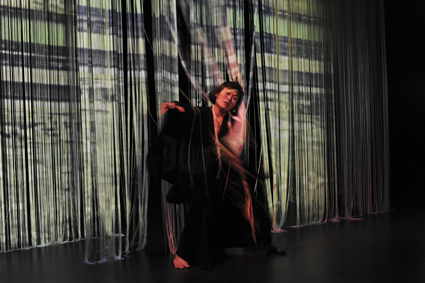
Yumi Umiumare, EnTrance
photo Heidrun Löhr
Yumi Umiumare, EnTrance
YUMI UMIUMARE DANGLES US WITHIN INNER AND OUTER WORLDS. HER BODY MEDIATES A UNIQUE COLLISION OF MOVEMENT STYLES, WHILE HER WORDS AND TEARS INVITE US TO REFLECT IN THE FACE OF OUR BEING, “I SWALLOW MY MIRROR WHILE I’M WATCHING MYSELF.”
EnTrance does not merely ask us to observe energetic transformations through word, rhythm, ritual and symbol; it navigates us through hyperbolic worlds that are indeed nothing other than who we are. Emotion, memory, everyday mediations and constructions, life, birth, death, spirit and love: EnTrance brings us home to ourselves.
Umiumare’s opening movement vocabulary is a heavy, slow shuffle; her head is tilted upward, oriented toward something in the distance. She seems to bear a cumbersome weight—a story involving a cat, a dusty window and the loss of her fingertips into a garden with a fountain that explodes with feathers of rich colour. The stage fills with projection, rolling out a bustling metropolis, all reds, yellows and blues. Umiumare absorbs the street rhythms like a blank canvas. We see it on her dress. Her dance is a strange mix of ‘go-go traffic conducting,’ forearms hinged at the elbows creating vectorial variations to wave the world in, and air-like pistons pumping the forces around. This pattern is punctuated by reverse star-jumps, arms straightened like bolts into a horizontal crossbar. Her martial stance complements five, six-foot-high erect masts, sails tethered at the waist. The image is positively nautical. Untethered, single threads fall outward to form a broken surface the width of the stage, a versatile design by installation artist Naomi Ota that metaphorises fragility, malleability and unpredictability.
Bambang Nurcahyadi augments each vignette with large-scale visuals, projecting scenic and urban backdrops and swirling, animated Umiumares, replicated in various guises on the screens. In one scene, the dancer, dressed in a black leather jacket covered with flashing thorns of tiny embedded LEDs (design David Anderson), thrashes about in concert with obnoxiously loud post-punk noise—guitar pedals of assault—and picks up a large LCD screen to use as a face mask. The image is a portrait of her inner Avatar, scratched and irritated by the superfluity of a hyper-existence.
Drifting into a different rhythm, Japanese characters cascade delicately down the threads spilling onto an umbrella held by Umiumare, now looking like a bleached-white Mary Poppins. She weathers the words in patient reprieve. We too wait, soothed, suspended, somewhat transported.
Umiumare tells us that in Japanese there are different names for different tears. Each type, or mode of crying, is named after the sound that the crier makes, an onomatopoeic nomenclature. “Cachuckachuck, cachuckachuck”, the crumpled wail of a woman who has lost her child. Tears like rain soak the cheek. I am reminded of a scene from Michael Haneke’s The Time of The Wolf where a mother weeps inconsolably at the death of her son. Sounds of soaking.
Umiumare emerges like a fake plastic flower to entertain us with a love song, singing off-key. We giggle along with this awkward serenade. When it ends we are plunged deeper into her primordial wail. She transmits something not belonging to her, something more universal; there is deep silence in the sonority of grief.
A bird of paradise, Umiumare engages with the ritual and dress of her traditions. A transcendent phase, almost ecclesiastic, she raises her arms, a stole of red and gold draped symmetrically over her arms. I think of the fountain and the cat that ate her fingertips. All images, words and sounds that formed disparate episodes momentarily speak one language. I am home.
Tangled in threads, Umiumare paints her body white with aggressive brush strokes. This final costume change shatters the coherency of two-dimensional image, each screen torn down by this monster of chaos. She stirs the space. Medusa. Her feet rooted, the base of her tongue driven from pelvic depths, viscera like magma ready to overflow. Her body is gnarled at the joints like an ancient tree still growing. Nothing more present than presence itself. Beneath the hypnotic birdcalls, drums and didgeridoo, the sorceress licks with flickering tongue those fingertips. Her eyes unnaturally wide, each a window open for all to see, each an opaque window reflecting back. Transformation.
For the most part I felt overwhelmed by the excessive mélange of cultural influences, aesthetic choices and movement styles. But by the end, experienced an unmooring of something indescribable, a deeper unitary movement that for me is a rare occurrence in performance. Entranced.
Performance Space, Dimension Crossing: EnTrance, performer, creator Yumi Umiumare, collaborator Moira Finucane, costume designer David Anderson, lighting designer Kerry Ireland, sound designer Ian Kitney, media artist Bambang Nurcahyadi, installation artist Naomi Ota; Performance Space, Carriageworks, Sydney, April 18-21
RealTime issue #109 June-July 2012 pg. 5
© Jodie McNeilly; for permission to reproduce apply to realtime@realtimearts.net
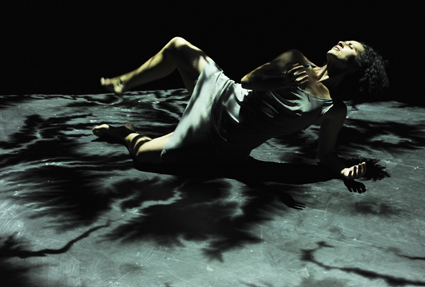
Victoria Hunt, Copper Promises: Hinemihi Haka
photo Heidrun Löhr
Victoria Hunt, Copper Promises: Hinemihi Haka
VICTORIA HUNT’S COPPER PROMISES: HINEMIHI HAKA IS A ‘THEN’ MADE ‘NOW,’ A PAST CONJURED IN A PRESENT THAT WALKS THROUGH PORTALS INTO ONGOINGNESS. IT IS EPISODIC, WITH EACH ACT DETERMINED BY DISTINCTIVE BUT MUTATING LIGHTING STATES THAT ARE BOTH SHARPLY AESTHETIC AND THICKLY ATMOSPHERIC, AND BY AUTOCONVOLUTED SOUND THAT SPEAKS, SHATTERS, RUMBLES, ROARS, GRATES, GRINDS AND TRICKLES.
At the same time Hunt’s body moves amidst light and sound as one of these elementals; sometimes swept along or drawn by light, sometimes tortured by compacted screeches, possessed of sound. But at other times it is her moving body that controls the skies.
Copper Promises: Hinemihi Haka is a condensation of Hunt’s journey back into her Maori ancestry. [Hinemihi is a female ancestor and a ceremonial house connected with Hunt’s cultural heritage. Eds] It is a lament of alienation and a celebration of repatriation. It is a finding, a gathering, a travelling, a wandering and a landing. It is a work built over “a decade of embodied research across three countries…collecting video imagery, recording sound and interviews and making a series of short dance works” (program notes).
So those voices and actions and images that elude specific understanding are still understood: clarity is born of heartfelt and rigorous research, stretching out across continents and generations and coming back to a body. Victoria Hunt’s body as the human centre of Copper Promises becomes a place, reconciling the apparent conundrum of a cultural emphasis on “collectivity” and “community” (program notes) with this very solo work by dancing with ancestors and giving voice to ghosts which hang behind and around Hunt’s fleshy contortions.
There were so many resonant moments: like the dust cloud that seemed at first like smoke but had the shape of a figure, haunting on invitation, or the ghostly bride who pads solemnly soft along an aisle of white, her hair gently steaming. But two crescendos screamed louder than them all.
After another train has rattled past Carriageworks’ Track 8, after the slow lateral stalking of the stage by a nearly invisible body with only half a face, after the ghosts have whispered softly then echoed loudly on top of rumbles that gently shake space, after Hinemihi body has pushed itself into becoming rock, metal and rubber, after this molten non-body has bent, opened, twisted and sunk, Hunt, her skin glistening with sweat, spits gorgeous globules of beautiful saliva into the air and her hands become ‘pois’ (Maori performative devices which are swung by hand. Eds) that flick and twitch into a madness-trapped claustrophobia in a sharp white box of asylum light hanging in a sea of black, until a cloudy sky greyness drifts her and her madness into near invisibility again.
Later. After disappearing into a chasm of nothingness, Hunt’s chin and mouth appear, tattooed and moving. Her mouth and the mouths of the soundtrack speak in strangled distortions that are electronic and ancient, now and then. Hunt is a mask made by light, speaking in tongues with the rhythms of sharpening breath and dog screams, a sonic mountain of intolerable cruelty that hurts with its disturbing and frantic energy. Then, it is gone.
Afterward, it took some time to leave the silences and roars of Copper Promises behind. The past had taken hold of the present, so the world became liminal, a neither here nor there, a then and a now.
–
Performance Space, Dimension Crossing: Copper Promises: Hinemihi Haka, concept, choreography, dance Victoria Hunt, lighting Clytie Smith, sound James Brown, producer Fiona Winning, Performance Space, Carriageworks, Sydney, May 4-12
RealTime issue #109 June-July 2012 pg. 6
© Pauline Manley; for permission to reproduce apply to realtime@realtimearts.net
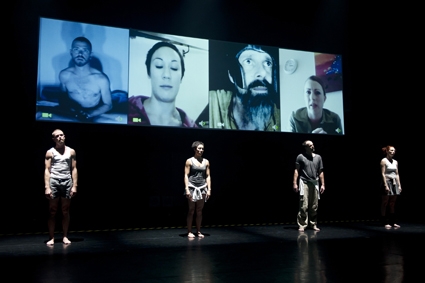
l-r Ninian Donald, Veronica Shum, Tim Rodgers, Jessica Statton, Involuntary
photo Sam Oster
l-r Ninian Donald, Veronica Shum, Tim Rodgers, Jessica Statton, Involuntary
KATRINA LAZAROFF’S INVOLUNTARY SPEAKS OF HOW WE ARE ORDERED AND SHAPED THROUGH THE VARIOUS MECHANISMS OF COMMUNICATION WE ENCOUNTER OR USE, BEGINNING, TONGUE IN CHEEK, WITH PROJECTED TERMS AND CONDITIONS FOR THIS PERFORMANCE. THESE BECOME MORE AND MORE ABSURD AS THEY ARE SCROLLED THROUGH.
An extended dance sequence, clearly drawn from an investigation of involuntary movements, follows with toe-tapping music. The dancers are then asked a series of questions. They are clearly under duress, the suggestion being that they need to pass some test. They bend and twist in response.
The great appeal in Lazaroff’s dance projects lies in the humour that informs each performance and her determination that the dancers appear as ‘regular people.’ These two aesthetic choices are not unrelated. In Involuntary she borrows from clowning to achieve the various vignettes and the performers also frequently address the audience directly. Four ladders are used to great effect. Climbing up a ladder becomes a clown routine of entanglement because of the obstacles presented by ‘the OH&S supervisor.’ A dance routine is made from spectator behaviour, what we do in the privacy of lounge room television watching. We also watch the dancers on Skype—private projections of self—talking, gaming, masturbating.
Two dancers have a conversation via computer in text language. This is shown to be a little limiting. They also meet up via video on their mobile phones—a fairytale image as these two tiny screens dance together to music box tinkling. Always we see the struggle for the individual to squeeze into narrowly determined situations and behaviour, longing to break free of constraint, as exemplified beautifully by an office chair routine that starts with listening to a telephone answering service and becomes a ballet of flight as the dancers give up waiting. The performers are equal to this task—engaging to watch, physically skilled and bold.
The knock-about humour, easy polemic and engagement with the audience reminded me of the Aussie performance aesthetic championed and immortalised by Circus Oz. At one stage the dancers compete for air time to tell us their complaints. An audience member is then invited on stage with the performers to speak of what infuriates them.
The technology is used skillfully. The witty projections are seamlessly and elegantly woven into each vignette. The music is fun. The dance material in solos, duets and quartets captures the awkwardness of being not quite in control of one’s body. The final duet is a simple homage to touch and connection as performed by two dancers, though the true message of this piece, and of interaction with technology as a disciplinary force, is ‘be playful.’
One Point 618 & Adelaide Festival Centre: Involuntary, director, choreographer Katrina Lazaroff, performers, creators Tim Rodgers, Ninian Donald, Veronica Shum, Jessica Statton, lighting, projection design Nic Mollison, sound design Sascha Budimski, set design Richard Seidel; Space Theatre, Adelaide Festival Centre, May 1-5
RealTime issue #109 June-July 2012 pg. 6
© Anne Thompson; for permission to reproduce apply to realtime@realtimearts.net
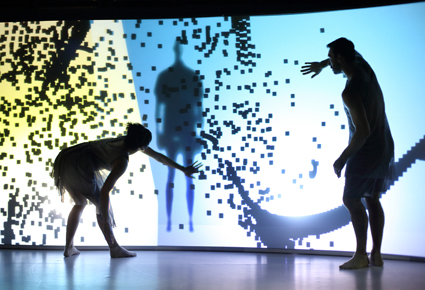
Pari passu…touch, Leigh Warren & Dancers
photo Tony Lewis
Pari passu…touch, Leigh Warren & Dancers
PARI PASSU…TOUCH IS AN INTRICATE WEAVE. IT TAKES PLACE WITHIN AN EXQUISITE MARY MOORE DESIGN—A PERFECTLY CIRCULAR WHITE FLOOR WITH TWO WAVE FORM SCREENS OF DIFFERENT LENGTHS POSITIONED NEAR THE BACK OF THE CIRCLE AND SEPARATED BY A GAP. THE WORK BEGINS WITH A LIGHT GLANCING ACROSS THE SCREENS REPEATEDLY, REVEALING THE TEXTURE OF WHAT COULD BE THE MOSAIC OF ROCK ON A SHORELINE.
The lights dim and solid becomes fluid, rock becomes mud. A distant shadowy figure walks towards us, a projection, but then a live male body takes over. The dancers are initially figures behind, appearing to be in the wall—the work presents mutability as order. The screens are revealed to be touch screens. The dancers emerge from behind the wall and return there throughout the piece. The surface changes throughout with beautifully selected projections by Adam Synott. Sometimes the surface shifts in response to the dancers—patterns scatter or collect.
Though the media technology is part of the ‘here and now,’ the references that haunt the work are of some ancient time. My mind wandered to cave paintings and tribal rituals. Some version of our past lurked as a referent. The sound shifted between wind instruments, strings and drums as the dancing changed rhythm and dynamic. Though touch was the declared focus, the dancing away from the screen/wall was a relentless, almost restless, articulation of body in confined space, body in relation to floor and body in relation to other bodies. The dancers performed solos, duets and unison quartets.
Behind/in the wall the movement slowed, opened out, changed shape. The dimensions of the space and wall made the dancers appear larger than life, godlike. At a certain point I was struck by the thought that a cosmology was being represented. I looked up and the lighting bars were in arcs; the heavens appeared. At another point an orange glow dominated the stage, that unmistakable orange that has come to represent Australia. I am struggling to describe the intricate unsettling of solidity, of surface, of depth of field, of time, of symbols and cultural positioning in this dance (Warren has had a long commitment to supporting and working with Indigenous dancers and choreographers).
The duets were a case in point, involving a knotting and unknotting of bodies. There was not the usual rhythm of separation and coming together that often marks this duet form. In the quartet a simple walking forward and back in unison and also the detail of the shoulders and upper backs moving on four hunched dancers was profoundly moving. They were working at the edge of their ability to stay accurate and present. This was thrilling. I found it tantalising to watch a work where referents hovered but had been relegated to the outskirts; where I focused instead on patterns in process and the feelings and meanings these generated. I was reminded of my pleasure in watching Lucinda Childs’ dancers stepping along geometric spatial pathways swinging their arms in the 1980s and was glad of this Australian dance project.
Leigh Warren & Dancers, Pari passu…touch, artistic director, choreographer Leigh Warren, dancers Lisa Griffiths, Bec Jones, Tim Farrar, Jesse Martin, set design Mary Moore, music composition, projection design Adam Synnott, lighting Benjamin Cisterne, garments Alistair Trung, Space Theatre, Adelaide Festival Centre, May 17-26
RealTime issue #109 June-July 2012 pg. 8
© Anne Thompson; for permission to reproduce apply to realtime@realtimearts.net
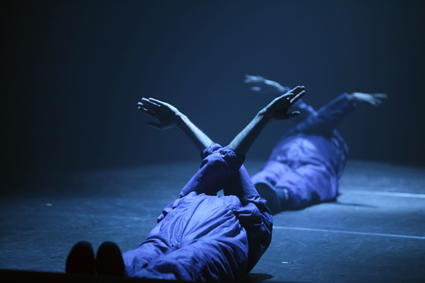
More or Less Concrete, Tim Darbyshire
photo Ponch Hawkes
More or Less Concrete, Tim Darbyshire
HUMANS ARE SENSATES, THERE IS NO OTHER WAY TO PERCEIVE THE WORLD OUTSIDE THE BODY. ACCORDING TO ANTHROPOLOGISTS, MEMORY IS THE HISTORY BOOK OF OUR SENSORY EXPERIENCES WHERE WE STORE AND RESTORE EACH SENSORY DIMENSION WITHIN THE OTHER, MAKING IT DIFFICULT TO SEPARATE AND VERBALISE OUR SENSATIONS. TIM DARBYSHIRE’S COLLABORATIVE PERFORMANCE IS BASED ON THEORIES OF SYNAESTHESIA, SENSORY EXPERIENCE AND MEMORY.
In More or Less Concrete, the audience witnesses a kind of abstraction of the body and its movements. The slow, dreamy pace makes this as much a study in sculptural forms as dance. Through sensory-challenging sound and lighting, it is also a retelling of these snatches of memory through performance.
In a darkened theatre, headsets deliver the minimalist and hypnotic sound. A car in the distance, a creaking chair, a metal street sign in the wind? The recordings are central to the piece, as in the dance itself they explore the intersection of sound and movement of artificial or natural environments. Microphones near the stage pick up the sound of limbs slapping the stage, heads knocking on the wooden stage and the breath and grunts of the performers. The containment and editing of sound through headphones coupled with darkness heightens our visual perception.
Three performers in boiler suits appear in a haze of low watt blue light, their heads tucked away out of sight. Without the visual reference point of heads, the performers appear to be disembodied sculptures. For much of the performance, faces are hidden, giving the performers an anonymous, inhuman nature. The unfamiliar positions of the bodies—such as upside down torsos—leave behind unrecognisable, twisted forms, like the casts of animals made at Vesuvius or Richard Goodwin’s concrete sculptures of cast bodies, Mobius Sea. The title of the performance refers to the shifts between the concrete reality and the more ephemeral forms of bodies. Movement transforms the body from recognisable states as human or animal, to something more abstract, to machine or ‘other.’
Darbyshire’s work is informed by visual art and film—initially the frequent pausing in the choreography allows for the same contemplation as visual art. Then there are the filmic qualities. We are warned in advance about loud noises—after a somnolent start there is a sudden bang, the kind that keeps you on the edge of your seat during a thriller. In a dark, controlled sensory environment this keeps the audience alert and tense.
A former star swimmer, Darbyshire evokes memories of swimming through the colour blue—the effect is immersive and cold, much like blue tint in film. We see the bodies as if underwater, with oscillating arms. The forms the body makes when suspended in water are strange yet recognisable. There are other playful impressions from childhood: sprinklers and the swooshing, claustrophobic brushes of a car wash.
More or Less Concrete is a quietly unsettling and revelatory investigation into the crossroads of our senses. We walk away having experienced bodies as abstract forms while movement is perceived sonically as well as visually.
More or Less Concrete, choreographer, director Tim Darbyshire, performers Sophia Cowen, Tim Darbyshire, Matthew Day, sound designer Myles Mumford, lighting, production Bluebottle, dramaturg, sound theorist Thembi Soddell, Arts House, North Melbourne Town Hall, April 18–22
RealTime issue #109 June-July 2012 pg. 8
© Varia Karipoff; for permission to reproduce apply to realtime@realtimearts.net
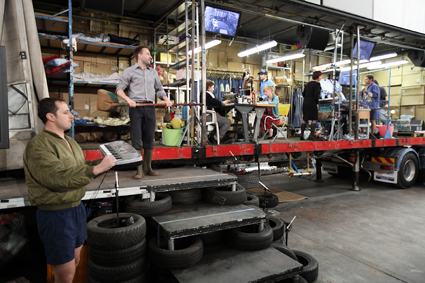
Hard to be a God
photo Tony Lewis
Hard to be a God
WE MEET AT THE CROSSROADS IN BOWDEN, A ONCE-INDUSTRIAL INNER SUBURB OF ADELAIDE, NOW UNDERGOING TOO-SLOW TRANSFORMATION. THE PERFORMANCE WILL TAKE PLACE IN A WAREHOUSE, A PRE-FAB COLORBOND ENCLOSURE, SLUNG UP TO HOUSE A BROAD CONCRETE SLAB. OUTSIDE, A FESTIVAL CROWD MILLS IN THE DUST.
We are invited inside, as the show gets underway. Hard to be a God is performed off the back of two semi-trailer trucks. Set at right angles to each other, one truck is a platform for on-stage action, the other a screen for projections. The audience is seated, rather comfortably, in the rectangle between, on tiered banks of plastic chairs.
This is transient theatre with an interventionist feel. Its politics are transportable, the scenario universal. Hungarian director Kornél Mundroczó explains in the program: “this transitory situation is very familiar: being at someone’s mercy while being on the road illegally, fleeing from somewhere.” We are witness to their transit suspended: three young women, sewing jeans in a truck-top sweatshop, are kept busy by a bossy fourth, who enslaves them to their work, and trades them to the men for sex. The motley gang of men use the women, one after the other, to make porn in the other truck. We have been warned.
In this off-stage action—relayed by hand-held video camera, with live feeds projected onto screens—a naked woman screams as her back is scalded with hot water; another’s neck is broken, or so it seems, from too much rough handling; a third, now pregnant, struggles at the prospect of being buried alive. These pornographic scenes of sadistic violence are spliced into an on-stage flow depicting forced labour, industrial accidents, medical interventions—urine tests, an abortion. Violent sexuality mixes with lyrical solidarity. The characters sing and dance at times to alleviate the boredom, the degradation—and to cheer us up, it seems.
Mundroczó draws the moral dramaturgy of Hard to be a God from the sci-fi novel of the same name by the Russian brothers Arkady and Boris Strugatsky. The novel lends a political sub-plot of extremism and extortion to the performance: a sister raped, a son turns on his politician father. It also lends a theological dimension: witnessing the cruelty of God’s creations, an angel-man exacts revenge on our behalf in a final splatter-act of retribution. The performance closes on an ethereal moving image of this angel-man, floating backwards in a boat along the wetlands of eastern Europe.
The performance also seeks to extend its moral reach with a retro-soundtrack of emotional devastation: Dire Straits’ “Brothers in Arms” accompanies the closing image; Gene Pitney’s “Something’s Gotten Hold of My Heart,” Burt Bacharach’s “What the World Needs Now” and the Pop-Tops pan-European hit “Mamy Blue” momentarily elevate our interest and sketch the contours of hope. At other times, the look and feel of the performance is grimly realistic, desperate and fatalistic. The sweatshop set is meticulous in its clutter, greasy with machinery, with steaming racks of clothing and factory waste. It is work-wear, industrial protection and trade tools for the men; stretch-knits, tracksuits, underwear and nudity for the women.
The production’s mediation of off-stage sexual violence is realistic, but somewhat numbing in effect. The day after, I felt flat. Like surgery under local anaesthetic, I could see violence inflicted but I didn’t feel the pain. For me the moment of greatest agitation was a disturbance in the audience half-way through. The lights came up, the stage manager intervened, and a couple walked out, before one of the actors sought our permission to continue. At first, I thought they were a plant: an act of staged objection to highlight our inaction. And then I wondered nervously: were they actually offended? But no. Next morning, in an email, the festival’s senior publicist sought to reassure us with innocuous affect: “the audience member who was unwell last night has a pre-existing medical condition. He recovered quickly and apparently this happens to him regularly.”
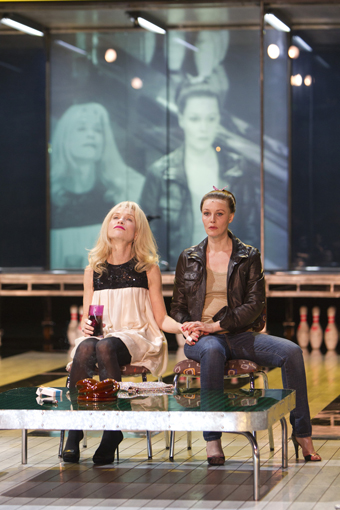
Isabelle Hupert, Florence Thomassin, A Streetcar
photo Shane Reid
Isabelle Hupert, Florence Thomassin, A Streetcar
A Streetcar from Odéon Théâtre de L’Europe seems likewise premised on assumptions about anaesthesia and the audience. Director Krzysztof Warlikowski overcomes the intimate stage realism of Tennessee Williams’ play with a production of grand expanse, hard surfaces and voluble performances.
The performance opens at Adelaide’s largest theatre with actor Isabelle Huppert as Blanche Dubois babbling behind glass. She is encased in an elevated bathroom-hallway that extends horizontally across the stage, rolls on tracks in the stage like a streetcar, and is glazed with ‘electronic privacy glass’—ceiling-to-floor plate-glass panels that switch between transparent and opaque. In opaque mode, they serve as screens for video projection of live action, black-and-white in evocation of Elia Kazan’s 1951 film.
What I feel foremost of this performance is the smoothness of its surface. The main area of the stage is a suite of ten-pin bowling alleys that reach into its depth. Yet when Huppert descends onto the stage my depth perception is at a loss. The emotional volatility of Blanche’s intervention between Stella and Stanley (played by Florence Thomassin and Andrzej Chyra) is flattened by the monophonic consistency of the actors’ voices. As in music theatre, they wear microphones to amplify their voices. The disarticulation of actors’ voices from the spatiality of their presence makes me feel like I have lost my sense of touch. It is as if the entire performance were playing out behind glass.
Warlikowski’s direction seems driven to overcome the prospect of an audience at a distance from the actors, cut-off and out-of-touch. Tiny interactions and minute gestures are retrieved by video from inaccessible spaces—in the bathroom, under the bed, beside the couch—and magnified with projection to amplify their presence on such an expansive stage. Transformations in the actors’ portrayals of their characters’ emotional trajectories are ‘telegraphed’ with an intricate plot of wig and costume changes.
Transformations in the dramaturgy of minor characters amplify the psychic theatricality of Blanche’s plight. Her homosexual husband—”un jeune homme” played in grand-guignol style by Cristián Soto—is brought back from the dead to dance the tango on stage with Mitch (Yann Collette). The role of Eunice, Stella’s friendly upstairs neighbour, is enlarged by Renate Jett into singer-interlocutor—belting out Pulp’s “Common People,” Eric Carmen’s “All By Myself” and other songs, juxtaposing key moments with the delivery of inter-texts (from Oedipus, apparently, from Wilde, Flaubert and Dumas), and stepping into the audience at the interval for some light-hearted banter about love, romance and relationships.
Warlikowski’s directorial strategy is multi-channel amplification, blasting through the script to expose the theatricality of the psycho-sexual on an operatic stage. I make contact with the work. But was this contact premised on an assumption that I wouldn’t? That without the amplifiers, I’d feel nothing?
By comparison, Gardenia from Alain Platel and Frank van Laecke of Les Ballets C de la B transacts a simple encounter with its audience. Nine elderly people of transitive genders, a ‘young guy’ and a ‘real woman.’ Wearing suits, they each undress revealing the frocks they wear beneath.
One tells jokes, one sings, another reminisces. They address the audience directly. They mince and pose and pout as an ensemble. They don wigs, slap on make-up, slip on heels. They swing handbags to Ravel’s Bolero and mime the words to songs. They spread red carpet on a parquet floor. They walk.
As a performance, Gardenia is not much more than that. “The journey is so dear to us,” advise Platel and van Laecke. “We advance without hurrying.” The show unfolds at walking pace. There is no assumption that I feel nothing. And no demand that I feel more.
2012 Adelaide International Arts Festival: Hard to be a God, director Kornél Mundroczó, Old Clipsal Site, Bowden, March 8-14; A Streetcar, based on A Streetcar Named Desire by Tennessee Williams, director Krzysztof Warlikowski, Odéon-Théâtre de L’Europe, Festival Theatre, March 14-17; Gardenia, directors Alain Platel, Frank van Laecke, Les Ballets C de la B, Dunstan Playhouse, March 2-5
RealTime issue #109 June-July 2012 pg. 10
© Jonathan Bollen; for permission to reproduce apply to realtime@realtimearts.net
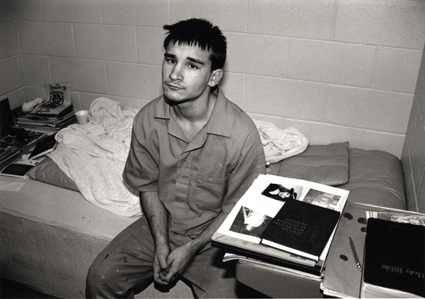
Jessie Misskelley Jr, Paradise Lost 2: Revelations
AMERICAN CINEMA IS SO RIFE WITH STORIES OF THE WRONGLY ACCUSED YOU COULD BE FORGIVEN FOR THINKING THE UNITED STATES SPECIALISES IN EPIC MISCARRIAGES OF JUSTICE. OR PERHAPS THE OPENNESS OF AMERICAN SOCIETY SIMPLY LENDS ITSELF TO THE EXPOSURE AND DRAMATISATION OF LEGAL ERRORS.
The recently completed documentary trilogy Paradise Lost, detailing the story of the West Memphis Three, certainly features some extraordinary access to courtrooms, but the result is a far from reassuring portrait of American justice.
Director Joe Berlinger unveiled the final part of the Paradise Lost trilogy in March at the Australian Centre for the Moving Image (ACMI), leaving viewers with more questions than answers about this nightmarish case.
Berlinger recalls that when he and his filmmaking partner Bruce Sinofsky began shooting the first Paradise Lost film for HBO—The Child Murders at Robin Hood Hills (1996)—they thought they were documenting “an open and shut case.” The police claimed they had strong evidence implicating three local teenagers in a particularly horrific triple homicide in West Memphis, revealed when the mutilated bodies of three eight-year-old boys were found naked and hogtied beside a creek on May 6, 1993. Seventeen-year-old Jessie Misskelley Jr, 16-year-old Jason Baldwin and 18-year-old Damien Echols were quickly arrested and charged with the murders. Misskelly confessed to police about his involvement in the crime and implicated the other two.
It quickly became apparent to the filmmakers, however, that there was no physical evidence linking the teenagers to the murders. Jessie Misskelley Jr, who had an IQ of just 72, had been interrogated by police for 12 hours before making his confession. Only 46 minutes of the interview had been recorded. Despite the fact that Misskelley quickly recanted his statement, arguments in court that the confession was false and extracted under coercion were dismissed by the jury, and he was sentenced to life in prison.
In the separate trial of Echols and Baldwin, the prosecution argued the boys were members of a satanic cult and the murders part of a bloody ritual. The teenagers’ love of Metallica and Stephen King was introduced as “evidence” to support these claims. Each was found guilty on three counts of murder, and Baldwin was sentenced to life imprisonment. Echols was sentenced to death.
Amazingly, Berlinger and Sinofsky were permitted to film both trials, an experience Berlinger describes as “jaw-dropping.” Their lenses captured the flimsy prosecution case and the inept, scattershot approach of the boys’ defence lawyers. They also revealed the impassioned hatred felt by the parents of the murdered boys and the rumours of Satan worship that swirled around Memphis in the wake of the murders.
Half a decade later, Berlinger and Sinofsky returned to the case to make a second film entitled Revelations (2000). The first documentary engendered a storm of controversy about the trial proceedings and dubious nature of the prosecution’s case, but the second film revealed little conclusive new information about the murders and subsequent trials. The filmmakers were also denied access to courtrooms during various fruitless appeals. Instead, Berlinger and Sinofsky spent a lot of time with John Mark Byers, father of one of the victims; his deranged religious zealotry makes Robert Mitchum’s character in The Night of the Hunter look restrained.
Questions had already been raised about Byers in the first documentary after he bizarrely gave the film crew a knife as a present, which was later found to hold traces of human blood that matched the type of both Byers and his dead son. By the time of the second film, Byers’ wife had also died in mysterious circumstances. Various theories developed in Revelations imply Byers may have played a part in the murders, but at the end of the film a lie detector test suggests that he believes he is telling the truth when he denies any involvement. On the other hand, at the time of the test he was taking a cocktail of five mood-altering drugs, which may have skewed the result somewhat.
The recently completed third part of the trilogy, Purgatory (2011), avoids the sensationalist tone of the second instalment and traces developments that led to the release of the West Memphis Three in August 2011. The biggest shock is seeing the effect of time on the accused. Misskelley, a slight teenage boy in 1993, is now an overweight middle-aged man. Echols and Baldwin are in better shape, but they are similarly on the edge of middle-age and as the film opens, all three have spent more of their lives behind bars than living free.
The decisive development traced by Purgatory is the analysis of DNA from the crime scene, utilising technology not available at the time of the original trials. Tests find that none of the DNA material from the scene can be linked to the accused. Intriguingly, the tests do show that a hair on a shoelace used to tie up the victims may have belonged to the stepfather of one of the murdered boys.
After various protracted legal machinations the state offers the West Memphis Three a deal that will see them released, based on the time they have already served. The trio agree rather than endure a protracted retrial. In this sense the final part of Paradise Lost provides something of a resolution, but many questions are left hanging, not least the riddle of who really murdered the eight-year-old boys. The films suggest many possibilities, but in the end all the leads only serve to demonstrate just how slippery the notion of truth really is, whether it’s on screen or in the courtroom. Errol Morris’ celebrated The Thin Blue Line (1988) similarly showed up the mutability of supposedly factual evidence, but where Morris’ film basically detailed two conflicting versions of the same crime, the only certainty left by the end of Paradise Lost is the fact of the original murder. Director Joe Berlinger admitted at the ACMI screenings, for example, that much of the evidence presented in the second film implicating John Mark Byers has since been discounted, providing a sobering lesson in the power of cinema to lead viewers to conclusions that aren’t necessarily correct.
Most horrifyingly, however, the Paradise Lost films dramatise how three teenage lives were ruined based on the flimsiest of circumstantial evidence. Were it not for new DNA technology, one of the trio would almost certainly have been executed. Watching the legal saga play out over two decades and across three films, the entire process of ‘justice’ ends up looking almost as monstrous as the original crime.
Paradise Lost 1: The Child Murders at Robin Hood Hills; Paradise Lost 2: Revelations; Paradise Lost 3: Purgatory; directors and producers Joe Berlinger & Bruce Sinofsky; 1996, 2000, 2011; HBO; USA; screened at ACMI, the Australian Centre for the Moving Image, March 1-4
RealTime issue #109 June-July 2012 pg. 14
© Dan Edwards; for permission to reproduce apply to realtime@realtimearts.net
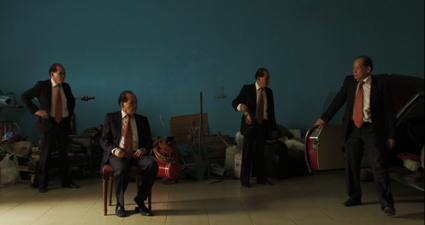
Golden Slumbers
NOW IN ITS 15TH YEAR, PERTH’S PREMIER FILM FESTIVAL SHOWS NO SIGNS OF SLOWING DOWN. FESTIVAL DIRECTOR JACK SARGEANT EXPLAINS HOW THE REV MANAGES TO COMBINE THEMATIC SOPHISTICATION WITH ITS RENOWNED YOUTHFUL SWAGGER.
As the festival’s July start date draws closer, Sargeant acknowledges that he is still under the gun, dealing with the staggering number of submissions that Revelation receives. “This year I’ve chased down three or four hundred movies,” he estimates. “And we get submitted I don’t know how many hundreds that Richard (Sowada, Revelation founder, now working at Melbourne’s ACMI) and I wade through. It’s pretty mammoth. Rev seems to grow exponentially each year—there’s just more and more happening.”
But while Sargeant eschews the notion of selecting films for the festival based on a preconceived overarching theme, he will concede that a dominant throughline does tend to form as choices are made and the pile of hopefuls is winnowed down. “It works out that we have got a theme this year,” he says. “Well, actually, there are two: community and family. But you don’t look for things—these things just start emerging.”
It’s a fitting theme. Revelation is, after all, one of the key events on the Western Australian film community calendar. Inaugurated in 1997 as a showcase for a handful of independent shorts, it now encompasses a program in excess of 100 films and attracts a large number of international guests. It could easily be argued that the notion of community is present every year, inasmuch as the festival acts as a hub for the Perth film scene.
Rev in 2012 boasts a notably strong documentary stream. “This year we’ve got a lot of documentaries,” Sargeant says. “I think 15 or 16 documentaries at this point. Documentaries are really on the ascendant. I don’t think we’ve seen any ‘Occupy’ documentaries, but we are seeing a shift away from environmental stuff to economic and political stuff coming in. I think we’re seeing a shift in film in that direction.”
Davy Chou’s Golden Slumbers stands out as a powerful example. A haunting examination of the decimation of the Cambodian film industry under Pol Pot’s regime, Sargeant describes it as “an incredibly moving documentary, because obviously most of [the filmmakers] were murdered under Pol Pot in the mid 70s. There’s literally only a half dozen or so of those filmmakers left, and they just talk about the industry. You get a sense of this incredibly vibrant community, but now there are only five or so films dating from that period left. They made hundreds and hundreds of films, and now there are only five. But Golden Slumbers will, I imagine, soon be playing everywhere; it’s an incredibly powerful movie.”
Another film which will no doubt reach a much wider audience before long is Undefeated, the American sports documentary by Daniel Lindsay and TJ Martin. A look at a year in the life of the Manassas Tigers, a woefully underfunded and ill-equipped high school football team who attempt to reverse a century-long losing streak, the film won the 2011 Oscar for Best Documentary, and should hold the same crossover appeal as Steven Riley’s Fire in Babylon, the film on the West Indies cricket team of the 70s which opened last year’s festival.
“We’ve also got a film called Battle For Brooklyn,” Sargeant continues, “which is about a whole community in New York fighting against their neighbourhood being demolished to make way for a stadium and blocks of designer flats. It’s a very interesting documentary going towards that notion of community that I was talking about.”
That theme carries over into the festival’s fiction stream as well, with the Australian horror film The Caretaker, from first-time feature director Tom Conyers. The film postulates a discordant community of necessity that emerges when a disparate group of strangers hide out in a rural mansion after a plague of vampirism sweeps the globe. Matters are complicated when they must strike a deal with a vampire, played by producer Mark White, who also dwells in the mansion. Having already drawn acclaim on the North American festival circuit, it will make its Australian premiere at Revelation.
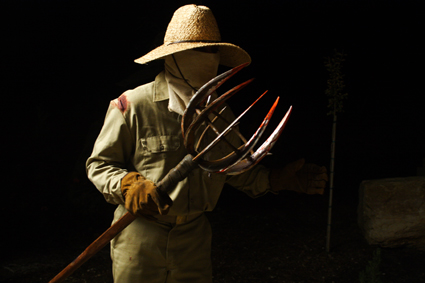
The Caretaker
Unusually, The Caretaker was one of only a few horror films submitted to the festival. “Normally we’re inundated with average to fair films made by people about chainsaws and zombies, and there’s actually very little of that this year,” says Sargeant. “I don’t think horror’s going away, but I think it’s changing. It’s getting kind of absurd right now. I was joking with somebody the other day that sooner or later you’re going to get a found footage horror film that’s shot in 3D. Horror has become so self-referential. So we’re seeing less horror.” However, Sargeant maintains that it’s the shifting genre landscape that makes programming a festival like Revelation so challenging and rewarding.
“You can see change happening slowly in film.” he says thoughtfully. “The big secret of programming cinema is that you’re not just curating films, you’re curating the relationships between the films. Once you start programming, you start thinking about how the films will work together, because you have to go forward on the assumption that people will see more than one film. Also, you don’t want to define yourself too rigidly or lock yourself into too small a place. The whole curatorial process is a really interesting one. On a personal level, I think you should always be pushing yourself and looking in different places for things that will pique your interest. We’re always looking for new things that are out there—you have to do that.”
Revelation Perth International Film Festival, The Astor Theatre, Perth, July 5-15, www.revelationfilmfest.org
RealTime issue #109 June-July 2012 pg. 15
© Travis Johnson; for permission to reproduce apply to realtime@realtimearts.net
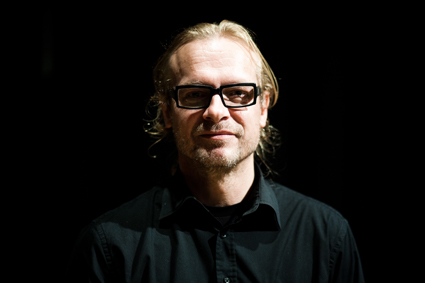
Horst Hörtner, photo courtesy Plektrum Festival and Ars Electronica Futurelab
HORST HÖRTNER IS SENIOR DIRECTOR OF THE ARS ELECTRONICA FUTURELAB IN LINZ, AUSTRIA. HE HAS BEEN ON A RECENT TOUR AROUND AUSTRALIA SETTING UP A NUMBER OF SMALL INSTALLATIONS AND SEMINAR PRESENTATIONS TO DEMONSTRATE WHAT THE FUTURELAB IS ALL ABOUT.
Organised by Richard Vella, from the University of Newcastle, and assisted by Australian Futurelab employee Kristefan Minski, the mini-tour provided the opportunity to ask Hörtner about the genesis of the Futurelab project and the central role of transdisciplinarity.
Hörtner speaks enthusiastically about a new kind of research that is being championed in his lab-cum-museum. RealTime readers will be familiar with the work that Ars Electronica has been showing for many years in their annual festival. The Futurelab is the latest incarnation of this project, providing a working model of the ways transdisciplinary research and practice can produce engaging results.
Can you explain what the Lab’s take on transdisciplinarity is?
“Well it’s actually been there from the beginning of Ars Electronica in 1979. It started out as a festival around the topics of art, technology and society, which already involves pretty much everybody and everything! At the Ars Electronica Centre, we are very much looking to the future. What is influencing our future, what trends are coming. What are the new technologies that are rising up that may change the paradigms of society in much the same way as ICT has over the last 20 years?”
The Centre provides hands-on experience for visitors (providing courses for kids to clone plants for instance). As a place of inquiry, the Centre showcases projects that Hörtner calls “sketches of the future” in a range of areas including nano-technology, robotics, gene technologies and the most advanced fabrication methods.
Hasn’t the future already arrived?
“The future arrives regardless of Ars Electronica,” he jokes, but what they’ve been doing for the last 30 years can now in some ways be seen as a “history of the future”. Their R+D department has 50 people from a wide variety of disciplines (architects, physicists, biologists, sociologists, game designers, industrial designers, media planners, telematicians, and civil engineers) working on art-based experimental projects. The Futurelab provides a context for a very diverse group of people and disciplines, and it’s this context that Hörtner recognises as crucial.
Do you see a huge difference between interdisciplinarity and transdisciplinarity?
“Well, according to experts, the major difference is that interdisciplinarity promotes exchange between the disciplines, whereas the transdisciplinary approach takes into account the fact that there are fields which don’t even exist yet. If there is no discipline for a certain area yet, we need to expand across to fields where no discipline is home. The reason there are so many areas covered by the Futurelab is because we approach problems from a large variety of angles. In order to see the problem and to understand it more deeply, you often have to leave the comfort of your discipline if you want to see the full picture. This is the place where crazy ideas come up that may not survive in their own discipline, but which make a lot of sense to those in other disciplines. That’s what I call the soil for growing innovation. This is where cross-over ideas can happen and where we can grow new things.”
How did you manage to get such a huge experimental arts centre like this funded?
“The Lab is a logical extension to a festival that only has a small window of public exposure. Having a permanent institution and network that would operate the whole year had enormous advantages and opportunities. The Ars Festival had grown interest locally, and educated the wider public to see that there must be something in the work that attracts many of the world’s leaders in the field of experimental art and research.”
In Australia, it would be hard to imagine government officials and local councils being convinced of such a proposition. Not so in Austria, where the Mayor and the City of Linz were convinced to “jump into this adventure”. Ars Electronica is a private company owned by the city of Linz, and funded 75% by the local city government and 25% by regional Austrian authorities. The Futurelab also has industry partnerships with companies such as Honda, Audi, SAP, Siemens and Vodafone. “Mostly they come to ask whether they can do something really cool, and don’t really come with a problem to be solved.”
Have artists changed their ways of working in terms of art and science?
“There is a very close intersection between art and science. Science generates knowledge about our world and art generates experience about our world. These are just two different words for discovering what lies beyond the horizon, what lies beyond the borders. Scientific practice has drastically changed in the last 20 years. A lot of scientific outcomes are actually judged by public opinion prior to the existence of the outcome. For instance, everybody has an opinion about gene technology, talking about designer babies and so on, even though we are miles away from that step.”
Hörtner argues that scientists now have to “perform” their work in a way that they didn’t have to in the past. He is quick to point out that artists are used to confronting an untrained audience, and suggests that there are methods and strategies in the artistic process that are capable of being imported into the process of scientific research. “Artists can play a new role in helping scientists do that research in front of an untrained audience.”
He stresses this is not about the beautification of scientific outcomes, but represents the possibility of a convergence of artistic and scientific work in what he calls a “space of action.”
So do artists need to be transdisciplinary, or do they need to work in a transdisciplinary context?
“That’s a good question! If you want to do transdisciplinary work, it doesn’t make any sense to tell other disciplines that they have to work in transdisciplinary ways, but that artists don’t have to work in that way because, you know, ‘I’m an artist.’ There has to be a willingness to share knowledge and to share approach.”
Are artists being trained in the right way then?
“Everybody’s talking about Art and Science, but in many ways the outcome is still poor. But there’s potential. In terms of education however, I would say we’re not at all prepared. 100 years after the Industrial Revolution we’re still teaching our children the curriculum that has been founded a century ago. We should probably think about that!”
Ars Electronica, Futurelab, Linz, Austria, www.aec.at/futurelab/en/
RealTime issue #109 June-July 2012 pg. 16
© Ross Harley; for permission to reproduce apply to realtime@realtimearts.net
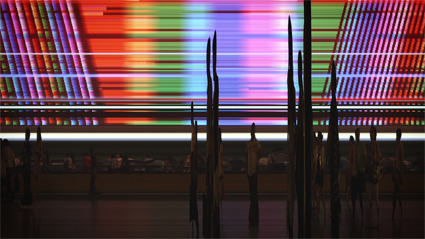
Daniel Crooks, Static No.14 (composition for neon), 2010
courtesy of the artist and Anna Schwartz Gallery
Daniel Crooks, Static No.14 (composition for neon), 2010
EXHIBITIONS ALWAYS SEEM TO APPEAR MAGICALLY IN MUSEUMS, AS IF THE OPENING IS REALLY THE BEGINNING, RATHER THAN THE END OF THE PROCESS. THIS IS EVEN MORE THE CASE WHEN THEY ARE INTERNATIONAL SHOWS, THE RESULT OF INTRICATE PROCESSES OF NEGOTIATION—AND ANY CURSORY READING OF THE FINAL LIST OF ORGANISERS, PRESENTERS, PARTNERS AND SPONSORS, BOTH CORPORATE AND GOVERNMENTAL—GIVES US AN IDEA OF THE SHOW’S ‘BACK STORY’ AND THE CONSEQUENT MIRACLE OF ITS REALISATION.
It’s not easy to judge the effect of an international show in a local context if you come from the same place as the show itself because you are not seeing the show that the local audience sees.
So, in Taipei, I come as a virtually blind person to Wonderland: New Contemporary Art from Australia—in a situation not unlike that apocryphal story a prominent gallerist once told me of a blind Sydney art critic who took his partner to shows; together they would stand in front of the art and the partner would describe the work for the critic who would write accordingly about it. It seems like a good method, even more possible in the post-visual space of the contemporary museum, when work can be heard and felt and so I thought I would try it, if not with eyes shut, then certainly with ears open. Actually it is not such an outlandish idea but describes pretty well the process of having one’s eyes opened to work within the hermeneutic processes of viewing, experiencing, listening that interpretation always involves. And besides, all exhibitions now have ‘partners’ to lead us into the process, suggesting what we might see.
In my case, my guides are my very bright grad students, imaginatively remaking pieces from their own thoughts and feelings and transforming them before my eyes, and to walk with them through the spaces of Wonderland is to be re-enchanted. Although I am captivated by Martin Walch’s Mist opportunities (2011) that seems so much like a Chinese painting, my students are less moved by it. Perhaps this is because in March in Taipei it is already so misty every day that it seems too close to home. The pleasure really begins with Alex Davies’ Dislocation (2005) and loud shrieks of joy and surprise emanate from the room as viewers encounter uncanny shadows behind the images of themselves peering into the peepholes of the work. Already feeling a guilty pleasure in their voyeurism, they find themselves ‘caught in the act’—and want to go back for more. The ‘ghost in the machine’ finds an easy resonance in a culture where ghosts abound. This is a popular work and queues form outside it.
Cath Robinson’s Thought noise/wave-form preludes (2009) draws another crowd wanting to play the sounds of inspiration and to listen to the melodies of combination. It is a work that gains the particular and enthusiastic approval of the numerous school groups always visiting the show. The tinkling sounds of these delicious waveform preludes subtly score Matthew Gingold’s Flying Falling Floating (2007) effectively installed above the stairwell.
Audiences are drawn to George Khut’s work in droves, willing to wait for up to 20 minutes to experience it. Heart Library (2009) seems to be strangely effective, though to me it is not an especially visually satisfying work, and even the biofeedback process is a bit hit and miss. But the expressive potential of the work is effectively extended in the hand-drawn ‘body-maps’ that audience members willingly produce by the score. And they do so with the seriousness of purpose of the most serious artists, somehow impressed by this encounter with the nature of the creative process and its links with the moments of reverie that the bio-feedback technology produces in the tense or relaxed time spent listening to one’s own heart beating. Perhaps it’s also the empowerment that comes from having one’s work exhibited in an important art museum in a process of interactivity that somehow works because it has both a technological and a directly analogical component. And it plays to an audience embracing ‘user-created content’ in the real time of visceral experience, using old media forms—paper, coloured pencils, crayons.
Daniel Crooks’ superb Static No 18 (2010) benefits from its location alongside Khut’s Heart Library because the audience moves backward and forward between the two pieces, while waiting to experience the latter. This allows both an uninterrupted and a disrupted time for experiencing the former that seems just right for the particular temporality of the Crooks’ piece. The abstraction of the movement here captures the precision of the original action more effectively than either a real time viewing or a slow motion rendering would demonstrate, bringing us into contact with the particulate nature of space-time itself in a way that we can say is both true to the nature of the technology and the software deployed.
Kylie Stillman’s brilliant Flock (2010) impressed, as did Bindi Cole’s transgender photographs and Fiona Lowry’s spectral paintings. By the time it closed, the show had attracted record crowds to the museum, helped no doubt by the consistency of curator Antoanetta Ivanova’s tireless efforts to serve the work throughout the show’s duration. Nine official sponsors supported the 22 artists represented here but the greatest subsidy was clearly the curator’s own time and energy, animating audiences, engaging their curiosity. In the end, no-one seemed to notice very much that the work was from Australia; it just seemed to audiences to be a bunch of cool stuff to experience, coming from a curious place where artists spoke directly to an audience whose language they did not speak except through these encounters of feeling. This, in the end, is the best fate for a touring show: that it loses its origins and enters its destination as a welcome guest.
Wonderland: New Contemporary Art from Australia, curator Antoanetta Ivanova, artists Bindi Cole, Daniel Crooks, Anna Davern, Alex Davies, Elizabeth Delfs, Julie Dowling, Matthew Gardiner, Matthew Gingold, Chris Henschke, George Khut, Fiona Lowry, Jasmine Targett, Jess MacNeil, Jon McCormack, Cath Robinson, Julie Ryder, Kuuki (Priscilla Bracks, Gavin Sade), Kylie Stillman, Josephine Starrs and Leon Cmielewski, Martin Walch, Yvette Coyle; Taipei Museum of Contemporary Art, Taipei, Taiwan, Feb 10-April 15
RealTime issue #109 June-July 2012 pg. 17
© Helen Grace; for permission to reproduce apply to realtime@realtimearts.net
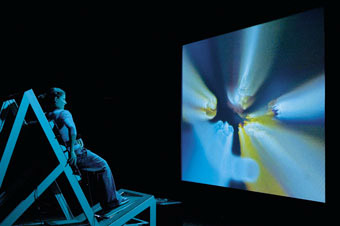
transmute collective, Intimate Transactions (2005)
photo David McLeod
transmute collective, Intimate Transactions (2005)
FINITUDE (V2) BY KEITH ARMSTRONG IS A TOUCH-SENSITIVE INTERACTIVE INSTALLATION COMBINING 3D IMAGERY, TRANSPARENCY, MOVING SCULPTURE, LIGHT AND SOUND. IT INVESTIGATES THE CULTURAL DIMENSIONS OF SUSTAINABILITY THROUGH THE LENS OF ‘TIME’ AND HAS SHOWN AT (M) ART AND GALLERY ARTISAN IN BRISBANE’S FORTITUDE VALLEY.
Armstrong has just returned from handing over an earlier work, Intimate Transactions, to Germany’s ZKM (Centre for Art and Media) who have acquired it for their permanent collection. I spoke with him about the handover and about the new work, Finitude.
What are some of the issues/challenges that have arisen through this process of acquisition—particularly in terms of how the work is installed and then invigilated by staff at the museum? How does ZKM propose that the work is maintained and do you have any responsibility for that?
I guess I’d expected that finding a home for such a beast would be no easy feat. I should probably explain what Intimate Transactions is for those who may not have experienced it. In essence, it is an experimental form of telepresence-based interactive installation that allows two people in geographically separate spaces to interact simultaneously using only their bodies. Each participant uses a physical interface called a “Bodyshelf” and wears a sound vibration transmission device around their necks called a “haptic pendant.” By gently moving their bodies on this ‘smart furniture,’ they instigate ‘intimate transactions,’ which influence an evolving ‘world’ created from digital imagery, multichannel sound and tactile feedback. This conjoint individual and shared experience allows each participant to gradually develop a form of sensory intimacy with the other, despite the fact that they are geographically separated and cannot physically see or hear each other.
I was familiar with ZKM and its ambition, having visited it when Jeffrey Shaw was at the helm well over a decade ago. I knew Peter (Weibel) had taken over and that the museum held significant examples of work in the genre of telepresence, alternate interface experiments and performative inflected experience. Examples are Paul Sermon’s Telematic Vision (1993) and Tables Turned (1997) or Masaki Fujihata’s Impressing Velocity (with Simulation Platform) (1994-99)—all works that had some influence on our piece.So I approached him and he was positive because I guess he could also sense the links and resonances.
I spent a full week working with their team in Karlsruhe, Germany, which included some very experienced and fast working technicians, a team of conservators, IT specialists and a range of administrative staff. My key role was to take them through every stage of the work: unpack, install, assembly, testing, running and the performative processes that surround it. And as we went through it each day they documented each stage exhaustively and with great enthusiasm! They also worked out a great deal of how it went together which is testament to their experience as world leaders. I then handed over the complete documentation archive for the work which includes a 135-page book edited by Jillian Hamilton and the full gamut of CAD models, plans, schematics, code, images, documentation of each site and setup and running instructions.
I then did a two-hour recorded interview with the conservators and they asked me questions about how it should be presented, maintained and conserved—going through everything down to the details of where electronics modules could be bought and what specifications of hardware would be needed in the event of failure. So they now own the work and can access the requisite IP, and it can be shown either at ZKM in the Media Museum or lent out to international galleries. I am not directly responsible for maintenance, although of course I’d be on hand and willing to assist at any stage.
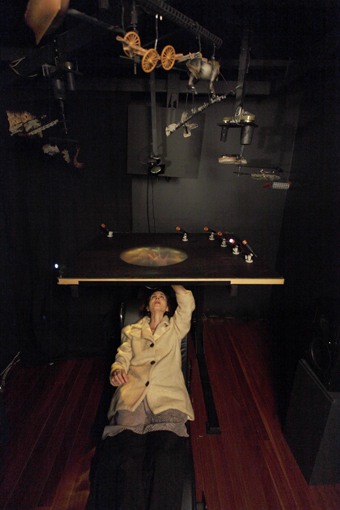
Finitude, Keith Armstrong
photo Carl Warner
Finitude, Keith Armstrong
It is interesting that your works are themselves like the complex ecosystems that seem to inspire your practice generally; and that the difficulty in maintaining the works themselves seems to add a layer of meta commentary to them, in the sense that they are both about questions of sustainability and that they invoke their own issues in regards to sustainability. Could you comment on this in relation to your latest work, Finitude?
I think it was Fritjof Capra who once said that for systems thinkers the relationships are primary. Thinking back to my earliest training as a systems engineer, I realise that what has always driven me is the exploration of the systemic and the relational. Initially I believed that the role of my works could be to examine and maybe illuminate how much we have misunderstood ecology. But then I began to see that simply raising awareness was quite a different motivation from moving through an embodying of that knowledge towards forms of learning: we ‘know’ much but what have we ‘learnt?’ The works I have created over the past two decades are, as you suggest, a working through—invoking your “meta commentary” idea. Privileging that relational approach often ensured ‘impracticalities.’ The tacit requirements for work to be hangable, to be low labour when showing or able to be packed into suitcases for transit, haven’t been ‘keystone’ aspects of my thinking to date. This conflates with the ‘education in error’ that we have all received, our education into unsustainability. We often think our way through things technologically in ways that may exclude as well as include. These things add up, as relationship-building factors that in part conspire to elicit such paradoxes.
The challenge I face with every new work is which path to take. Pragmatism is all around us in our politics and our culture. But despite its short-term attraction it’s also a profoundly limiting force. And so it can be in media art too. I’ve also become used to many people spending maybe 15 minutes or more with my works. I like that power for temporal engagement which most artwork that is seen and not experienced in a literal or embodied sense can rarely muster. So while Finitude represents a much easier system to show and maintain than Intimate Transactions, there are the relative problematics of one-at-a-time operation, the physical requirement to get in underneath the work (requiring a hanging structure), the experimentation with relatively new forms of self-made touch screen and special new screen materials, new software to connect to 3D engines and the like. These all add up and also extend the making process, but the outcome I think then really surprises and offers something that truly imprints! I started with a reasonably distilled idea—time has become finitude—that is, ‘time left’ for us and many other species is literally running out, so how might we give time back to the future? Combined with strong thematics derived from residencies in the Australian mallee heartlands, we created an outcome that honoured embodied exchange, deep engagement, time to settle and multi-sensorial qualities that took much time and probably shortened my ‘time left!’ On that note Paul Carter experienced the work at the Mildura Palimpsest last year (his timely book Ground Truthing: Explorations in a Creative Region [UWA Publishing, 2010], inspired the work) and very sweetly noted that I had “somehow made sense from his incoherent ramblings.”
Both Intimate Transactions and Finitude are much more about process than product. Your references to “embodied exchange, deep engagement, time to settle” are indicative of this dynamic quality of the works. While the ‘machinery’ of the works can be stored and reactivated, it is harder to capture (and hence evaluate and archive) the effect that they have on those who engage with them. How do you deal with this, or do you?
Each is a tangible work/event that requires audience durational attention: and in that way they have the conventionality of a recognisable practice. The works in themselves are really for me catalysts for, or openings out to, something quite different from how they initially appear. Obviously, this effect is something I can’t directly control or therefore even re-create.
Many will take these works for what they seem to be, with all of the hooks, immersion and problematics that come with both eco-theoretical and technological possibility-imbued experience and interfaces. But if you dig a little deeper, see the pointers, maybe think more about the ecosophical intentions, I’d hope they might catalyse a journey for some, a relational journey for their own time and place and context. This is where new knowledges, I believe, can emerge through practice and become embodied and therefore get their teeth.
This openness to the best possibilities is concurrent with my current thinking and recent collaborations, typified by our NBN-based project, Long Time No See, or my forthcoming ANAT-Synapse Residency, Reintroduction, with the Australian Wildlife Conservancy. These new research ventures have emerged from experience around our recent Remnant Emergency Artlab collaborations that have taken my practice into a relationship with the rich new territories of urban planning, mammal ecology, speculative architecture, experimental engineering and ‘ontological design,’ among others. And so, while I have always felt passionately directed, these are daunting but exciting times ahead in this practice of intentional eclecticism!
Finitude (v2) by Keith Armstrong, collaborators Roger Dean, Stuart Lawson, Darren Pack, consultants Professor Tony Fry and Dr Liz Baker; Artisan, Brisbane, April 12-June 9; www.embodiedmedia.com
Keith Armstrong and Gavin Sade were recently awarded one of the Australia Council Broadband Arts Initiative grants for the project Long Time No See which will involve an installation and online presence exploring a range of community responses to questions around what the nation might look like, not just a few decades, but a few centuries into the future. The work will be based at The Cube, QUT’s new Science and Engineering Centre.
RealTime issue #109 June-July 2012 pg. 18
© Lisa Gye; for permission to reproduce apply to realtime@realtimearts.net
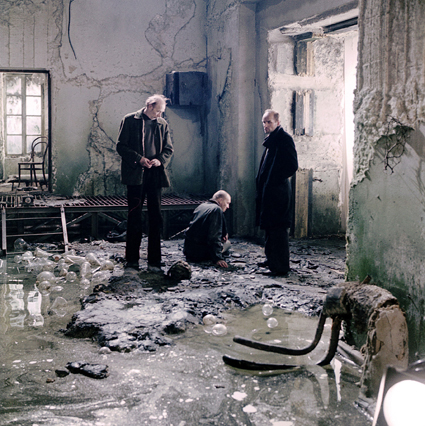
Stalker, Andrei Tarkovsky
GEOFF DYER’S CURIOUS NEW BOOK ZONA CALLS ITSELF “A BOOK ABOUT A FILM ABOUT A JOURNEY TO A ROOM.” IT COULD EQUALLY BE CALLED A BOOK ABOUT A MIDDLE-AGED MAN WHO LIKES TO SPEND ALL DAY IN HIS PYJAMAS WATCHING HIS FAVOURITE DVD. “SO WHAT KIND OF WRITER AM I,” DYER LAMENTS, “IF I AM REDUCED TO A SUMMARY OF A FILM?…WHAT IS THE PURPOSE OF SUCH AN EXERCISE?”
These are pressing questions that never quite go away for both the writer and reader of Zona. How could a recount of an author’s favourite film be considered a valid subject for a book? And why should an author feel the need to defend the existence of a book he is writing? Matters are not helped much when Dyer tells us his “deepest wish” for Zona is nothing less or more than “success, enormous success,” by which he means publication:
“If it is published, if someone will deign to publish his summary of a film that relatively few people have seen, then that will constitute a success far greater than anything John Grisham could ever have dreamed of.”
He needn’t have worried. Canongate in the UK, Random House in the US and Text Publishing in Australia came to the party.
What rescues Dyer’s book from the bonfire of inanity is that this very problem, this dance with meaninglessness, also pervades Andrei Tarkovsky’s Stalker, the film that Zona is so emphatically about. A recognised masterpiece of cinema, a sci-fi epic in its own way, Stalker is nevertheless disconcertingly insubstantial, “a film almost devoid of action,” as Dyer puts it, that leaves us to question whether anything is achieved at all by the conclusion of the narrative. The plot is indeed slim. Two men (one a writer simply called Writer and the other a scientist called Professor) are led by a third (called Stalker) on a journey that takes place over a single day. Their purpose is to travel from point A (a bar), through a magical and forbidden area (called the Zone), to ultimately arrive at point B (a room simply called the Room, where one’s innermost desires are said to be realised). Unfortunately, when they eventually do reach their goal, no-one appears willing to enter.
As Dyer notes, Tarkovsky leaves much space for doubt in his films and in the case of Stalker it is the space to doubt whether the Zone is anything more than just a place, the Room anything more than just a room. Although his main character, Stalker, is emphatic about the miraculous power of these places, there are more than enough reasons to reject his view. Indeed the more one pays attention to the film, the less believable Stalker’s explanations become. Although normally a fervent promoter of the miraculous, Tarkovsky himself was surprisingly open to the idea that the Zone and the Room are nothing special, that they are “a dream of something that does not and cannot exist,” (Tarkovsky, A, Sculpting in Time) “created by Stalker in order to instil faith…in his reality” (Tarkovsky, A in Tassone, A, “Interview with Andrei Tarkovsky (on Stalker)” in Gianvito, J (ed), Andrei Tarkovsky: Interviews).
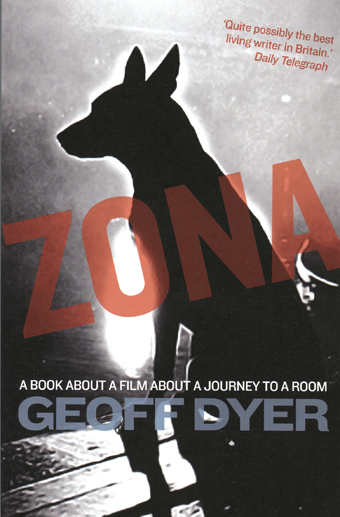
Zona
So what then? A pointless book about a pointless film about a pointless journey? This may well be the point. As Dyer writes:
“The thing about the Zone is that it’s always subtly reconfiguring itself according to your thoughts and expectations. You want it to seem ordinary? It’s ordinary… whereupon it does something briefly extraordinary. (Or does it?)”
In other words, it’s by virtue of Zone’s potential emptiness as a place, and Stalker’s implicit emptiness as a narrative, that the film can acquire actual personal meaning for the viewer. Just like life, it’s the action performed not by the Zone or by the film’s characters but by the viewer that makes Stalker a meaningful experience. And with this understood, Zona offers even a Tarkovskian pedant like me something new: proof that a film seen by a thousand different viewers is a thousand different films. In fact what Dyer wants to emphasise in Zona is that Stalker seen by the same viewer a thousand times is a thousand different films! Beyond his close analysis, it is Dyer’s own experience of the Zone over 30 years of viewings that he wants to convey by ‘reciting’ Stalker, as it were, line for line. “This book is an account of watchings, rememberings and forgettings; it is not the record of a dissection.”
Perhaps it’s a new sub-genre being invented here: a kind of pseudo-critical, stream-of-consciousness film analysis, where details from the film trigger associations for the author (memories of other films, of girlfriends, of old apartments, of playing in abandoned buildings and railway stations as a child, of the grey sky on Sunday, of his father’s aversion to spending money on ice-cream). Sometimes Dyer attempts to contain these associative thoughts within footnotes. But ‘footnotes’ isn’t really an apt term for his sprawling annotations. They are more like sidetracks, and often they take over the text completely. Other times Dyer simply lets the main text go where it may, like the character Stalker, in a way, plotting a route through the mysterious Zone. The path he maps out claims the authority of a narrator, but there’s an undeniable feeling here that he’s just making this shit up as he goes along.
What works in Zona is that Dyer’s loose associative memories provoke further associations for the reader. ‘Ah yes, all those cigarettes in Godard’s Breathless! I remember them too. How it reminds me of being 22, standing in the rain in Paris.’ And so on. This happens all the time when we read a book or watch a film. But in Zona Dyer is trying to make this associative subjective process an explicit aspect of the text (which is exactly what Tarkovsky is trying to do in Stalker). We shouldn’t confuse the two: Stalker is an amazing artistic accomplishment by the standards of any art form; Zona is a light and occasionally funny read with moments of depth. What Dyer has offered by piggybacking on a masterpiece is an extension of Tarkovsky’s artistic project, a quite literal fulfilment of the creative contract Tarkovsky makes with his (devoted) viewers: “whereby the artist obliges the audience to…think on, further than has been stated…[putting] the audience on a par with the artist” (Tarkovsky, A, Sculpting in Time).
Geoff Dyer, ZONA: A Book About a Film About a Journey to a Room, Text Publishing, Melbourne 2012; Andrei Tarkovsky, Sculpting in Time, trans. Kitty Hunter-Blair, Austin: University of Texas Press, Austin, 1986
giveaway
Courtesy of Text Publishing we have three copies of ZONA to give away.
Email giveaways@realtimearts.net with your name and address if you'd like to be in the running.
RealTime issue #109 June-July 2012 pg. 19
© Tom Redwood; for permission to reproduce apply to realtime@realtimearts.net
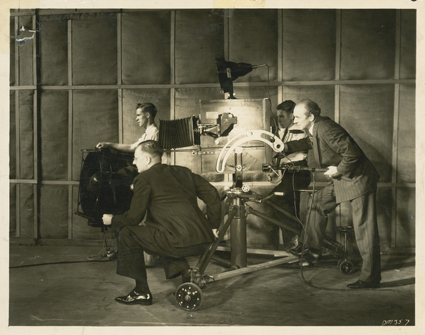
The Silence of Dean Maitland (1935), left: Frank Hurley (cinematographer); seated: Ken G Hall (director); photo courtesy of National Film and Sound Archive
TRUE TO ITS SUBJECT, THE SHADOWCATCHERS IS A VISUALLY RICH HISTORY OF AUSTRALIAN CINEMATOGRAPHY. ALMOST 400 PHOTOGRAPHS, OFTEN THE WORK OF STILLS PHOTOGRAPHERS ON LOCATION, CAPTURE GENERATIONS OF CAMERAMEN LABOURING IN STUDIOS, IN THE BUSH, UNDERWATER, PEERING AT INSECTS, SWEATING OVER TINY CLAY FIGURINES, PERCHED IN TREES, HANGING FROM SPEEDING CARS AND INVENTIVELY ENGAGING WITH EVER EVOLVING EQUIPMENT.
The Shadowcatchers, published and produced by the Australian Cinematographers Society (ACS), is much more than a beautifully designed, very big picture book in glorious widescreen format. Not a book to browse on the lounge or in bed, once opened out on a table to reveal its full visual impact, it equally offers engrossing, informative and entertaining reading. Author Martha Ansara, a cinematographer herself (and producer and director), writes elegantly, tracing the history of the craft across key periods of the development of filmmaking and television in Australia, interpolated with detailed accounts of the lives, styles and achievements of ACS Hall of Fame members. As well there are quotations from cameraman (drawing on the ACS’s substantial archive) that are variously insightful, amusing and alarming.
Given that Australian cameramen (including a handful of women) have been integral to Australian film and television history, Ansara deftly delineates the various social and political forces that have inhibited and encouraged development for over a hundred years. You can come to this book without a knowledge of that history and come away well informed, having also been introduced to some of the technical aspects of camera craft. Much of this is fascinating as we read of cameramen in the 1920s and 30s developing film in their kitchens, making an optical printer out of Meccano or inventing lenses while ‘slushy boys’ fight to keep dust out of processing. Most of the technical information is quite intelligible—only occasionally I found myself turning to Wikipedia to check out blimps and fluidheads.
What gives The Shadowcatchers wonderful cogency is, first, its sense of lineage and heritage and, second, the idiosyncratic Australian character of the history that Ansara unfolds. As you turn the pages you’ll see cameramen grow older, you’ll witness their assistants becoming cameramen and innovators in their own right across the generations. The use of the term ‘cameraman’ is critical. As Ansara tells it, the cameraman from the beginnings of Australian film (not ‘film industry’—we were long denied that) was remarkably multi-skilled and there was no such thing as a simple career path. As camera operator, director, editor and processor, the early cameraman deserves retrospective acknowledgment as filmmaker. Although specialists very gradually supplanted these roles, Australians frequently continued to display superb skills as visual journalists (Neil Davis and David Brill in 1970s war zones) and technical innovators as well as moving into directorial and producer roles. ‘Cinematographer’ is self-defining, but it was interesting to read that cinematographer John Seale insists on being his own cameraman. (The section on Seale is a good example of the book’s brisk, evocative delineation of character and craft.)
As well as the sense of lineage, there are other strands that emerge, for example the considerable number of cameramen who found their way into film through photography, sometimes as a childhood hobby, sometimes maintaining that career side by side with filmmaking. More than a few worked their way up from the periphery of the trade and a surprising number, even up to recent times, didn’t complete secondary schooling or suffered learning problems. Cameramen are frequently revealed to be battlers, especially in the early days—denied good film stock and equipment (hence the drive to innovate), working long hours, sometimes in dangerous circumstances, mocked (by fellow cameraman as well as management) for artistic pretensions into the 1950s, and subordinated to foreign cinematographers on imported productions (but signing up as cameramen for the experience, new ideas and, sometimes, quality equipment, if shocked by the overseas caste system of filmmaking).
In the 1960s and 70s cameramen who once might have worked for commercial studios or television found their niche in the exploratory work of the Commonwealth Film Unit or established themselves as freelancers. Geoff Burton, Peter James, Russell Boyd, Don McAlpine and others took with them their own crews from feature film to feature film from the 70s onwards (including to the US). As Ansara writes about technological change, ironically many filmmakers today are like their antecedents—multi-skilled, now working inventively with inexpensive soft and hardware. Top cinematographers work with incredibly expensive technology but are no longer lone masters of their craft—the video spilt while filming allows all the ‘creatives’ to see the shots, eliminating the need for rushes and reducing the cameramen’s sense of having got it right on their own. As well, post-production has become hyper-elaborate, the final look of the film moving further and further away from the shooting and requiring even more sophisticated technical knowledge and collaborative commitment from the cinematographer. Ansara estimates that “50% of current Australian product is news, sport, current affairs and variety/light entertainment.” Cinematographers are “reliant on the same kind of work that was the mainstay of the old Cinesound and Movietone cameraman, albeit in a modern form.”
The photographs are consistently revealing, a perfect match with Ansara’s history and the anecdotes and the Hall of Fame profiles. We see the sheer bulk of both early feature film cameras and the very latest too (with an undaunted Andrew Lesnie standing before them) alongside generations of small newsreel cameras and the most recent digital portables. The filmmakers of the first half of the 20th century, in studios or on the streets, wear suits (as in the photograph of Frank Hurley behind the camera on this page). Another image of Hurley shows him, without suit, washing his film in the Antarctic ocean after shipboard processing for Hour of the Blizzard (1913). The book’s mix of portraits and unposed shots makes for a variety of perspectives on the people behind the camera and the circumstances of their work.
The elegant, suited shots of studios in production mode sometimes belie the demands on filmmakers: the Bondi Junction skating rink, much used as a studio in the 30s, had to be vacated at night for skaters, or the Cat Pavilion at the Sydney Showground emptied of heavy film equipment to make way for competitive cats. Bill Trerise, a leading newsreel maker, looks gentlemanly enough in the pictures, but was known as Bloody Bill for his tyrannical behaviour. He won acclaim for a clever strategy to create a slow motion film finish to a Melbourne Cup. He was criticised by local management but the New York office applauded the innovation.
Bill Carly, a leading cameraman who collaborated with Trerise on Jungle Partrol (1944), was furious when Howard Rubie, a young assistant cameraman, posted a quotation about film as art from the great documentarist Howard Grierson on a staff notice board. Carly tore it down and no one on the staff spoke to Rubie for a week. Hugh McInnes, who apparently “took to Trerise with a spanner” at one time, was dismayed by the intrusion of directors and “film society people” in the 50s. Ansara tells us that filmmakers largely comprised left wing Catholics, further bonded by meeting at particular pubs, mateship in often tough working conditions and an emerging need to unionise. This bond was not very accommodating for a young female clapper loader even in the 1970s as Jan Kenny (later a cinematographer and teacher at AFTRS and the only woman in the ACS Hall of Fame) explains in painful detail—the crew waiting for her to fail or drop heavy equipment until she’d proven herself. Not something that would happen today, she says. (Although many women work in film these days, Ansara points out that only 3% of the 700 ACS membership are women.)
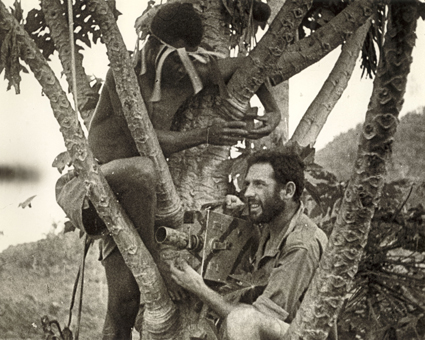
Damien Parer, 1943, with New Guinean assistant Cyril and Newman Sinclair camera
Frame enlargement courtesy John Hosking
Damien Parer, 1943, with New Guinean assistant Cyril and Newman Sinclair camera
The contribution of the newsreel, ethnographic and commercial promotional film to the evolution of Australian cinematography is never underestimated by Ansara. The documentation of World War II by the federal government’s Department of Information Film Division (later the Commonwealth Film Unit) expanded the approach to filming through the work of Damien Parer who had trained with Arthur Higgins, a leading cinematographer in the 30s in features and documentaries. Influenced by European filmmakers, Parer proved that the handheld camera could provide authenticity and convincing journalism. His Kokoda Front Line (1942) won an Academy Award. He was killed in battle in 1944. His heritage has been realised in the work of Neil Davis (who died filming a coup in Thailand) and David Brill, particularly in their coverage of the Vietnam War. It was Brill who declared, “I’m a video journalist.” These were cameraman who, as Ansara, points out, constructed stories as they filmed.
Risk is a substantial theme in the book, covering everything from lugging backbreaking equipment to working in appalling weather and cruel locations. Then there are the accidents—Keith Gow, left with the imprint of a camera on his face for the rest of his life when a plane taking off over him dipped in an air-pocket, nearly killing him. Les Walsey recalls shooting a bush fire in the 50s in a suit: “the flames were leaving the railway line and the ash falling on my nylon pop-on shirt and it was going ‘Pshheew! Pshhew!’—holes all over. I ended up with a shirt like a colander. Here we were covering a bush fire in shirts and ties—this is how we dressed because we were professionals.” Howard Rubie admits, “because you had the camera you felt that nothing could happen to you.”
Another recurrent theme is the famed ability of our cinematographers to deal with extremes, and subtleties, of light. Ross Wood says, “When you go overseas and come back again, you notice how hard our light is…those heavy shadows under. I’d like to utilise that midday sun, I think it’s terribly characteristic of this place…this hat with no face underneath it, I’d like to use it: almost a Ned Kelly feel about it, I suppose, the square head with no detail—just a block.”
The lineage theme so strong among cameramen since filmmaking’s inception here continues into the 70s and beyond with Australian directors and cinematographers forming significant teams here and overseas while cinematographers and their crews continue, writes Ansara, to display the characteristic ability to work fast, across genres, in harsh conditions and with a sense of team.
The book gives substantial space to documentary cinematographers including the great innovator Jim Frazier, whose Panavision-Frazier Lens has allowed for intense, stable close-ups and depth of field that have found their way into his work for David Attenborough, Mark Lewis’ Cane Toads: An Unnatural History (1987) and Jurassic Park.
Many other cinematographers are accounted for in Ansara’s history or in numerous images of them at work. The Shadowcatchers is a monumental and generous representation of those skilled artists who work with and behind the camera, largely unknown to the audiences who enjoy and admire their work. Here they are made visible. Ansara and the ACS have proudly celebrated the achievements and legacy of the profession with superb design by Ana May and production by Eddy Jokovich of ARMEDIA, fine writing and superb documentation.
Read Tina Kaufman’s interview with Martha Ansara and Calvin Gardiner in RealTime 108.
Martha Ansara, The Shadowcatchers, ACS, Austcine Publishing, North Sydney, 2012; 288p, soft cover $66, hardbound limited edition signed by Academy Award-winning Australian cinematographers, $250
RealTime issue #109 June-July 2012 pg. 20
© Keith Gallasch; for permission to reproduce apply to realtime@realtimearts.net
THE FINAL REPORT OF THE CONVERGENCE REVIEW RECOMMENDS FUNDAMENTAL CHANGES TO THE REGULATION OF MEDIA ENTERPRISES IN AUSTRALIA. INSTEAD OF DIRECTING MOST OF THE REGULATION AT TV AND RADIO LICENSEES, THE REVIEW PROPOSES TO REGULATE ‘CONTENT SERVICE ENTERPRISES.’
The big questions now are whether or not a vulnerable minority government a year away from an election will endorse the plan; which organisations might be covered by the definition of ‘content service enterprises’; and how the complex transition from the current rules to any new ones might be managed.
A government wanting “to examine the operation of media and communications regulation in Australia and assess its effectiveness in achieving appropriate policy objectives” had many places to focus.
It could have concentrated on the ‘socialisation’ of media through applications like Facebook; the proliferation of media channels and the fragmentation of audience choices; or the growing power of media users.
why convergence?
It chose ‘convergence,’ targeting the increasingly blurred boundaries between broadcasting and telecommunications. These are the two sectors of the communications industry around which the most important legislative fences are drawn.
Convergence is not a new concept. For decades, speakers at media conferences have brought Venn diagrams to illustrate the growing overlaps between broadcasting, telecommunications, information technology, publishing, film, music and much else. When radio broadcasting was new, it seemed to be a convergence of wireless and recorded music. Early television was conceptualised as a convergence of radio and cinema. Cable TV brought together TV and telecoms.
Nor is convergence a steady, one-way drive to the sweet spot in those Venn diagrams. Anyone who has watched new enterprises, industry sectors and sub-sectors emerge to exploit opportunities in online and mobile communications might have wondered just when the ‘convergence’ those conference speakers promised would finally show up. When we finally got our media devices down to a laptop, a mobile phone and a TV, along came tablets, a ‘fourth screen.’
more than media
And convergence is not just about media. Print, radio and TV have long looked for territory outside their own borders; other industry sectors see themselves converging with communications. Newspapers got into radio and newspaper/radio operators into television. Later, they bought sporting competitions, venues, ticketing operations, leisure resorts. In the early days of radio, department stores, equipment manufacturers, trade unions and churches set up broadcasting stations. Now, banks are muscling into Facebook.
So convergence is a hard concept and it is not the only thing going on. The early papers produced by the long-running Convergence Review spread out in many directions. They asked almost every question you could ever ask about media, many of them more than once. The final report does not try to answer them all, choosing to concentrate most of its energy on a few big topics that are profoundly affected by ‘convergence.’ These are spectrum management; diversity and competition; respect for community standards in media content; and finally, requirements for Australian production and local news and information.
spectrum management
On spectrum management, the review recommends that spectrum for TV and radio broadcasting be allocated in the same way, for the same duration and at the same price as it is allocated for telecommunications uses like mobile telephony and broadband. To some extent this has already happened, because the large amount of ‘digital dividend’ spectrum that will be released for alternate uses when analogue TV is completely switched off at the end of 2013 will be re-allocated by auction and probably acquired by telecom companies for mobile broadband. The even tougher step is to shift all the spectrum which TV and radio broadcasters continue to use over to a new scheme of allocation and charging.
re-regulation
On the other three major issues, the review recommends a fundamental change to the way broadcasting regulation works. Until now, diversity and competition, respect for community standards and requirements for Australian and local content have all been dealt with through conditions attached to TV and radio licences. When that scheme was put in place, commercial TV and radio stations held a uniquely significant place in the electronic media landscape. ‘Convergence’ and other changes mean this is no longer the case.
Having decided that diversity and competition, respect for community standards and Australian and local content all still matter, and are likely to require regulatory intervention, the Convergence Review had to come up with a structure for it that didn’t depend on the most important electronic media enterprises all holding broadcasting licences.
The concept it produced is the “content service enterprise.” These will focus on “large enterprises that provide professional content services to a significant number of Australians.” They will continue to have their ownership scrutinised more closely than the general competition law allows, although the review proposes replacing most of the current strict cross-media limitations with a more flexible “public interest” threshold for approving mergers. They will also have to “meet community expectations about standards applicable to their content” on matters like sex, violence, accuracy and fairness in news and current affairs and “contribute in appropriate ways to the availability of Australian content.”
content protection
The Convergence Review thinks Australian program genres that need regulatory support in 2012 are still Australian drama, documentary and children’s programs. (PwC data published as part of the report estimates that without the existing quotas, spending on children’s programs would be wiped out completely, spending on adult drama would fall by 90% and on documentaries by 50%.) But “the situation may change in the future and the regulatory environment should be flexible enough to allow for this.”
It wants a “uniform content scheme” under which all content service enterprises have two options: to invest a percentage of their Australian market revenue from professional television-like content in new Australian drama, documentary and children’s content (the “investment option”) or to contribute to a central converged content production fund (the “contribution option”).
Once that scheme is in place, the review wants Australian content quotas abolished; but while the transition is occurring, it wants them changed: first, to increase the commercial TV drama sub-quota by 50% but allow it to be met by programs screened on digital multi-channels as well as main channels, and second, to require subscription TV children’s and documentary channels to spend 10% of their program budgets on new Australian programs, like the movie and drama channels.
who are the content service enterprises?
What all this might mean depends crucially on who the ‘content service enterprises’ are. The proposed definition is intended to catch “only the most substantial and influential entities.” They will be organisations that have control of the professional content they deliver, meet a threshold of a large number of Australian users of that content (proposed to be at least 500,000 unique viewers/users per month), and meet a threshold level of revenue from supplying that professional content to Australians (proposed to be $50 million per year).
The precise thresholds of users and revenue will be determined and periodically reviewed by the communications regulator. Rough calculations included in the report suggest the proposed thresholds are designed to preserve the status quo for now: incumbent broadcasters are caught; Google (more than enough monthly users but not enough revenue according to PwC), Telstra and Apple (not enough monthly users or revenue yet according to PwC, although according to Nielsen, iTunes had a unique monthly audience of 2.8 million as far back as June 2011).
Given the requirements imposed on “content service enterprises,” a big part of the policy battle ahead will be waged by online and mobile media enterprises that have never had to deal with the regulatory apparatus that applied to TV and radio broadcasters.
They are already working hard to ensure the convergence that has taken their platforms and services so deeply and profitably into the lives of consumers does not also lead them into new kinds of public obligation.
The Convergence Review: an independent review established by the Australian Government to examine the policy and regulatory frameworks that apply to the converged media and communications landscape in Australia. March 2012, www.dbcde.gov.au/digital_economy/convergence_review
RealTime issue #109 June-July 2012 pg. 21
© Jock Given; for permission to reproduce apply to realtime@realtimearts.net
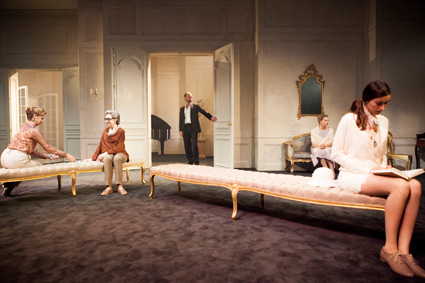
Heather Mitchell, Jane Harders, Hugo Weaving, Justine Clarke, Geraldine Hakewill, Les Liaisons Dangereuses, Sydney Theatre Company
photo © Brett Boardman
Heather Mitchell, Jane Harders, Hugo Weaving, Justine Clarke, Geraldine Hakewill, Les Liaisons Dangereuses, Sydney Theatre Company
WITH CONTEMPORARY PERFORMANCE THIN ON THE GROUND IN THE LAST TWO MONTHS, MY ATTENTION WAS ON THEATRE PRODUCTIONS AT THE SYDNEY THEATRE COMPANY AND BELVOIR. IT’S DIFFICULT TO GO TO THE THEATRE THESE DAYS WITHOUT HAVING A META-THEATRICAL EXPERIENCE, THANKS TO CONTINUING DISCUSSION ABOUT RE-INTERPRETATION, ADAPTATION AND HERITAGE IN PRESS REVIEWS, BLOGS AND LETTERS TO THE EDITOR. HAPPILY, THIS SEEMS HEALTHY AND ISSUES ARE UNLIKELY TO BE RESOLVED, EVER.
Resident Belvoir director Simon Stone contributes to the debate with a substantial program note for his remake (I’ve decided to borrow that term from the movies here by way of apt if somewhat indirect analogy) of Eugene O’Neill’s Strange Interlude. He has little to say about the play and much about theatre’s long and undeniable history of adaptation and borrowing—and, one would like to add, wilful plundering and bowdlerising. Surprisingly, despite the considerable success of The Wild Duck and Thyestes, Stone feels the need to mount an argument for his practice, seeing himself as sustaining tradition while at the same time renewing it in terms of our own milieu. Fair enough, but it’s not the fact of such engagement with heritage but whether the result is a gain, an exceptional work in itself. Not only that, but it has to have said something significant about the original itself to make its mutated resurrection worthwhile. I hope for that much.
sydney theatre company: les liaisons dangereuses
The set for the Sydney Theatre Company production of Christopher Hampton’s Les Liaisons Dangereuses is an elegant, aristocratic city apartment, of a style originating in the late 18th century and sustained, if less ornately, into the present by the French bourgeoisie and their betters. The costuming, with its expensive, fashionable formality, likewise suggests past and present, if in a more but not too contemporary vein. Alan John’s music equally evokes classical restraint and a moody jazz-inflected modernity. Consequently Sam Strong’s production doesn’t quite live up to the press release claim that he would “acid-wash a familiar story, stripping it back to its essential layers in the intimacy of the Wharf 1 Theatre.” Instead, the overall ambience, if free of frills and courtly etiquette, suggests a cool balance between now and then, impressionistically accentuating historical similarities with regard to upper class indolence, sexual license and corruption.
Hugo Weaving as Valmont finely grades the viscount’s progress from rampant seducer to a man trapped, by love, in his own plotting, if without defining his character as distinctly as, say, he did so memorably with the doctor in Uncle Vanya. Black suit and white shirt in increasing dishabille signals singularity of purpose, lack of ostentation and decline, whereas his co-conspirator, La Marquise de Merteuil is attired (masked even) in a series of elegant gowns. With exquisite near-stillness, Pamela Rabe exudes power and determination, delivering to perfection the Marquise’s rationale for her behaviour—her very vulnerability as a woman in a patriarchal society. It’s significant that she is the only character in the play who reveals a back story, and although it’s Valmont’s dilemma and his death that generate some climactic empathy, it’s the Marquise who epitomises the moral complexities and ironies that Hampton summons out of Pierre Choderlos de Laclos’ novel of 1782.
This is a straightforward production, safely realised, letting fly the wit inherent in Hampton’s writing and neatly treading the play’s thin line between grim comedy and bleak social commentary. The experience set me thinking that perhaps the play has passed its use-by-date (in form it feels faux historical) or that the casting of 30-somethings as Valmont and La Marquise, closer in age to their young victims, might have been more meaningful and more disturbing. A much more contemporary context than Strong has offered is also conceivable, one further removed from the 18th century than the director has taken it.
belvoir: every breath
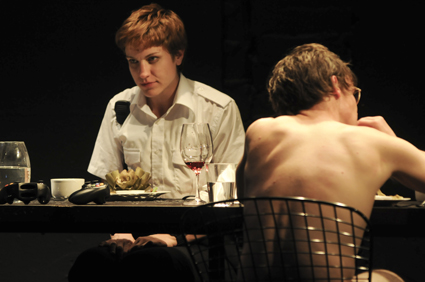
Shelly Lauman, Dylan Young, Every Breath, Belvoir
photo Heidrun Löhr
Shelly Lauman, Dylan Young, Every Breath, Belvoir
Benedict Andrews’ stature as a director is in no doubt—his production of Botho Strauss’ Gross und Klein has been a huge success in Sydney, Paris and London, adding to a long list of achievements. In turning to playwriting he has to reach the very benchmarks he has himself established as director, not least when directing his own writing. Every Breath is sparely scripted, cinematic in the brevity of its dialogue and scenes (along with frequent ungainly blackouts) and dominated by an overtly symbolic set design (as if the dysfunctional family the play centres on is likely to be crushed by its wealth as embodied in architecture).
On the page, the play reads as an intriguing screenplay, but on the stage it feels cumbersome, short on words if strong on images, scenes expiring before gaining momentum and performances, whatever their individual merits, lacking ensemble cohesion. That doesn’t mean that Every Breath was entirely lacking. The scenario in itself is worth addressing (before being tossed out by some critics as, in effect, class warfare).
A naive young security guard, Chris (Shelly Lauman), protecting a well-off middle class family facing an unspecified threat, finds himself the object of each member’s projections, not least sexual. He obligingly has sex with everyone, but learns that such relations are limited to the house, to the point where, in a dream he recounts, he experiences himself—or herself—as an object of display. It’s not clear after a while what gender Chris is: it depends who is fantasising. In the end that includes us too (as if it hadn’t all along) as Chris, on a new security job in an empty building and freed from the burden of projections, strips naked alone centrestage. Shortly before this, the father, Leo (John Howard), gives up his writing from which he has become alienated; Olivia (Eloise Mignon) the daughter discovers she can write (if only to create on ongoing fantasy around Chris); while her twin brother Oliver (Dylan Young) is desperately bereft; and the mother, Lydia (Angie Milliken), although revealing more self knowledge than the others, longs too for Chris’ return. This curious aggregation of monologues at the play’s end is more satisfying than much of what has gone before.
Andrews prefaces the playscript with a quotation from Karl Marx explaining the notion of alienated labour. Alienation takes multiple forms in Every Breath: the father whose writing and others’ perception of him no longer make sense; the wife whose loss of a job, “the threat” and Chris have unanchored her, “hollowed her out”; the daughter whose twinness has denied her a sense of difference; the brother who is shy of his sexuality until the security guard arrives; and Chris, the only literal labourer in the scenario, refused identity by the projections of others, until he seizes solitude. He remains a worker not in control of his labour—but what would it be to own ‘security’? As a kaleidoscopic refraction of alienation the play is at its strongest and strangest.
Every Breath bears a broad resemblance to Marxist filmmaker Pier Paolo Pasolini’s fantastical Teorama (1968), an almost metaphysical foray into alienation in which a young man (not Andrews’ she-he) enters the life of an upper-class family, has sex with all of its members and leaves them to face crises of identity—the father, for example, hands over his factory to his workers and wanders off naked. Perhaps in acknowledgement of Pasolini’s influence, Andrews has the father in Every Breath declare in his final speech, “Before [Chris] came to us my writing had become a factory. Now he’s gone I’ll send the workers home. I’ll unplug the great machines, shred the files in the filing cabinets. I’ll open the gates so anyone can come in and take what they want.” Every Breath is an intriguing work, perhaps only at the first stage of its development in whatever form. Regardless of the production’s failings, the excellent low-key performance by Shelly Lauman as Chris lent the work coherence and gravitas.
belvoir & force majeure: food
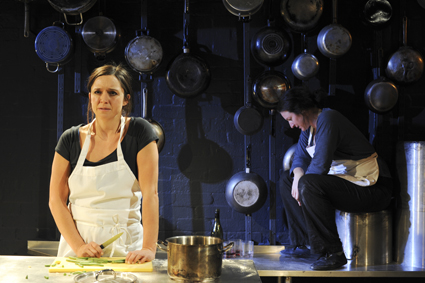
Emma Jackson, Kate Box, Food, Belvoir & Force Majeure
photo Heidrun Löhr
Emma Jackson, Kate Box, Food, Belvoir & Force Majeure
Food, written by Steve Rodgers and directed by Rodgers and Kate Champion, is an amiable, intimate fable about aspiration and self-belief focused on two sisters who bond anew. The elder one, Elma (Kate Box), a talented cook (who has given up on finding a male partner), is prodded by hapless younger sister Nancy (Emma Jackson) to transform their humble cafe into a restaurant, aided by an enthusiastic Middle-Eastern immigrant, Hakan (Fayssal Bazzi). Success ensues, but so do complications: Nancy encourages Hakan to court Elma, which he does, out of feelings of sympathy and obligation, but not attraction; overcome by his inauthentic behaviour he leaves. In a cathartic finale, the sisters have to face some incredibly grim truths about themselves and their relationship.
The spare plot is thickened with gently choreographed playfulness (with food or wrestling), not always discernible projections onto a wall of copper cooking pans (or home movies magically manifesting inside saucepans) and informal movement that arises out of the everyday—such as escapist showering and limb-tangling drunkenness. Projections also assist Hakan who, in a stylistic swerve for this production, addresses us directly with a slide show of his lovers (“a string of one and three-night stands”).
Hakan’s jokiness and joyousness, his comic mangling of English and a poetic inclination steer the characterisation towards stereotype, but Bazzi undercuts it by adroitly capturing the man’s sense of failure and loss. Kate Box is admirable as Elma, blunt, wounded and withdrawn (“I’ve disappeared…I can no longer see myself”), and then released, while Jackson subtly reveals a slowly maturing Nancy, an unlikely, but believable agent of change.
belvoir: strange interlude
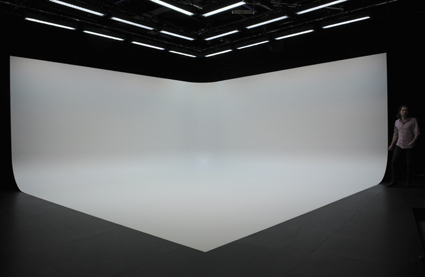
Strange Interlude set, Simon Stone, Belvoir
photo Heidrun Löhr
Strange Interlude set, Simon Stone, Belvoir
I can’t call it a cyclorama, it’s too sculptural for that, too firm, and the label is demeaningly functional. Robert Cousins’ design for Strange Interlude and Damien Cooper’s lighting of it suggest some eternal, enveloping emptiness in which characters hover as if hologrammed, likely to evaporate, but digitised, seen more sharply than reality might ever allow. It flows smoothly on the horizontal, ignoring the theatre’s right-angled corner walls, and in a subtle curve pours down onto the floor where it appears, at some unimaginable time, to have set. Together Cousins and Cooper have created a stand-alone artwork akin to the elusive new media artefacts of the likes of James Turrell. But it works even better with people inhabiting it as they oscillate between exterior engagement and interior musings, these delivered as easeful asides that, for the most part, work quite effectively (Groucho Marx famously quipped in Animal Crackers in 1930, “Pardon me while I have a strange interlude”). Objects too—a low timber jetty, an electric train set assembled by a child—have a heightened presence in this seemingly ephemeral space in which decades pass.
It’s a pity that this updated version of O’Neill’s 1928 play doesn’t improve the melodramatic plot even though it renders the characters and the dialogue more plausible (and in some cases much more interesting), radically trimming the number and volume of novelistic asides and offering the performers some fine opportunities. For all the apparent modernity of the language and design, the play remains rooted in its essential datedness. So, it’s an interesting curio on which considerable attention has been lavished to some good effect. It is very funny, exactly because the original is melodramatic; but Stone and his performers manage to maintain the emotional ugliness of the scenario while letting the improbabilities fly by as if utterly plausible, so that we feel we are laughing with, not at.

Emily Barclay, Mitchell Butel, Toby Truslove, Strange Interlude, Belvoir
photo Heidrun Löhr
Emily Barclay, Mitchell Butel, Toby Truslove, Strange Interlude, Belvoir
Emily Barclay rightly dominates the first half as Nina Leeds, a petulant, brittle child-woman who has lost her lover to war, her will to live diverted into promiscuity with wounded soldiers, then a wrong marriage and infidelity. She’s less central in the second half, a pity, where loyalty and resignation, played out by Barclay with cool elegance and stillness, dominate, even though her soul still belongs to a long-dead soldier. Instead, we watch the men in her life crumble. Doctor Ned Darrell (Toby Schmitz), an authoritative rationalist sinks into self-pity after having fathered a child with Nina, whom they pass off as her husband’s—the impotent Sam Evans (Toby Truslove in a rich performance of boyish jocularity mutating into drunken, egocentric assertiveness). Completing the despairing trio is novelist Charles Marsden—Mitchell Butel exquisitely realising the transformation from severely repressed mother’s boy into a bitterly alert would-be lover of Nina).
One of the most effecting scenes is between Nina’s son Gordon (Nicholas Bakopoulos-Cooke) and Darrell. The boy hates the attention the doctor lavishes on his mother, while Darrell, faltering inadequately, attempts to form a relationship with his son. Schmitz captures a sense of depressed helplessness at the loss of both love and child, emotionally locked-in except when with the unresponsive Nina. Bakopoulos-Cooke’s Gordon is observant, blunt, determined and self-contained, his wariness of Darrell at once realised as cruel and comic.
Strange Interlude was a well-received stream-of-consciousness experiment in 1928 (it won the Pulitzer prize for Drama) and it remains one now, updated as much as it can be here. Rewarding design, adroit adaptation and fine performances can’t make it something it isn’t, but it is strangely watchable, not least for its marvellous scenography.
sydney theatre company: under milkwood
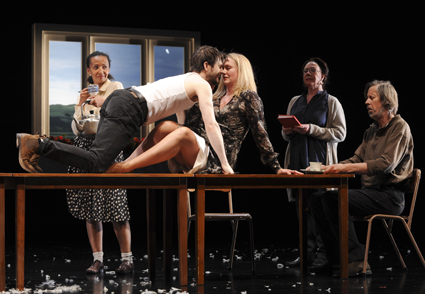
Paula Arundell, Cameron Goodall, Helen Thomson, Sandy Gore, Bruce Spence, Under Milk Wood, Sydney Theatre Company
photo Heidrun Löhr
Paula Arundell, Cameron Goodall, Helen Thomson, Sandy Gore, Bruce Spence, Under Milk Wood, Sydney Theatre Company
I was 13 when I played First and Second Voices in a high school production of Dylan Thomas’ Under Milkwood (directed by Adelaide man of the theatre Myk Mykyta). Like Jack Thompson and Sandy Gore as the Voices in the STC’s stage account of the radio play, I performed the lines from a mix of memory and reading from a hardbound copy of the script. My young brain simply wasn’t up to the mind bending task of accommodating a seemingly vast prose poem. Perhaps it was the case of older brains in the STC production, or simply a storytelling device, which worked so well. When we were addressed directly, the effect was magical: Thompson’s opening lines spoken on a dark, bare stage, the delivery lucid, the poetry unforced, as he moved slowly to the edge of the stage, taking us gently into the dream world of the Welsh village of Llareggub.
In my copy of the play, the sexy bits had been marked for deletion by the deputy headmaster; needless to say, although sensing the pervasive eroticism of the play, I didn’t understand quite a few of those bits, whereas I know now that, as unlikely as it seems, she certainly did. Kip Williams’ direction preserves all the magic I still recall of the play, reigniting for me its passion, sensuality, playfulness and ghostly chill. Wisely, Williams avoids too much literalising, sustaining the integrity of the radio play’s capacity to generate potent images. Costume changes are minimal, the Voices flow around the villagers, vividly revealing more than we see on stage. Performers slide an armchair, school desks, a bed and Organ Morgan’s organ on and offstage with apt ease, or transform from one character to another in a second or two with a change of hat or unfurling of long hair. No-one adopts a Welsh accent, and the poetry still sings.
The sense of ensemble is strong, everyone shines in this dynamic village of the living and the dead: Drew Forsythe alternating between the benign Reverend Jenkins and the womanising Waldo, Paula Arundell between the licentious Polly Garter and the lovelorn but eternally virginal Myfanwy Price and Mae Rose Cottage (“You just wait. I’ll sin till I blow up!”), Helen Thomson realising sundry idiosyncratic women including the ghost of Rosie Probert (in one of the production’s most affecting scenes), beloved of Captain Cat, beautifully played by Bruce Spence. When not doubling as a village gossip, Spence pairs with Forsythe as the hilariously sad Mr Ogmore and Mr Pritchard, the late husbands of the tyrannical Mrs Ogmore-Pritchard. Sandy Gore drops out of Second Voice to create this daunting figure—an interesting touch that makes Second Voice more a part of the village fantasia. In terms of consistency, it’s an odd gesture since First Voice is offered no such opportunity—not that it would be welcome. However, it does raise the issue of the deployment of the Voices. Thompson and Gore wander through the action or often stand, sometimes awkwardly, to the side of it. I suspect there are opportunities for further integration.
The stage is bare save for the flow of people and furniture, but as day breaks three sets of flower-potted windows appear upstage, through which we see a naturalistic horizon of water and low lying hills, the landscape brightening into bristling daytime and then subsiding into the twilight and night of ghosts—gliding out from between the windows—and ever returning dreams. The apparently simple design by Robert Cousins (set) and Damien Cooper (lighting) lends a painterly aura of solidity and transience to the half-dream world of Llareggub. Likewise, Alan John’s compositions for the songs of Polly Garter and Mr Waldo raise the play’s poetry to an even more transcendent level—particularly with the organ’s Bachian counterpoint to Arundell’s marvellous singing, amplifying at the same time Organ Morgan’s profound love for the great composer (at his wife’s expense). Forsythe’s lamenting baritonal account of Mr Waldo’s childhood is equally moving. Having the composer playing the role of Organ Morgan at his organ onstage lends particular power to these scenes and the mood of the production throughout.
Kip Williams’ Under Milkwood is true to the spirit of Dylan Thomas’ creation: it is wildly funny, tender and melancholy, poetically voiced without force in our own accent and everyday dress inventively deployed (costumes Alice Babidge) and, above all, plays out as an hour and 40 minutes of delicious dreaming we take away with us into our own night.
Sydney Theatre Company: Les Liaisons Dangereuses, writer Christopher Hampton from the novel by Choderlos de Laclos, director Sam Strong, performers Justine Clark, Geraldine Hakewill, Jane Harders,James Mackay, Ashley Ricardo, Heather Mitchell, TJ Power, Pamela Rabe, Hugo Weaving, set Dale Ferguson, costumes Mel Page, lighting Hartley TA Kemp, composer Alan John, sound design Steve Francis; STC Wharf 1, Sydney, April 5-June 9; Belvoir, Every Breath, writer, director Benedict Andrews, performers John Howard, Shelly Lauman, Eloise Mignon, Angie Milliken, Dylan Young, set design, costumes Alice Babidge, lighting Nick Schlieper, composer Oren Ambarchi, sound design Luke Smiles; Belvoir Street Theatre, Sydney, March 28-April 29; Belvoir & Force Majeure: Food, writer, co-director Steve Rodgers, co-director Kate Champion, performers Kate Box, Emma Jackson, Fayssal Bazzi, design Anna Tregloan, AV, lighting Martin Langthorne, composer, sound designer Ekrem Mulayim; Downstairs, Belvoir Street Theatre, April 26-June 3; Belvoir, Strange Interlude, writer, director Sam Stone after Eugene O’Neill, performers Akos Armont, Nicholas Bakopoulos-Cooke alternating with Callum McManis, Emily Barclay, Mitchell Butel, Kris McQuade, Eloise Mignon, Anthony Phelan, Toby Schmitz, Toby Truslove, designer Robert Cousins, lighting Damien Cooper costumes Mel Page, composition and sound design Stefan Gregory; Belvoir Street Theatre, May 5-June 17; Sydney Theatre Company, Under Milkwood, writer Dylan Thomas, director Kip Williams, performers Paula Arundell, Ky Baldwin, Alex Chorley, Drew Forsythe, Cameron Goodall, Sandy Gore, Alan John, Drew Livingston, Bruce Spence, Jack Thompson, Helen Thomson, designer Robert Cousins, costumes Alice Babidge, lighting Damien Cooper, music Alan John, sound design Steve Francis: Drama Theatre, Sydney Opera House, May 26-July 7
RealTime issue #109 June-July 2012 pg. 22-23
© Keith Gallasch; for permission to reproduce apply to realtime@realtimearts.net
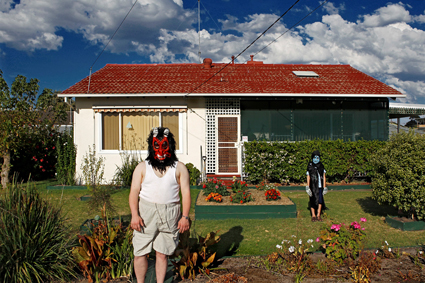
Hell House, Back to Back
photo Jeff Busby
Hell House, Back to Back
ARTS HOUSE, A MAJOR CITY OF MELBOURNE CONTEMPORARY ARTS INITIATIVE, IS BASED AT THE OLD NORTH MELBOURNE TOWN HALL. PERFORMANCES ARE PRESENTED IN THE HALL, AT THE ADJOINING WAREHOUSE AND THE NEARBY MEAT MARKET. ARTS HOUSE HAS BECOME A PIVOTAL CULTURAL CENTRE FOR THE CURATED STAGING OF INNOVATIVE LOCAL, NATIONAL AND INTERNATIONAL PERFORMANCE. I SPOKE WITH CREATIVE PRODUCER ANGHARAD WYNNE-JONES ABOUT ARTS HOUSE AND ITS PROGRAM FOR THE SECOND HALF OF 2012.
What attracted you to the job as Creative Producer at Arts House?
In 2008 I came back from the UK where I’d been artistic director of the London International Festival of Theatre [LIFT] for three and a half years, and one of the things I really noted was how exciting it was to feel that there was a venue in the city that was presenting work that felt internationally aligned. There’s not a huge percentage of the work that is international, for obvious reasons, but international work was consistently being programmed. It was of a scale and scope that connected really strongly for me with the way that artists were working in the city, which I think can be quite different from some of the work we see within the international arts festival scenarios. There it’s often brilliantly spectacular, big scale and impressive in other ways but I really enjoyed that sense that Arts House was a kind of connecter on the international network of contemporary practice.
Also, it’s interesting for me that Arts House is a council venue with a sense of history, of being connected to a residential community in North Melbourne and having become a cultural centre. I was interested in re-locating some of those connections between the venue’s historical civic function and its cultural function.
Is the Meat Market still a significant part of your ambit?
It is and it’s a most amazing asset. It’s owned by Arts Victoria but managed by the City, which cannot invest its own programming funds into the Meat Market. Any program we do there has to come from funds outside of the City. It’s an incredible resource both for the city and for the state but it is clearly under-used currently. I think that’s generally understood by all of the stakeholders. I feel confident that there will be an investment in it as a really critical cultural space.
We’ve also got a new space that’s just come online—the Warehouse, just out the back of the Town Hall. It’s very small with a capacity of 60 but already we have a program of work called Warehouse Salon where artists can talk about their work, have a beer and a pizza.
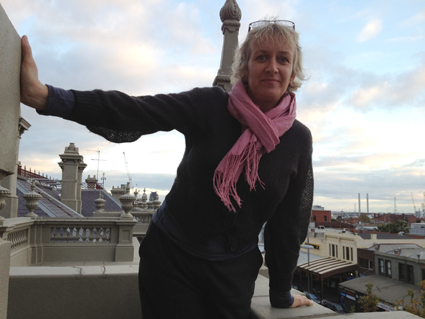
Angharad Wynne-Jones
courtesy Arts House
Angharad Wynne-Jones
You have a strong interest in the environment and its survival. Is that reflected in your directorship? [Wynne-Jones is currently the Producer of TippingPoint Australia—an international network of scientists and artists engaging with climate change; RT100]
Yes. I think the City of Melbourne—also the City of Sydney—is exemplary in terms of government organisations in setting standards. The target for City of Melbourne is zero emissions by 2020. That’s a necessary framework to be working within. Culturally, I’m really interested in how artists engage with the idea of radical carbon reduction and what the impact of that might be on the way we make work, the way we participate in it and engage with it. If there is anything not completely terrifying about climate change it is the opportunity to re-imagine some of those old modes of cultural production that have serviced a particular kind of economy, again, often at the expense of the individual artist. This is an opportunity to re-imagine some of those relationships.
Arts House has been a player in some large events such as the Dance Massive contemporary dance festival. Is that still within your purview?
It is. When I first came into the position at Arts House, there was a kind of ‘All Change’ of artistic directors in terms of the Dance Massive consortium. Marian Potts took over at Malthouse, Angela Conquet at Dancehouse and Minerva Draeger at Ausdance. You could have imagined the model might be up for discussion—and certainly we’ve talked about it at length—but there’s no doubt that there’s 100% commitment to the event. It’s one of the most successful and interesting models of consortium and festival collaboration around. It’s a brilliant way of developing audiences, enabling artists to re-present work that maybe hasn’t been seen by a large audience, facilitating those connections and critical discussion between artists and audiences and reviewers and also inviting international presenters to come in and see some of the really extraordinary work that we have here.
Dance Massive combines with the National Dance Forum creating a really strong focus that is very exciting. We just had the Expression of Interest submissions for Dance Massive 2013 and we received 60, which is great in that it shows the sector’s aspirations.
Australia has been so long in need of this kind of event. Through a combination of forces Dance Massive has been quite a success.
Thankfully, we’ve now had confirmation from Arts Victoria that they are going to be partners this time. The overall budget is incredibly small for an international festival but I think the idea of working with venues who know their own audiences, who have their own connections into the artistic community, and really capitalising on that, I think that’s really interesting.
We’re coming up to the second half of the year, what does Arts House have lined up for us?
It’s multi-art form and across different scales. Its distinctive character is its very multifaceted-ness which creates its dynamic. We’ve got companies like Melbourne’s Atticus—an amazing ensemble of young musician/composers—Phoebe Green, Zac Johnston, Lizzy Welsh and Judith Hamann. They’re working with Jon Rose (see interview RT108) on Metapraxis, presenting a series of concerts over three nights. They have a nose for ways that new music can appeal to broader audiences and a very strong performative approach to their work. I think it’s a really good crossover for Arts House audiences. There’s a whole generation of emerging artists like Zoe Scoglio, a really interesting young performance maker, installation maker, sculptor and video artist who is creating a work, Shifting Ground, that‘s come through the CultureLab project.
Then we’ve got Back to Back. They’re doing Democratic Set (RT101), which is screening as part of Mobile States. Their other work is a performance that uses the text of an evangelical American pastor called Hell House, which is apparently one of the most performed community plays in the United States. It’s a so-called “morality” tale—anti abortion, anti-gay, anti-drugs, with very vivid re-tellings, tableaux that show the audience the path to eternal damnation [resulting] from certain behaviours. The pastor who wrote it has freely given the licence to anyone who wants to produce the play. So Back to Back are going to be presenting it along with a number of community participants from Geelong. They’ll do three presentations of the work with three public forums—on Provocation, Morality and Belief after each showing. We’re working with ABC Radio National’s Rachael Kohn and Scott Stephens and former ABC RN presenter Peter Mares, now at the Grattan Institute.
To me it’s really exciting that Back to Back have the integrity and the perspective to be able to look at that material and really engage in a discussion on the issues it raises. [Otherwise] it would be potentially very hard to have, I think, a fulsome discussion around it.
Are they likely to parody Hell House?
No, I think they’ll use it as an anthropological object—’This is the work, now let’s talk about what’s embedded within it; what are its assumptions?’ I think [Artistic Director Bruce Gladwin] is really fascinated that this piece of right wing propaganda is one of the most popularly performed pieces of community art in the world. Why is it that the Left is not able to articulate its views in that way as successfully? There are so many things to unpick. We’re very excited to be hosting that. Democratic Set is a lovely companion piece, a celebration of diversity in every way. Its intention is for very different people to have visibility and to express themselves. I suppose in that way it is the perfect counterpoint to Hell House.
What else do you have on the bill?
We have Black Lung doing DOKU RAI (“you, dead man, I don’t believe you”) a piece they’re working on with artists from East Timor. I actually missed out on the Black Lung explosion, as I was overseas at the time. But you can still feel the ripples and the resonances of their earlier work. Talking to director Thomas Wright about this piece it feels like it’s definitely a deepening and development of their work. They’re engaging in intercultural exchange but absolutely clearly stating that they are collaborating as artists—their starting point is the creative exchange and not necessarily the political scenario around that. It’ll be another very challenging work and it’s something that’s also happening at the Darwin and Brisbane Festivals with Arts House as a co-producer.
We also have a collaboration with Melbourne Festival, presenting Sydney artist Jeff Stein and his work Impasse, a piece he’s developed with William McClure and Denis Beaubois. It’s an installation created out of massive foam blocks. It’s a one-on-one experience, an invitation to find your way through the ‘laboratory’ of these massive shapes impregnated with sound and visual installations. At the same time we have the [performance installation] work, Hold (RT101). I experienced this at Performance Space in 2010. David Cross is the artist and he invites the audience to enter a huge inflatable structure. These will be two interesting works to experience side-by-side.
Impasse and Hold demand a certain physical courage and emotional tenacity from the audience, which feel like appropriate skills to be rehearsing at this particular time.
At the end of the year we have Going Nowhere, an ideas laboratory for artists and others to think about ways we might imagine international cultural exchange without anyone getting on a plane.
I know the carbon footprint issue is a subject close to your heart.
That’s right. We’re working with five Australian artists including Willoh S Weiland from Aphids, Sarah Rodigari and Dan Koop and One Step at a Time [a Melbourne-based group of artists who create participatory, locative and site responsive works. Eds]. They’ve each identified their international collaborators and they’ll be developing ideas together and presenting draft concepts at this three-day event.
Your program reflects the changing role of the audience over the last two decades. The work is increasingly experiential but also offers thoughtful, practical engagement.
A lot of the works in this program are really reliant on an audience to complete them—to be part of a forum after a performance or to step into work designed for the experience of one person, as with Impasse or Hold. There’s a really strong commitment to the relationship with the audience.
Also in the Arts House program are: Madeleine Flynn and Tim Humphrey’s Gauge, Laura Caesar and Malcolm Whitaker’s Star******s and Christine Johnson and Lisa O’Neill’s RRAMP.
Arts House, North Melbourne Town Hall, www.artshouse.com.au
RealTime issue #109 June-July 2012 pg. 24
© Keith Gallasch; for permission to reproduce apply to realtime@realtimearts.net
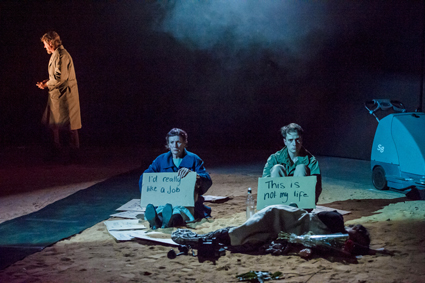
Land & Sea, Brink Productions
photo Chris Herzfeld
Land & Sea, Brink Productions
THE PUBLICITY PHOTOGRAPH FOR BRINK PRODUCTIONS’ LAND AND SEA IS EVOCATIVE. THE LANDSCAPE IS UNMISTAKEABLY SOUTH AUSTRALIAN, JUST SOUTH OF ADELAIDE, I GUESS. THE DRY LAND FORM IS LOW, THE FLAT SEA IS SHALLOW, AND THE SKY IS BRIGHT WHITE-BLUE. IN THE FOREGROUND, A FIGURE IN PYJAMAS SITS IN A BATHTUB, HEAD TURNED TO THE HORIZON, AND ROWS WITH TREE BRANCHES AS OARS AS IF OUT TO SEA.
The composition of this photograph encodes the settler lifestyle of Australia. Between land and sky the sea intervenes as the past-and-future medium of arrival and departure. In other Australian plays, I have learnt to read this turning of the face to the horizon, to where sea and sky meet in the beyond, as a white man’s aspiration, a neo-spiritual gesture that would transcend the hard politics of the land.
A publicity photograph is not performance. In the flow of production, it is created early on. It announces an aesthetic impetus, but does not govern the direction. Yet visual meanings are associative, part of a chain of meanings that seep into the experience of stage action and set design. In Nicki Bloom’s new play there is a beach. A man is washed ashore. His face is washed and, in a ritual, whipped with wet branches from a tree. Later there is an imaginary bathtub. But the script never settles on the image. It is also quite elusive in signifying time and place.
Wendy Todd’s design for Land and Sea is beautifully conceived. The Queen’s Theatre is Adelaide’s oldest; its old walls and iron roof enclose a deep expanse of space. Our chairs are arranged half-way around a circle of pale sand enclosed in billowing white drapes. At first, the curtains remain drawn. We watch the first scene play out through diaphanous panels. These are removed, creating wave-like scallops, defining the edge of a circus ring space. Later the curtains are fully raised, and then the action partly transitions into a realistic box set.
Director Chris Drummond explains that he and Bloom share an interest in the contemporary theatre of German director Christoph Marthaler (see RT76, p8). The elusive play of time and place in Bloom’s script suits the post-dramatic. But this production also shares its tent-theatre aesthetic and Brechtian musicality with the legacy of the ‘new wave’ Sydney-style. Actors entering and exiting mid-way through the audience recalls the distinctive architecture of the Stables and Belvoir. There are stylistic echoes of the colonial plays of the 1970s, John Bell’s Shakespeares at Nimrod, Louis Nowra’s The Golden Age, Michael Gow’s Away and Neil Armfield’s production of Cloudstreet. The costuming is loose, unbuttoned, in the pale earth colours of the colony. Elemental props—a basket of eggs, a ukulele, cardboard signs, a bottle—are handled with simple theatricality.
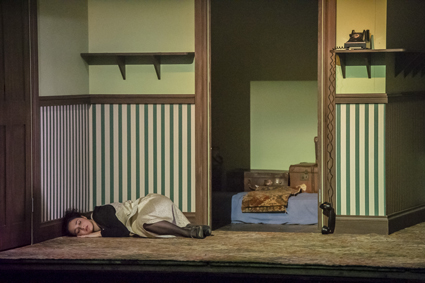
Land & Sea, Brink Productions
photo Chris Herzfeld
Land & Sea, Brink Productions
The performers play character strings in related stories, starting with a settler scene where food is scarce and lighting is by hurricane lamp. Mr Greene (Rory Walker) sends his daughter Vera (Danielle Catanzariti) to gather eggs, and colludes with neighbour Essie (Jacqy Phillips) to inhibit Vera’s excitement when Poor Tom (Thomas Conroy) is washed up on the beach. Next the settler story translates into a family melodrama of displaced aristocracy and misrecognised relations with King Billy (Walker), Queen Esther (Phillips), Prince Tomason (Conroy) and his lost love Vera the True (Catanzariti). Later, in the present, the young lovers are homeless, strangers to each other, on the beach and cold—with only alcohol, Hawaiian melodies and their imaginations to keep them warm.
Music is omnipresent: medieval ostinatos, Christmas lullabies, an aria from Gluck’s Orfeo, French nursery rhymes, echoes of Dietrich and Satie. These snatches are delivered by the performers—Jacqy Phillips sings throaty cabaret in French, German and Russian—with Hilary Kleinig on cello, piano and sound effects. But this is ‘post-melodramatic’ theatre: the music doesn’t amplify the characters’ emotions; it heightens the performers’ contributions to scenography.
Beyond the sand-circle and white curtains, the box set is hidden with black flats. The reveal is somewhat clumsy. But the scene set in this house—with its 1930s furnishings, its dark wooden doors and window frames, its wartime speeches on the radio and a ringing telephone that delivers death—is the play’s most imaginative transportation. I enjoyed the lurch of this phase shift into a different space. I wanted to move with the production into the house—and then onto the land. But, in the spirit of circular completion, the performers are lured back onto the sand to gaze—beyond us, through us—to the horizon of sea and sky.
Brink Productions, Land & Sea, writer Nicki Bloom, director Chris Drummond, performers Rory Walker, Danielle Cantanzariti, Jacqy Phillips, Thomas Conroy, designer Wendy Todd, music director Hilary Kleinig, lighting designer Geoff Cobham, producer Kay Jamieson; Queen’s Theatre, Adelaide, May 12-26
RealTime issue #109 June-July 2012 pg. 25
© Jonathan Bollen; for permission to reproduce apply to realtime@realtimearts.net
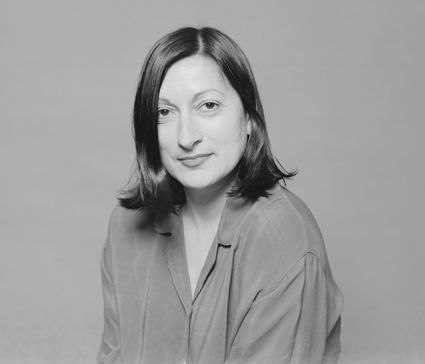
Rosie Lalevich
© photo Jacky Redgate
Rosie Lalevich
TRAGICALLY, IN DECEMBER 2011, WE LOST OUR DEAR FRIEND AND COLLEAGUE ROSIE LALEVICH. HUNDREDS GATHERED TO REMEMBER AND CELEBRATE ROSIE’S PASSIONATE LIFE IN TWO BEAUTIFUL, EMOTIONAL CEREMONIES—ONE AT ROOKWOOD CREMATORIUM AND ANOTHER AS ROSIE’S ASHES WERE SCATTERED IN THE BLUE SEA AT CLOVELLY, A PLACE SHE LOVED. HERE WE SHARE SOME OF THE ACHIEVEMENTS OF ROSIE’S LIFE WITH THE GREATER PERFORMANCE COMMUNITY, MANY OF WHOM WORKED WITH HER AS WE DID AND CAME TO KNOW AND LOVE HER TOO.
Rosie was born in 1955 in Sydney. At first, with her shock of black hair, it was thought she was a boy, but very soon after it was confirmed this was a girl. And what a girl! Rosie loved telling us this story. She grew up in Haberfield, working after school behind the counter in her Macedonian-Australian parents’ fish shop. But from age 14 Rosie dreamed of becoming an actor. She even fantasised about her stage name—Rosie Candice Lalevich—inspired by the beautiful, blonde Candice Bergen. Rosie would become the dark version!
In 1975 she relocated to Adelaide and joined the Saturday Company where she proved to be an adept ensemble player from the outset, beginning with an energetic performance in Helmut Bakaitis’ epic production Carlotta & Maximillian for the 1976 Adelaide Festival. In 1977 she was engaged by Roger Chapman to appear in Care ‘n’ Control with Magpie Theatre in Education.
In 1983 Rosie graduated in Drama from the Victorian College of the Arts. During her time there, she forged many lifelong relationships both personal and creative that laid the foundations and provided the direction for a creative life that would cross many diverse theatre forms and functions. She later teamed up with fellow Magpie Val Levkowicz to co-write, produce and perform the groundbreaking Ethnic Au Go Go (Spoleto Fringe Festival and Melbourne Festival, 1987) which prefigured the boys’ Wogs Out of Work. She was one of the co-founders of the Melbourne Women’s Season for the Spoleto Fringe Festival. Later she performed in and co-devised with Nöelle Janaczewska and Khristina Totos Crossing the Water (an adaptation of Marguerite Duras’ The Lover, Performance Space, 1988) and in Tess Lyssiotis’ Forty Lounge Café (1990), the first production in the new CUB Playbox Theatre in Melbourne.
Rosie always shared her political and spiritual leanings with her audiences and the industry, to the extent of lobbying the unions about more multicultural writing and performing opportunities. To this end she secured the rights and funding to produce Anthony Minghella’s A Little Like Drowning (Belvoir Street Theatre, Sydney 1992). This production launched Teatro di Migma, a company of NESB artists she co-founded. With Literature Board support, Teatro di Migma commissioned Louis Nowra’s Miss Bosnia, which premiered at La Boite in Brisbane (1995). Set in a Bosnian refugee camp, this was a work that spoke to Rosie’s political heart. She was always strongly motivated by the need to communicate the reality of women’s lives as well as those of oppressed minorities. Works such as Eve Ensler’s Necessary Targets (Darlinghurst Theatre, 2003) reinforced Rosie’s prowess as a theatre producer. Necessary Targets, in which she also performed, toured to the CUB Malthouse (2005) and was nominated for a Sidney Myer Award for best drama. In the same year she was nominated for the Ros Bower Memorial Award.
Squeezing in a postgraduate degree in theatre at UNSW, Rosie also produced two highly successful V-Day events, the first a benefit performance of Ensler’s The Vagina Monologues to raise money to stop violence against women and girls. In 2004 she produced Sydney V Day at the Footbridge Theatre, a benefit production with over 45 performers. Another of Rosie’s many talents was the ability to bring together a varied and wonderful assortment of people. She did this in both her professional and personal life. Her passionate ideas and love of life were infectious!
In 2002 she relished playing the role of Caliban in Lee Lewis’s production of the Tempest at New Theatre. Her final and wonderful performance was in Missing the Bus to David Jones with Theatre Kantanka (2009) a work she proudly helped to develop and that dealt with another vulnerable group, the aged. Rosie dedicated her performance to her late and beloved mother, Tasa Lalevich.
Rosie Lalevich’s political integrity and creative intelligence brought us some profound theatrical works. Her great love of life was always the source of her inspiration—and, through her, of ours. We miss you Rosie.
“… when you left, a strip of reality broke
upon the stage through the very opening
through which you vanished:
Green, true green
true sunshine, true forest…” Rilke
Dina Panozzo and Evdokia Katahanas
With thanks to Jeffrey Dawson.
RealTime issue #109 June-July 2012 pg. 26
© Dina Panozzo & Evdokia Katahanas; for permission to reproduce apply to realtime@realtimearts.net
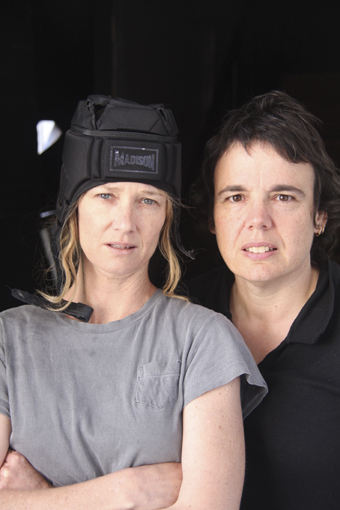
Peta Brady, Wilhelmina Stracke, Strands
photo Guido Stracke
Peta Brady, Wilhelmina Stracke, Strands
In RealTime 107, John Bailey wrote in “Ethical ventriloquism,” his review of Strands, “Given the abundance of outstanding actors with perceived disabilities in Australia today, is it problematic to cast an abled actor in the role and risk denying employment to someone whose opportunities on the stage are already unfairly limited? I think so, with qualifications.”
He concluded: “…disability isn’t merely gestured to here; whatever the reality behind the production, its fictional world produces sincere insights into the complexities of living with a disability, while working this into a narrative that is never itself defined by that disability. It’s not patronising, and the excellence of the production itself goes some way to alleviating concern. But, for me, it’s not an entirely comfortable work.”
to john bailey, may 7
John
In your review of Strands you write of the number of performers with perceived disabilities in Melbourne and why it is problematic not to cast one in that role in Peta Brady’s play.
To me that is a tenuous argument, for in the same vein you would have to cast a lesbian to play a lesbian, wouldn’t you? Or a wife beater to play a wife beater? Or an amputee to play an amputee? Or a cancer sufferer by a cancer sufferer? Where do you want to stop?
The point is that an actor was chosen for that role because the production didn’t seem to me primarily to be about the level of (dis)ability or what have you, but more about the sisters and their relationship in the wake of their mother’s death. The disability of one sister is entwined within that character—yet the greater drama concerns the relationship between the two sisters.
I understand what you are saying in that it should be a done thing that opportunities are afforded artists across the spectrum, but for a small show by an emerging or developing writer—at a venue like La Mama—the main concern is trying to get the thing on in the first place, struggling to work against severely limited resources as opposed to funded companies such as Back To Back who are actually engaged with the sort of work that has a basis in the experiences and abilities of those it chooses to work with.
If Peta was going to attempt to make work with a disabled performer, could that performer pull off the role in the way it was performed? Potentially, but this would involve an entirely different set of circumstances—and most likely a different outcome. This is a contentious issue, and I welcome further discussion on it. Angus Cerini
to angus cerini, may 21
Hi Angus,
Thanks for responding to my comments on Strands. They were intended as provocation rather than criticism, precisely because I think there’s a conversation that can be had now that’s worth having, and in the past might not have been possible at all. Once upon a time the idea that a female character could be played by a woman wasn’t very popular; a hundred years ago in Melbourne there was nothing politically incorrect about white Australians playing Indigenous Australians. Things changed, and people began to explore the ways that power is bound up in these kinds of representation. I’m really interested in the lines of power and access that we deal with today.
That’s why the idea of finding the best person to play the role is never simple, because there are so many barriers that different people face well before they’re allowed a chance to audition, or make their way onto a director’s radar, or even go to see a performance themselves. Strands allowed me to think about this, because it’s very much (and very effectively) about the experience of living with a disability, for both characters. The production made me contemplate the invisible barriers these sisters face everyday, and being someone with a fair investment in theatre I inevitably situated these considerations in the broader environment of disability and the arts in Melbourne today.
Of course, my raising all of this in the context of an independent production at La Mama is deeply problematic because a show such as this faces its own barriers—it’s not the Melbourne Theatre Company or Malthouse Theatre or the like. That’s why, again, I didn’t intend to be seen to be criticising Strands itself. It’s a ridiculously difficult endeavour to mount an independent production, and I don’t think artists who are themselves trying to deal with all of these obstacles should necessarily feel responsible for changing the landscape of Australian theatre at the same time.
I guess my point was that there’s a lot of change occurring—as you note, there are companies working with artists with disabilities that are producing (what I think is) astonishing work. And that’s political. It was always political, but now we’re talking about it, which is a good thing. I want to see where that conversation leads us, and pay attention to who’s listening in.
regards,
John Bailey
RealTime issue #109 June-July 2012 pg. 26
© Angus Cerini & John Bailey; for permission to reproduce apply to realtime@realtimearts.net
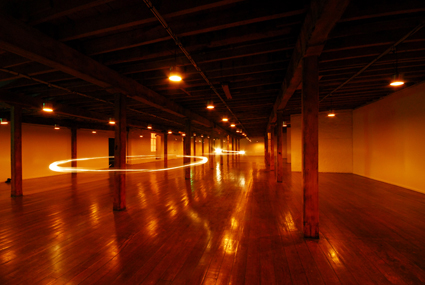
interactive bicycle-power lighting installation in the Long Gallery, Frog Peck and Bluebottle
photo Craig Opie
interactive bicycle-power lighting installation in the Long Gallery, Frog Peck and Bluebottle
THE BIG WEEKEND CELEBRATIONS OF THE 35TH YEAR OF OPERATION FOR SALAMANCA ARTS CENTRE OFFERED A POTENTIAL OVERLOAD OF EXPERIENCES. THE EVENT WAS TRULY A HYDRA; ONE COULD BE TREATED TO A WONDERFUL PARADE-PAGEANT THAT TRUNCATED 35 YEARS INTO A PERFORMANCE BY EVENT PRODUCER IAN PIDD, OR TO A VERY OBNOXIOUS BUT EXCITING ANTI-ART PROTEST BY THE WELCOME PARTY, WHICH ALSO DUG INTO THE HISTORY OF THE BUILDING THAT NOW HOUSES THE ARTS CENTRE, OR YOU COULD READ LETTERS FROM HOBART EX-PATS EXPLAINING WHY THEY NO LONGER LIVE IN THE PLACE.
The idea that somehow, somewhere, the piss was pretty actively being taken loomed large over the events in and around the centre on the final weekend of March. It was ostensibly an anniversary, and while it qualifies as a milestone, who celebrates a 35th? Still, it had been five years since the last celebratory shindig, Dream Masons, and it did seem about time for a different kind of party and this is what Hobart got: a series of events that seemed to wish to quibble with the notion of what an event in an art centre might be.
The Big Weekend also aimed to give the Arts Centre something of an overhaul, to turn it inside out and have a good look at its innards and secret bits. Being a heritage building and a warehouse has given the actual structure a design that seems chaotic at worst and can charitably be described as eccentric—there are stairs and corridors and tiny rooms and quite enormous spaces all hidden away around corners and in roofs. The well-known spots, like the Peacock Theatre, The Long Gallery and the Courtyard where musicians busk every Friday evening (elaborate busking indeed, but busking it is) are familiar to all and were used but avoided: the thrills and intrigue were to be found elsewhere.
Friday night launched proceedings with a big mob of bands playing up and down and around Kelly’s Steps. The bands on the steps squeezed into the corner as the usual slightly bemused Salamanca diners and drinkers wandered past. The bands further up, in a garden, rocked right on with people risking life and limb, bouncing off the sandstone. No harm was done to flesh or masonry although a few got minor neck injuries from watching bands two storeys above Kelly’s Garden for too long, but this didn’t deter the revelling.
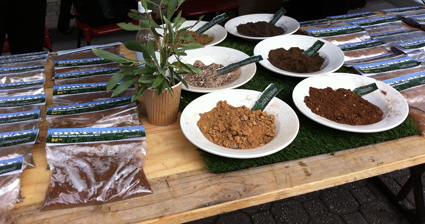
Dirt Cheap
photo Allana Blizzard Jones
Dirt Cheap
Salamanca Market, itself an institution that has developed along with the Arts Centre, has, to all and sundry, grown somewhat staid: there are still, and will always be, great stalls there, but there are a few too many generic stalls selling ‘World’s Best Dad’ T-shirts. The opportunity this afforded for satire was not missed by the Big Weekend crew: phantom stalls appeared, mostly created by artist Elizabeth Woods. These hybrid works were almost the pick of the entire event: one stall sold sample bags of Genuine Tasmanian Dirt, with proper labels, priced according to rarity. You could pick up a precious handful of red-brown grit from the legendary Queenstown gravel footy oval. Across the way was the tap water stall—again, professionally labelled and presented. Tap Water from more affluent Hobart suburbs cost extra, and given the looming introduction of water meters—something very new in Hobart—the comment could not have been better timed. Capping it was a carefully labelled “Useless Object” stall with exactly the sort of packaging one encounters in a great many craft shops the country over. The straight-faced presentation carried it off, and gossip suggests ‘regular’ stall holders were annoyed indeed. Good work Elizabeth Woods.
Saturday evening presented the focus event of the weekend, Space Invaders. There were performances all through the centre, far too many for any one person to take in, which had the effect of creating enigmas and excited gossip. Some queued with determination to ride Tristan Stoward’s bicycle around the Long Gallery space in the dark (the bike had a light, powered by effort—the harder you pedalled, the more it glowed). Others concentrated on seeing various burlesque acts. You could get lost in the rather wonderful John Bowling Memorial 70s Techno room. This was a great spot, filled with artefacts like really old, nostalgia inducing gaming machines, vinyl players made of that dreadful fake wood veneer stuff and a slide project, which produced a cascade of historical images from the Arts Centre’s archives. Almost unnoticed throughout the evening were tiny touches that noted what had been going on in this diverse space for the last 35 years. There was a lot to see and a lot to miss, but this was the real achievement of the event: it was truly a chance to choose your own adventure.
A subtle presentation, The Occupant by Briony Kidd and Jane Longhurst, was a standout. A small audience was led deep into a storage area and towards an encounter with—well, it’s hard to say, but the character in question (expertly created by Longhurst) appeared to be an elderly bag lady living amidst hoarded items deep within a closet. Sinister and yet harmless, this small performance was perfectly formed, quiet, intense and very memorable—creepy but not too seriously.
Also worth mentioning is the exuberant Luke George. Clad in vibrant orange, he emerged from beneath a vast pile of beanbags in the Salamanca Arts Centre Courtyard, dancing with vacuum cleaners and leading the audience in a sun worshipping all-in dance routine. This bold experimental dancer takes quite bizarre work to the masses with a bravery that could be confronting if it wasn’t so funny. There’s a lot to say about what Roberts does, but the key to his Big Weekend moment was his ability to hold a crowd in what was a chaotic mess made of history, rumour and a bit of satire. If the point was to invite people to look at the building itself and see its potential, the Big Weekend was a success; but if you just wanted a fun event filled with some really odd and thrilling moments, you could have that too. Never has the cliché “something for everyone” been quite so well realised, and subverted.something wild for everyone
Salamanca Arts Centre: SAC35—The Big Weekend, programmers Martyn Coutts, Ian Pidd, Sam Routledge; Hobart, March 30-April 1
RealTime issue #109 June-July 2012 pg. 27
© Andrew Harper; for permission to reproduce apply to realtime@realtimearts.net
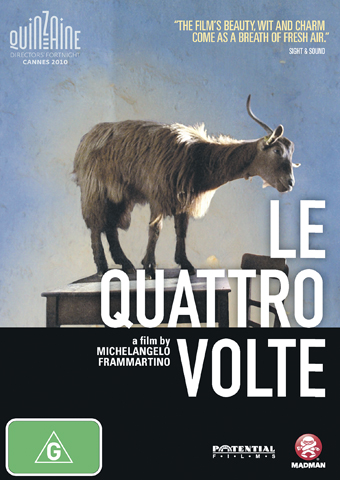
Le Quattro Volte, DVD
Greatly admired in the Adelaide and Sydney Film Festivals, Michelangelo Frammartino’s Le Quattro Volte (The Four Times; 2010) is “a sublime fiction that does away with language and conventional plotting, tracking the mysterious transmission of a soul from nature to man to domesticated animal to tree and—via ritual and artful rural manufacture—to fire, smoke and charcoal. All of this is achieved without any sense of religiosity (a seasonal church pageant is quite comical if juxtaposed with a moment of poignancy) and constantly surprises with its unpredictability and glorious cinematography. We’ll certainly now regard goats in a different light, observed here with the same acuity usually given human subjects.” RT102
3 copies courtesy of Madman Entertainment
ZONA: A Book about a Film about a Journey to a Room
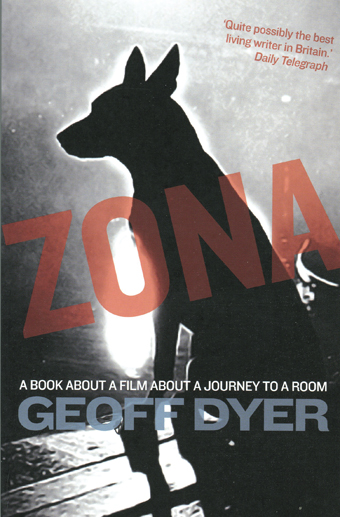 A remarkable book about the film experience, ZONA is UK writer Geoff Dyer’s acclaimed personal account of his relationship with Andrei Tarkovsky’s classic film Stalker. As Dyer recounts the events of the film and evokes its imagery, he spins a web of rich associations with other films, the nature of cinema-going, growing up, his girlfriends, stories about the making of Stalker, the role of boredom in film, Tarkovskian suspense and much else. It’s also very funny, hypercritical of other people’s favourite films (including Tarkovsky’s Nostalghia) and informed by vast cultural knowledge. As Tom Redwood writes in this edition, “What Dyer has offered by piggybacking on a masterpiece is an extension of Tarkovsky’s artistic project, a quite literal fulfilment of the creative contract Tarkovsky makes with his (devoted) viewers whereby the artist obliges the audience to…think on, further than has been stated…[putting] the audience on a par with the artist” (see review). ZONA is an entertaining provocation.
A remarkable book about the film experience, ZONA is UK writer Geoff Dyer’s acclaimed personal account of his relationship with Andrei Tarkovsky’s classic film Stalker. As Dyer recounts the events of the film and evokes its imagery, he spins a web of rich associations with other films, the nature of cinema-going, growing up, his girlfriends, stories about the making of Stalker, the role of boredom in film, Tarkovskian suspense and much else. It’s also very funny, hypercritical of other people’s favourite films (including Tarkovsky’s Nostalghia) and informed by vast cultural knowledge. As Tom Redwood writes in this edition, “What Dyer has offered by piggybacking on a masterpiece is an extension of Tarkovsky’s artistic project, a quite literal fulfilment of the creative contract Tarkovsky makes with his (devoted) viewers whereby the artist obliges the audience to…think on, further than has been stated…[putting] the audience on a par with the artist” (see review). ZONA is an entertaining provocation.
3 copies courtesy of Text Publishing
Email us at giveaways@realtimearts.net with your name, postal address and phone number. Include ‘Giveaway’ and the name of the item in the subject line.
Please only nominate one item.
RealTime issue #109 June-July 2012 pg. 48
© RealTime ; for permission to reproduce apply to realtime@realtimearts.net
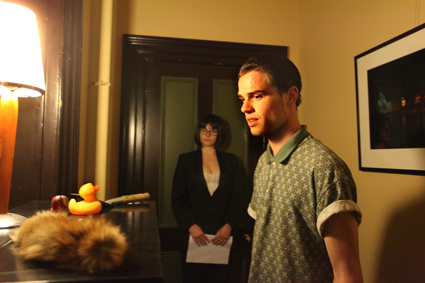
Melanie Jame Walsh, audience member, J Dark
photo Ponch Hawkes
Melanie Jame Walsh, audience member, J Dark
“WHAT IS A REVELATION?” J DARK ASKS ME. “A DOOR OPENS IN FRONT OF YOU AND YOU HAVE TO GO THROUGH IT, THERE IS NO OTHER WAY TO MOVE FORWARD.” “WHAT DOES IT FEEL LIKE?” “A WEIGHT BEING TAKEN OFF YOUR SHOULDERS.” “WHAT IS THE TEMPERATURE AT YOUR SHOULDERS?” “THEY ARE COOL.” “AND COLOUR?” “BLUE.”
I was anxious about attending this show. In high-stress, intimate situations, we tend to rely on our social masks. This is one-on-one, site-specific participatory performance aimed at de-activating these masks. With carefully worded, probing questions J Dark asks us to reveal the warmth under our facades. Like a matryoshka doll, layer after layer is yielded.
After scheduling an appointment with J Dark you receive a calling card and an SMS giving you directions to a venue. It begins to feel like something between a spy drop-off and a clinical appointment; a dark laneway leads to a waiting room with a yellow envelope with a form to fill out. J Dark arrives and you travel by lift to another floor.
Performer Melanie Jame Walsh is a confident and reassuring conductor; this is her second turn as J Dark, having performed at Sydney’s Underbelly Festival last year. There’s nobody better to lead you down the rabbit hole, because the night becomes surreal and unflinchingly personal. Wearing a dark pantsuit, J Dark’s voice is thoughtful and affected as she asks you questions like, “Do you have something to hold you up? Is it a system or a structure?” She steers conversation along this almost psychoanalytic line of questioning.
This is art as therapy and it’s intimate and risky, almost like a first date. We kneel at a mirror and she asks me to talk about my face while she takes off her ‘sexy librarian’ glasses and bobbed wig. Losing her earlier affected tone, she asks me whether she has changed. The clothing is symbolic of our own layers and personas. A table of hats offers a chance for me to find a costume for a newly discovered persona. Similarly, J Dark’s gradual disrobing down to a slip reflects the inner world we are heading into.
Walking through corridors, doors and up staircases we go both deeper into the strange Victorian fun-house depths of Arts House, as well as into the crucial question—what makes us unique? Everything is up for analysis; beliefs and desires are turned over and need to be backed up. I choose a matryoshka doll from an array of displayed objects on a hallway table. It seems an apt metaphor, as does my earlier admission that a revelation is like walking through a door. Just how much of this performance did I direct?
By the end of 50 minutes, unguarded, I lie down on a makeshift bed in an attic and sing an 18th century Russian lullaby to a stranger. J Dark returns the favour and croons more adeptly. Resisting her enigmatic charisma and kindness is almost impossible; we relish the chance to reveal ourselves.
An appointment with J Dark, performer, writer, creator Melanie Jame Walsh, director, writer, dramaturg Katerina Kokkinos-Kennedy, Triage live art collective in association with Savage Amusement, Arts House, Melbourne, April 18-May 6
RealTime issue #109 June-July 2012 pg. 28
© Varia Karipoff; for permission to reproduce apply to realtime@realtimearts.net
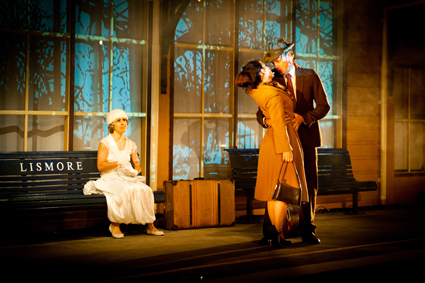
Katia Molino, Neridah Waters, Jo Turner, Railway Wonderland
photo Grant MacIntyre
Katia Molino, Neridah Waters, Jo Turner, Railway Wonderland
A WONDERLAND USUALLY DESCRIBES A PLACE, REAL OR IMAGINARY, WHERE CURIOUS, SOMETIMES BEAUTIFUL THINGS HAPPEN. LEWIS CARROLL’S ALICE STORIES ARE THE CLASSICS OF A GENRE CHARACTERISED BY STRANGE JOURNEYS SHIFTING FROM THE REAL TO THE IMAGINARY, JUMPING ACROSS TIME AND DISPLAYING NOT A LITTLE NONSENSE.
Lismore railway station, the site for NORPA’s new collaboratively devised production Railway Wonderland is a very real place. Abandoned in 2004, a fading icon from another time, the station now sits idle except for a bus that drops by to ferry commuters onto the Sydney-Brisbane line in another town.
Approaching the station, there is a buzz. The audience is ushered across a walkway to seating above the rails. Looking back to the platform is like viewing the scene from a passing train. Through large windows, the waiting room is lit for the arrival of three present-day characters, there to catch the bus. Johnny Nasser’s George, a laid-back, 30-something hippie, is suitably familiar; so too, is Neridah Waters’ loud yet frail teen runaway Kelsie. Then there is Leonard, whose compulsive behaviours become a clever comic expository device, performed with studied physicality by Phillip Blackman. Later, they will be joined by George (Jo Kennedy), the not-so-talented winner of a local karaoke competition on his way to compete in Australia’s Got Talent. The action opens with Kelsie on her mobile anxiously searching for her boyfriend who never arrives. When Kelsie hangs up, a whistle blows and the lights cross-fade to reveal the spectral Ana, an old Italian woman dressed completely in white, sitting outside on the platform away from the rest. It is at this point that the station morphs and our wonderland journey begins.
Over the next 80 minutes, we are treated to a curious montage of incident, convention and style. Actors double roles. Their doubles sometimes seem to echo the experience of their contemporary characters. The performance jumps frenetically from comedy to melodrama, from song and dance to choreographed movement. Characterisation is broad, the tone irreverent. Several sequences are enacted as silent film; in others, romantic scenes from Hollywood’s golden years or Vietnam War footage form projected backdrops for the action. There are many magical moments. Two of my favourites: a tiny film projected on a suitcase and the metamorphosis of a luggage trolley into a steam train using snare drum and guitar. Present and past overlap in swiftly moving vignettes, incident piles on incident with arrivals and departures as the characters’ stories are revealed. At times, the shifts are almost anarchic; like Alice, sometimes we might wonder just where we are.
It is Ana who pulls together these disparate elements. A proxy bride of 16, she emigrated to Lismore in the 1940s; an epic journey to a hard place. Now Ana waits for a train to take her back home. We know the train will not come. Is she mad? Or is she, as her antique costume suggests, a spirit? Ironically, it is through Ana’s eyes that the action makes sense. Played with humour and verve by Katia Molino, Ana is central to this wonderland. She is our white rabbit. We feel her disappointment with her new husband. We see her estrangement from her son who moved away after returning from Vietnam. She transports us across time with the aid of a similarly costumed choir whose song medleys frame different eras. Her journey evokes a panorama from the romantic age of steam through to the present with Vietnam (and Nimbin’s infamous Aquarius Festival) as the turning point. It is to Ana the other characters reveal their secrets: Kelsie stole money from her mother for the tickets, George is gay but hasn’t come out to his mum, and Garry hasn’t seen his daughter for five years. Leonard has no secrets. When Leonard reveals Ana has escaped a nearby nursing home, that she often comes to the station to wait for the train that will not come, we are brought back to the pathos of a prosaic present. Ana and the abandoned station become one, their fates intertwined in the inevitability of time.
Despite the at times slapstick humour, the alienation of the migrant experience is at the heart of Railway Wonderland. I was reminded of writer and co-devisor Janis Balodis’ play Too Young for Ghosts (1985). In this light all the characters are like migrants. Railway Wonderland began its gestation two years ago with the sourcing of community stories about Lismore railway station. Since then it has undergone extensive collaborative development. Director Julian Louis and everyone involved have fashioned a memorable piece of community theatre, a celebration of the site itself and the passing of a bygone era.
NORPA: Railway Wonderland, concept, direction Julian Louis, devisor, writer Janis Balodis, devisors, performers, Philip Blackman, Katia Molino, Johnny Nasser, Jo Turner, Neridah Waters, composer, musical director Michael Askill, musician Shenton Gregory, choreographer Emma Saunders, designer William Kutana, lighting designer Richard Morrod, video designer Salvador Castro, dramaturg Deborah Pollard, creative producer Marisa Snow, NORPA Generator Creative Development Program; the former Lismore Railway Station, NSW, March 27-31
RealTime issue #109 June-July 2012 pg. 29
© Peter Barclay; for permission to reproduce apply to realtime@realtimearts.net
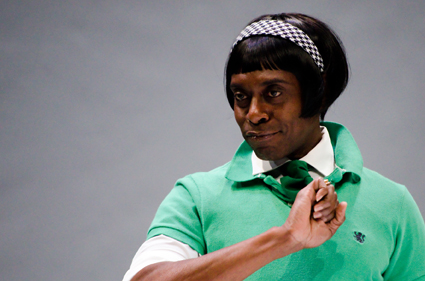
Charles Allen, A Hoax
photo Al Caeiro
Charles Allen, A Hoax
I’D BEEN TEACHING STEPHEN SEWELL’S PLAY MYTH, PROPAGANDA AND DISASTER…EARLIER IN THE DAY TO A BRIGHT BUNCH OF DRAMA STUDENTS AND THE LIVELY DISCUSSIONS WE’D HAD ABOUT TOPIC, THEME AND APPROACH WERE STILL WHIRRING AROUND MY BRAIN AS I SAT IN THE AUDIENCE FOR RICK VIEDE’S A HOAX THAT NIGHT.
The students loved the fearlessness and muscularity of Sewell’s writing; his hyperbolic depiction of post 9-11 American paranoia delighted them. They admired the way he hit on the nation’s raw nerve at a sensitive time, and set upon it with a dental drill and ultrasonic scaler. No anaesthetic involved. The American exchange student didn’t appreciate Sewell’s handiwork. She found it arbitrary and borderline negligent.
a hoax
There’s a recklessness to Rick Viede’s writing—one punter described it as unapologetic—that I suspect will elicit similar responses from audiences; there are raw nerves tapped upon here that individuals with unique subject positions in relation to the material will not find easy to stomach. They may need to be warned in advance.
A Hoax is a farce that lampoons some of the most egregious recent literary scandals of authorship identity. Ant Dooley (Glenn Hazeldine) has written a ‘memoir’ about surviving childhood sexual abuse. His survivor though, the ‘I’ in his memoir, is an Aboriginal girl named Currah. Ant conscripts Miri Smith (Shari Sebbens) to assume Currah’s identity. Miri is initially tempted by the money and then seduced by the attention. She disturbs a hornet’s nest when she meets would-be publishing and publicity team Ronnie Lowe (Sally McKenzie) and Tyrelle Parks (Charles Allen). She hasn’t actually read the memoir all the way to the end. When they press her for salacious details about what heinous events took place ‘in the cellar,’ Miri/Currah bluffs and feints. She’s clueless. She eludes—and alludes—as counter-defence. She shrugs in a ‘no-biggy’ kind of way and simply states: “I enjoyed it.” The publicists are appalled—and rapt. The farce ensues from there.
In a post-South Park, post-Family Guy (post-feminist, post-ideological) world, anarchy trumps taste every time. This is a play that would struggle to find an educated audience in the 1990s. It may still struggle in Melbourne. And yet, it’s not gratuitous. The writing has confidence and nuance; the characters are two-dimensional stock farce functionaries, but delightfully so. This is a study of greed, narcissism and disposable culture. An intriguing scene in the second half when a broken and disillusioned Tyrelle violently forces personal accountability from the others dog-legs the piece out of played-for-laughs comedy and probes a little deeper. There may not be redemption here, but there is at least some momentary self-scrutiny.
Lee Lewis’s direction controls the tone and dances adroitly around the ethical dilemma at the heart of the drama: Jason Glenwright’s sharp lighting and Renee Mulder’s pristine white hotel room set sterilise the dis-ease affecting these self-seeking characters; Steve Toulmin’s attractive AV projections of plusher and plusher hotel decors chart the characters’ descent into avarice. This is a tight and feisty production that may ultimately be more entertaining than incendiary and perhaps less scandalous than the scandals that inspired it. It’s terrific theatre.
making the green one red: virtual macbeth
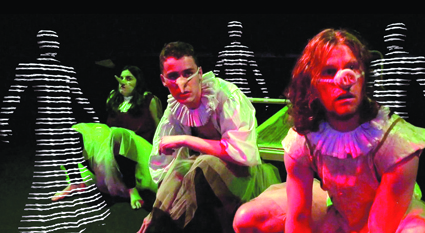
Making the Green One Red
photo Keith Novak
Making the Green One Red
Across the stark QUT Creative Precinct courtyard (where the ghosts of military drills and assembly are never far away) is The Block gallery space. The precinct wears the haunting of its barracks origins lightly. This is somewhat apt for a housing of Kerreen Ely-Harper and Andrew Burrell’s exhibition/installation of a Virtual Macbeth piece, Making the Green One Red. It is also fitting that the piece is located adjacent to two theatre spaces (La Boite’s Roundhouse and QUT’s experimental Loft space). It references—obviously—Shakepeare’s original text; indeed, it spins co-existently off Macbeth’s axis. The question I had in my mind as I entered and explored mixed reality’s digital media homage to the parent text was whether the piece stood on its own feet, or needed the viewer’s familiarity with the play in order to generate meaning. There isn’t a simple answer to this question.
Ely-Harper and Burrell explain the title and the decision to use the witches’ ethereal inner world—their psyche, you could say—to scaffold the piece. The title comes from the point in the text where Macbeth has just killed Duncan and the witches’ prophecy is manifesting as reality: “The vast green waters of the ocean are turned to blood in a process that should be one of cleansing and washing away” (program notes). Instead the green water turns red with blood. For Ely-Harper and Burrell, this is an image not only of transformation, but of transubstantiation. Matter changes form as a result of action and belief. Guilt infects Macbeth and he enters a kind of psychotic state that the witches have manipulated.
Entering Virtual Macbeth is akin to entering this psychic state/world. It is also a little like entering the Haunted House or the House of Mirrors at an amusement park. There is a jouissance of anticipation involved in taking this step into the darkness; anything might happen as the soundscape immerses you (echoed strains of…is it Natalie Cole’s “Unforgettable”?; disjointed phrases of witch-speak; an occasional frightening explosion) and the underworld tour begins. The viewer walks through a series of chambers, each housing a digital media display that evokes Macbeth’s fate. The first is a data projection of the witches’ cauldron on the floor. We see symbols (a crown, a chalice) that conjure Macbeth. The next is the Hall of Psychological Enlightenment—my favourite. A video-recorded projection of a psychologist provides Freudian and Jungian therapy for Macbeth and Lady Macbeth. In other rooms there are recitations of text emanating from a golden light on an empty plinth (The Room of Golden Opinions) or eerie evocations of nightmare as a storm builds and an owl hoots in a lurid red room (the Chamber of Blood). Several of the installations are sound or movement-activated. Some installations are more effective and comprehensible than others (the videoed sequences of actors’ performances didn’t do much for me in this context), but the cumulative effect is tantalising.
The Australia Council provided substantial support for this enigmatic project as part of its digital strategy; it is a well-considered and complex digital media exhibition, ultimately as ephemeral as a theatrical performance. It packs up and moves on to another venue in another city. Does it stand alone? Perhaps not. It would make for compelling foyer art, though; and I would love to enter a live performance of the parent text through an enigmatic portal like this.
A Hoax by Rick Viede. La Boite and Griffin Theatre Company co-production. Brisbane, May 5-26, Sydney July 20-Sept 1; Making the Green One Red, Virtual Macbeth, Kerreen Ely-Harper and Andrew Burrell, mixed reality, The Block Gallery, QUT, Brisbane, April 24 – May 5
RealTime issue #109 June-July 2012 pg. 30
© Stephen Carleton; for permission to reproduce apply to realtime@realtimearts.net
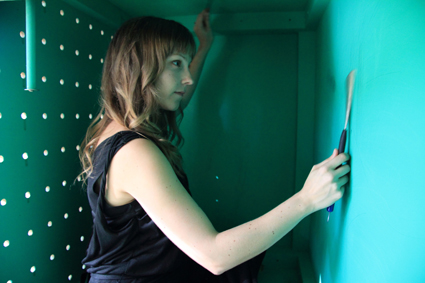
Leah Scholes, The Box
photo Daisy Noyes
Leah Scholes, The Box
THERE ARE MANY AVENUES VIA WHICH TO LOOK AT, LISTEN TO AND ENGAGE WITH THE BOX, THE LATEST PRODUCTION BY CHAMBERMADE OPERA AS PART OF THEIR LIVING ROOM SERIES. IT IS NOT SIMPLY A PIECE OF MUSIC THEATRE IN AN INTIMATE SETTING—THE SPACE IS A CENTRAL COMPONENT OF THE COMPOSITION. THIS WORK PULLS ATTENTION TO THE SOUND OF THE ROOM, EXPLORING RESONANT SURFACES AND ACOUSTIC QUIRKS.
This living room is situated in one of the leafier parts of Kew, in a house above the Yarra River, hovering among the treetops. Entering, we are led down a staircase to find our seats covered in white sheets, facing a curved glass wall of a window looking out into the trees, a suspended sheet to our left and a curious box-like structure on legs.
Throughout The Box there is a fine balance between the content of the work and the space in which it is situated. The trees in the window are more than a backdrop—they bring an aliveness to the work. There is a stark reality in the fact that we are sitting in someone’s home, yet as soprano Deborah Kayser moves about the area outside, cleaning various surfaces with a white cloth and singing small birdcalls, her gestures are obviously performative. There is a barely audible tam tam roll coming from somewhere inside the house and faint, pulsating scratching sound coming from inside the box.
As we become aware of these three sounds, we also become attuned to the resonant and reflective surfaces within the space. These somehow become clearer in contrast to Kayser’s voice, heard through the glass. We dwell within this simple soundscape for an extended duration, as the sounds blend and draw out the subtler aspects of the space. Once Kayser has entered the room she recites fragments of Willoh S Weiland’s highly visual text, which seems to speak directly to the surrounding space. The lengthy silences between these fragments of text hold our attention within the room.
We cannot help but wonder; what is the relationship between this woman and that box? She speaks, sings wordless sounds to it and the box responds. It is more than a structure within a building—it is a kind of creature. Acousmatic wooden scratching develops and morphs with a surprisingly versatile range of timbre. Inside the box, percussionists Matthias Schack-Arnott and Leah Scholes scratch and rub its interior surfaces with various objects. The repetitive back-and-forth motion of the scratching is reminiscent of electronic tape delay; however what is most salient about this sound is its tactility. The performers remain hidden from view throughout the performance, allowing the box to retain its mysterious character.
The relationship between the woman and the box is never revealed. It is impossible to know what she perceives it to be. This incomplete narrative thread is only one of several aspects of a composition woven through the space we engage with not only visually but sonically. Towards the end of the performance, Kayser moves to the balcony (hidden from view) above the audience to perform a duet with percussionist Eugene Ughetti on woodblocks. Instead of exploring musical gestures, this duet draws focus to the way that sounds are reflected from the river and the environment outside.
No single aspect of this performance dominates the space in which it is performed. All three percussionists remain hidden from view throughout. The sounds they produce all find ways to integrate with the space and the unfolding narrative. The Box is a work of extreme subtlety that blurs the line between living space and performance space. Having watched the sun set in the course of the performance, we are left in a room that is almost dark as the woman departs. Although, for me at least, the work seemed to have reached an obvious end, there was an extended period in which we lingered between the fantasy of performance and the reality of the surrounding living room.
Chambermade Opera, The Box, concept, music, space, object Fritz Hauser with Boa Baumann, libretto Willoh S Weiland, soprano Deborah Kayser, percussion Eugene Ughetti, Matthias Schack-Arnott, Leah Scholes; private residence, Kew, Melbourne, March 17-24
RealTime issue #109 June-July 2012 pg. 34
© Simon Charles; for permission to reproduce apply to realtime@realtimearts.net
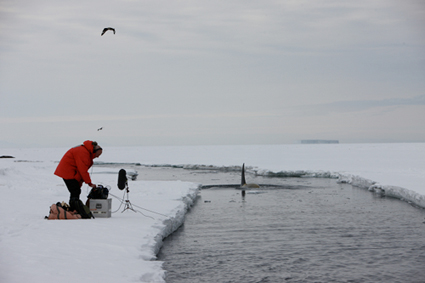
Chris Watson recording an orca in the Ross Sea
photo courtesy Chris Watson
Chris Watson recording an orca in the Ross Sea
FOR ITS 13TH MANIFESTATION THE ANNUAL SOUND AND MUSIC FESTIVAL LIQUID ARCHITECTURE REVEALS A SLIGHTLY DIFFERENT APPROACH TO PROGRAMMING. ARTISTIC DIRECTOR NAT BATES HAS TAKEN A BACK SEAT WHILE GUEST CURATORS PHILIP SAMARTZIS AND LAWRENCE ENGLISH HAVE CRAFTED A PROGRAM OF CONCERTS, EXHIBITIONS AND TALKS FOCUSSING ON THE ANTARCTIC.
Over the last decade a range of opportunities has opened for artists to visit the great polar regions, north and south, exploring these unique, treacherous and increasingly endangered environments. (See Matthew Lorenzon’s coverage of Alice Gile’s project for harp, voice and electronics, Alice in the Antarctic, RT104; and Urszula Dawkins on her experiences as part of The Arctic Circle international arts/science collaborative residency Svalbard, Norway, RT100). In the spirit of these initiatives Liquid Architecture’s Antarctic Convergence brings together a selection of sound, video and installation works drawing inspiration from the region.
Both Melbourne and Brisbane legs of the festival will include an exhibition component with core artists including international guests Chris Watson (UK), Werner Dafeldecker (Austria) and Andrea Juan (Argentina) along with locals—audiovisual artist Scott Morrison, installation artist David Burrows and the curators. In Melbourne, New Zealand musician Phil Dadson will also perform in the gallery.
Melbourne, Brisbane and Perth are treated to two multi-speaker concerts. In concert One, Robin Fox will present his most recent work, Zero Crossing, developed during a residency at Salamanca Arts Centre, Hobart utilising the data from wave-rider buoys in the Southern Ocean to create an immersive audio-visual experience. US Sound designer and naturalist Douglas Quinn makes up the other half of the bill with accompanying video by French artist Anne Colomes. Concert Two offers Philip Samartzis and the Monolith Project which brings together Lawrence English and Werner Dafeldecker with visuals by Scott Morrison.
The Monolith project will also feature as part of the National Film and Sound Archives’ The Longest Night (June 22) which celebrates the centenary of Douglas Mawson’s Antarctic expedition. On the same night, Arc Cinema will feature The Thing From Another World (1951) and other films from the archive based around the polar topic. Extreme Film and Sound: Stories from Antarctica will be on display in NFSA Foyer gallery until August. RT
Liquid Architecture 13, Antarctic Convergence, Perth (June 25), Bendigo (June 27), Melbourne (June 28-July 14), Sydney (July 3), Brisbane (July 4-22); http://www.liquidarchitecture.org.au/; National Film and Sound Archive, The Longest Night, Arc Cinema Canberra, June 22; Extreme Film and Sound: Stories from Antarctica, NFSA Foyer Gallery, Canberra; until August; http://www.nfsa.gov.au/calendar/event/3522-longest-night-nfsa/
RealTime issue #109 June-July 2012 pg. 34
© RealTime ; for permission to reproduce apply to realtime@realtimearts.net
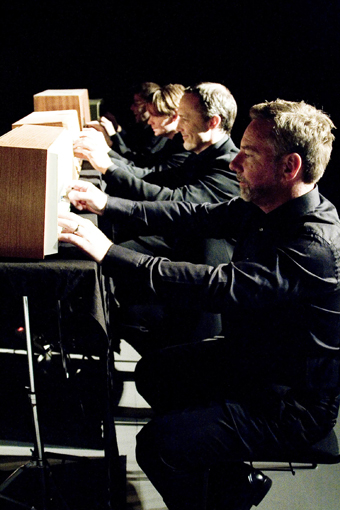
Kroumata Percussion, Radio Music
photo Katarina Widell
Kroumata Percussion, Radio Music
JOHN CAGE, MUSHROOM LOVER AND CULTURE HERO EXTRAORDINAIRE. BY ALL ACCOUNTS A REALLY NICE GUY. AND, TO CELEBRATE THE CENTENARY OF HIS BIRTH, CLOCKED OUT ASSEMBLED THREE NIGHTS OF CONCERTS IN BRISBANE.
Before each concert is an hour or so of Cage’s Musicircus, with artists spread throughout the space to perform more or less disconnected art-like actions. No reflection on the performers, but for me these “Happenings” are a bit long in the tooth. The moment for some of Cage’s work has gone—particularly for the pieces that focus on the presentation of uncorrelated (random) events. Cage became heavily influenced by Zen Buddhism, and “with our thoughts we make the world” fitted well with someone born into the glory days of US hegemony and a culture of hyper-confident individualism. For Cage the world was “teeming,” buzzingly random, and an individual could impose upon that world whatever structure they wanted. Cage’s work was then directed to producing an environment of randomised events that could be given structure (meaning) through individual contemplative attention.
Biology, though, shows us that our sensory, emotional and cognitive systems are coupled to a highly structured world with meaning derived from the adaptive value of that coupling. It seems that, even after his famous ‘silent’ 4’33” encouraged people to hear the world without addition, Cage continued to compose works for the concert hall that he felt—mistakenly as it turned out—reflected the sounds and dynamics of the world. The challenge of listening deeply to the actual world as a compositional strategy would later be taken up en masse with the advent of cheap recording equipment and the expansion of the, now quite large, field recording movement.
Decibel’s thoughtful performance of the eight Variations, written between 1958 and 1968, demonstrates the limitations of the randomisation strategies Cage used. The Variations focus on chance in compositional process, performer choice and audible output, and illustrate Cage’s philosophical commitments to removing personal taste from his work—to let sounds ‘speak for themselves.’ Using a range of graphical constructs, the scores have instructions like “For any number of players and any sound producing means.” The results are generally not that interesting to listen to. The exception for me is Variation 4—where a chart laid over a map of the venue sends performers off to various parts of the stage and beyond. Very sparse in execution, this piece articulates space through its acoustical properties. We hear the auditorium in new ways; we become more in-the-world than in a model of the world (and hence apart). Harking back to biology, using sound to indicate spatial structure and the properties of the objects that compose it is highly adaptive—the emotional valence of the spatialised sound flows naturally from the coupling of our sensory apparatus and properties of the world that are useful to us as animals within that world.
More engaging is the superb second night performance by Swedish percussionists, Kroumata. They begin with Cage’s Radio Music from the mid 50s: played quiet, spread either side of the stage for some nice call and response. Using the current radio channels—rather than trying to recreate a 50s radio program as Cage would have heard—this piece nicely illustrates Cage’s interest in composing as the provision of specific containers for constrained events. Timing, duration and content domain (radio sounds) are determined, but the specific instant of the radio sound is undetermined. Degrees of chance.
The next piece, Music for Carillon, was also scored within a ‘container’ paradigm—with rectangles as containers of points (notes)—the horizontal axis for time, vertical for pitch. It does not really matter that Cage used an elaborate system of folding and cutting paper to find a process of randomisation to generate the score—the score is quite explicit and determined as far as performance goes. And the performance (on glockenspiels) is delicate and lovely—spread across the space like rain on a canopy of bells.
Again we have delicate and lovely for the next work, Amores 2, perhaps the highlight of the festival. Softest hands on the drum skins, subtle shakes of seed pods, great ensemble work with short riffs and rhythmic fragments passing between the players to give each phrase tremendous subtlety (parts remind me of Webern’s short, shared fragments). Cage was an absolute master at the orchestration of sound—in his development of new instruments such as the prepared piano, in his stacking of different sounds and in his understanding of movement between sounds.
Another illustration of the mix between determinism and chance, Williams Mix, has a huge score that provides a precise one-to-one mapping from score to lengths of audio tape. But the contents of the tape segments are suggested rather than locked in. On the first night we hear both the original recording and a new version by Werner Dafeldecker and Valerio Tricoli. The original is not that long, a looney-tunes cartoon frenzy. The new version is much longer—much closer to the intentions of score, Tricoli claims. Sounds are less recognisable—more abstract—although still with the feel of early tape music. Far too loud (thank you free earplugs). But if you use earplugs you don’t hear the piece as intended. And if you go without earplugs then your hearing is damaged and you don’t get to hear anyone else’s music with the same acuity. Ever again. Physically damaging volumes are a longstanding bugbear of mine.
Of the remaining pieces, Lawrence English and Scott Morrison’s reworking of Cage’s final film, One11, is better than the original. Streaming white noise, rough white surfaces, hinted figures, venetian blinds blurred into gritty lozenges of light, the improvised soundtrack starts like a David Lynch/Alan Splet combo for wheezing water heater and ostinato piano. Sounds to let you know there’s something you don’t want to know.
Though my view is that Cage’s later works often fail as music to be listened to, his ideas have been enormously influential. And the earlier works are truly beautiful. Clocked Out—in a tour de force of funding aggregation that deserves applause in itself—have presented an excellent and important festival that, quite amazingly, covered the full scope of one of music’s greatest innovators.
The Cage in Us, presented by Clocked Out, performers Valerio Tricoli (Italy) and Werner Dafeldecker (Germany), Kroumata Percussion, Decibel, Rebecca Cunningham, Lawrence English, Joel Stern, Erik Griswold, Vanessa Tomlinson, Ba Da Boom, the QCGU New Music Ensemble. The Judith Wright Centre of Contemporary Arts, Brisbane, April 12-14
RealTime issue #109 June-July 2012 pg. 35
© Greg Hooper; for permission to reproduce apply to realtime@realtimearts.net
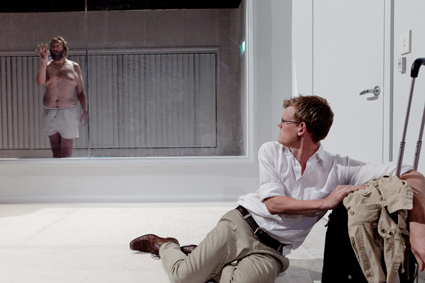
Anthony Hunt, Pascal Herington, In the Penal Colony
photo Louis Dillon Savage
Anthony Hunt, Pascal Herington, In the Penal Colony
A WIDE ARC OF BLOOD SPATTERS ACROSS A WINDOW; IT IS BLUE—THE BLOOD LITERALLY AND METAPHORICALLY OF THE OFFICER WHO, IN DESPAIR AT HIS LOSS OF POWER IN A PENAL COLONY, HAS SUBJECTED HIMSELF TO AN EXECUTION DEVICE THAT, OVER 12 HOURS, IN A TORTUROUS TATTOOING, NEEDLING DEEPER AND DEEPER INTO HIS SKIN, SPELLS OUT THE COMMANDMENT A CRIMINAL HAS BROKEN.
Believing that at the moment of death the criminal achieves transcendent self-awareness, The Officer desires it for himself, but, its maintenance underfunded by a new commandant, the machine brutally malfunctions.
For The Officer, the power of one body, authority, over another is justice enough—the criminal need not know his offence (until the moment of death) or have the right to defence. As ever, Kafka (even if this is denied by those who regard him simply as a metaphysician) is prescient—fascism was to be supremely exercised by physical force—and historically alert. Although the Enlightenment tide began to turn against torture and violent execution in the 18th century, these contested punishments persisted, not least in European colonies in the 19th and 20th centuries, and into our own. In Kafka’s story, the setting is a penal colony in the tropics, the sweat and grit as palpable as the ugly specifics of the machine and cruelties more explicit than in Philip Glass’ opera.
However, in editing the story and paring back detail, composer Glass and librettist Rudolph Wurlitzer have provided the opportunity for directors to circumvent the demands of too many specifics, including historical placement, without necessarily reducing the potential for horror. The machine need not appear, the execution need not be seen—the anxiety and shock can be expressed principally in words and the haunting pulse of Glass’ score. Glass’ affinity is, after all, with Baroque opera rather than the denser theatricality of its 19th century successor.
Director Imara Savage and designer Michael Hankin make the most of this opportunity, filling the width of the stage with a long, shallow, starkly white room with vertical blinds at the back. These are later half-opened to reveal what appears to be an identical room behind glass, housing the implement of execution, which remains hidden and therefore all the more anxiety-inducing. The sheer lack of identity of the rooms is nightmarishly, if predictably Kafka-esque. A lone water cooler stands to one side, its contents ominously turning blue shortly before the execution device fails. A screen descends on which The Officer shows The Visitor (the Explorer in Kafka’s tale) the machine; the images are not of a concocted device, but made up of old black and white film footage of 20th century industrial machinery—spinning cogs and lathes counterpointing Glass’ insistent pulse—and worrying scientific implements of unknown purpose. Like the Officer’s uniform, appearing to be from the 1940s or 50s, they suggest a not too distant past that still lingers, while The Visitor is in modern dress.
The Visitor at first seems to be the character with whom we’ll identify. Like us, he’s a stranger to the penal colony. He’s keen to maintain an emotional remove, to simply be an observer. But The Officer treats him as confidant, fascinating and finally repelling The Visitor with his account of the machine and its torments and his attempts to inveigle his guest into suppressing any opposition to the device. That The Visitor takes so long to express his concern distances us from him, despite our understanding of his unenviable position; at the very same time we fully grasp the mania that inhabits The Officer and feel as helpless as The Visitor. The reversal, when it comes, the Officer substituting himself for the Condemned Man, is a shocking climax to a chilling tale.
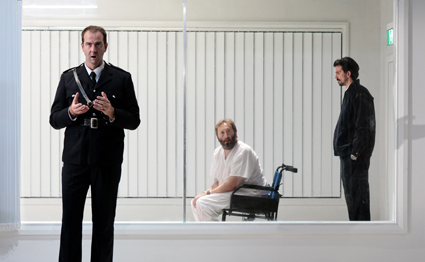
Paul Goodwin-Groen, Anthony Hunt, Patrick George, In the Penal Colony
photo Louis Dillon Savage
Paul Goodwin-Groen, Anthony Hunt, Patrick George, In the Penal Colony
Director Savage’s direction is as effectively straightforward as the lucid libretto which is delivered with clarity and power by tenor Pascal Hetherington (The Visitor) and baritone Paul Goodwin-Groen (The Officer). Hetherington conveys detachment, curiosity, then horror and panic without embellishing The Visitor with any too distinctive character traits, underlining the man’s attempts to keep his distance, while Goodwin-Groen seizes the opportunity to reveal a slide from apparent rationality into neurosis and then self-destructive psychosis—a frightening portrait of the impact of quasi-religious, self-centred ideology, utterly devoid of empathy.
The singers met the challenging score boldly, as did the offstage conductor and string quintet, sustaining the music’s complex oscillations between driving motifs and reflective decelerations. There are moments in Glass’ score that offer director and performers little in the way of dramatic impulse (for example, when The Officer is installing himself, out of our view, in the execution device). Elsewhere this was, however, an issue of direction: the performers had little to do in some passages, appearing occasionally awkward or aimlessly repetitive in their movement. Likewise the opportunity to exploit the design space was not always taken. As numerous directors have shown in recent decades, Baroque opera, and oratorios even, offer great opportunities for dramatic realisation without it becoming superfluous. The same should apply to In the Penal Colony. Nonetheless the production maintained its sense of suspense, horror and ethical unease.
I was impressed by the Sydney Chamber Opera’s production of In the Penal Colony, for its intimacy of scale (so rare for opera in this city), excellent design, thematic conviction, fine performances and offering the hitherto unlikely opportunity to see this work. This is a company to watch.
Sydney Chamber Opera’s next production is a double bill, Stravinsky’s The Soldier’s Tale and UK composer George Benjamin and librettist Martin Crimp’s Into the Little Hill, with conductor David Stanhope, director Sarah Giles and performers Halcyon at Carriageworks, Sydney, July 24-28. Crimp wrote the plays The Country and The City and created the English version of Botho Strauss’ Gross und Klein (Big and Little Scenes) for Sydney Theatre Company. If you’re interested in hearing In the Penal Colony, after touring the UK with their production in 2010, Music Theatre Wales has released a CD of In the Penal Colony on the Orange Mountain Music label.
Sydney Chamber Opera, In the Penal Colony, composer Philip Glass, libretto Randolph Wurlitzer, performers Pascal Hetherington, Paul Goodwin-Groen, Anthony Hunt, Patrick George, conductor Huw Belling, director Imara Savage, set, costume design Michael Hankin, lighting, AV Verity Hampson, string quintet Doretta Balkizas, Madelaine Slaughter, James Munro, Mee Na Lojewski, Rhiannon Oakhill; Parade Theatre, NIDA, April 7-14; http://sydneychamberopera.com
RealTime issue #109 June-July 2012 pg. 36
© Keith Gallasch; for permission to reproduce apply to realtime@realtimearts.net
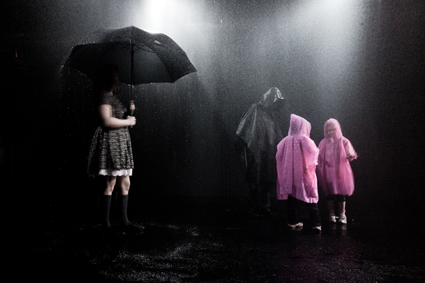
Michaela Gleave, Our Frozen Moment, 2012, installation view, Performance Space
photo Jennifer Leahy, Silversalt Photography, image courtesy the artist and Anna Pappas Gallery, Melbourne
Michaela Gleave, Our Frozen Moment, 2012, installation view, Performance Space
STANDING OUTSIDE MICHAELA GLEAVE’S WEATHER-INSPIRED INSTALLATION, OUR FROZEN MOMENT, I’M HOLDING THE POSTCARD ADVERTISING PERFORMANCE SPACE’S DIMENSION CROSSING SEASON IN MY HAND. PRINTED ONTO THE CARD IS A PHOTOGRAPH SHOWING TWO ORDINARY GARDEN SHRUBS AND A TIMBER LATTICE FENCE BATHED IN A LUMINOUS, ALMOST SPECTRAL, WHITE GLOW.
The image captures a natural phenomenon that mostly goes unnoticed, a fogbow, caused by light hitting tiny water droplets of fog producing either muted colours or an ethereal white halo; it’s also attracted the slight misnomer, ‘white rainbow.’
The photograph by Gleave is a telling image that reveals a heightened attunement to the subtle intricacies of natural phenomena and the ways in which we perceive them. It’s this sensitivity to the intertwining of nature and culture that largely informs Gleave’s practice and was strikingly apparent in her dramatic, large-scale contribution to the Dimensions Crossing program. Coupled with Robyn Backen’s site-specific work, Whisper Pitch, these two experiential architectural structures activated the Carriageworks site, luring visitors into engaging spaces where one felt more like a receptor than a mere spectator.
In keeping with her desire to transport the viewer, Gleave located the installation’s entry at the rear of the Bay where a dressing room housing the protective wet weather gear awaited. Having navigated my way into a black plastic poncho and slipped on a pair of heavy-duty gumboots, I plodded toward the blackened environment of the main exhibition space. Like swimmers contemplating a dip in the ocean, some visitors stood hesitantly at the threshold while others ventured boldly inside where a continuously strobing white light spliced through the darkness. At the centre of the room, cloaked spectators ascended the stairs onto a stage-like platform fenced by a wire balustrade where water drizzled from the ceiling. As we stood on this platform beneath the artificial rain, the visual spectacle at the heart of the work unfolded as the white light of the strobe refracted off the tiny particles of water, poetically transforming the droplets into what resembled an all-enveloping confetti of star dust. It was an otherworldly optical phenomenon that re-imagined such barely perceptible natural effects as the fogbow into a full-blown cinematic style atmospheric event.
While her installations recall the sensorial art-science experiments of Icelandic artist Olafur Eliasson, where Gleave differs is in her more playful engagement with our infatuation with epiphanic moments, lending itself to work of a more performative character. The theatricality of Our Frozen Moment evolved from an earlier project which involved creating a storm sequence for a play and Gleave was interested in recreating the stage within a black box environment for this installation. What was unexpected about the spectacle was its somewhat unnerving and abrasive edge—the effect of the strobe lighting soon shifted from dazzling to disorienting and the water irrigation closer to a drenching than a fine mist. It’s hard to know whether this was intentional as the installation was to some extent technically unresolved with the management of such large quantities of water proving particularly difficult. A gentler immersive environment might have given viewers more contemplative time amidst its wonder-provoking effects. Yet for those able to withstand a certain level of physical discomfort Gleave did offer an unusually intense collective experience that emphasised the destabilising influence of environments upon mental states and the fine line between the joys of illumination and the terrors of hallucination.
Coinciding with the installation period of the Dimension Crossing program, Carriageworks hosted an unrelated fashion event over the last weekend of April that ramped up the ambient noise of the space to a maximum—testing conditions for Robyn Backen’s Whisper Pitch installation at the southern end of the foyer. Here, this architectural anomaly of a pair of twin parabolic brick structures was seamlessly inserted as a space within a space, beckoning the odd stray photographer or curious fashionista into its encasing, womb-like interior. From the outside, the brick walls with their roughly applied sand coloured mortar recalled a fragment of a ruin or the imperfections of vernacular architecture. By contrast, the smooth grey render of the interior mirrored the existing Carriageworks brickwork and created a sense of resonance with the surrounding architecture.
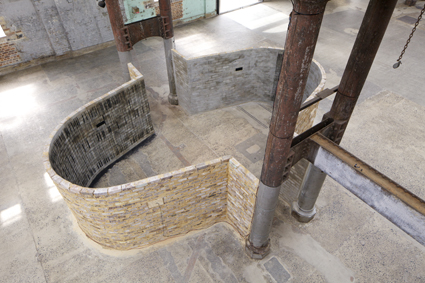
Robyn Backen, Whisper Pitch, installation view, Performance Space
photo Ian Hobbs, courtesy the artist
Robyn Backen, Whisper Pitch, installation view, Performance Space
The physical form of Whisper Pitch took its cues from the parabolas of the acoustic architecture of such sites as the Whispering Gallery of Gol Gumbaz in Central India where sounds can be echoed seven times, and in ideal conditions Backen’s installation would have sought to reproduce these echoing effects. Amid the ambient noise of the Carriageworks site, however, Backen sensibly elected to work with the more controllable medium of recording technology, which opened up its own unique possibilities. Looking directly through the rear entry and down a narrow passageway, a projection of unobtrusively placed black-and-white film was visible—a ‘ghost image’ from Fellini’s La Dolce Vita (1960) showing the scene where Marcello receives a marriage proposal from his lover spoken via an echo chamber. Within the spare and minimal confines of the brick parabolas, the intimate estrangement of the characters made an uncanny return as the script of their disembodied conversation (“Marcello, can you hear me?”) was spoken in the hushed whispers of female voices in seven different languages, the recording bouncing back and forth between four black rectangular speakers embedded in the installation walls.
By situating the speakers within the walls, Backen drew visitors into an intimate relationship with the architecture as they leaned closer and paced their perimeter to discern and trap the source of the whisperings. Whether or not the visitor was aware of the origins of the audio array as translations of the Fellini script (the projection was unfortunately situated some distance from the installation due to constraints in blackening the space), this slippery and ever shifting cacophony of voices, sometimes singular and coherent and at other times overlapping and polyvocal, evocatively conveyed a sense of the broken and incomplete nature of communication and the inherent difficulties of meaning.
Complemented by scribbly black lines of Morse code inscribed onto the walls in charcoal, the sound installation pointed out both the limitations of one-sided communication as well as its generative possibilities as the mind works to fill in the blank spaces with its own imaginings, revealing communication to be a seductively expansive and relational exercise. Backen’s installation also gracefully commanded the void of the Carriageworks foyer with a human-scaled intervention that thoughtfully engaged the senses at multiple levels. Gleave’s installation was more raw, yet despite its engineering imperfections at a visceral level, it too succeeded in forging ephemeral phenomena into a memorable art experience where the viewer’s own embodied shift in perception took centre-stage.
Performance Space, Dimension Crossing: Michaela Gleave, Our Frozen Moment, Robyn Backen, Whisper Pitch, Performance Space at Carriageworks, Sydney, April 20-May 19
RealTime issue #109 June-July 2012 pg. 37
© Ella Mudie; for permission to reproduce apply to realtime@realtimearts.net
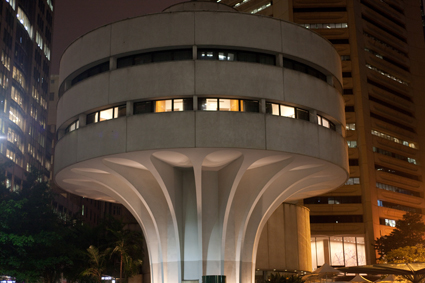
Commercial Travellers’ Association, Martin Place, Architect: Seidler & Associates
photos Paul Green / Kaldor Public Art Projects
Commercial Travellers’ Association, Martin Place, Architect: Seidler & Associates
observation
When Sydney people walk into an unfamiliar room the first thing they do is head for the window. Everything—including the art on the walls—is sized up only after a quick assessment of the quality of the view. Sydney is a view city—even beyond white yachts bobbing on a sparkling harbour.
The Rear Window effect of looking into the rooms of others, the lovely mute blankness of windowless brick, a neighbour’s frangipani or the shiny seduction of a retail strip all make good views, as they would in other cities, but in Sydney it’s more important. The view reigns. Sydney seems to look outwards; looking inwards is inappropriate behaviour. Disturbing. As is randomly opening the door to a hotel room you haven’t booked.
The Commercial Travellers’ Association houses a little-known, little hotel—a mid-70s Harry Seidler designed concrete mushroom in the centre of Sydney’s financial district. On one of the above ground floors, 16 little bedrooms look out radially onto the high-end retail and grand bank facades of Castlereagh Street and Martin Place. This was the setting for German artist Thomas Demand’s The Dailies, where a polite attendant in black invited me to start anywhere—so I opened the door to room 413 and went to the window.
through the window
Prada, in an Art Deco building, Martin Place.
on the wall
A photograph of a window in a brown wall. The window has a cheap-looking venetian blind covering it. The lower third of the slats is dishevelled—a word normally used for hair or clothing that also works for mussed up venetians. The ceiling is standard office-commercial. Cheap. Utilitarian. All of the above is meticulously constructed from paper, photographed, then beautifully and expensively printed using an almost obsolete process called dye transfer, by Thomas Demand. The result is a slickly real image that doesn’t quite add up.
on the dresser
A tiny electric jug (everything is tiny in these rooms), a little telephone, a small bottle of wine, one glass, a laminated sheet of house information that ends predictably with…
“THIS IS A NON SMOKING ROOM
THANK YOU”
and laminated in the same hotel-room manner, a story fragment by American novelist Louis Begley…
“THE WHITE CORRIDOR WHEN
THEY ARRIVED AT
GREGOR’S FLOOR
MAKES HIM THINK OF A HOSPITAL.
HE TELLS THAT TO LENI.
She explodes in laughter and explains
how on every floor the corridor circles the building.
On some floors there are only double rooms.
This is the floor of singles.”
in the air
A fragrance designed or specified (not sure) by Miuccia Prada.
the dailies
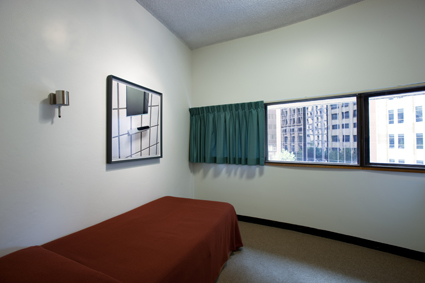
Kaldor Public Art Project 25: Thomas Demand’s The Dailies, installation view of Daily #3, 2008
photos Paul Green / Kaldor Public Art Projects
Kaldor Public Art Project 25: Thomas Demand’s The Dailies, installation view of Daily #3, 2008
One circular floor, level four. Sixteen rooms. Fifteen, each with a photograph, a fragrance, a view and a fragment of story about Gregor the commercial traveller and Leni the receptionist. One room is locked, a red swing tag on the handle reading, “Please do not disturb.”
begin
Turn the handle and push against one of the tightly sprung doors; so tightly sprung that it feels locked, until the attendant in black tells you to push a bit harder. A touch of guilt about randomly barging into a hotel room that isn’t yours, then a hint of relief in discovering that no-one is there. The lunchtime city outside is soundless through the double glazing. The only sound in the room is the humming of the air conditioner through the grate in the bulkhead, sounding for a moment like a shower running in the room next door. Look at the photograph on the wall above the bed. Read the text on the dresser. Look out the window. Step back (not far in this tiny room) and frame all three—the picture, the dresser with the text, the window—in your field of vision. Turn back to the door. Turn the handle, open, realise it’s the door for the bathroom, and a slight sense of disorientation sets in.
Few of us miss this point, that regardless of where you are in the world, these mean little hotel rooms, apart from all looking the same, have one other thing in common: they’re non-places. Places between other places. In The Dailies, Demand’s photographs pick up on this and push the fourth floor into another level of disengagement.
loaded emptiness
Demand has described the subjects of his photographs as simply places you pass by, things that are formally interesting (no more than that), revisited memories fixed in photography or the nuclei of narratives. The refreshingly non-interpretive John Kaldor calls them little observations in the city (see website), and this is essentially what they are. But it’s the effect of moving through the gaps, being in-between these little stories, that draws you in to another, less worldly place. A description I once heard used for the loaded emptinesses of Berlin comes to mind and seems to fit the feeling perfectly: ghostly present absences; and picking up on the theme I did find myself doing this door-to-door visitation a bit like a commercial travelling wraith. Cut off, removed, silenced, disconnected—but at the same time hoping that the group of jabbering school kids I saw earlier had finally pissed off and left me to wander alone—to be trapped in the gaps between someone else’s story, each door opening to reveal just a sampling of what wasn’t there.
give and take
Begley was delightful. His words played with me—and the building, and Sydney, and Australia, and readers, and Kafka, and airports, and commercial travellers and lousy little hotel rooms. Regretfully, Prada’s fragrances didn’t do a thing—but only because of the limiting effects of asthma and a cold. On the other hand, Thomas Demand seemed to be provoking a type of reflection, and presumably insight, that only comes about through displacement. Demand gives, prescribing the vision, as he says, and Demand takes, handing you the moment and at the same time cutting it away. The subject in the photograph is a construction. It has an aura of reality but at the same time it doesn’t add up. It’s the slightly disturbing, preternatural silence of the spaces that exist either side of these disconnected moments that I find overwhelmingly seductive.
Thomas Demand, The Dailies, with contributions by Louis Begley and Miuccia Prada, Kaldor Public Art Projects, Commercial Travellers’ Association (CTA), MLC Centre, Martin Place, Sydney, March 23-April 22; education kit and video interview with Demand at http://kaldorartprojects.org.au/project-archive/thomas-demand
RealTime issue #109 June-July 2012 pg. 38
© Graeme Smith; for permission to reproduce apply to realtime@realtimearts.net
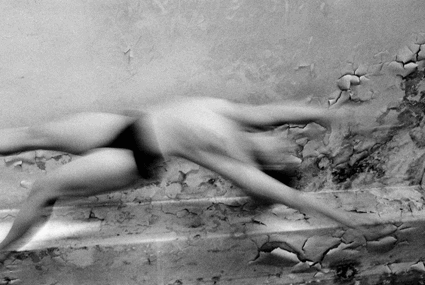
Kate Champion, About Face, 2001
photo Heidrun Löhr
Kate Champion, About Face, 2001
IT IS A GREAT PLEASURE TO SEE THIS EXHIBITION HONORING AND CELEBRATING THE PERFORMANCE PHOTOGRAPHY OF HEIDRUN LÖHR AT THE AUSTRALIAN CENTRE FOR PHOTOGRAPHY. RECENTLY THE ACP HAS INITIATED A GREATER NUMBER OF SOLO EXHIBITIONS WITHIN ITS PROGRAM AFTER A LONG PERIOD OF THEME-BASED GROUP EXHIBITIONS UNDER THE DIRECTORSHIP OF ALASDAIR FOSTER.
Foster, as the longest serving director at the ACP (at 14 years) curated many vibrant and broadly inclusive exhibitions. Aware of Löhr’s work due to his role on the Board of Performance Space, interim director Tim Wilson instigated Parallax which was developed in a short time period, making its achievement all the more impressive.
Curated in a collaboration between Löhr and ACP staff, images were selected from an archive of approximately 300,000 photographs. In a museum style exhibition, images are confidently installed at different scales and mounted on dark charcoal and grey walls. Approximately half the images are colour and the other half black and white, covering a timespan from 1989 to the present.
It is a bold and stylish exhibition. Rather than taking an historical approach to selection the curators have embraced Löhr’s own identification of her creative strengths in photographing performance and more specifically the human body in expressive movement.
Immediately obvious is Lohr’s decision not to be bound by the photographic conventions of sharp focus. This represents the confidence of an extremely experienced photographer and a philosophical choice to move away from the expectations of realism.
Talking to her, Löhr tells me her style developed on the job. Her assignments evolved from theatre to dance to performance, commonly requiring photographic skills to deal with challengingly dark spaces. Her camera aperture was of necessity open and she experimented with shutter speeds. Always at odds with the print media’s requirement for a moment of acute clarity, she says this is not the point in this exhibition. Over time her interest in the sequencing of movement grew as did her collaboration with the artists she was photographing. She increasingly pushed boundaries and experimented, trying anything and everything with the camera.

Martin del Amo, A Severe Insult to the Body, 2003 (detail)
photo Heidrun Löhr
Martin del Amo, A Severe Insult to the Body, 2003 (detail)
“I see my work as a collaborative process. Sometimes in exquisite moments, photographing becomes a duet between performer and photographer, both accomplices in the creation of images”. (Heidrun Löhr, Parallax, Room Notes)
There are two main values to this exhibition. Firstly, as indicated in Löhr’s own words and as evidenced on the walls of the gallery, there is an outsanding ability to record movement within the single image that has then transformed over time into an expression of the stages of movement through the use of sequences. With this strong style Löhr establishes a bridge between the stillness of a single image and the motion of cinema.
As Merce Cunningham has said, “No stillness exists without movement and no movement is fully expressed without stillness.” In a long sequence of small images featuring dancer Martin del Amo at the Omeo Dance Studio in Sydney (A Severe Insult to the Body, 2003) we are reminded of Muybridge’s famous studies of movement in humans and animals. In another bold series from the same performance with del Amo wearing high heeled shoes, the large scale is that of contemporary art photography.
There are many entrancing sequences that reinforce the relationship of cinema to movement and the inadequacy of the single image to fully express it. My favourite is from a pre-production publicity shoot of choreographer Kate Champion (in About Face at Scots Church and performed at the Studio, Sydney Opera House, 2001). In four images (three small, one large) Champion’s partly clothed body, impossibly flying through space, appears about to drop to a ground of concrete and rubble in exquisite images of part strength, part vulnerability.

Julie-Anne Long, Miss XL, 2002
photo Heidrun Löhr
Julie-Anne Long, Miss XL, 2002
In the ACP entrance corridor a sequence of Julie-Anne Long swirling like a whirling dervish (Miss XL, Seymour Centre, 2002) is mounted directly onto the wall at non-symmetric angles uniting the wall’s horizon line. In these sequences and other single images (Yael Stone and Geoffrey Rush in Belvoir’s 2010 production Diary of a Madman) the sense of photography as art in homage to painting makes this work by Löhr look highly collectable.
Within the context of the photography I was most excited by a 13-minute video work constructed from 2,500 still images which Löhr edited and sequenced collaboratively with Peter Oldham and with an evocative soundscape by Gail Priest. Recapturing the Vertical is an exciting extension of the experimental sequencing that Löhr has been developing. She is working on a further animation with Martin del Amo called Shallow Water. I hope she continues this project, a true hybrid between stills and film.
In an improvisation staged solely for Löhr’s camera, performer Nikki Heywood enacted a work about her mother’s bouts of dizziness and falling in the now empty Edgecliffe apartment where she had lived. Captured in five days by Löhr’s camera and edited into a stunning animation, we see Heywood embodying her mother’s vulnerability. The pacing of the editing speeds up and slows down to emphasise the emotionality of the relationship.
The second significant achievement of the exhibition is the historical mapping of the performers and performances that have collaborated with Löhr’s camera. There is one cluster wall covered with images that elicits an enjoyable game of name spotting of well-known Australian actors. This is in effective contrast to the more fascinating documentation of extraordinary performers and companies seen in multiple alternative arts venues around Sydney.
Heidrun Löhr has exhibited her work as art before. She has participated in group exhibitions and in 2007 at Critical Path she showed 700 images as projections, using four projectors and one digital slideshow, again with a score by Gail Priest. This event, developed as a result of a Fellowship from the Australia Council for 2007–2009, was focused more on historical documentation but within an experimental presentation.
Photographers like Heidrun Löhr who specialise in their work and who have had exposure to significant histories are often caught within a kind of invisibility. I therefore congratulate the ACP for creating this exhibition to honour one of the important working photographers in Sydney. Löhr’s images of the human body in spaces and in space, on chairs, on the floor, against black or white walls, freefalling, deal with human expression, emotion and spirit. Her contribution is unique. Moving through the large exhibition space at the ACP one has a sense of being at a theatrical performance of the body at its most heightened capacity, in all forms of expression, alive and revealing of emotion, pure human expression.
Heidrun Lohr, Parallax, The Performance Paradigm in Photography, Australian Centre for Photography, Sydney, March 3- April 15
RealTime issue #109 June-July 2012 pg. 42-43
© Sandy Edwards; for permission to reproduce apply to realtime@realtimearts.net
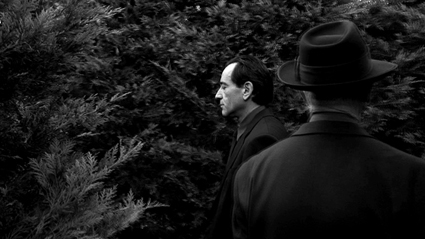
Dennis Del Favero, Todtnauberg, 2009
video still, courtesy of the artist
Dennis Del Favero, Todtnauberg, 2009
PAUL CELAN, POSSIBLY THE GREATEST POST-WAR POET IN THE GERMAN LANGUAGE, WAS BORN A ROMANIAN JEW WHOSE PARENTS WERE MURDERED IN THE HOLOCAUST. HE HIMSELF SURVIVED NEARLY TWO YEARS IN THE LABOUR CAMPS THEN LIVED MOST OF HIS ADULT LIFE IN PARIS BEFORE COMMITTING SUICIDE IN 1970. HIS MOST FAMOUS POEM, TODESFUGE, OR DEATH FUGUE, WITH ITS IMAGERY OF THE “BLACK MILK OF DAYBREAK,” REMAINS A STARTLING, EVEN SHOCKING ELEGY FOR THE DEAD JEWS OF EUROPE.
Todtnauberg is the title of a less well-known but perhaps equally significant poem written shortly after Celan’s visit to the philosopher Martin Heidegger’s mountain retreat in the town of the same name as the poem in July 1967. The text recalls Celan’s inscription in Heidegger’s visitor’s book, expressing the longing for a word “from the heart” from the great thinker. Heidegger reportedly provided nothing of the kind. The meeting of a survivor of the Nazi regime and one of its most famous apologists is the subject of Dennis Del Favero’s video work, also titled Todtnauberg, which focuses on Celan imagining the conversation they might have had. It is one of two works that comprise Del Favero’s solo show, Magnesium Light, at Perth’s John Curtin Gallery.
The video is shot in subdued, black and white tones and evokes a certain melancholia as the figure makes his way through the woods (just as Celan and Heidegger walked through the woods together). Yet there is no attempt to represent the significance of the occasion. The monochromatic tones and short duration of the work recall the similar restraint of Celan’s poem (a single sentence in eight stanzas). The audio track relates the dream of Heidegger’s apology, the fantasy of a mutually felt disgust. Celan imagines their tears flowing together, expressing his hope that the thinker can reflect on the infinite suffering that resulted from his chosen political orientation. Heidegger’s voice is also heard as he goes on to say that their personal views are now irrelevant from the perspective of history…but the logic of this work is that this is clearly not the case. The work engages the selective memory of both participants: Heidegger’s ongoing silence about his support for the Nazis and Celan’s wishful thinking about Heidegger and his often expressed guilt about his own survival when so many died, including his own parents.
Jill Bennett has written beautifully about the function of memory and forgetfulness in Del Favero’s work: “memory is never simply a matter of recall, as Dennis Del Favero’s work persistently demonstrates. If trauma, pain and emotional distress must pass into the narrative of memory in order to become livable, these experiences do not bear constant replay. The work of narrative—and of the visual imaginary—is to process and house such memory in ways that enable transition, allowing remembering to occur at the same time as placing trauma (which haunts the present) in a past over which the narrator has some measure of control” (catalogue essay to Forgetful Sky, Boutwell Draper Gallery, Sydney 2009).
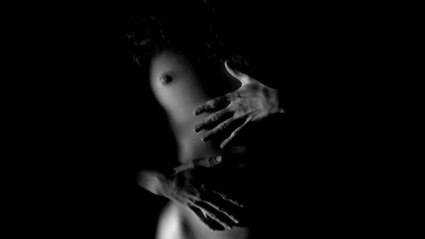
Dennis Del Favero, You and I, 2009
video still, courtesy of the artist
Dennis Del Favero, You and I, 2009
In the other work presented here, You and I, Del Favero explores this kind of displacement in the context of the infamous Abu Ghraib photographs of 2006. This is not immediately clear from the video which shows an anonymous woman writhing in sexual pleasure. A voiceover, with an American accent, suggests that the woman is a female soldier based somewhere in the Middle East. The video performs an act of displacement in which, as Bennett has pointed out, the woman chooses to overlook her abuse of a prisoner by focusing on the memory of her sexual conquest.
In Del Favero’s opus there is a consistent investigation of traumatic memory, memories that surface reluctantly if at all, seen in works such Cross Currents (1999), engaging with the experience of sex slaves, and Deep Sleep (2004), which deals with the artist’s own personal memories of treatment at Chelmsford Psychiatric Hospital in the 1970s. Most recently in Scenario (2011), an iCinema project directed by Del Favero and a world first interactive and immersive 3D cinematic experience, we see the same structure. His works all use new media devices to explore dimensions of memory interactively and to engage an audience with material that both wants to remain hidden but which continually rises forcefully to the surface of memory. Art has always played this role, to bring the unseen or overlooked into focus, and for Del Favero this is also a key function of his own new media art.
In the title of the work Pentimento (2002), which deals with a case of brother-sister incest, we can read a clue as to how Del Favero sees his work as the exploration of what art historians call ‘pentimenti,’ the visible traces of an earlier version of an artist’s layout beneath layers of paint on a canvas. Del Favero aims to activate the hidden dimensions of memory in society or the human psyche and, in this sense, the works in Magnesium Light show the dynamic nature of memory that refuses the logic of either simple loss or recall. These works show a memory that resists erasure but equally avoids the repetition of traumatic recall and forms instead the basis for a partly fantasmatic but entirely workable relationship with the self and the world.
The works in Magnesium Light may not look like user guides to an ethical life but they purport to explore the ways that victims and perpetrators of violence can refocus on how “one might live in a world increasingly haunted by its past” (Del Favero, artist statement, Australian Video Art Archive. www.videoartchive.org.au/dfavero). His art explores and performs the essential displacements and substitutions we all make in memory and so enables an ethical examination of our perspectives on such complex values as innocence and guilt. Magnesium Light complicates a reading of victimhood as innocence and a visual rendering of the perpetrator as an unfeeling “anaesthetic protuberance” (Susan Buck-Morss,”Aesthetics and Anaesthetics: Walter Benjamin’s Artwork Essay Reconsidered,” October 62, Fall 1992). In achieving this, the work enables a significant re-evaluation of the codes of trauma and memory in visual culture.
Dennis del Favero, Magnesium Light, John Curtin Gallery, Curtin University, Perth, June 1-Aug 5
RealTime issue #109 June-July 2012 pg. 44
© Ed Scheer; for permission to reproduce apply to realtime@realtimearts.net
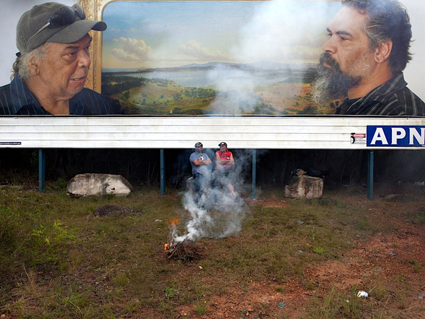
Roy takes a break after showing Kelton the best fishing spots (detail) with Roy Kennedy and Kelton Pell sitting at APN billboard site, Waterfall, NSW; Appropriated Circumstances, 2012
photo, Derek Kreckler 2012
Roy takes a break after showing Kelton the best fishing spots (detail) with Roy Kennedy and Kelton Pell sitting at APN billboard site, Waterfall, NSW; Appropriated Circumstances, 2012
MORE THAN ANY OTHER TYPE OF IMAGE, THE ROADSIDE BILLBOARD OPERATES IN THE REALM OF OUR PERIPHERAL VISION AS THE SIGN GLIMPSED OVER AND OVER THROUGH THE CORNER OF AN EYE.
For this reason, artists who venture toward the billboard as a vehicle for art typically take a forthright approach, figures such as Barbara Kruger and her contemporary successors—culture jammers who employ the graphically bold and arresting strategies of advertising, turning it against itself. In these instances, ultimately the subversion resides more in the message than in the mode of visual communication.
An oblique approach is rarer. Yet this is precisely what was encountered in artist Derek Kreckler’s two roadside billboard installations from his Appropriated Circumstances series that intrigued drivers along the Princes Highway at Heathcote on the Sydney outbound route and at another inbound site just out of Waterfall from late February until April. Devoid of any text, slogan or signifier of a commercial entity or brand, Kreckler’s billboards were essentially large photographs in the landscape that, as drivers approached, registered like a glitch upon the sight line. Gentler than most advertising images with their naturalistic tones and clean, uncluttered white background, the billboards almost blended into the surrounding landscape and vegetation. “Because they’re highly detailed as photographs, it’s a different type of push on the viewer,” suggests Kreckler. “People look twice at them.”
Anti-advertising is one description that’s been suggested for the signs but it’s a term that perhaps doesn’t quite register the rich complexity of their visual rhetoric. The pair of billboards present two photographs taken by Kreckler that record a meeting between well-known Wollongong Dharawal activist and storyteller Roy ‘Dootch’ Kennedy and actor Kelton Pell, a Noongah man from South Western Australia, captured in front of a 19th century landscape painting in the City of Wollongong Gallery. The seemingly anachronistic gilt framed scene which is the object of their attention is colonial artist Eugene von Guérard’s View of Lake Illawarra with distant mountains of Kiama (1860). Its sweepingly picturesque and pristine view of the local topography pre-industrialisation presents a striking contrast to today’s developed coastline.
Titled “Dootch takes a break after showing Kelton the best fishing spots” and “Strewth” (a clue to one of the billboards’ precursors?) Kreckler’s self-funded installations have more in common with visual strategies such as new objectivist image-making than the methods of public art as they’re typically understood. Commenting on the impetus of the work, Kreckler identifies a number of antecedent threads including a long held fascination with the museum photographs of Thomas Struth (b1954) which capture crowds of spectators looking at iconic paintings in the Louvre, the Prado in Madrid and other famous museums. When Kreckler encountered von Guérard’s near photographic oil study in the Wollongong City Gallery, he began to consider the work in this context (incidentally, Kreckler points out that both Struth and von Guérard trained at the Düsseldorf Art Academy in Germany). It was a meeting with Dootch Kennedy, though, that eventually shifted Kreckler’s thinking into a more temporal terrain.
“To me, the von Guérard painting appears quite old, but to Dootch it’s just another moment in time,” says Kreckler. The artist suggested to Dootch the idea of photographing him in front of the work and once he’d agreed, Kreckler introduced him to Pell. When the two men met in the gallery the painting immediately became a catalyst for cultural exchange as Dootch spiritedly imparted his considerable knowledge of the plentiful food source sites around the lake (Lake Illawarra is also regarded as having been an important location for Indigenous ceremonial and traditional activities). Kreckler took a large number of photographs without a particular construction in mind, simply observing the moment and shooting until the camera became invisible. Afterwards, he gave some thought as to how to exhibit the images. “I was feeling that I didn’t just want to put a photograph in a gallery and photography is so ubiquitous these days. I wanted to honour the work in a different way.” It was only later, driving past a billboard at Waterfall which at the time was displaying the now infamous “Want Longer Lasting Sex” advertisements, that Kreckler was struck by the possibility of appropriating the boards.
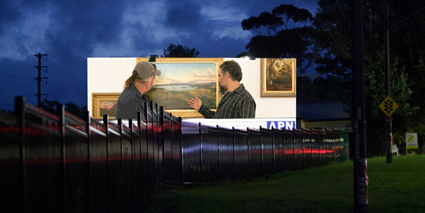
Derek Kreckler, ‘Strewth’, from the series Appropriated Circumstance, 2012, Princes Highway, Heathcote NSW
courtesy the artist
Derek Kreckler, ‘Strewth’, from the series Appropriated Circumstance, 2012, Princes Highway, Heathcote NSW
A multidisciplinary artist embedded in conceptual modes of thinking and making, Kreckler’s photographic practice interrogates the conventions of seeing. With images that are coolly precise and quietly performative, the apparent everyday quality of the scenes typically belies the web of temporal and perceptual concerns that cook and simmer with prolonged looking. Driving around the gentle bend and over the crest of the road on the approach to the “Strewth” billboard at Heathcote, the immediate impression of encountering two large-scale figures looming over the traffic with their backs turned away from the stream of passing cars was almost disconcerting in its denial of the viewer’s gaze. But following the direction of their line of vision into the painting, guided by Pell’s gesturing toward the von Guérard with an outstretched hand, absorbs the viewer into the men’s shared act of observation. Momentarily, looking takes on a surprisingly participatory dimension. For the drivers who passed the billboards on their daily route along the Princes Highway the back story of the images’ construction would have been irrelevant—what the observant driver encountered was a puzzle, a cryptic story with a network of referents that yielded more clues with each repeat viewing, while refusing any revelation.
Paintings like von Guérard’s View of Lake Illawarra increasingly hold interest for their ‘time capsule’ effect and there’s an aptness in Kreckler’s appropriation of this work given the recent reappraisal of the artist’s oeuvre. Long dismissed as too European in his perceptions of the Australian landscape but now gaining a new appreciation for the sublime qualities and scientific motivations of his paintings, von Guérard’s unspoiled landscapes carry greater resonance in an age of environmental crisis. The fact that an artist can undergo such extremes of reception is a reminder that all perception is cultural and susceptible to destabilising twists and turns. Kreckler’s creative appropriation of the billboard likewise reveals the shifts that can occur when a conditioned habit of seeing, or not seeing, is disrupted and fixed relations are unmoored, imaginatively set adrift into unexpected reconfigurations.
Derek Kreckler, Appropriated Circumstances, billboard installations at Heathcote, Feb 27–March 25 and Waterfall, NSW, Feb 27 – Apr 22
RealTime issue #109 June-July 2012 pg. 45
© Ella Mudie; for permission to reproduce apply to realtime@realtimearts.net
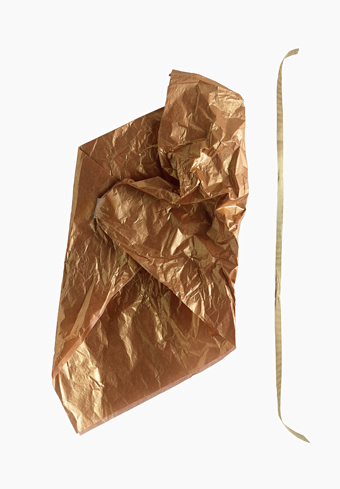
Eugenia Raskopoulos, Vestiges #3 (2010),
courtesy the artist and William Wright Artists Projects Sydney
Eugenia Raskopoulos, Vestiges #3 (2010),
ART PRIZES THE SCALE OF THE JOSEPHINE ULRICK AND WIN SCHUBERT PHOTOGRAPHY AWARD CAN TEND TOWARD THE SMASH AND GRAB VARIETY, HOWEVER THIS IS NOT THE CASE WITH THIS AWARD. NOW IN ITS 11TH YEAR, IT IS CERTAINLY ONE OF THE MOST IMPORTANT MEDIA SPECIFIC AWARDS IN THE COUNTRY WITH A GENEROUS PRIZE PURSE, BUT ALSO STANDS ALONE AS AN EXHIBITION OF HIGH QUALITY CONTEMPORARY PHOTOGRAPHY.
Selected and judged in 2012 by Kon Gouriotis, Director of the Australian Centre for Photography (a different judge is chosen every year), the prize is thus a curated selection, which lends it a critical strength and relevance as an exhibition of contemporary photography. This year’s prize presented a veritable smorgasbord of Australia’s leading photographic artists and as with all smorgasbords, the temptation is to indulge—indeed, it’s almost impossible not to when faced with 75 works, selected from over 360 entries.
The result was a salon hang of names, from well established and mid-career artists such as Petrina Hicks, Anne McDonald, Tamara Dean, Merilyn Fairskye and Darren Sylvester (who also gave a talk as part of the opening events), through to more emerging artists. Works ranged too in physical scale from huge to small lending the exhibition some more intimate moments. The thoughtfully chosen final field offered a snapshot, albeit subjective, of contemporary practice, a litmus test of the sector as it were.
The most important aspect to note is that the prize belongs to Gold Coast City Art Gallery (GCCAG), one of the biggest regional art galleries in Australia with an impressive collection begun in the 1970s. GCCAG is in the process of campaigning for bigger digs, motivated by the collection’s growing size and calibre; the continued success of this prize should add more weight to the argument. A word too about the Josephine Ulrick and Win Schubert Foundation: it’s nothing short of a national treasure, given the dearth of private philanthropy in this country. Its reach extends across literature, poetry, photography and ceramics and a variety of universities, museums and galleries. The photographic award’s first prize of $20,000 is supplemented by an additional $10,000 to the Gold Coast City Collection for acquisitions, which in 2012 included, at the judge’s discretion, works by Chris Budgeon, Ella Dreyfus, Merilyn Fairskye, Sam Scoufos and Chris Herzfeld in collaboration with Thom Buchanan: all handsome and welcome collection additions.
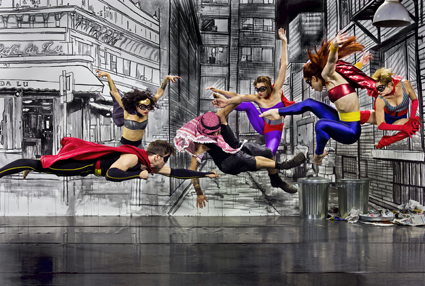
Chris Herzfeld in collaboration with Thom Buchanan, Superhero 3
courtesy the artists
Chris Herzfeld in collaboration with Thom Buchanan, Superhero 3
Thus The Josephine Ulrick and Win Schubert Photography Award truly is nothing short of a gift to the gallery, and to the nation too. Fitting then that the winning work was Eugenia Raskopoulos’ Vestiges #3. On the surface an abstract study, the work is also a study in simplicity. A photograph of the remnants of a birthday gift—the discarded wrapping paper—it constitutes a happy accident of sorts, in the spirit of Irwin Wurm’s three-minute sculptures. Raskopolous’ larger project concerns itself with language, the complexity of making oneself understood as an immigrant in a strange land. In his award notes Gouriotis explained, “What started off as birthday wrapping paper, ended up as another shape which is then photographed offering a new interpretation to the object. The new meaning this shift creates, recognises the incomplete over the complete. It supports the possibility of other changes rather than no transformations.” It is an eloquent work that speaks with gravity to the immutable power of visual language in the absence of a voice. As the winning work too, its humility takes on greater significance: it’s the gift that keeps on giving.
Other notable inclusions were Petrina Hick’s work Untitled #1 (The Perfomance, 2011) best described as a witty conflation of religious painting and Benetton advertising. In this ‘performance’ however, young women play the roles of Jesus and doubting Thomas investigating Christ’s wound. Hicks’ bright-eyed teenagers might be metaphors for a contemporary culture that is spiritually bankrupt, or emblematic of youth itself: beautiful and bereft. Superhero 3, 2012 created collaboratively by Chris Herzfeld and performative visual artist Thom Buchanan (and acquired as part of the fund) follows in the Marvel Comic tradition. Here a group of caped crusaders unite to smack down a dishdash-wearing Muslim foe. It’s a fun but ultimately serious work. Linsey Gosper’s Alone in my room (little death), 2011 with its pathetic, exposed protagonist is wonderfully dark. Murray Frederick’s magnificently malevolent clouds in Hector #12, 2011 evoke the cloud paintings of Matthys Gerber. It’s a particularly painterly work, eerily similar to Simone Douglas’s two cloud studies Ever III and Ever VII, 2011. Then there was Cherine Fahd’s whimsical and humorous 365 attempts to meditate, 2011, composed of 50 small images of a person blowing up a balloon. All in all the 2012 was a rich selection with something for everyone, like the perfect ‘all you can eat.’
The award coincided too with the biannual Queensland Festival of Photography, a series of events and exhibitions held across the state, and was complemented at Gold Coast City Art Gallery by Lorikeet Island, an exhibition of collaborative work by Alana Hampton and Marian Drew. An ambitious installation, Lorikeet Island consisted of photographs and immersive new media works produced over an extended period of time onsite at a mangrove cay in one of the labyrinthine Gold Coast waterways. The artists aimed to highlight the incredible natural beauty that lies just at the edge of Surfers Paradise’ ‘glitter strip,’ the aquatic playground that brings in the tourists. Lorikeet Island captured the largely unseen beauty of one small island that disappears with the vagaries of the tidal changes, exposing the mangroves and complex ecosystem. Hampton and Drew have worked together before but this exhibition crystallised their individual practices with its clarity of vision and execution. After the very fulfilling experience of the award, walking into the exhibition was not unlike diving beneath the water: cool and sating.
The Josephine Ulrick and Win Schubert Photography Award, Gallery 1, The Arts Centre, Gold Coast, March 31-May 13
RealTime issue #109 June-July 2012 pg. 46
© Alison Kubler; for permission to reproduce apply to realtime@realtimearts.net
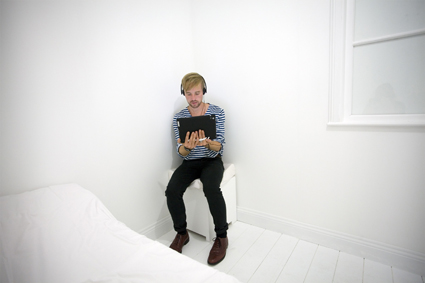
Alma Mater
photo Ponch Hawkes
Alma Mater
THERE’S A LABORATORY IN THE US THAT APPARENTLY HOLDS THE RECORD FOR THE WORLD’S QUIETEST PLACE—SO ACOUSTICALLY INSULATED THAT ANYONE INSIDE THE ROOM WILL HEAR NOTHING BUT THE SOUNDS OF THEIR OWN BODY.
To hear your very blood circulating, your organs heaving, is supposed to be an alarming experience and few can last long in the anechoic chamber without risking their sanity. I don’t know if that’s true, but the story has some psychic pull to it, given the way it dramatises something nigh impossible in our lives today: the idea of being completely alone.
Theatre, for the most part, doesn’t play with aloneness all that much. It’s a social art, and if a work addresses solitude at the level of narrative, you’re usually witnessing it in a roomful of fellows. Even if you’re the only person who’s fronted up on the night, or it’s a play-for-one, you’re likely in a space with another human being performing in some manner. Theatre is shared.
alma mater
That’s why UK duo Fish & Game’s Alma Mater proves such a striking encounter—striking in the sense of a blow, a box about the ears. It’s deceptively simple to describe. The lone audience member is given an iPad and headphones and sent into a small, artificially constructed room where they close the door behind them. The interior and its minimal furnishings—a bed, chair, dresser–is entirely white, a blank. The short film that plays out on the tablet’s screen, it becomes apparent, takes the same point of view as the person watching it, scanning the room as you pan in each direction. And then the ghosts appear. The device becomes a puncture in space, two pale children suddenly emerging and acknowledging the presence of the viewer.
While it doesn’t sound like much, the construction of the environment is integral to the phantasmic experience. It’s as if the mind struggles with the idea of being so completely alone, and gives the images on the screen more weight in reality as a result. Of course the kids aren’t in the room with you, but there’s an uncanny sense that they might be, in some way, or have left some real traces that hover behind you.
The drama that unfolds expands upon this prickling haunting: the room onscreen gradually becomes more embellished, the children discovering a bird in a cage, colour on walls, a family. A mystery begins to develop, involving a possible death, a transformation, a sinister sister with a murderous baking habit. We’re now in a space where something terrible may have occurred, and the children still regularly turn to look at us, their inscrutable expressions raising too many questions: are they asking us to help? Or to merely bear witness? Or is there something accusatory in there? Who, in the end, are we?
The whole encounter lasts barely 20 minutes but it’s riddled with enigmatic meanings that linger well after you exit the room. I left wanting to call someone, to talk to some real person if only to rid myself of the eerie sense that being so very alone opens up the possibility of visitations from places I’m pretty sure don’t exist. Which, some might argue, is one effective definition of art.
the seizure
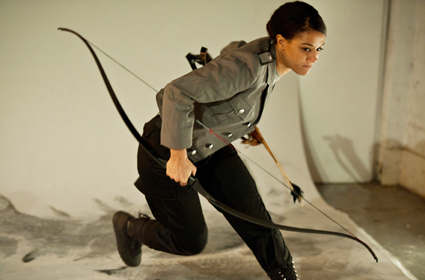
Naomi Rukavina, The Seizure
photo Lachlan Woods
Naomi Rukavina, The Seizure
The Hayloft Project’s latest work explores the hellishness of solitude in another form. The Seizure takes up the story of Sophocles’ Philoctetes, a soldier abandoned on a miserable island after an injury to his ankle. Here he has spent a decade in isolation, eating birds, picking at the festering wound that never heals. His only interlocutor is a crow, and in keeping with writer Benedict Hardie’s modern and secular interpretation, this chorus may well be a projection of Philoctetes’ own mental state. The divine is a pointed absence in this adaptation—there will be no salvation from Beyond.
When other humans do arrive—Neoptolemus and Odysseus, hoping to convince their fallen comrade to return to the war effort—we see how Philoctetes’ plight has become his being. He refuses to rejoin society, having seen how the fight itself is an undying machine that feeds on the bodies of men. If his wound is the thing that removed him from the cycle of death, then perhaps that is why he cannot allow it to be mended—this is the puncture that allows him a glimpse of the reality of war.
It’s a sparse and solemn production. In the past Hardie has proven a wonderful ability to show how words may both convey and obscure meaning (the outstanding Yuri Wells, for instance; RT94, p8) but here he holds back the linguistic fireworks in favour of a subtle, reverential poetry that serves its source well. The design is also unobtrusive: an almost featureless white space, with only a slash of black ink cutting a scar across the otherwise blank vista. Despite all of this, there’s much contemporary resonance to the piece, suggesting as it does that freedom is a sentence, not a gift.
the histrionic
Thomas Bernhard’s The Histrionic presents another vision of a self-imposed solipsist. The titular pomp, Bruscon, is a theatre-maker who has fashioned the entirety of human existence as his own reflection. He tours the country with his epic The Wheel of History, in which he dramatises the lives of great men by playing them himself. We find him in a pitiful backwater where he is attempting to stage a production of the play, facing down local safety regulations, substandard staging conditions and the resentful members of his family he requires to play supporting roles. He brings to all of this the kind of outrageous arrogance that at first seems to situate Bernhard’s work in farcical territory, but quickly expands to become something much more.
Bruscon is a fascinating tyrant who rails against the residual fascism he sees infecting post-war Europe while acting as its most potent expression. His art transforms human experience into a grotesque parody of itself, serving only to bulwark his ego at the expense of those around him. It results in literal violence against his family, just as it enacts its own form of symbolic violence. On a surface level this maker of a world is Hitler, but he is also the essence of the artist for whom the work stands above its subjects.
Bernhard’s brilliant creation here is also a condemnation of himself, the writer, and there are pointed connections between his monster and his own professional history. This is absolutely necessary, for to remove himself from the frame would be to commit the very same crimes of which he accuses Bruscon. To write himself in, of course, is to admit that those crimes are ones he’s guilty of already. It’s a slippery move but it adds immeasurably to the compelling complexity undergirding the entire work.
Where Philoctetes’ plight makes loneliness a tragic demand of freedom, and Alma Mater suggests that isolation breeds demons, Bruscon is the artist who seeks to remove himself from the degradation of civilisation by reducing the world to something he may command. While there’s plenty of laughter involved, especially given Bille Brown’s masterful performance, this theatre-maker may offer up the most chilling implication of creative solitude: to truly stand alone, free of influence and interpretation, is liberation as an act of annihilation.
Alma Mater, created by Fish & Game, directors Robert Walton, Eilidh MacAskill, cinematography Anna Chaney, music John De Simone, performers Lucy Gaizely, Albie Gaizely-Gardiner, Lyla Gaizely-Gardiner, Raedie Gaizely Gardiner, Gary Gardiner, Becki Gerrard, Thom Scullion, Mr Feathers, Ensemble Thing, design Phil Bowen, Hugh Speirs, Arts House, North Melbourne Town Hall, Apr 18-May 13; The Hayloft Project, The Seizure after Sophocles’ Philoctetes, writer, director Benedict Hardie, performers Christopher Brown, Haiha Le, Brian Lipson, Naomi Rukavina, dramaturgy Anne-Louise Sarks, design, costumes Zoe Rouse, lighting Lucy Birkinshaw, sound design Alister Mew, Studio 246A Brunswick, May 3-19; Malthouse Theatre & Sydney Theatre Company, The Histrionic, writer Thomas Bernhard, translator Tom Wright, director Daniel Schlusser, performers Bille Brown, Kelly Butler, Barry Otto, Josh Price, Katherine Tonkin, Jennifer Vuletic, Edwina Wren, set, costumes Marg Horwell, lighting Paul Jackson, sound design, composition Darrin Verhagen, CUB Malthouse, Apr 2-May 5; STC, Jun 20-Jul 28
RealTime issue #109 June-July 2012 pg. 24
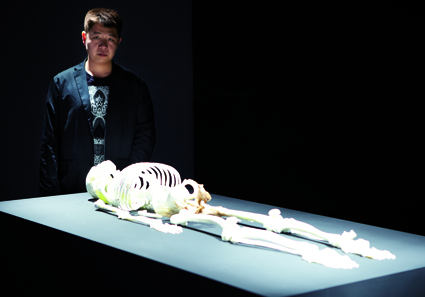
He Xiangyu alongside his work, Skeleton at 4A Centre for Contemporary Asian Art
photo Zan Wimberley
He Xiangyu alongside his work, Skeleton at 4A Centre for Contemporary Asian Art
AN EXHIBITION CALLED COLA PROJECT DOESN’T AT FIRST SOUND ENTIRELY NEW: COCA COLA, CONSUMER CULTURE, THE POWER OF ADVERTISING—THESE HAVE ALL BEEN CONSIDERED BEFORE, NOT LEAST OF ALL BY CHINESE ARTISTS ASSESSING THE IMPACT OF GLOBAL CAPITALISM ON TRADITIONAL AESTHETICS AND VALUES.
This recent show at Gallery 4A in Sydney’s Chinatown, however, takes a different perspective, and considers cola the sticky liquid rather than the clout of its global logo. After analysing the effects of consumerism on images, it appears that what you are left with is the object, and the ‘stuff’ of material culture.
Cola Project is currently the signature work of young, Beijing-based artist, He Xiangyu, and one that has been doing the international rounds since first showing in Beijing in 2010. 4A brought it to Sydney as part of their ongoing program to situate Australian art within the context of the Asia Pacific, bringing Asian exhibitions to Australia and recognising the Asian in Australian work. This, He Xiangyu’s third major art project, helps underscore this geographical and cultural proximity, if only for its acknowledgement of the finite—and increasingly crowded—nature of our physical world.
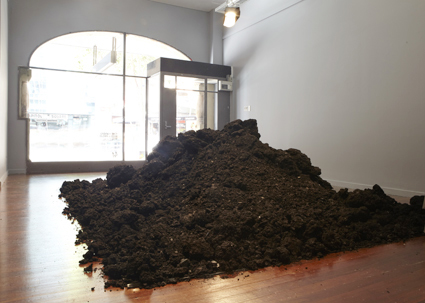
He Xiangyu, Cola Project Resin (2009-2010), installation view at 4A Centre for Contemporary Asian Art, courtesy of the artist and White Space, Beijing
photo Zan Wimberley
He Xiangyu, Cola Project Resin (2009-2010), installation view at 4A Centre for Contemporary Asian Art, courtesy of the artist and White Space, Beijing
In 2008, He Xiangyu worked with factory workers to boil up thousands of litres of Coca Cola, tracing its transformation into syrup, then sludge and eventually into coal-like crystals. These were then ground down to produce a black ink, with which the artist painted a series of Song Dynasty-style landscapes. Meanwhile, some of the goo was put aside for experiments on skeletons made by the artist from jade. The works on display at 4A represent about one third of the original show, and include a miscellany of products and documentation resulting from the large-scale work. The artist was also in town to assist with the installation, and I had the chance to speak with him then.
“I’m interested in the relationship between objects and people,” he told me. “In Beijing now, there are so many buildings in the centre of the city, so they build the rubbish tips further out. But then the city grows, until it and the rubbish are all on top of one another. Then the groundwater becomes polluted by the run-off and, bit by bit, this rubbish starts to permeate you.” He Xiangyu speaks with an awareness of his physical surroundings, but more with a tone of curiosity than indignation. The cycles of transformation seem to interest him rather than any narrative of environmental decay. As we sat in the downstairs gallery space, our conversation was itself infused with the smell of the exhibition—the tang of cola residue sits in your nostrils.
Entering the gallery at street level, visitors are confronted with a large pile of the black molasses-like substance produced by the refinement process. At turns both filthy and magical, it suggests a heap of coal one moment and an ink-washed Chinese landscape the next.
Upstairs hang the paintings rendered in this sticky material, the waste product of an industrial experiment put to the production of new cultural forms. Familiar limestone mountains disappear into clouds, river systems wend around their bases. There are boats and little bridges (arched like eyebrows) and the odd lonely pavilion tucked high into the crux of a mountain top. Distinctly ‘works of art,’ these paintings are as exquisite as the idea of the Coke sludge is coarse.
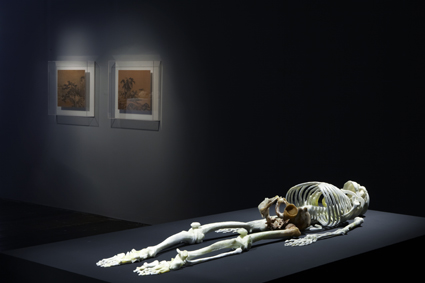
He Xiangyu, Skeleton (2010), jade, installation view at 4A Centre for Contemporary Asian Art, courtesy of Pearl Lam Gallery, Shanghai
photo Zan Wimberley
He Xiangyu, Skeleton (2010), jade, installation view at 4A Centre for Contemporary Asian Art, courtesy of Pearl Lam Gallery, Shanghai
On a podium, laid out as if for medical inspection, is one of the original exhibition’s three skeletons made of jade. Cola scum, applied to selected bones, has discoloured and worn holes into this highly prized, ancient material. In a nearby cabinet, bone specimens and a beaker of leftover black liquid are arranged as if they’ve come straight from the laboratory. If there is a traditional Chinese aesthetic to the show, it also has a creepy Victorian feel—a Jekyll and Hyde sense of experimentation with the materials that shape body and society.
Around the gallery lie further traces of the distillation process: artefacts covered in gloop; a pile of buckets stacked messily on top of one another; a detritus of spades, gloves and goggles. Finally, a wall of photographs records the smelting process: men in protective clothing pushing poles into ponds of blackness, lost behind clouds of steam. A pile of empty Coca Cola bottles is, intriguingly, the only image here printed in black and white, the choice of monochrome print disavowing the power of the red and white labels. This show is about cola the substance—a material that moves through and is processed by our bodies—not a brand with its lofty mythologies.
Ultimately the exhibition has a kind of circular logic, with each work stitched invisibly to the next. The filthy is within the exquisite, the base within the refined. There is a constant reminder of the ongoing cycle of refuse and sophistication. In this sense the exhibition is about the inextricability of humans and what they create: culture and waste. However, it also highlights the question of art itself as a process or, more specifically, art as a physical production. If the world is now engaged in a trashing and rehashing of resources, what role does art production—and art consumption—play within that?
At one point my conversation with He Xiangyu turned to Wim Delvoye’s infamous artwork, Cloaca Professional, which mimics the human digestive system. Currently on display in Hobart’s Museum of Old and New Art (MONA), the machine is fed by curators and produces excrement on the hour. I suggested that the work was quite a confronting piece for a gallery environment. “Really?” said He Xiangyu with a smile. He was well aware of the piece. “I think [Cloaca Professional] is cool. It’s very symbolic of our times.”
He Xiangyu, Cola Project, Gallery 4A, Sydney, March 15–May 5
This article originally appeared in RealTime’s online e-dition May 22
RealTime issue #109 June-July 2012 pg. 40
© Christen Cornell; for permission to reproduce apply to realtime@realtimearts.net
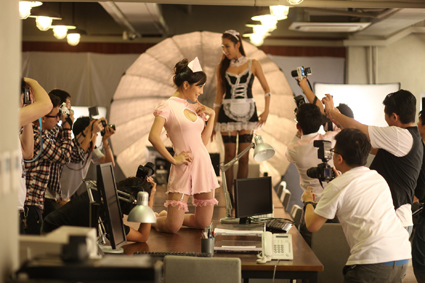
Vulgaria
MARCH WAS UNSEASONABLY COOL IN HONG KONG THIS YEAR, BUT THE ACTION AT FILMART MORE THAN MADE UP FOR THIS. THE MODEL FOR A MORE MATURE CHINESE FILM INDUSTRY IS FALLING INTO PLACE, AND THE MARKET WAS ALIVE WITH SMOOTH OPERATORS TALKING UP THE PROSPECTS OF “MONETISING CONTENT” (IE MAKING A BUCK).
China has now emerged as the world’s third biggest box office surpassing $US2 billion, only marginally behind Japan. Online revenue streams are also taking off as the industry stabilises around a new release chain. The freshly technologised China may abandon DVD altogether, given that it is so hard to protect the format from piracy. Instead, online platforms like Youku have emerged as second markets after theatrical exhibition. People are increasingly prepared to pay for content delivered to mobile devices.
There are also signs that the Chinese government is more interested in reaching an accommodation with the international film industry, allowing more “enhanced” foreign films (3D Hollywood blockbusters) to be distributed under better revenue sharing conditions. A joint venture announced with Dreamworks Animation suggests that, after years of frustration, Hollywood now thinks it can participate in the Chinese expansion. Expect to see more Chinese names in the credits of Kung Fu Panda 3.
Strangely though, once the Hong Kong International Film Festival (HKIFF) started a few days later, there was a distinct dearth of Chinese films. As the HK industry declined over recent years, HKIFF became the place to see alternative Chinese films. This year, however, it was clear that the alternative Chinese scene is in sorry decline. Maybe everybody wants to come up from underground and get a piece of the commercial action, or perhaps the festival stopped programming the films because local interest was lacking.
love is in the air
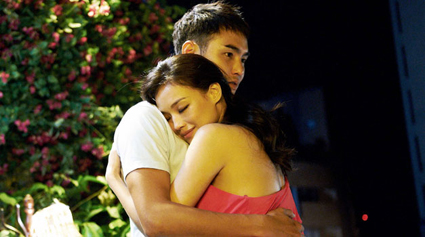
Love
Instead, love is in the air for Chinese filmmakers. With the success of Taiwan’s You Are the Apple of My Eye and the mainland’s Love Is Not Blind, romantic comedy is the favoured genre of the region’s nascent commercial cinema. Doze Niu Chen-zer’s Love is a good example. Doze’s last film was the tough gangster film Monga, but Love is a network narrative of trendy young things who travel across the Taiwanese straits with more ease than they cross lines of class and gender.
Tsao Jui Yuan’s Joyful Reunion was another example, where food—the new bourgeois religion—is the currency of romantic complication, and where the divisions between Taiwan and China are effortlessly effaced by young and old lovers. These romances might prove harder for Western audiences to embrace, as they are directed at women rather than the male cult audiences that have traditionally sustained Asian film in the West. There’s also a kind of lush coyness with which the subject is approached. Given that the characters rarely enact their passions, gimmicky gesture and fairly obtrusive music become inordinately important as a way of signalling emotion. The result can be rather cloying, as Love Is Not Blind demonstrates. A young marriage planner breaks up with her unfaithful boyfriend and ends up with her prissy co-worker in a triumph for mannered cuteness.
bye bye miserabilism
After years of watching miserabilist films full of seedy pimps and chain-smoking grunge, it takes a little readjustment to see that Chinese audiences might enjoy seeing beautiful stars and conspicuous consumption of name brands (a lot of Häagen-Dazs is eaten in Love). Since the time of the Fifth Generation, the Chinese government has charged that underground filmmakers “pulled down their mother’s pants so foreigners could see her arse,” but the new rom-commies present us with the challenge of expanding our preconceptions about 21st century China. Previously, the Australian media only wanted to know that China was not a nice place. As the consumerist economy flourishes and an entertainment cinema emerges, we may have to look at frivolous genre films with a fresh measure of respect.
On the other hand, gloom is in the air for Hong Kong filmmakers. The money and the audiences are all on the mainland, and the glory days look to be in the past. This is the best framework for watching the two films by Pang Ho-cheung in the festival. There are two options for HK filmmakers: go to the mainland or stay in HK and make cheap movies. Pang’s Love in the Buff and Vulgaria are responses to these two options.
love in the buff

Love in the Buff
Love in the Buff is a sequel to Love in a Puff (2010), a romantic comedy with Shawn Yue and Miriam Yeung as two HK office workers who meet while smoking outside their offices. The new film relocates the characters to Beijing, where they have to fall in love all over again. Pang’s films are based around the idea that men and women are essentially opposed to each other. It might be the case here that men are from Mars and women are from Hong Kong, but the logic of the film is that geography tops gender, as our ill-suited couple form a tacit alliance against the northerners. The couple conspire in Cantonese against the more earnest, and nicer, Mandarin speakers. Hong Kongers are pictured as cool smart-arses whose sense of their own imperfect identities triumphs over the attractions of the north.
vulgaria
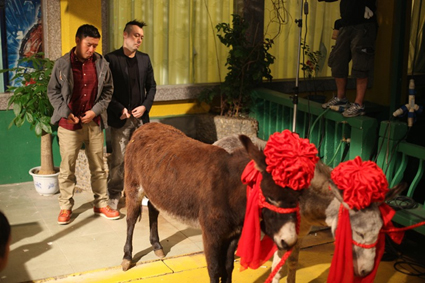
Vulgaria
Pang’s quicker and nastier comedy, Vulgaria, is as cheap as it is full of cheerfully scatological humour. A HK producer must go to any lengths to raise finance. This involves dealing with mainland gangsters whose idea of a big night out includes meals built around animal sex organs, topped off by a spot of bestiality. This is what it means to stay in HK and survive in the film business. No gag is too cheap and no in-joke too local. Stripped of this context, I’m not sure anyone would want to watch this film for more than 10 minutes. However, context is king here. Despite the tackiness of its mise-en-scène and the smuttiness of its humour, there is a strange grandeur to those who swim against the tide of history and persevere with lost causes.
Australians were thin on the ground at FilMart, which added a further layer of irony to the title of Wish You Were Here, one of the few Aussie films at HKIFF (see review). Asia features here as a place where Australians go to give in to their vices. It’s an inward-looking film about glimpsing the dangers of the world and retreating back to the family. Seen in Asia, this seemed a cogent statement on the limitations in the imaginative vision of Australians.
Hong Kong International Film Festival, March 21-April 5, www.hkiff.org.hk
This article originally appeared as part of RealTime's online e-dition May 22
RealTime issue #109 June-July 2012 pg. 13
© Mike Walsh; for permission to reproduce apply to realtime@realtimearts.net
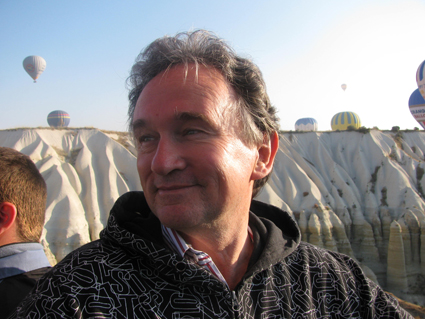
Greg Hooper, ballooning in Goreme, Turkey
Bio
I was born in Adelaide in 1957. Grew up there. I love that my children won't have to do that, be in that Australia. Back then. At my high school boys weren't allowed to do Art—they were taken outside to shift desks or pick up papers. Art was for girls.
I think 1976 was the first time I saw live music that wasn't a rock band. John Cage. Loved it. ABC-FM came out around then and gave me the first chance to actually hear interesting music on a regular basis. Andrew McLennan. Huge impact.
But I still did not meet someone my age who thought of themselves as an artist until maybe a year later. They were a neighbour. Showed them some of the audio and visual art I had been making. They took me to the South Australian School of Art where Bert Flugleman suggested I bypass art school and join South Australian Workshops, an artist collective in the city. I was thrilled and a little overawed to meet so many interesting people. My partner Lani Weedon and I met there. We've been together now almost 30 years. Two children. And a dog.
Ending up in Brisbane with a baby daughter, lack of income had me off to the University of Queensland. Student support payments were very welcome. I studied cognitive science. Came out with a university medal and a PhD in neuroscience. Hoping for a steady job. Let me know if something turns up.
Exposé
When I heard music I loved music, when I saw film I loved film, when I saw painting I loved painting.
Writing for RealTime gives me the opportunity to be connected with art from now, and write about it in ways I enjoy. I have not looked for other writing work, I wouldn't really know how to, but I can't see me being that interested in writing that didn't allow the creative freedom I get with RealTime. It takes me a long time to write a review.
Recent articles in RealTime
undercurrents
greg hooper: abhinaya theatre co & topology, the lady from the sea
RealTime issue #108 April-May 2012 pg. 38
bracing new music & a new percussion ensemble
greg hooper: the trilling wire series
RealTime issue #107 Feb-March 2012 pg. 42
clock work
greg hooper: clocked out duo, wake up!
RealTime issue #103 June-July 2011 pg. 41
the accidental audist
greg hooper: liquid architecture 11; urban jungle, brisbane
RealTime issue #98 Aug-Sept 2010 pg. 46
sound, image & their ghosts
greg hoooper: liquid architecture 10, brisbane
RealTime issue #92 Aug-Sept 2009 pg. 48
musical miracles
greg hooper: elision, heliocentric
RealTime issue #88 Dec-Jan 2008 pg. 45
bee art: exchange systems
greg hooper takes a look at trish adam’s host
RealTime issue #84 April-May 2008 pg. 31
rev festival – online exclusives
roving concert: sensory exploits
greg hooper
RealTime issue #49 June-July 2002 pg. web
See also RT's Archive Highlight on Clocked Out which features many reviews by Greg Hooper.
Other writing
comparison of the distributions of classical and adaptively aligned EEG power spectra
Science Direct online journal (article for purchase only)
interhemispheric switching mediates perceptual rivalry
Science Direct online journal
RealTime issue #109 June-July 2012 pg. web
© Greg Hooper; for permission to reproduce apply to realtime@realtimearts.net
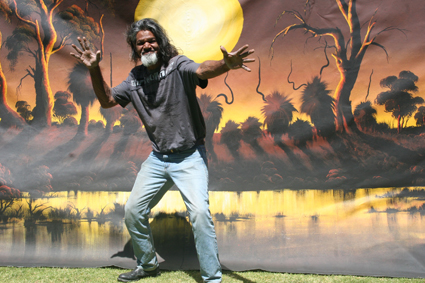
Frank Nannup, Bindjareb Pinjarra
The Seymour Centre Sydney will be home to this year’s National Reconciliation Week with a range of performances, talks and concerts aiming “to raise awareness of the historical and contemporary stories and experiences of the first Australians” (website).
The centerpiece of the week is Bindjareb Pinjarra (presented by Pinjarra Project, Deckchair Theatre and Seymour Centre). In 1994, performers Kelton Pell, Geoff Kelso, Phil Thomson and Pinjarra man Trevor Shorty Parfitt created a performance highlighting the horrific events of the Pinjarra massacre in 1834. It is estimated that up to 150 Bindjareb Nyoongar people were slaughtered (only 21 of whom have been publicly named) during a survey of the Pinjarra area aimed at protecting the rights and property of the white setters. To this day the site is only listed as that of a battle (one white man died falling from his horse) rather than a massacre, nor is it officially named as a significant Aboriginal site. The only memorial so far is a virtual one—www.pinjarramassacresite.com/.
In 2010, Pell, Kelso and Thomson (Parfitt has passed away) regrouped to share the work in oral tradition with three new performers, senior Pinjarra man Frank Nannup, Nyoongar actor Isaac Drandic and Wadjella (white fella) Sam Longley. While the subject matter is dark, the resulting performance is far from grim. In a review of the 2010 show Suzanne Spunner wrote, “The ensemble of six male actors are all agile performers and accomplished improvisers and very funny too, because this play about a massacre is presented as a comedy with a black undercurrent. The humour is always deadly serious. The actors play across age, class and race and play they do so that all the stereotypes are well worked over for comic effect. Its great strength is the depth of story it tells and the quality of the tale tellers.” (RT online exclusive May 24, 2010)
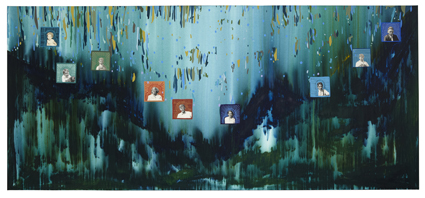
Bronwyn Bancroft, Falling Through Time (2012)
courtesy the artist
Bronwyn Bancroft, Falling Through Time (2012)
Boomalli Aboriginal Artists Co-operative are overseeing the exhibition component of Reconciliation week, titled Winds of Change. It will feature works by a range of prominent Indigenous artists such as Bronwyn Bancroft, Euphemia Bostock, Jenny Fraser, Graham Toomey and Wayne Quillia. The organisation will also hold a charity auction on May 26 at the Boomalli gallery to help raise funds to continue operations. Indigenous and non-indigenous artists are invited to donate artworks, $300 in value, for sale at the event. See http://www.boomalli.com.au/.
NSW Reconciliation Council and All Together Now are opening up a discussion on discrimination with their panel titled “I’m not racist but…” which will see Race Discrimination Commissioner ?Dr. Helen Szoke, Fear of a Brown Planet’s Nazeem Hussain, UN Youth Ambassador Benson Saulo and comedian Jennifer Wong in hot debate hosted by ABC Radio National journalist Steve Cannane. Australian Theatre for Young People will also create a space for discussion around the playmaking process with their a work-in-progress reading of Katherine, a new play by Rachael Coopes and Wayne Blair looking at the life of a teenager in the Top End.
Add to these performances by Casey Donovan in the Sound Lounge and free live music by Marcus Corowa and Jess Beck at the Reconciliation Party and there are plenty opportunities to reflect on Australia’s troubled history as well as celebrate the potential for more positive relations between Indigenous and non-indigenous Australians in the future.
National Reconciliation Week 2012: Pinjarra Project,, May 26-June 2, 10.30am & 7.30pm (Sat May 26 National Sorry Day & Sat June 2 special Community offer – quote the promotional code “COMMUNITY” to receive $8 off ticket price); Casey Donovan, May 30, 8pm; I’m not racist but…, May 31, 7:30pm; ATYP, Katherine, June 1, 1pm & 6.30pm; Reconciliation Party, June 1, 7.30pm; Seymour Centre, Sydney, May 26-June 2; http://sydney.edu.au/seymour/reconciliation/index.shtml
Bindjarb Pinjarra will also be presented at the Campbelltown Arts Centre, May 25, 2pm and 8pm, http://www.campbelltown.nsw.gov.au/BindjarebPinjarra, and in Melbourne by ILBIJERRI Theatre Company and Footscray Community Arts Centre at their Performance Space, June 13 -16; http://footscrayarts.com/calendar/bindjareb-pinjarra/
RealTime issue #108 April-May 2012 pg. web
© RealTime ; for permission to reproduce apply to realtime@realtimearts.net
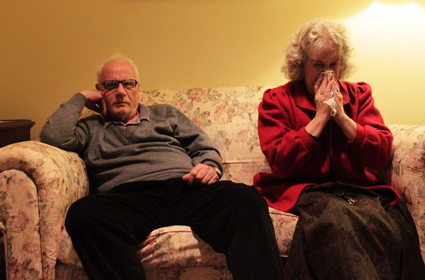
Jim and Linda Batten, Sweet Child of Mine, Bron Batten
courtesy the artists
Jim and Linda Batten, Sweet Child of Mine, Bron Batten
The Tiny Stadiums festival, produced by PACT Centre for Emerging Artists, began its life in 2009 under the guidance of the artist collective Quarterbred. The festival aims to infiltrate the streets of the most village-like of all Sydney suburbs, Erskineville, with gentle live art provocations and curious performance experiences. Now in its fourth year the reins of the festival have been handed over to a new artist curatorium—Amelia Walin, Christopher Hodge and Maria White, operating under the name Groundwork—who are focussing this year’s event around the idea of Centre/Margins and the traversal of such territories.
If you prefer your performances in a theatre there is a double bill at the PACT venue, but the works are far from traditional. Those of us who work at the pointier end of the arts are often faced with the dilemma of explaining what it is we actually do to non-arts types, not least of all our parents. In Sweet Child of Mine, Bron Batten exploits this awkward conversation by inviting her 60-year old parents on stage to discuss with her what might be the point of Bron’s own work, but also art as a whole. The show won Best Experimental Performance Award at the 2011 Melbourne Fringe Festival, and in the YouTube clip looks to be both heartwarming and a little bit heartbreaking.
Well matched with Sweet Child of Mine is Alice William’s Impossible Plays, coming to PACT straight from its Melbourne premier at Next Wave. Williams has interviewed four people about their imaginary lives: “Megan is a quietly spoken vet in Alice Springs. Andy is a poet whose writing treads an uncanny line between fantasy and reality. Douggie is an Arente watercolour artist. Mushi is a tarot card reader who navigates the realms of possibility in search of a sanctuary” (website). These interviews form verbatim texts for performers Amity Yore, Katherine Beckett, Megan Garrett-Jones and Jane Grimley to embody, creating a work that apparently walks a fine line between documentary and dream-like fantasy.
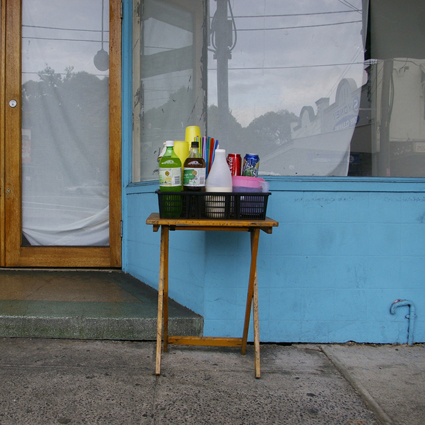
Ngoc Nguyen, Cultural Triangle
courtesy the artists
Ngoc Nguyen, Cultural Triangle
Over the weekend of June 2-3, the action will take to the streets (well mainly Erskineville Road) with a series of interactions, incursions and installations. Occupying one of the mini-parks on the strip will be Tom Hogan’s Monolith, a large metallic object which responds to the viewer, making sweet and, apparently, strangely familiar sounds. Meanwhile, Ngoc Nguyen whose installation [Xuan] Spring was a quiet highlight of Underbelly 2012 (see RT105), will be placing small Vietnamese style street coffee/food stalls around the neighbourhood, exploring ideas of cultural displacement.
If you’re genuinely hungry you can head down to PACT where Penelope Benton and Alexandra Clapham will construct the Tiny Diner, a three-sided stage set of a kitchen, with all elements made of cardboard, except the $2 toastie which is the real deal. And while at PACT you’ll also be able to experience Shamanic Organic, the video work of Robin Hungerford that melds food, plastic and technology into works that “kaleidoscopically implode” (website).
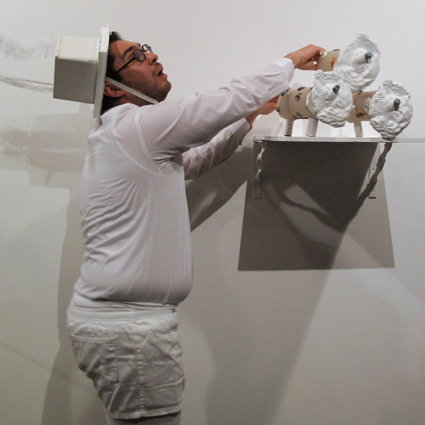
David Capra, New Intercessions
If the psychedelia is making you feel slightly freaky, then maybe it’s best to avoid Fitts & Holderness’ The Speaker, which will be peddling conspiracy theories, attempting to convince passers-by of the evil Project SKIN-EV that is taking place behind closed doors in Erskineville. And while David Capra’s New Intercessions—a dance around streets featuring the laying on of hands and speaking-in-tongues—is aimed at healing the spirit, it sounds potentially more terrifying than whatever The Speaker is promising.
Also aiming for the spiritual dimension is Gibberish and Let Go by Jodie Whalen, extending the one-hour meditation of spiritual Guru Osho to a five-hour durational performance in which the audience is invited to participate or simply watch. But if really all you want to do is have a quiet beverage, over at the Rose Hotel you will be able to experience some of the festival through YOU.DANCE. a video work by Rafaela Pandolfini who will be photographing locals and turning the small grooves of everyday actions into a celebration of our need to boogie.
Tiny Stadiums, PACT Centre for Emerging Artists, and the streets of Erskineville, May 31-June 9; http://www.pact.net.au/category/tiny-stadiums/
RealTime issue #108 April-May 2012 pg. web
© RealTime ; for permission to reproduce apply to realtime@realtimearts.net
screengrab, james cook university
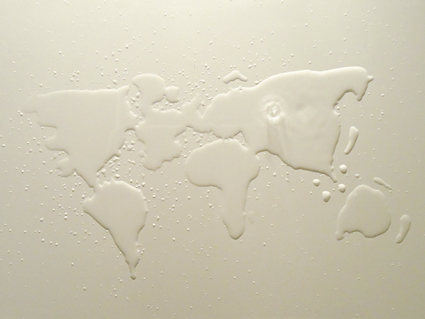
Fluid Network, Rapadura Studio, Winner Screengrab 2010
courtesy the artists
Fluid Network, Rapadura Studio, Winner Screengrab 2010
Now in its fourth year James Cook University’s Screengrab New Media Art Award is open for entries that address the theme of control. All screen-based media are eligible including multi-channel video, digital illustration, audio sculpture, photography, generative media, 2D & 3D animation. This year’s award aims to explore the way in which technology is facilitating change as evidenced by recent political uprisings while at the same time allowing for even more surreptitious levels of control through “surveillance networks, social media, data mining algorithms, privacy interventions, sophisticated image gathering techniques and drone technologies” (website). A selection of works will be exhibited at James Cook University in August with the winning work awarded $5,000. For previous Screengrab exhibitions and awards see RT93 and RT101.
James Cook University, Screengrab New Media Art Award, deadline for applications July 2; exhibition opens Aug 2; http://www.jcu.edu.au/soca/JCU_099817.html
arina.org, nava & crawl inc
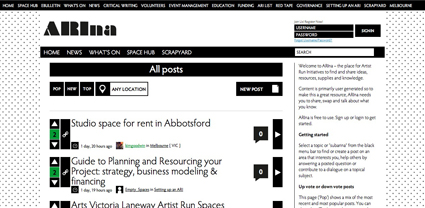
Arina.org
NAVA and Crawl Inc have just launched a new online hub for information about all things ARI. While Crawl is a comprehensive list of ARIs and their activities, ARIna.org is a space for sharing ideas about the actual running of these artist run intiatives. Anyone can contribute and posts can be bumped up and down the list by other users according to interest and perceived importance (like Digg). You’ll find posts ranging from calls for proposals and studios for rent to guides to the intricacies of public liability, working with local councils and governance issues. http://arina.org.au/
dance film masterclass, aftrs open & form dance projects
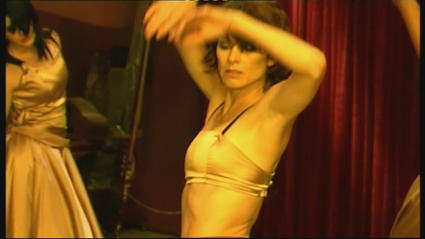
Linda Ridgway, Thursday’s Fictions
photo Simon Chapman © 2006 Physical TV
Linda Ridgway, Thursday’s Fictions
Western Sydney Dance organisation FORM has teamed up with the AFTRS Open program to present a dance film masterclass. The weekend will be run by Dr Richard James Allen, co-director (with Karen Pearlman) of the Physical TV Company, responsible for works such as the feature Thursday’s Fiction (see RT80) and Entanglement Theory (see RT99). The masterclass, which is open to choreographers, dancers and filmmakers, will explore the history of dance films along with particular sub-genres and will also allow for practical exercises in the AFTRS studio with dancers. Form is also
AFTRS Open & FORM Dance Projects, Dance Film Masterclass with Dr Richard James Allen, AFTRS, Sydney, July 28-29, 9-5pm, $495, $445.50 early bird booking by June 30; http://form.org.au/2012/03/dance-film-project/. FORM Dance Projects is offering one scholarship to a masterclass participant who is an emerging independent choreographer or performer. For more information email director@form.org.au
speaking in tongues, yppa national symposium
Young People and the Arts Australia (YPAA) will be presenting their national symposium at the Casula Powerhouse in July. Speaking in Tongues seeks to establish a common language around the multi-faceted manifestations of youth arts and the arts in general. The symposium will bring together a range of keynote speakers such as Sue Giles, artistic director of Polyglot Theatre; Baba Israel (in telepresent form) from Contact Manchester, a leading UK youth arts organisation; Colin Pidd from btli international, a global consultancy firm teaching strategy implementation and leadership development; and Suzanne Lebeau, playwright and theatre maker from Quebec’s Le Carrousel who will also be running a masterclass.
Other hightlights will include the unveiling of the findings from TheatreSpace, a four-year research project looking at young people’s responses to professionally-funded theatre in Melbourne, Sydney and Brisbane. Also on exhibition will be Ruth Sancho’s ambitious TRIP – T(L)ICS, Digital Interactive Poetry Installation exploring how language shapes our world and identity by focusing on poetry in Spanish, English, Catalan, Kari’ña (Venezuela), Mapudungun (Chile), Nahuatl (Mexico), Guaraní (Argentina, Brazil, Bolivia, and Paraguay), Maltés (Malta) and Yanyuwa (Northern Territory).
YPAA National Symposium, Speaking in Tongues – How do we translate the collective language of the Arts?; Casula Powerhouse Arts Centre, July 11-13; http://ypaa.net/program-2012/national-symposium/, earlybird bookings by May 23
because we care, colin, simon and i
In the time that New Zealand dancer Simon Ellis spent in Australia he made a quiet but distinctive impact on the dance scene. His 2006 performance Inert was for an audience of two strapped into reclining beds to experience the intimate dance and video work with a lessened sense of gravity (see RT73). About Ellis’ 2003 performance Indelible Jonathan Marshall wrote: “Ellis produces something closer to a mnemonic auto-da-fé…With only the barest temporal and emotional rises, Ellis creates a sense of an increasing trajectory of shattering and division.” (RT54).
Now based in the UK Ellis has been collaborating with Colin Poole as the duo Colin, Simon and I. They’ve recently been commissioned by The Place, London to create the work Because We Care, which explores the ways men relate, in particular exploring their own collaborative relationship. For a preview see their video promo.
Colin, Simon and I, Because We Care, The Place London, June 8 & 9; http://www.colinsimonandi.com/
congratulations
The first batch of Creative Australia Fellows has been announced which sees Gaelle Mellis, Mic Gruchy, Guy Ben-Ary, Antony Hamilton and Cat Jones awarded the Established Artist Fellowships receiving $100,000 over one year and Matthew Prest, Lauren Brincat, Gian Slater, Lee Serle, Annabel Smith and Michaela Gleave awarded Emerging Artist Fellowships of $60,000 over two years. http://www.australiacouncil.gov.au/grants/creative_australia_artists_grants
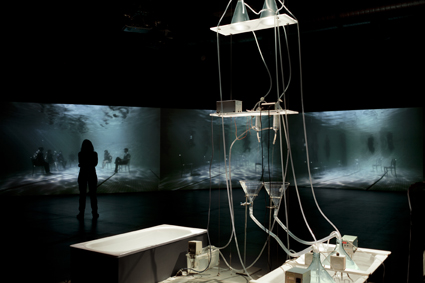
Peta Clancy and Helen Pynor, The Body is a Big Place, (2011), installation view, 5-channel video projection, heart perfusion device
photo courtesy the artists
Peta Clancy and Helen Pynor, The Body is a Big Place, (2011), installation view, 5-channel video projection, heart perfusion device
The prestigious Prix Ars awards, part of the Austrian-based media arts festival Ars Electronica, have also been announced with three Australian groups receiving attention. Van Sowerwine and Isabelle Knowles (working with Matt Gingold) were given an Award of Distinction in the Interactive Art category for It’s a jungle in here (reviewed in RT108); while Peta Clancy & Helen Pynor’s The Body is a Big Place (reviewed in RT107) and Prue Lang’s sustainable dance performance Un réseau translucide both received Honorary Mentions in the Hybrid Art Category. http://www.aec.at/prix/en/gewinner/
RealTime issue #108 April-May 2012 pg. web
© RealTime ; for permission to reproduce apply to realtime@realtimearts.net
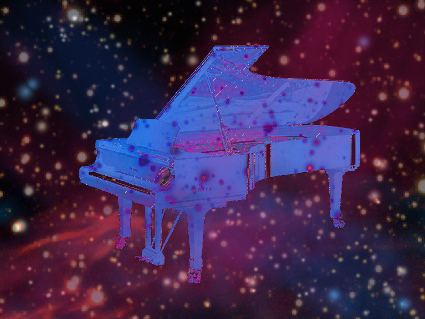 THE UNIVERSITY OF NEWCASTLE’S INTERNATIONAL SPACE TIME CONCERTO COMPETITION IS UPDATING ONE OF THE WORLD’S MOST PERSISTENTLY EXCITING MUSICAL GENRES FOR THE 21ST CENTURY.
THE UNIVERSITY OF NEWCASTLE’S INTERNATIONAL SPACE TIME CONCERTO COMPETITION IS UPDATING ONE OF THE WORLD’S MOST PERSISTENTLY EXCITING MUSICAL GENRES FOR THE 21ST CENTURY.
“The concerto has always been the testing-ground of virtuosity,” explains Richard Vella, mastermind of the competition and Head of Drama, Fine Art and Music at the University of Newcastle. “But there is this idea that standards go down the moment you move away from classical music, which is simply not true. We want to revive the form by bringing back the improvisational aspect of the concerto and asking what a contemporary concerto would look like.”
The application process is simple: university students of all levels can upload an audition video or showreel on YouTube by July 1 and fill out the online entry form. The competition’s rules are slightly less so. Solo or collaborating performers, composers, producers, and A/V artists may enter one of six “historical” or “innovative” categories to share in a prize pool of $50,000 and perform at the finalist concerts in Newcastle with telematic collaboration from Ars Electronica in Austria, the Yong Siew Toh Conservatory of Music in Singapore, the Central Conservatory of Music in China and Waikato University in New Zealand.
Vella sees the relationship between the concerto and the spaces in which it has resonated as central to the competition’s historical categories “Baroque (1600–1750),” “Classical/Romantic (1750–1900)” and “Modern/Postmodern (1900–1990s).” As well as representing a musical repertoire and a relationship to space, the categories also reflect different modes of interaction between performers and audience members.
Born from the opera overture, the baroque concerto roused audiences by “concerting” solo and small groups of instruments against the opera orchestra. The soloist would virtuosically bait and antagonise the orchestra with a spirit of improvisation that fed on the audience’s reaction. Musicologist Richard Taruskin suggests, “One doesn’t have to work hard to imagine such a thing; any rock video will provide a living example.” Audience interaction was no doubt encouraged by the fact that musicians and audiences were usually on the same level of ground as each other, either in front of theatre stages, in churches (where one wonders whether they stamped and clapped so enthusiastically) or the concert rooms of palaces.
If the baroque period was the concerto’s wild youth, then the classical era saw the form ossified into a set of widely understood performance conventions. Having composed over 300 of the things for Frederick the Great, Johann Joachim Quantz enumerated the essential elements of the late baroque concerto grosso as “numerous accompanying players, a large place, a serious performance and a moderate tempo.” That Quantz listed the physical surroundings and performance style of the concerto alongside its formal properties shows the importance of cultural and physical space to music in 1752 Sans Souci (that’s “No Worries,” the palace after which the Southern suburb of Sydney was named).
The classical and romantic eras saw the birth of paid public music performances and the image we now come to associate with the genre: a soloist on a stage in front of an orchestra. Beyond the partition of the proscenium arch it is said that a wall of respect for the works they played—and no longer improvised—separated performers and listeners, that people partitioned their outer and inner worlds while listening.
In the 20th century audiences and performers were further partitioned within modifiable concert halls with different distributions of players. For generations weaned on broadcast media it is said that performing and listening became further alienated and individualistic. While a solo performer may choose to perform a work from one of these periods (in the competition's “Historical” section), they may alternatively bring the work’s fascinating history into the present, combine it with contemporary musical forces or completely reinvent the spirit of the concerto within one of the competitions three “Innovation” categories.
Inspired by a trip to Austria’s peak arts and technology R&D centre Ars Electronica last year, Vella challenges young composers to develop new horizons for this ever-relevant art form. “The rise of the personal computer in music-making over the past 20 years has provided different creative opportunities. What is needed is a perspective that is historical, but also looks forward to creating the future.” Groups of performers, composers, producers and A/V artists can get together and enter either the “Remix/Recontextualisation,” “New Modes of Presentation,” or “Networked Music Performance” categories.
The Remix/Recontexualisation category invites groups to engage with historical works through sampling or quotation. The orchestral part can be remixed (though it will eventually be played by a live orchestra) and you can even compose a completely different solo part!
In the New Modes of Presentation section you can think about the long history of the concerto and find new ways of presenting it. Extend the orchestra with popular, world and jazz instrumentation; use synthesisers and live signal processing; or use real-time kinetic or visual interfaces.
With tertiary educational institutions all over the world building video conferencing suites it is easy to connect several orchestras with high fidelity A/V in real time. While not providing great new sonic possibilities, telematic streaming provides a logical progression in the relationship of the concerto to space and the gaze of the audience. So, while you’re practicing your Handel, why not consider entering the Networked Music Performance category to be accompanied by the International Telematic Ensemble drawn from the competition’s five partner institutions?
The International Space Time Concerto Competition invites us to decentre our idea of the concerto from a repertory of works tied to a set of performance conventions encompassing history, space, performers and audiences. When viewed in this way “the concerto” becomes an immensely enticing sandbox of contemporary possibilities.
The International Space Time Concerto Competition, University of Newcastle, Australia; entry deadline July 1; http://spacetimeconcerto.com/; finals will be held Nov 30 and Dec 2
RealTime issue #108 April-May 2012 pg. web
© Matthew Lorenzon; for permission to reproduce apply to realtime@realtimearts.net
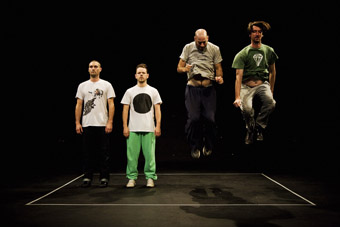
Byron Perry, Antony Hamilton, Simon Obarzanek, Ross Coulter, Untrained, Lucy Guerin Inc
photo by Untrained Artist
Byron Perry, Antony Hamilton, Simon Obarzanek, Ross Coulter, Untrained, Lucy Guerin Inc
lucy guerin inc’s untrained
Lucy Guerin Inc’s successful show Untrained has already charmed audiences around Australia and in Hong Kong. The show is scheduled to tour the US in November and the company is looking for two new untrained men to become part of the show. Males over 18 with no dance experience (and no criminal record, for visa purposes) are eligible to apply.
Applications close 5pm, May 14; auditions May 26, 10–1pm; http://www.lucyguerininc.com
international space time concerto competition
Australia’s University of Newcastle has announced the inaugural The International Space Time Concerto Competition encouraging artists to explore the concerto both from an historical but also contemporary perspective looking for innovation within the form. Also involved are the Yong Siew Toh Conservatory of Music in Singapore, Central Conservatory of Music in Beijing, Waikato University in New Zealand and Ars Electronica in Austria and entries are encouraged from virtuoso classical instrumentalists, orchestral players, jazz, contemporary bands, electronic and new media artists. The pool of prize money is $50,000 (sponsored by benefactor Jennie Thomas and the Friends of the University). Six finalists will be chosen to perform with orchestra at the Newcastle Conservatorium of Music Concert Hall in late 2012 with another two finalists performing with an ensemble linked across five countries via the internet.
Entries close July 1, www.spacetimeconcerto.com
access space uk residencies
Access Space is an open digital arts lab in Sheffield, UK. With an emphasis on sustainability the lab runs on recycled computers and open source software and systems. Access Space is calling for applications for Artist Residencies which will utilise its Refab Space, a DIY fabrication studio including tools such as 3D printer, laser cutter, CNC router, Arduino and an embroidery machine. Applications are sought for one residency in July and three residencies from September 4 to December 15. Residencies are for 15 working days and successful applicants receive a fee of £1500 (approx AUS$2,300), self-catering accommodation, a small budget for materials and a small contribution towards travel.
Applications close for July residency May 16 and Autumn residencies June 18; http://www.access-space.org/arts/Refab_Residency_Call.htm
realise your dream
If you need help getting to UK there’s The British Council’s Realise your Dream program, funding artists in their first 10 years of practice to travel to the UK and undertake a tailored professional development program devised in consultation with the Council. Applications are open to people working in any industry “where creativity plays an important role” (website). The award offers $10,000 plus airfare.
Applications close June 3, 2012; http://artsfrontier.britishcouncil.org.au/?cat=4
vagrant, new weird australia
New Weird Australia is currently offering small grants (up to $750) for artists to curate and produce an event for New Weird’s open source gig series. The events will take place under the moniker of Vagrant, with NWA providing promotion. Applicants must share the organisation’s eclectic and experimental sensibility, but the style and responsibility for production of gigs is entirely up to recipients. Funding is for artist fees, travel, marketing and production costs with a stipulation that “artists are not out of pocket” (website). Events can take place anywhere in Australia before July 30.
Applications close May 14; http://newweirdaustralia.com
kit denton disfellowship
The 2012 Kit Denton Disfellowship, named after Andrew Denton’s father, a respected writer, is now in its sixth year, however it’s been re-titled a “disfellowship” to encourage “subversive ideas” which the press release suggests might mean that “your nan disowns you, your neighbours shun you and the shock jocks call for you to be locked up.” The aim is to “find ideas of substance, intelligence and purpose that will take viewers outside their comfort zone and challenge the status quo” (press release). This year it is run by the Australian Writers’ Foundation and Cordell Jigsaw Zapruders, the privately owned television company that is responsible for shows such as Go Back to Where You Came From, The Gruen Transfer and Enough Rope, as well as the upcoming Dumb, Drunk and Racist. The fellowship offers a grant of $30,000 to script the idea for screen production.
Applications close May 25, http://awg.com.au/index.php?option=com_content&view=article&id=383&Itemid=509
RealTime issue #108 April-May 2012 pg. web
© RealTime ; for permission to reproduce apply to realtime@realtimearts.net
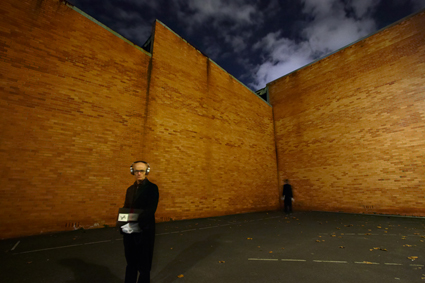
Fuguestate, Jason Maling & Joseph Giovinazzo
photo tmphoto.co
Fuguestate, Jason Maling & Joseph Giovinazzo
HAVING LIVED IN THE MELBOURNE SUBURB OF COLLINGWOOD FOR ALMOST A LIFETIME, I AM SUBCONSCIOUSLY AWARE THAT FUGUESTATE WILL BE PERFORMED ON GIPPS STREET AT THE UNITED MASONIC TEMPLE.
A woman wearing a ritualistic tailcoat greets me at the entrance. Together, we step through a hall and enter an antechamber. Black and white photographs from the early 20th century occupy measured space on tar-stained walls. But the equilibrium of ancient imagery is sabotaged by the inclusion of several closed circuit screens. A Dali-esque clock appears on one screen, and intermittent shadows across its face betray the presence of others passing through some hidden mausoleum.
A man approaches me as if he has known me all my life. He invites me to sit at a table that might have been constructed purely for letter writing. He disappears, then returns with a glass of port and a sheet of paper that details the widely reported 2005 discovery of ‘The Piano Man.’ I read on, hoping the liquor provided will fortify me against this tale of a fellow found wandering along a road on the English Isle of Sheppey.
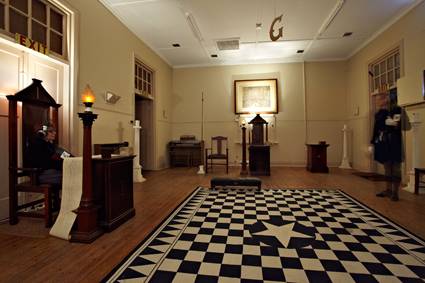
Fuguestate, Jason Maling & Joseph Giovinazzo
photo tmphoto.co
Fuguestate, Jason Maling & Joseph Giovinazzo
The port achieves its stated aim and lodges an ember in my belly. But this report of a speechless man who, when provided with a piano played melancholy versions of Swan Lake, disturbs my thinking. Is it a media myth or an actual case of a gifted person requiring treatment for a personality disorder? It is impossible to tell, but the cynic within conspires toward the circus surrounding Australian pianist David Helfgott. Some employed in the media will do anything to make a buck. Then again, adopting the role of urban mythographer is preferable to hacking the phone of a murdered English teenager.
Then I too am fitted out in tailcoat, white gloves and a set of headphones jacked into a book with an esoteric sign embossed on its cover. The aforementioned man opens a door and invites me to explore a hidden recess. Inside, empty chairs placed in methodical rows remain attentive before a decrepit portrait of Queen Elizabeth II. There are others inside this ballroom, also wearing tailcoats, gloves and headphones. We wander together, as if condemned to immolate within a purgatory bereft of defining terms.
I exit this room and enter another. It’s a kitchen and I do declare that the multitude of cucumber sandwiches once prepared across its steel benches are present in spirit, if not vanquished by time and hungry Freemasonry. Emanating from my earphones is what I believe to be an atonal composition that competes with itself in the attainment of some transcendental plane. It’s a fugue, of course; and the title of this performance thumps between my ears as I now believe myself to be in composition with a world that previously had been limited to subtle winks and shifty handshakes.
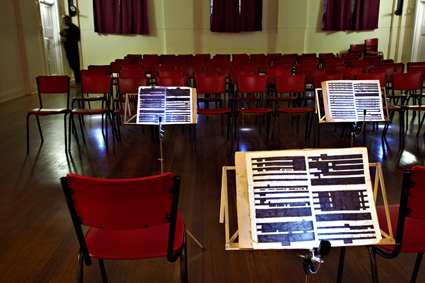
Fuguestate, Jason Maling & Joseph Giovinazzo
photo tmphoto.co
Fuguestate, Jason Maling & Joseph Giovinazzo
I venture further, into a dusty hollow. There, again, is another man who has known me all my life. This time, he takes the shape of a decaying skeleton resting inside a miniature coffin. The detail is remarkable, but so is the magic of human deception. In fugue with life as in death, we compete with ourselves in defiance of some final retribution. Our time will come, my friends, and in the end there will be nothing but the sad monument of death illuminating a lifetime of wasted dreams.
Fuguestate, conceptual realisation Jason Mailing, Joseph Giovinazzo,
drawing, photography, production design Jason Mailing,
musical composition, audio technology Cake Industries (Jesse Stevens & Dean Petersen), production Joseph Giovinazzo, producer Ann Schoo, book construction Gene Hedley, Cake Industries, United Masonic Temple, Melbourne, April 16-29; http://www.fuguestate.info/
This article originally appeared as part of RealTime’s online e-dition May 8
RealTime issue #109 June-July 2012 pg. 28
© Tony Reck; for permission to reproduce apply to realtime@realtimearts.net
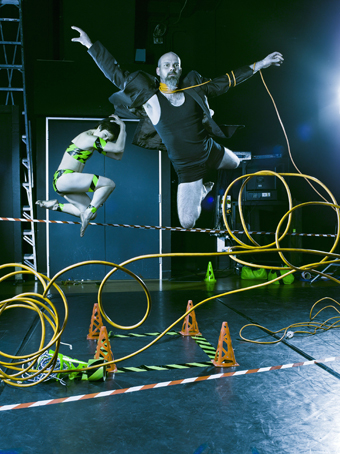
Involuntary, One Point 618
photo Chris Herzfeld
Involuntary, One Point 618
CHOREOGRAPHER AND DIRECTOR KATRINA LAZAROFF’S FIRST WORK WITH THE INDEPENDENT DANCE COMPANY ONE POINT 618, POMONA ROAD, PREMIERED AT THE ADELAIDE FESTIVAL CENTRE IN 2010 AND WAS NOMINATED FOR OUTSTANDING ACHIEVEMENT IN CONTEMPORARY DANCE AT THE 2011 AUSTRALIAN DANCE AWARDS (SEE RT97)
One Point 618’s latest work, Involuntary, began development almost as soon as Pomona Road had closed, and will again be premiering with the support of the Adelaide Festival Centre. With Involuntary, Lazaroff wants to take a humorous look at the unconscious motions we go through in our lives, and in particular, how technology influences them.
“The idea for Involuntary came from [observing] my mother-in-law watching football. She was jolting around…unconscious of her own movement, because she was so involved,” says Lazaroff. “That sort of involuntary action and [its] sporadic nature really interested me. I thought there is something comic in this: it’s unconscious but [has] a driven focus.”
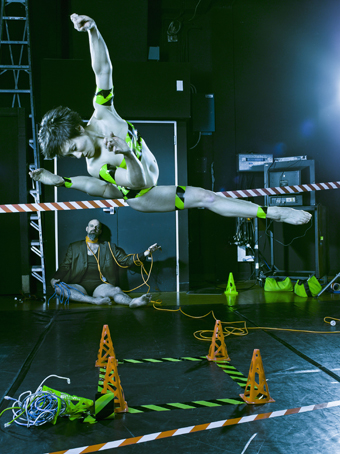
Involuntary, One Point 618
photo Chris Herzfeld
Involuntary, One Point 618
Also observing spontaneous movement in her then 14-week-old daughter, Lazaroff began to draw parallels between this unconscious physical movement and other “unconscious behaviour in society.” Lazaroff says: “We often go along with things without much thought, because it’s required of us…I think with the evolution of technology and [its] systemisations…we don’t really have time to question very much…We make choices as we go, unsure of the implications.” Lazaroff says Involuntary “has become a satire…a humorous look at how at times we follow blindly.”
A concern throughout the development process was making a dance theatre work about technology in a world where it is rapidly evolving. “Because technology keeps advancing so fast, people keep bringing new ideas to me and I keep getting new ideas, [but] I’ve tried to steer away from [actually using] technology.” Lazaroff says that during development “we focused a lot on technological sound and vision, but to me that was already out of date: it had been seen 10 or 15 years ago in works by Chunky Move and other companies.”
The result has been a toning down of the work’s ‘cyber’ elements by video designer Nic Mollison and sound designer Sascha Budimski. “It’s more about the influence of systems and procedures, programs and information technology rather than trying to represent technology on stage. I’ve tried to strip it back and get a bit more human with it.”
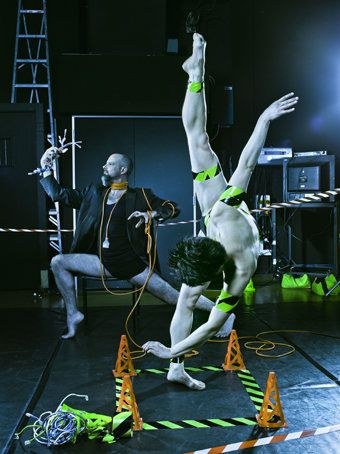
Involuntary, One Point 618
photo Chris Herzfeld
Involuntary, One Point 618
Originally from Adelaide, most of Lazaroff has spent most of her dance career in Perth, working with Buzz Dance Theatre and small independent companies. She is excited by the opportunity of having a second work presented by the Adelaide Festival Centre on this scale as she sees it as contributing to potential national understanding and recognition of her work. “Sometimes making work in Adelaide and Perth is quite isolating. The eastern states are a bit disconnected from the artists who work in these places.” After Adelaide, Involuntary will be presented at the National Regional Arts Conference in Goolwa (SA) in October, and after that Lazaroff hopes to take it interstate.
While the Involuntary incorporates ideas about technology, systemisation and unconscious actions, for Katrina Lazaroff the work is primarily “a culmination of all of my passions and thoughts and feelings. Not just the technical side of being a dancer, creator or choreographer, but bringing together the whole picture of how I think, how I feel as an artist…It brings together all the hard work I do everywhere else in order to survive…the joy but also the hardship of making a work.”
One Point 618 & Adelaide Festival Centre, Involuntary, director choreographer Katrina Lazaroff, performers Ninian Donald, Timothy Rodgers, Veronica Shum, Jessica Statton, video, lighting Nic Mollison, sound design Sascha Budimski, set design Nic Mollison, Richard Seidel, Katrina Lazaroff, consultants Catherine Fitzgerald, Richard Seidel, Roz Hervey, Space Theatre, Adelaide Festival Centre, May 1-5; http://www.adelaidefestivalcentre.com.au
RealTime issue #108 April-May 2012 pg. web
© Jane Howard; for permission to reproduce apply to realtime@realtimearts.net
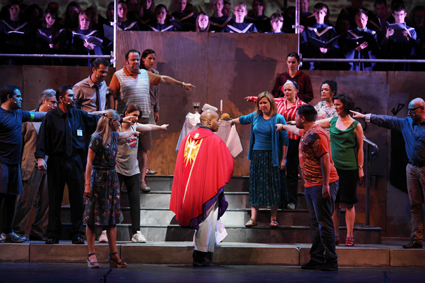
Leonard Bernstein’s Mass, 2012 International Arts Adelaide Festival
photo Tony Lewis
Leonard Bernstein’s Mass, 2012 International Arts Adelaide Festival
FOUR ADELAIDE FESTIVAL CONCERTS SPANNED AN EXTRAORDINARY RANGE OF APPROACHES TO MUSIC AND, ESPECIALLY, THE USE OF SPACE. WHILE LEONARD BERNSTEIN’S MASS USES THE AUDITORIUM IN THE TRADITIONAL MANNER, THE ZEPHYR QUARTET PERFORMANCE INTRUDES INTO THE AUDIENCE, RICHARD CHEW INCARCERATES HIS AUDIENCE AND PAUL GRABOWSKY, ANTONY PATERAS AND THE AUSTRALIAN ART ORCHESTRA IMMERSE THEIRS.
leonard bernstein’s mass
In 1971, legendary US conductor and composer Leonard Bernstein responded to Jackie Kennedy’s commission to write a work celebrating the opening of the Kennedy Centre and marking a decade since the President’s assassination, with Mass. It’s a unique composition that acknowledges the Kennedys’ Catholicism, reveals Bernstein’s interest in both theological and political issues and addresses the ultimate question of faith in an absurd world.
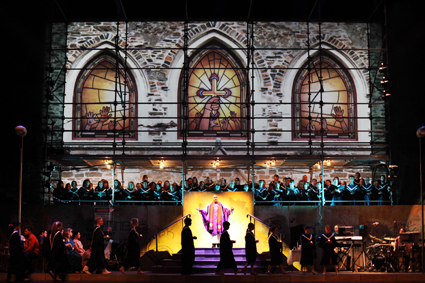
Leonard Bernsteins’ Mass, 2012 International Arts Adelaide Festival
photo Tony Lewis
Leonard Bernsteins’ Mass, 2012 International Arts Adelaide Festival
Mass combines music theatre and dance with a traditional Catholic mass and the social and philosophical issues Bernstein raised remain relevant 40 years after the controversial work’s premiere. Set in the street and presenting the Catholic mass as concept, rite and musical form for consideration rather than for participation, Mass critiques organised religion and the Vietnam War and includes readings from letters by imprisoned draft evaders. Blending orchestra, rock band, singers, dancers, actors and multiple choirs, including children, into a cross-media mix, it implicitly proposes a cross-community bridge and captures the 1960s Zeitgeist. Its experimental nature—at the time, rock and classical music were engaged in a cold war that epitomised the conflict between establishment and counterculture—defies musical categorisation, as it links particular musical styles to specific characters or elements of the plot.
Mass is an interesting choice as an Adelaide Festival flagship, combining large-scale performance, experimentation (not uniformly well received at the time) and a recapitulation of issues relating to faith, the Catholic Church and political protest. The performance by the Adelaide Symphony Orchestra, soloists and choirs under Kristian Järvi was excellent and Jubilant Sykes was outstanding in the pivotal role of the Celebrant who experiences his own crisis of faith precipitated by his parishioners’ alienation, before a child’s strength of belief finally triggers a Kierkegaardian leap of faith amongst the crowd.
richard chew’s instructions for an imaginary man
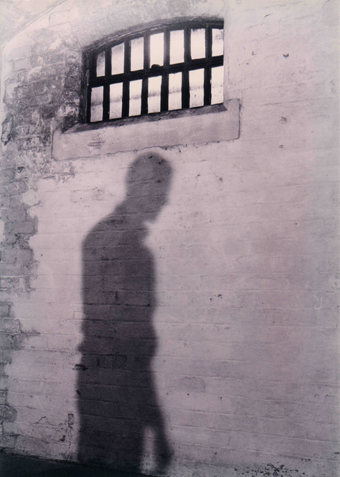
Instructions for an Imaginary Man
courtesy the artists
Instructions for an Imaginary Man
In 1943, Polish writer and resistance member Jerzy Ficowski wrote, “It was exactly eleven/ steps from wall to wall/ in the Pawiak prison/ from to from to/ wall wall wall wall/ and eleven and back again.” Adelaide composer Richard Chew’s Instructions for an Imaginary Man muses on the experience of prison, and questions the nature and impact of imprisonment and its relationship to structures of power and control.
Instructions for an Imaginary Man takes place in the long-disused Old Adelaide Gaol, in a corridor accessing rows of cells, with a scrim separating the audience from the performance area that represents a cell, and with the musicians positioned behind a second scrim at the far end of the corridor. Videos of cell interiors and an actor-prisoner are projected onto the scrims as the performance progresses. The same actor mimes imprisonment, depicting the loneliness and mental breakdown associated with confinement, forcing the audience to remember the gaol’s former uses. Chew set the poetry of Verlaine, Behan, Rilke and others, including political prisoners and former hostages, to his own music, which is for soprano and baritone accompanied by piano, strings and clarinet. Fine performances and clever design make this a strong work. Staging theatrical and musical events in disused prisons is not new, but in this case is highly evocative
australian art orchestra’s miles davis, prince of darkness
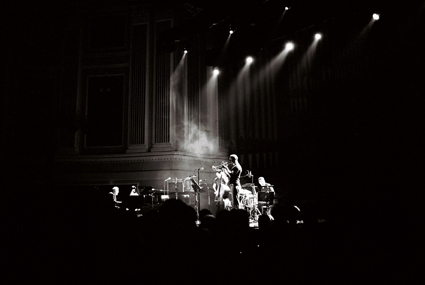
Australian Art Orchestra
courtesy the artists
Australian Art Orchestra
Musically, the Australian Art Orchestra’s concert Miles Davis, Prince of Darkness, was the festival standout. A tribute to jazz trumpeter Davis (1926-1991), the AAO concert runs chronologically: the first half commences with selections from Birth of the Cool (1948-9) progressing to Gil Evans’ arrangement for Davis of the second movement of Rodrigo’s Concierto de Aranjuez (1961) in which Davis’ trumpet took the guitar role; followed by festival director and AAO leader Paul Grabowsky’s arrangement of Davis’ Black Comedy (1968). Trumpeter Phillip Slater is wonderful in the Concierto. Superbly arranged, these performances render the quintessential Davis style through the AAO’s distinctive sound and approach.
But it was the second half of this concert that really got things moving with Anthony Pateras’ high energy Ontetradecagon. Knowing that Davis’ late work, particularly his On the Corner album (1972) was influenced by Karlheinz Stockhausen, Pateras pays homage to the experimentalism of both Davis and Stockhausen by exploring the conjunction of jazz improvisation and experimental music. AAO members were located in six groups around the auditorium—on stage, on either side, at the back and on the balcony—with Pateras strategically positioning himself in the centre aisle facing the stage. Pateras uses a Revox B77 to replay fragments of On the Corner and process elements of the live performance, while the AAO play from Pateras’ score which is orchestrated from On the Corner pitch elements and structured to allow improvisation. The spatialisation immerses the listener—I felt as if I were inside Davis’ and Stockhausen’s minds simultaneously. Paradoxically, the absence of a driving jazz rhythm brings out the ethereal feel of Davis’, as well as Stockhausen’s music. Ontetradecagon extends the language of both composers into multiple, layered ensemble playing, and in the program notes, Pateras acknowledges Varèse, Xenakis and Luigi Nono in the concept.
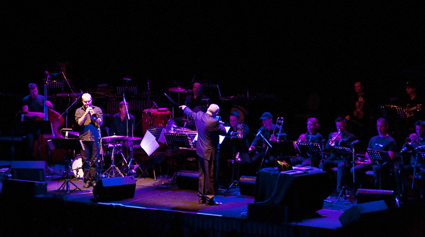
Australian Art Orchestra
photo Tobias Titz
Australian Art Orchestra
As David Toop notes in Ocean of Sound (Serpent’s Tail, London, 1995), record producer Teo Macero mixed Miles Davis’ late albums from long recordings of live takes, and a different mix would have produced a different result, the composition in effect emerging from the mixing. Remixing Davis is thus not only appropriate but anticipated, with Pateras now the producer. At various moments, both trumpeter Scott Tinkler and Pateras appear to be conducting, and the scattered AAO ensembles cohere into a tightly unified whole. Pateras adroitly adds sound samples from the onstage trio of Erkki Veltheim (electric violin), Vanessa Tomlinson (percussion) and Tinkler. Tinkler’s dazzling trumpet solo quotes characteristic Davis motifs, though Ontetradecagon is more about Davis’ musical exploration and development than his own trumpet playing. It’s especially about saturating the audience in challenging sound.
The final piece in the AAO concert was a fabulous reworking of Davis’ Black Satin by AAO bassist Philip Rex, who for this piece performed at a laptop. Black Satin is also from the 1972 On the Corner sessions, and this rendition updates Black Satin’s eclectic, danceable drum ’n’ bass flavour to incorporate today’s electronics and club style. A mirror ball above our heads completes the ambience! This AAO concert was a knockout, and Grabowsky’s program essay is insightful, reinterpreting Miles Davis’ work to confirm and extend its innovations.
zephyr string quartet’s MICROMacro
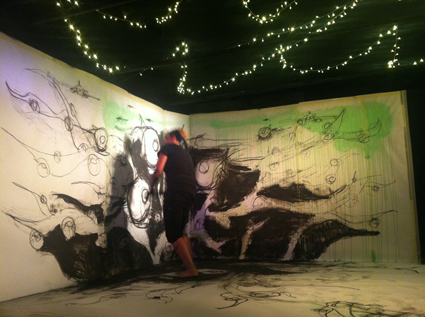
Jo Kerlogue, MICROMacro, Zephyr Quartet
photo Belinda Humphris
Jo Kerlogue, MICROMacro, Zephyr Quartet
In the Adelaide Fringe, at a pub noted as a folk and blues venue, Adelaide’s Zephyr string quartet gave us MICROMacro, in which they performed their own compositions while artist Jo Kerlogue painted on the freshly paper-covered walls and floor and even a table in the auditorium. Zephyr and Kerlogue look for synthesis between notated music and spontaneous art—an emerging trend combining music with visual art as performance, a form of visual improv where the artists’ creative flow is nakedly exposed. Periodically, the musicians would change position in front of audience tables, though the sound source, the PA, remained fixed, creating a feeling of disembodiment and teasing the listener’s sense of how vision and sound combine.
shifting musical spaces
There are four different concepts of theatre at work in these festival works. Chew’s choice of location especially charges his work and provides its foundation. Musical languages are combined and redeveloped and there are contrasting approaches to improvisation. Of the same era as Bernstein’s Mass, Miles Davis’ On the Corner is taken in new directions by Grabowsky, Pateras and Rex. Chew and Bernstein critically address social issues, particularly political imprisonment, and the power of their works derives partly from the essential nature of human speech. While Zephyr shows how visual art might respond to music, Pateras addresses the raw power of sound through its sonic references, timbres, textures and performance, and the music of Bernstein and Chew seeks out the soul. These performances collectively show how music engages the mind, heart and body simultaneously.
2012 Adelaide International Arts Festival: MASS, Leonard Bernstein, Adelaide Symphony Orchestra conductor Kristjan Järvi, director Andy Packer, chorus director Carl Crossin, scenic designer Geoff Cobham, lighting designer Mark Pennington, featuring Jubilant Sykes, Absolute Trio, Adelaide Festival Chorus and Children’s Choir, State Opera of South Australia in association with Adelaide Festival Centre, March 10; Instructions for an Imaginary Man, composer, Richard Chew, mezzo soprano Cheryl Pickering, baritone Nigel Cliffe, actor Graeme Rose, pianist Richard Chew, violins Jacqui Carias and Laura Evans, viola Teagan Short, cello Jillian Visser, clarinets Alexander Loakin, producer Cheryl Pickering for Various People, designer Bec Francis, lighting, projection Nic Mollison, Old Adelaide Gaol, March 9; Australian Art Orchestra, Miles Davis, Prince of Darkness, led by Paul Grabowsky, composer Anthony Pateras, arrangements Eugene Ball, Paul Grabowsky, Philip Rex, Adelaide Town Hall, March 15 http://www.adelaidefestival.com.au/
Adelaide Fringe: Zephyr Quartet and Jo Kerlogue, MICROMacro, Wheatsheaf Hotel, February 25; www.adelaidefringe.com.au; http://www.zephyrquartet.com/
This article originally appeared as part of RealTime’s online e-dition April 24
RealTime issue #109 June-July 2012 pg. 12
© Chris Reid; for permission to reproduce apply to realtime@realtimearts.net
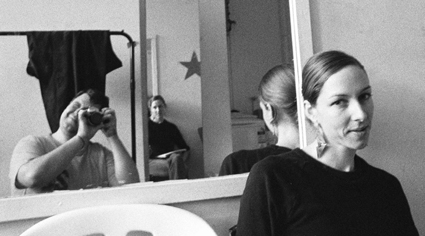
Tanja Liedtke & Julian Crotti, Life in Movement
photo Julian Crotti
Tanja Liedtke & Julian Crotti, Life in Movement
LIFE IN MOVEMENT IS A DOCUMENTARY DIRECTED BY BRYAN MASON AND SOPHIE HYDE ABOUT THE SHORT LIFE AND TRAGIC DEATH IN A ROAD ACCIDENT OF CHOREOGRAPHER/DANCER TANJA LIEDTKE, ON THE EVE OF TAKING UP THE DIRECTORSHIP OF SYDNEY DANCE COMPANY (OBITUARY, RT81).
Let’s get the accident out of the way, as the film does. In one of the filmmakers’ clever moves they place news coverage of Liedtke’s death up front, within the first few minutes, telling us that yes, it is a film about this event, but also signalling that it is not their story’s eventual revelation or end.
The tragedy of an exceptional and promising life cut short is clear, and this aspect of the documentary has been widely reviewed in the mainstream media in response to the film’s award-winning run through last year’s film festivals and subsequent cinema release. (Eleven official selections and awards are listed on the film’s website, including Sydney Film Festival’s Australian Documentary Prize and both jury and audience awards at Cinedans.) But beyond this narrative journey about the life and creative impulse of Liedtke herself, Life in Movement paints a portrait as much about a close group of friends and collaborators coming to terms with their loss.
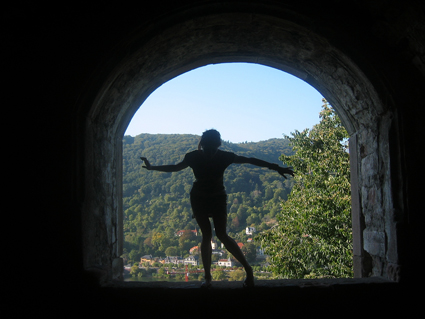
Tanja Liedtke, Silhouette Falling (archival), Life in Movement Life
photo Solon Ulbrich
Tanja Liedtke, Silhouette Falling (archival), Life in Movement Life
Filmically, editor Bryan Mason deftly stitches together footage from a range of different sources, skipping back and forth in time and across formats and aspect ratios. There is material shot by him in rehearsal and performance of Liedtke’s two full-length dance works, Twelfth Floor and Construct, in anticipation of their individual premieres (Mason had been contracted by Liedtke to film both productions) and in remounted international tours after Liedtke’s death. There is an abundance of interviews with partner Solon Ulbrich, dancers Kristina Chan, Paul White, Anton, Amelia McQueen, Julian Crotti and Joshua Tyler; choreographers Garry Stewart and Lloyd Newson; and with close friends and family. And amazingly, there is a treasure trove of video material from Liedtke herself—old grainy snippets of her childhood antics at boarding school and, later, recordings of experimentation in hotel rooms or alone in the studio in early development of ideas that would find their way into Twelfth Floor and Construct.
These small sketches, gems of ideas torn from an artist’s undifferentiated ream of creative research collected along the way towards realising a final work, are a boon for the film. They allow for Liedtke to be strongly inserted into the film in a very intimate way, as she talks to camera and reaches for the record button. Mason and Hyde have, in the end, invited us to witness a vivisection of the creative process.
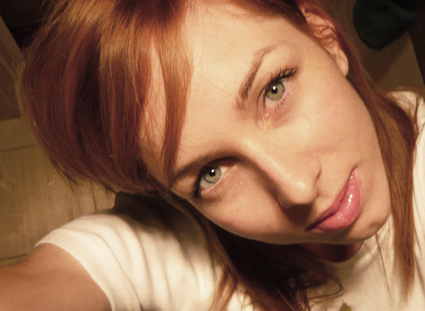
Tanja Liedtke, self portrait, Life in Movement
The film’s most interesting achievement is the way in which it understands the dramaturgy of Liedtke’s works, tracing particular scenes and choreographic moments back through the archive of video documentation. It is remarkable that Liedtke was such an avid user of video and thereby provided such an archive; but equally remarkable is the way in which the filmmakers select and use that material, re-deploying the dramaturgy to tell their own story. The final scene from Construct, in which Kristina Chan is enclosed and stilled within a tower of timber two-by-fours (used playfully throughout the work in varying configurations), is cut into a long sequence in which collaborators and family members talk about Liedtke’s high standards, her unreachable expectations for herself and her fears of failure. We accumulate an understanding of real life events through artistic ones and vice versa: the objects, the materials and tools for play and creativity can also be the structures that contain and confine us.
One of my favourite memories of watching Liedtke perform remains a tiny fragment of an idea she created with Chan at one of Australian Dance Theatre’s informal Ignition series for emerging choreographers back in 2002. In a program of short works purportedly re-imagining something in relation to the Nutcracker tradition, their collaboration stood out for its conceptual clarity: in an exploration of passage through space, Liedtke described tight corridors and diminishing gateways through exacting articulations of her long form. She did so little, and yet the air around her vibrated with excitement. I tried to Google the work in order to name it here, but surprisingly turned up nothing (returning to the old-fashioned archive of a review I wrote at the time to check the date). This is partly what Life in Movement or any biography attempts to ameliorate I suppose: despite the seemingly inerasable and inescapable technologies of the internet, of video documentation or even the print archive capturing whatever we do, such archives are in fact highly unstable. Our activities and our lives may yet dissolve into vague memory and forgetting.
This is of course what academic Peggy Phelan and others have notably claimed for performance as well, its ontology of disappearance and ephemerality. But Life in Movement demonstrates that ephemera and material remnants of an artwork and a life do remain—in the bodies of the dancers who worked with Liedtke (what Diana Taylor calls the “repertoire”), in the memories of those who witnessed the life and the art, and in this case, in an extensive image archive too.
Seeing the film I am reminded of Tanja Liedtke’s ability as a dancer and choreographer to put us in touch with both the cruelty and brilliance of humanity through the extremity of human form and human emotion in her performances. This is an intelligently crafted film that re-activates such memories, both collecting and also adding to the archive of Liedtke’s life and work in the public domain.
Life in Movement, director, cinematographer, editor, co-producer Bryan Mason, producer, co-director Sophie Hyde; Closer Productions; http://lifeinmovementfilm.com; in cinema release from April 12
reviews of tanja liedtke’s work
words for escape
francesca rendle-short: tanja liedtke, tweflth floor
RealTime issue #60 April-May 2004 pg. 44
growing performance: networks & niches
keith gallasch surveys new opportunities for contemporary performance
RealTime issue #72 April-May 2006 pg. 38
dynamic dance theatre: dancing binaries
keith gallasch wrestles with tanja liedtke’s twelfth floor
RealTime issue #74 Aug-Sept 2006 pg. 32
obituary & construct
sophie travers, martin del amo
RealTime issue #81 Oct-Nov 2007 pg. 12
RT60, RT72, RT74,
RealTime issue #108 April-May 2012 pg. web
© Justine Shih Pearson; for permission to reproduce apply to realtime@realtimearts.net
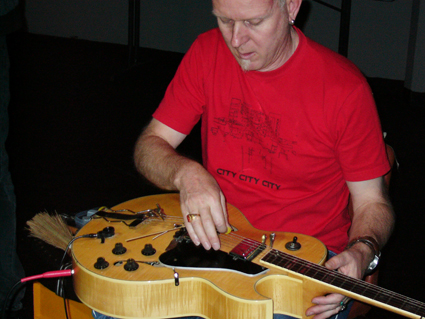
Dave Brown at Undue Noise in 2005
photo Jacques Soddell
Dave Brown at Undue Noise in 2005
It’s a common error to assume that innovative arts action only happens in big cities. Particularly in the area of experimental music and sound art there’s a vibrant history of festivals and activities based in regional Australia. In NSW there’s been the Unsound Festival in Wagga Wagga (RT76), Rolling Stock Festival (RT101) and Wired Lab in Cootamundra (e-dition Nov 22, 2011); and more recently activities at Cad Factory Narrandera. In QLD there’s been See Hear Now in Townsville (RT81; RT97) and in regional Victoria the undue noise collective.
Gently steered by Jacques Soddell (who also runs the Cajid CD label), the undue noise collective has been in operation since 2002, primarily in Bendigo but also working with Punctum to produce events in Castlemaine, including a touring leg of Liquid Architecture. Over this time the collective has presented more than 70 concerts successfully creating a community of artists and audiences in the region of Central Victoria.
To celebrate their 10 years of existence the collective is presenting Sonic Decadence, four concerts over two days at their regular venue, The Old Fire Station, featuring 24 local and intrastate artists covering a range of exploratory styles. Potential highlights could be Dr Aardvarks Table O Gadgets, a rare appearance by Warren Burt playing musical toys such as iPhones, Android Tablets and KAOS Pad, and The Runny Tadpole, a new group based in Bendigo playing Theremin, Kaossilator, home made instruments, drums and effects. Also from Bendigo is Justin Bull, improvising guitarist playing solo and reuniting with Soft Black Stars, a free improv group who performed at the very first undue noise. Taking the trip from Melbourne will be guitarist Tim Catlin, sax player Rosalind Hall and guitarist David Brown. And of course the festival wouldn’t be complete without an appearance by the microbiologist turned field recording sound adventurer, Jacques Soddell himself. Certainly worth a roadtrip!
Undue Noise presents Sonic Decadence, Old Fire Station, Bendigo, April 28, 2 & 8pm; April 29 2 & 8 pm; http://undue.cajid.com/blog/?p=331
RealTime issue #108 April-May 2012 pg. web
© RealTime ; for permission to reproduce apply to realtime@realtimearts.net
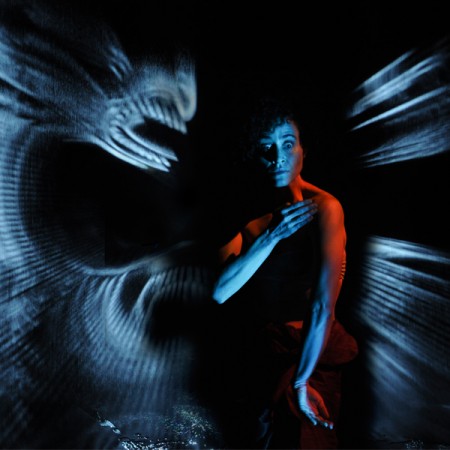
Victoria Hunt, Copper Promises: Hinemihi Haka (2012)
photo Heidrun Löhr
Victoria Hunt, Copper Promises: Hinemihi Haka (2012)
Overlapping with Local Positioning Systems, the Performance Space program presented with the Museum of Contemporary Art, comes their first season for 2012 at Carriageworks, Dimension Crossing.
Inhabiting the foyer is Robyn Backen’s Whisper Pitch. It’s a curved brick structure, a building within a building, that draws on the artist’s investigations into architectural acoustics and parabolic forms to explore the idea of a whispering wall—a place for secret communications amidst the reverberant hubbub. (Until May 19)
Audiences access Michaela Gleave’s Our Frozen Moment through a makeshift cloakroom at the back of Bay 19 where they are invited to don raincoats and gumboots. (In Sydney’s current weather they probably arrived wearing them!) In the centre of the gallery space is a kind of stage, on which the visitor may frolic in the light misty rain. Flashes of light illuminate the droplets like tiny stars, dancing ever so briefly before your eyes—a new micro-universe. (Until May 19)
The performance program opened with Yumi Umiumare’s EnTranced (April 19-21). Well titled, the work was totally entrancing, as Umiumare, a mistress of transformation, danced through a series of surreal in-between worlds (see review in RT109).
Following this is the long awaited Copper Promises: Hinemihi by Victoria Hunt. Over the last few years Hunt has been on a very personal odyssey to explore her Maori heritage. In many ways her journey parallels that of the Hinemihi, an ancestral ceremonial space that was bought from its traditional people and transferred to England—but for her people the Hinemihi is more than a structure, it is the female ancestor herself. Hunt, a mesmerising performer trained in BodyWeather, has been assisted by her extended family and guest artists (James Brown, Densil Cabrere, Annemaree Dalziel, Hedge, Horomona Horo, Clytie Smith, Chris Wilson and Fiona Winning) to create this performance (also to be reviewed in RT109). May 4 8pm, May 5 6pm, May 8-12 8pm, post show artist talk May 11
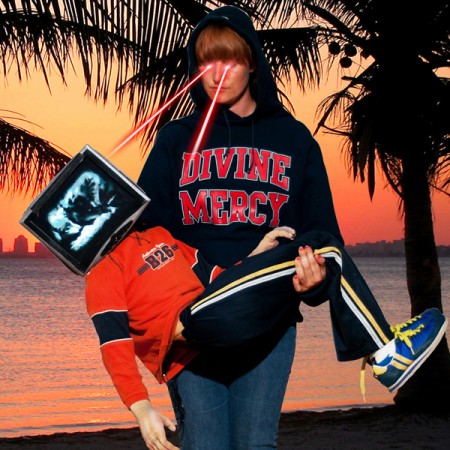
Blood Policy Computer Boy (2012)
photo Bryony Jackson, WhoaaMariaa7, Willoh S.Weiland
Blood Policy Computer Boy (2012)
The final show of the season comes from Blood Policy in collaboration with Aphids. Computer Boy is an exploration of the effect that the virtual world is having on younger generations and is created within a 3D virtual environment (based on gaming technologies such as Grand Theft Auto) and also involves puppetry (a kind of Pinocchio with a 12-inch LCD head) and machinima animation. Made by Bryony Anderson, Martyn Coutts, Sam Routledge and Willoh S Weiland with music by DJ TR!P, it looks intriguing. Game on! May 23-26, 8pm, May 26 2pm
Performance Space fans might want to become members. For $100 you get access to nine shows for free as well as discounted tickets for a friend and off-site shows. http://www.performancespace.com.au/2010/membership/
Dimension Crossing, Performance Space, Carriageworks, April 19- May 26, http://www.performancespace.com.au/
RealTime issue #108 April-May 2012 pg. web
© RealTime ; for permission to reproduce apply to realtime@realtimearts.net

Sunny Drake, X
photo Leesa Connelly
Sunny Drake, X
x, sunny drake
In RT94 the late Douglas Leonard praised Sunny Drake’s Otherwise, stating “this was not navel-gazing but a richly creative engagement with a world where power and sexual or cultural identity are linked.” Drake’s new one-person show, X, currently showing in Brisbane’s Metro Arts as part of their Independents season, looks likely to be a similarly challenging performance.
X enters the world of best friends Caitlin and Jamie and two hand puppets, Naked and Fancy, who together explore addiction from a “lesbian/gay/bisexual/transgender/intersexed/questioning” (LGBTIQ) perspective. Following the Brisbane season, Drake will be taking the show to the USA National Queer Arts Festival in San Francisco.
Sunny Drake, X, Independents 2012, Sue Benner Theatre, Metro Arts, Brisbane, co-presented w Sunny Drake & Contact Inc; until April 28; www.metroarts.com.au/
buru, us tour, marrugeku
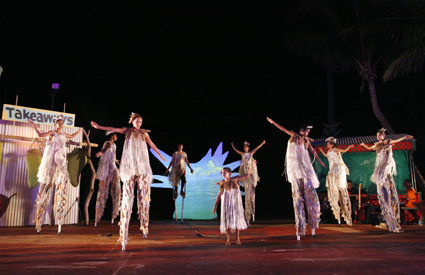
Buru, Marrugeku, Broome 2010
photo Rod Hartvigsen
Buru, Marrugeku, Broome 2010
Also currently touring North America is Marrugeku’s latest dance theatre work, Buru, which premiered in Broome in 2010 and toured the Kimberley in 2011. Buru explores the six seasons as described by the traditional landowners of the area, the Yawuru people, using the stories of Janyju (Red Lizard story as told by Karajarri elder and Yawuru language specialist Doris Edgar) and Walmanyjun (Greedy Turtle Story as told by Yawuru/Jabirr Jabirr elder Cissy Djiagween). The piece is conceived and choreographed by Dalisa Pigram and co-directed with Rachael Swain and includes younger and more mature Indigenous performers utilising hip-hop, stilt dance and storytelling accompanied by the music of Marrugeku Mongrel Band with guest songwriter Stephen Pigram. Buru has already been performed at the Scottsdale Center for the Performing Arts, Phoenix, Arizona (April 14) and will be playing as part of the Manitoba Theatre for Young People, Winnipeg, Canada (April 24-27). The nine young Indigenous performers will also take part in cultural exchange workshops and activities with local indigenous theatre makers.
Marrugeku, Buru tour; www.marrugeku.com.au/
tyger tyger: west space
West Space’s curatorial initiatives continue to impress. As well as the 2011/2012 project Today Your Love which sees artists inhabit the gallery with an emphasis on process and experimentation over product, there is also the Tyger Tyger project curated by Phip Murray. Tyger Tyger aims to broaden the focus of Westspace beyond emerging artists and thus Murray has invited a number of established guests to team up with an emerging artist of their choice. Coming up next is a collaboration between Lyndal Walker and Danielle Hakim titled Re-make/Re-model looking at the role of the model, both animate and inanimate, in life and art. Also part of the Tyger Tyger project is the collaboration between composer and sound artist David Chesworth and sculptor/installation artist Katie Lee. Together they will present All Who Occupy This Great Space, a sound installation and sculptural environment which will also be the site of two performances by experimental vocalists Alice Hui-Sheng Chang and Carolyn Connors.
Lyndal Walker and Danielle Hakim, Re-make/Re-model; David Chesworth and Katie Lee, All Who Occupy This Space, West Space, April 20-May12; performances April 28, 3pm, May 10, 6.30pm. http://westspace.org.au
making the green one red (virtual macbeth), andrew burrell, kerreen ely-harper
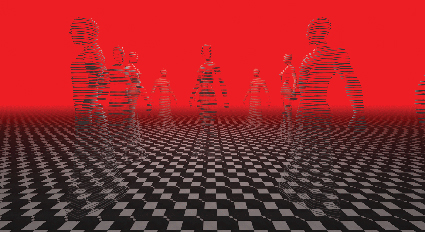
Making the Green One Red (Virtual Macbeth), Andrew Burrell, Kerreen Ely-Harper
Director Kerreen Ely-Harper started the Virtual Macbeth project in 2007 (with Dr Angela Thomas and multimedia artist and producer Kate Richards) as an online world in Second Life. The project has now been further developed, with Sydney-based hybrid media artist Andrew Burrell, to become Making the Green one Red (Virtual Macbeth), focusing on the live and virtual performance possibilities of the concept. The work will be exhibited as a performative installation at QUT’s The Block where visitors can interact with the world, becoming “audience, actor and narrator, allowing them to self-determine their own path within the physical and virtual world the witches have created.” Audiences can also experience part of the work in the virtual environment at http://miscellanea.com/virtual_macbeth.
Making the green one red (Virtual Macbeth), The Block, QUT Creative Industries Precinct, April 24-May 5; http://www.ciprecinct.qut.edu.au; http://miscellanea.com/virtual_macbeth/
moduluxxx—modular synthesis mini-festival serial space
And one for the knob twiddlers. Pia Van Gelder, überlord of Dorkbot and musician/curator Alex White are presenting a two-day mini festival celebrating the joy of the modular synthesiser. They tell us it’s a “style of synthesiser design where the architecture is left open. Each element, whether it be a sound generator, filter, controller, modulator or effect can be reconfigured in an infinite variety of arrangements…You might never finish a song or track again” (press release). There’ll be performances by geek favourites Robin Fox, David Burraston, Hair Hochman, Nadir (Ben Byrne and Alex White) and Pia van Gelder, a special Dorkbot share-meeting where you learn to “Synthesise a Synthesiser” and, perhaps most curious of all, a Synthesiser Petting Zoo where you can touch these little magic boxes yourself.
Moduluxxx, April 27-28, Serial Space, http://serialspace.org/; https://sites.google.com/site/moduluxxx/
opportunities
For Brisbane-based emerging artist Metro Arts and Chan Hampe Galleries (Singapore) have joined up to offer a Brisbane-Singapore exchange program. Four artists and two curators or writers will spend three weeks in both Singapore and Brisbane resulting in a major exhibition which will take place as part of the 2012 Asia Pacific Triennial. Applications close April 30; http://www.metroarts.com.au/
Artspace, Sydney is calling for proposals for its 2013 Studio Residency program. Both residential and workspace-only studios are available, generally for periods between two and six months at subsidised rates. Applications close June 15; http://www.artspace.org.au/residency_guidelines.php
Screen Space in Melbourne is a purpose-built gallery focusing on works which take an innovative approach to screen-based media. They are currently seeking proposals from artists and curators for both the Main Gallery and Small Screen exhibition spaces for 2013. Applications close May 25; http://www.screenspace.com/proposals.html
PACT Centre for Emerging Artists will be holding auditions for their PACT Ensemble 2012 Program which provides training and creative development for artists aged 18-30. The 2012 program will include training with movement tutor Sam Chester, voice tutor Drew Fairly and culminates in the development of a final work under the direction of Cat Jones and Julie Vulcan. Registrations close April 30 and auditions will be held May 14; http://www.pact.net.au/
Kathleen Mitchell Award for Young Writers is a biennial award for authors under the age of 29 years who have published their first novel. Kathleen Mitchell’s aim was “the advancement, improvement and betterment of Australian literature, to improve the educational style of the authors, and to provide them with additional amounts and thus enable them to improve their literary efforts” (website). The value of the award is $15,000. Applications close April 27; http://www.trust.com.au/philanthropy/awards/kathleen_mitchell.asp
RealTime issue #108 April-May 2012 pg. web
© RealTime ; for permission to reproduce apply to realtime@realtimearts.net
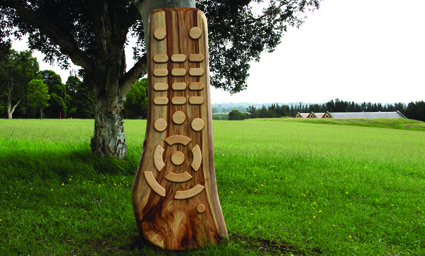
Wade Marynowsky, Remote Tribe 1 – Sweet poison 2012, in-situ
courtesy the artist
Wade Marynowsky, Remote Tribe 1 – Sweet poison 2012, in-situ
Wade Marynowsky has amused and bemused gallery viewers over the last few years with his distinctive take on interactivity and robotics. Dan MacKinlay wrote of his 2009 work, The Hosts–A Masquerade of Improvising Automatons: “There is a kind of inversion of the panopticon here. I know I am watched, but I do not know truly by what. Is it another of Wade Marynowsky’s telepresence hoaxes, or some automated trickery, or perhaps something more unnaturally intelligent? Is the moment at hand when we reprise our ancient animism, catching ourselves being polite to our appliances just in case there is an intelligent mind of any sort peering back at us that we might offend?” (online exlcusive RT93)
Marynowsky has a new solo show, Universal Remote, opening at UTS Gallery comprising media art pieces along with some more ‘traditional’ sculptural and photographic works. The universal remote of the title is in fact a series of oversized replicas (almost two metres tall) of remote control devices carved out of Canadian rock maple and Australian camphor laurel. Marynowsky was inspired by the totem poles he saw when undertaking an artist-residency in Canada. He rather cheekily states, “Remote controls are the talking sticks of my generation; at my parents home the person ‘in control’ of the remote holds the power to speak…or choose what we all watch” (press release).
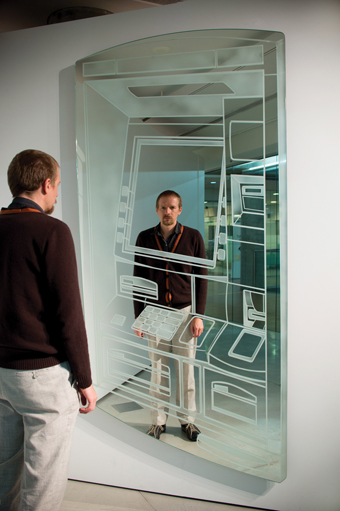
Wade Marynowsky, The balance of your bank account is reflected in your face 2012, installation view.
courtesy the artist
Wade Marynowsky, The balance of your bank account is reflected in your face 2012, installation view.
Similarly playful is another sculptural piece, The balance of your bank account is reflected in your face. Here the outline of an ATM is etched into a large mirror in which you become the ghost in the machine.
Entry to the exhibition is via a sound installation titled One room, one button: composition for padded room. Marynowsky says, “It consists of eight white padded panels and an oversized chaise lounge [sic], embedded with 704 arcade buttons. The installation explores the insanity of the ever growing ‘smart revolution,’ in particular the smart home” (email correspondence). Perhaps Wade Marynowsky shares Dan Mackinlay’s anxiety about machine intelligence.
Wade Marynowsky, Universal Remote, UTS Gallery, April 24-June 1, artist talk with MCA curator Anna Davis, May 22, 5.30pm; www.utsgallery.uts.edu.au/gallery
RealTime issue #108 April-May 2012 pg. web
© RealTime ; for permission to reproduce apply to realtime@realtimearts.net
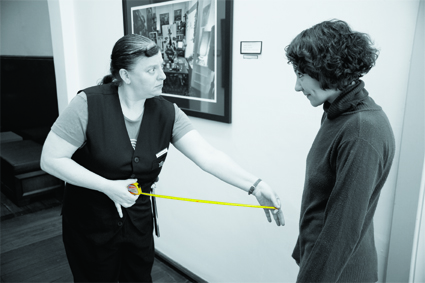
Nikki Jones and audience
member, Ush and Them, Proximity
Micro Festival of One-on-One Art
photo Ashley de Prazer
Nikki Jones and audience
member, Ush and Them, Proximity
Micro Festival of One-on-One Art
There’s a lot of walking in RealTime 108. Good exercise for mind and body. Matthew Lorenzon goes on an art walk in Battambang, Cambodia, exploring the city’s artistic re-emergence. Next Wave director Emily Sexton talks about the communality of sharing with fellow walkers one’s responses to a range of selected festival works on day-long guided walks. At the end of an intense NOW Now concert, Romy Caen goes on a programmed hour-long night walk in silence, alerted to the sound world of Sydney’s Marrickville. Ian Millis writes about a Green Bans walk through Sydney’s Woolloomooloo, meeting people who were there in the 70s and recalling the fusion of art and activism that saved significant parts of the city from development. Millis argues for the walk as art: ephemeral, collaborative, memorial, political. From there, it’s a mere step into a virtual world of public transport, and public violence, realised in Van Sowerwine and Isobel Knowles’ latest interactive creation, It’s a jungle in here, where fellow travellers might irritate or turn nasty and you choose how to respond. Elsewhere, a sometimes amused, sometimes perturbed Laetitia Wilson reports you can find yourself seriously on your own, up close and very personal with an artist in a one-on-one live art work. One of which was Ush and Them with Nikki Jones (pictured above) corralling a bemused viewer in her work about ushers and guides. As this edition of RealTime extensively reports, together, alone, engaged with the actual or the virtual, the art experience is exponentially expanding.
RealTime issue #108 April-May 2012 pg. 2
© Keith Gallasch; for permission to reproduce apply to realtime@realtimearts.net
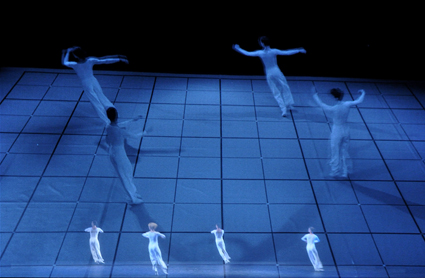
Lucinda Childs Dance Company, DANCE
photo © Sally Cohn
Lucinda Childs Dance Company, DANCE
PULSE-QUICKENING NOT ONLY COURSED THROUGH SPECTATORS AT THIS YEAR’S PERTH INTERNATIONAL ARTS FESTIVAL BUT WAS EMBEDDED, WITH VARYING DEGREES OF FIRMNESS, INTO A RANGE OF ITS ARTISTIC INTERROGATIONS. BODIES TECHNICALLY FORMED BY DANCE AND CIRCUS TACKLED THE COMPLEXITIES OF POLYPHONIC EXPRESSION WITH AN UNUSUAL SENSE OF INTENT, WHETHER DIRECTLY AS IN LUCINDA CHILDS’ DANCE AND GRUPO CORPO’S PARABELO AND ONQOTO, OR WITH DISCRETE INDIRECTNESS IN THE WORKS OF THE WA BALLET’S QUARRY SEASON, THE VOCAL CUSHIONING OF HOW LIKE AN ANGEL’S EARTHBOUND TRAJECTORIES AND IN THE PLAYFUL ZENITH OF CROSS-CUTTING DIALOGUES, JAMES THIÉRÉE’S RAOUL. RHYTHM AS A SINGULAR IDEA IS BLOWN ASUNDER BY PRODUCTIONS THAT DISSECT TIME IN THE BEDROCK OF THEIR MAKING/CREATION.
lucinda childs
Childs’ Dance exemplifies the perspective. Indeed, this reconstruction of a 30-year-old minimalist work folds the past into the present with intriguing resonances. Essentially Dance is about mathematical computations concentrated within the restricted phrasal vocabulary of Philip Glass’ score and Childs’ choreography. Though irrevocably wedded, dancers and musicians follow the democratic dictates of the 70s and maintain their autonomy, promoting their own identity through calculated skipping, over and in each other’s patterns. Today however, designer Sol LeWitt’s contribution dominates. In the artist talk with Michael Whaites, Childs explained that LeWitt consolidated Dance’s concept because he considered the dance and music intrinsically so strong that design would prove to be unnecessary except if provided by the dancers themselves. Therein materialised the filmic design projected on a downstage scrim where the dancers partner themselves. LeWitt’s solution has survived, now transformed into a dialogue of the vital being-ness of current performers with their forbears, a powerful encounter of dancers across time.
Silent manoeuvres of the filmic eye tip horizontal perspectives into overhead sight or split screen-dancers onto opposite sides of the stage to transpose the minute shifts of sound and movement into a complex mapping exercise. Sepia-tinged screen-dancers criss-cross space like phantoms, the loose swing of their limbs relieved of the weight of flesh. Against their live counterparts with musculatures which scavenge space in directed pathways, these apparitions float free of bodily endurance. That is except for Childs whose image from across time stands huge in its determination, a will which is, ironically, not to be manipulated.
west australian ballet
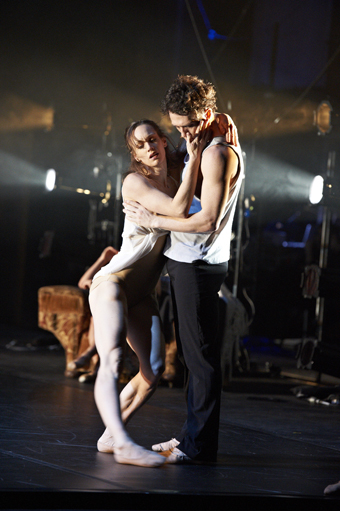
Jayne Smeulder, David Mack, Serenade, Ballet at the Quarry, WA Ballet
photo Jon Green
Jayne Smeulder, David Mack, Serenade, Ballet at the Quarry, WA Ballet
Down in the Quarry, WA Ballet artistic director Ivan Cavallari’s Strings 32 aligned violin bowing with vibrating energies of dancers and their elastic appendages to provide a feasible premise to celebrate the compulsion of refined action. Muscularity infiltrated the atmospheric expanse of the Quarry but did little to interconnect the violinist with the starry environment. On the other hand, Balanchine’s early tribute to American classicism, Serenade, flowed blue into the night entirely in sync with Tchaikovsky’s haunting tones. Under repetiteur Eve Lawson’s astute direction, the dancers embodied the legendary choreographer’s musical sensitivity and movement abstraction with a credible confidence. While veiled beneath the airy costuming and feminine foregrounding, Serenade bears a structural affinity with the Childs/Glass lineage. Balanchine may not have imbibed the democratic mania of his adopted homeland but, choreographically speaking, he led the introspection of form that was to follow.
The remaining two works, Reed Luplau’s The Sixth Borough and Terence Kohler’s Rhetoric, though replete with the tempi of city life and online role-playing games of their respective themes, blanched into predictability and obscurity. All the verve and seduction of sexy bodies in impressive whips and curves simply could not retrieve the works’ formless descent. Only the lone night star of Serenade endured, shimmering past into present, double-ghosting Sol LeWitt’s sepia memories.
grupo corpo
Rhythm pulsed through swaying and twitching joints over a throw away classical technique to make Grupo Corpo’s Parabelo & Onqotô an experience of the now. Patterns skittered back and forth through that pervasive ethnic mix that is the Brazilian actuality. Batuadas, the percussive signatures of identity for the myriad mixtures of peoples, ricocheted through the sound and movement of Rodrigo Pederneiras’ Parabelo, not to illuminate fragmentation but to reiterate unity. Bodies caught and threw notes, weight and attitudes of difference and commonality about in conjunctions which finally conveyed order rather than chaos. Touches of formality (Childs) and virtuosity (WAB) appear but the sassy sexuality of these dancers slipped over the sophistication and viral disintegration of the worldly wise. Even the sparse interjection of duets and solo movements never eroded the group’s momentum. Grupo Corpo’s world is warm and conservative, playing with the heart beat’s literal need; at variance perhaps with aesthetic fulfilment?
In the Brazilians’ reception a line was drawn between the general public’s appetite for the exotic and dance aficionados’ reservations. Sensual syncopation is undoubtedly a structural element which Pederneiras plumbs for all manner of thematic concerns but its literal application, plus unitards, diminutive masculine movement and commercial aura failed to please dancers. Being biased towards all things South American, I found such concerns puzzling. In Onqotô, a female body was slapped around by a male who for the most part lay supine on the floor. In the image, I saw an extraordinary reverence for the masterful skills of a soccer icon like Pele in conflict with the literal reading which pointed to a harsh sexual relationship. A further overlay, or so the program notes suggested, yoked this clash metaphorically with the creation of the universe. This sequence, both uncomfortable and thrilling, was pitched against a female homosexual duo which could, with cultural encoding, be a statement about the complex workings of machismo, both within and beyond the soccer environment. Such a reading may be impossible without some familiarity with the culture in question.
circa & i faglioni
The ‘angels’ of How Like an Angel hit the earth repeatedly with the bruising flesh-thud of indisputable human propensity. Was the intention to reframe Milton’s tale of the fall from paradise, to accentuate the negative transformations of fantastical flight and tussle of divine wills? Intoxicating sacral tones reverberated within the acoustic bounce of Winthrop Hall, circulating an impressive arena-like configuration of audience and rectangular strip of performance space. The sound coiled around a sculptural figure partnering a long pole as if in a philosophical or sublime debate. This promising start plummeted when his fellow athletes appeared.
How Like an Angel, a commissioned work of circus, choir and cathedral for Britain’s Olympic Festival glanced awkwardly over the idea’s potential. Setting and aural evocativeness tumbled due to what seemed an under-rehearsed and unformed realisation of what might have been. The promised play in paradise lost crept in once or twice, as when a scantily clad female climbed up black silks. It was a simple and unexpected image, posed as if the performer was on a trajectory to heaven. The drama of this image evaporated as quickly as it surfaced. Performance rhythm did briefly return after the painful thud to earth of a suicidal man who, unlike St Michael’s defeat in his challenge to a jealous God, fell inexplicably from the high-rise apparatus onto a pile of thick mats. The culminating pole act signalled how it is that human skill may accomplish angelic mystery or, in philosophical terms, the god-breath. Here, circus skills prevailed: timing and sheer audacity on that vertical pole exemplified what a physical idea might achieve.
james thiérée
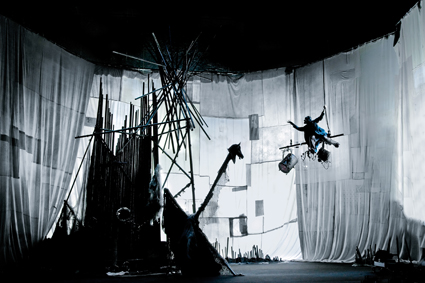
James Thiérée, Raoul
photo courtesy PIAF
James Thiérée, Raoul
Final festival reflection must come from he who utters little but speaks volumes in sound, design and movement. Performance is a strange territory, given to multifarious prejudices, trends and desires. Structures can be brilliant by way of purity of intent, bodies can be devilishly attractive in their astounding defiance of the norm and, then, there is this other place and possibility, wherein exposure transports ordinary people into something which is ungraspable. James Thiérée’s Raoul, ostensibly a solo performance, achieves exactly this objective. Thiérée employs skills across disciplines to convey an insignificant human in an inexplicable world, sharing ideas about the who-what-how of what human being-ness might mean. Thiérée’s arrogant and absurd little man talks with fixtures of external decadence and imagination. In his presence, polyphony transcends genre and clamour turns symphonic. Fluttering hands, leftover movements from an argument with sound walls, dance into the astounding complexity of simplicity.
Perth International Arts Festival: Lucinda Childs Dance Company, Dance, choreography Lucinda Childs, music Philip Glass, film Sol LeWitt, Heath Ledger Theatre, Feb 22-25; West Australian Ballet: At the Quarry, Feb 10-March 3; Grupo Corpo, Parabela and Onqotô His Majesty’s Theatre, March 1-4; Circa and I Fagiolini, How Like an Angel, director Yaron Lifschitz, musical direction Robert Hollingworth, Winthrop Hall, UWA, Feb 29-March 3; La Compagnie du Hanneton, Raoul, designer, director, performer James Thiérée, Regal Theatre, Feb 18-26
RealTime issue #108 April-May 2012 pg. 3
© Maggi Phillips; for permission to reproduce apply to realtime@realtimearts.net
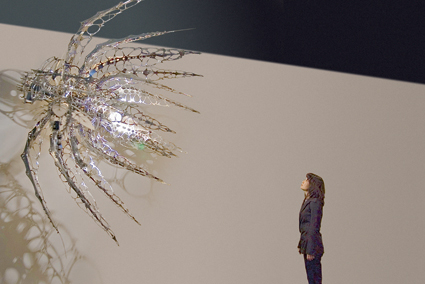
U-Ram Choe, Urbanus Female, 2006, installation view, Mori Art Museum, Tokyo
GAMBLING ON A SMALLER VISUAL ARTS PROGRAM BUT WITH HIGHLY COMMENDED NATIONAL AND INTERNATIONAL ARTISTS IN THE PERTH INTERNATIONAL ARTS FESTIVAL HAS CERTAINLY PAID OFF THIS YEAR WITH RECORD BREAKING ATTENDANCES AT SOUTH KOREAN ARTIST U-RAM CHOE’S SOLO EXHIBITION. CHOE’S DELICATE AND HIGHLY TECHNICAL KINETIC SCULPTURES WERE ELEGANTLY INSTALLED AMIDST DARKNESS, HOVERING UNDER ILLUMINATED LIGHT WITHIN THE CORNERS AND CORRIDORS OF THE JOHN CURTIN ART GALLERY.
Featuring nine machinic organisms accompanied by plaques that describe their behaviours, habitats and adaptive responses, the exhibition forms Choe’s premonition of how machine life will evolve in a future technocratic society. It is a world populated by these life forms (or anima-machines) that have adapted faster than humans and thrive in urban environments. They have been ornately designed to resemble natural flora and fauna but have adapted by acquiring light steel skins for protection and factory motors instead of organs. They graze on residual urban energy, airborne viruses and unclaimed data and live in harmony with their environment. Choe invites his audience to study this realm, the behaviours of these specimens, to become accustomed to their nature and understand that these creatures are an harmonic synthesis of technological systems and the natural order.
Each of the eight machine organisms is a delicate hybrid of mechanical engineering and nature. Each form, movement and behaviour has been designed specifically for these organisms to not only exist but also thrive in their machinic environments. Instead of proposing a threat to humanity they harmoniously perpetuate the life and energy cycles of machinery.
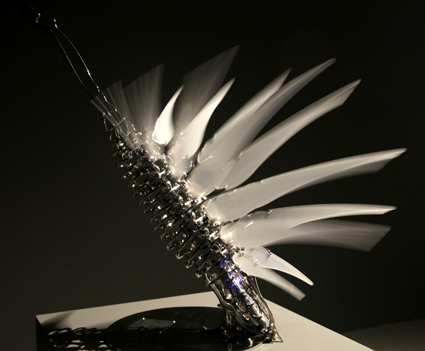
U-Ram Choe, Nox Pennatus, 2005, installation view, John Curtin Gallery
Some works are in constant repetitive motion, while others wait to sense human presence before performing their gestures. Each work has been intricately designed and fastidiously engineered to not only mimic the complexity of the natural order but to demonstrate a capacity for the visceral elegance in machinic movement. The skeletal creations are fitted with perforated steel skins to expose the entire operation of hundreds of custom-made steel ligaments, joints, frames, CPU and LED motors. The connection of each component meeting and moving with the next forms an orchestration that reveals mechanical bodies to be as detailed as our own in motion.
The centerpiece of the exhibition, Urbanus Female (scientific name: Anmopista Volaticus floris Uram) (2006) is a flower-like anima-machine that Choe has created as a nocturnal feeder of urban energy. In the gallery it lies dormant, suspended from the ceiling until it senses human presence, which cues the work to perform its anthesis [the period during which a flower becomes fully open and functional. Ed]. With each turn, the flower—its stamen a twisting and beaming metal halide lamp—opens and closes slightly before unfolding entirely, expanding three metres in diameter and reaching forward to the viewer.
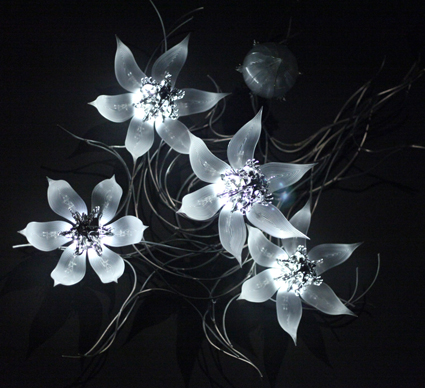
U-Ram Choe, Una Lumina, 2005, installation view, John Curtin Gallery
Choe has designed the interaction between his Urbanus Female and those in its company as an elusive form of communication. Its gestures require our patience, its grand unfolding taking place at its own rate. Choe’s great trick reminds us that we are in the gallery to study, rather than command the behaviour of these rare specimens for our entertainment. We are in their space, in their world as their audience.
Around a corner stands Ultima Mudfox (2002), hovering with its fins waving in perpetual motion but otherwise still for us to examine its delicate skeletal structure. After reading their accompanying narrative we find that these creatures “free themselves, one after another, from the factory that created them, clone themselves in a base camp beneath the city, where electromagnetic waves are abundant” (Choe, U-Ram, Exhibition Catalogue, 2012). The artist clearly pursues the issue of sustainability between humans and machines. When set into motion and given life, anima-machines live, breed, consume and expire alongside humanity, feeding off computer viruses and unclaimed data and converting them into resources. Choe envisions a world where these creatures subsist within the cycles of human life and production as independent and complementary beings.
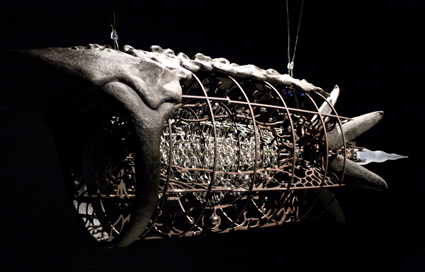
U-Ram Choe, Jet Hiatus, 2005, installation view, John Curtin Gallery
It is common for kinetic artists to explore technology’s capacity to either assail or assist humanity. At times these tropes can perpetuate a reductive dichotomy between nature and technology. Choe successfully avoids this binary association by presenting his works as fantastical beings that thrive in the technocratic society from which they are born. U-Ram Choe firmly believes that the evolutionary capacity of machines is far more advanced than our own and that we can therefore learn from our technological creations. His art is an invitation to study their advanced behaviour and adaptive responses, approaching these anima-machines as our future companions and providers.
2012 Perth Festival, U-Ram Choe, John Curtin Art Gallery, Perth, Feb 3-March 4
See a short video interview with U-Ram Choe on the Creators Project
RealTime issue #108 April-May 2012 pg. 4
© Christina Chau; for permission to reproduce apply to realtime@realtimearts.net
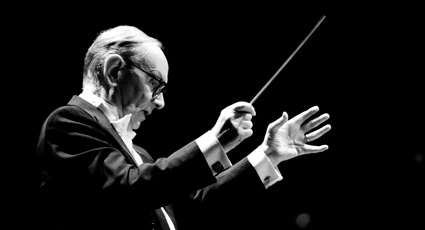
Ennio Morricone
photo courtesy Perth International Arts Festival
Ennio Morricone
A DIVERSE AUDIENCE FILLED THE BURSWOOD THEATRE FOR ENNIO MORRICONE’S PERTH INTERNATIONAL ARTS FESTIVAL APPEARANCE. OLD AND YOUNG, CLASSICAL ENTHUSIASTS, FILM BUFFS AND HIPSTERS WERE ALL DRAWN TO SEE THE 84-YEAR-OLD FILM MUSIC LEGEND. MORRICONE’S MUSIC SEEMS TO FIND SOME POINT OF REFERENCE WITH A GREAT NUMBER OF PEOPLE. HIS WORK WITH SERGIO LEONE ON FILMS SUCH AS THE GOOD, THE BAD AND THE UGLY (1966) SPAWNED NEW TROPES FOR FILM COMPOSITION AND HIS SCORES HAVE CYCLED ENDLESSLY THROUGH POP CULTURAL HOMAGE AND PARODY.
Morricone’s sound world is truly huge. Appearing for the first time in Australia, he conducted a 100-piece youth orchestra and a 100-strong choir, as well as a few rock instruments and a (less than perfect) guest appearance by soprano Susanna Rigacci.
The entire performance was amplified, sparking much post-concert debate. In a purely classical context, amplification can ruin the intimacy of a performance by rendering it hyperreal, but Morricone’s music isn’t essentially classical, it is film music. Its currency is evocation and broad gesture. In my view, the amplification aided both these elements, adding a sheen of fantasy to the performance. The sound was detached from its context within the hall, allowing it to evoke the kind of imaginary landscapes in which Clint Eastwood triumphs as the archetype of butch Americana.
This raises the question of how one evaluates a performance of Morricone’s music. It makes no sense to talk about it in the same way one would a performance of a work by Beethoven. It is film music, and perhaps should be assessed as such, but is presented here without the dressings of image or narrative. There are rock elements too, not only in the electric guitar and drum set but in the exaggerated movement, memorable themes and mass appeal (three encores, no less). Again, however, there is no rock theatricality.
Rather, Morricone’s music seems to both include and transcend these streams. It has become part of the collective unconscious. Even for people who have never seen any of his films, the music is instantly familiar and evocative. Some of its tropes are, or have become, clichéd. It brings to mind John Adams’ summation of culture: “when we communicate, we point to symbols we have in common. If people want to make a point, they reach for a reference.” This is the good and the bad of Morricone’s music—where there were no reference points, he created them, but now, with his music so established, it is difficult to hear it afresh. Despite all this—the cheesiness, the clichés, the endless pop-cultural echoes—something about Ennio Morricone’s music is magic. Widescreen nostalgia for a place that never really existed.
Perth International Arts Festival: An Evening With the Maestro, Ennio Morricone, Susanna Rigacci, West Australian Youth Orchestra, The Perth Festival Morricone Chorus, Nanni Civitenga, Massimo D’Angostino, Ludovico Fulci, Leandro Piccioni, Rocco Zifarelli; Burswood Theatre; Febuary 26, 2012
RealTime issue #108 April-May 2012 pg. 5
© Henry Andersen; for permission to reproduce apply to realtime@realtimearts.net
CONSIDER THE AMERICAN DREAM. FREEDOM. OPPORTUNITY. EXCESS. NOW, CONSIDER AMERICAN MUSIC, SPECIFICALLY CLASSICAL. MUSIC IS OFTEN INDICATIVE OF THE PLACE WHERE IT WAS WRITTEN AND ACCORDINGLY, THE CLASSICAL CANON OF THE AMERICAS HAS A FAR DIFFERENT CHARACTER FROM THAT OF EUROPE. IN THE AMERICAS, CLASSICAL MUSIC IS AN IMPORT. WITHOUT THE SAME WEIGHT OF TRADITION, AMERICAN COMPOSERS ARE FREER TO PULL IN A VARIETY OF INFLUENCES FROM JAZZ, ROCK AND OTHER NATIVE MUSICS.
As part of the Perth International Arts Festival, Soft Soft Loud presented contemporary chamber music by composers from USA, Mexico and Argentina. In every piece, there was a sense of music’s role as a cultural signifier.
Take, for example, Argentinian Osvaldo Golijov’s voice and ensemble piece Ayre, which uses religious melodies to explore music’s ability to simultaneously evoke and transcend culture. “With a little bend, a melody goes from Jewish to Arab to Christian,” says Golijov. The piece had some beautiful softer melodies but its inclusion of (admittedly, tongue in cheek) rock sections and drum machines came off as heavy-handed. Rapid stylistic shifts also featured in American Andy Akiho’s Hamba iro (for steel pan, drum kit, string quintet and harp) but the changes were far smoother. The piece pulled itself, serpent-like, through waves of cool jazz, brooding classicism and energetic Caribbean.
Woven through the program were movements from George Crumb’s beautiful Eine Kleine Mitternacht Musik (Ruminations on ‘Round Midnight’ by Thelonious Monk) for solo piano. The American Crumb’s music is the most European sounding of the program, transporting the original Thelonious Monk tune from New World cool to Old World sadness. As a pianist, Monk revelled in music’s stray threads, those moments when the tune falls away into some angular, atonal gesture. In Crumb’s variations, the situation is reversed so that atonality is the norm and the original theme is the interruption—a fond memory or a hopeful rumour of a tune.
The night’s highlight was Steve Reich’s response to the Twin Tower attacks, WTC 9/11, for tape and string quartet. The story goes that on the day of the attacks, a panicked Reich rang his son in New York. After a few minutes, all New York’s phones cut out suddenly, leaving a blaring alarm on the phone line. The piece opens with this alarm, its unrelenting F’s picked up and augmented by the violins to gradually create a chilling cluster chord. Like Reich’s 1988 Different Trains (which dealt with the Holocaust), WTC 9/11 uses fragments of cut-up speech which are mimicked and accompanied by live strings. It’s a detached, almost documentarian approach to dealing with horror which manages to be affecting without feeling manipulative.
Reich’s influence was clear in Mexican Javier Alvarez’s string quartet Metro Nativitas (from 1999, the oldest piece on an impressively contemporary program). The piece uses Reichian minimalist forms but with dense, atonal harmonies and rhythms taken from South American folk dance. The result was an absorbingly static dissonance with a sudden, sheer finish. Another Reich piece, his Pulitzer winning Double Sextet closed the concert. Reich is perhaps the most purely American of any composer. His sound is a grab-bag of tropes from classical, jazz and rock all pulled together by the music’s relentless forward motion, its dogged insistence on growth. It is music that doesn’t sound like anywhere else. Freedom, opportunity and occasional excess.
Perth International Arts Festival: Soft Soft Loud—The Americas; Artistic director Matthew Hoy, Fremantle Arts Centre, Feb 12, 2012
RealTime issue #108 April-May 2012 pg. 5
© Henry Andersen; for permission to reproduce apply to realtime@realtimearts.net
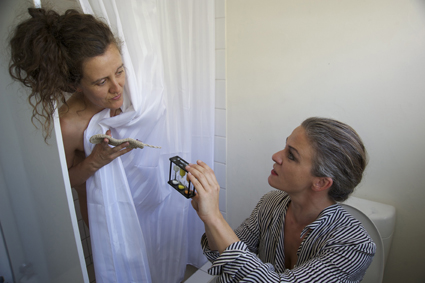
How To Have A 3 Minute Shower (2012) Jen Jamieson, Proximity Micro Festival of One-on-One Art
photo Ashley de Prazer
How To Have A 3 Minute Shower (2012) Jen Jamieson, Proximity Micro Festival of One-on-One Art
THE UP CLOSE AND PERSONAL FORMAT OF THE ONE-ON-ONE PERFORMANCE IS FAMILIAR FROM THE SEX SHOPS IN THE STREETS OF NORTHBRIDGE, BUT WHEN TAKEN INTO THE CONTEXT OF LIVE ART, BECOMES SOMETHING ENTIRELY DIFFERENT. IT COMES WITH ITS OWN DEGREES OF INTIMACY, AWKWARDNESS, PLAYFULNESS AND, INDEED, PRIVATE DANCERS AND STRIP SHOWS.
Proximity, staged as part of Fringe World at the Blue Room theatre in Perth, is Australia’s first live art micro-festival comprising12 one-on-one performances, each lasting about 12 minutes, featuring twelve artists with a unique take on the concept of proximity. Artists drawn from dance, theatre, live and visual arts presented works curated by James Berlyn, produced by Sarah Rowbottam and provoked by Kelli McCluskey (PVI Collective).
The idea of proximity can be interpreted and communicated in numerous ways. The pieces ranged from offering convivial, occasionally banal, encounters to abrupt challenges to personal inhibitions. The entirety of the sensorium became involved. Like a puzzle, the program began with a map, detailing the location and order of the pieces and, like clockwork, announcements were made to indicate their beginning or end. In the face of potential confusion the event was managed and timed to precision. If it were a game it would be full of mysterious choices, challenges hiding behind closed doors, hairy monsters, quirky stories and shadowy portals into alternate worlds. Once in the swing of it, I eagerly followed the path from one encounter to the next, as a solo adventurer facing the unexpected with a wee bit of trepidation—did I really want my own private hoofer? Did I really want to fondle a beard?
My personalised map began with Ush and Them by Nikki Jones, a conversational, wandering piece acknowledging the oft-neglected role of the usher. It was undeniably tongue-in-cheek with Jones taking a toilet break and leading me straight to the lighting room in lieu of any show. The majority of the performances were anchored to a similar kind of conversational interactivity resulting in social, relational, inter-subjective and often instructive experiences. Participants were simultaneously drawn into the world of the performers and invited to reflect on their own circumstances. The success of each performance was largely reliant on the individual personalities, communicative and performative abilities of the artists, which made for a spectrum of experiences, from raw to refined.
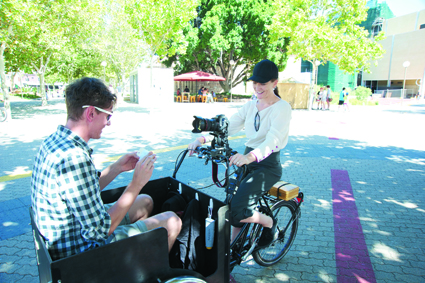
Sarah Nelson, Mobile Moments, Series 2 (2012), Micro Festival of One-on-One Art
photo Ashley de Prazer
Sarah Nelson, Mobile Moments, Series 2 (2012), Micro Festival of One-on-One Art
An existential element came to the fore in two of the strongest pieces, Sarah Nelson’s Mobile Moments and James Berlyn’s Sweetlife. Although very different, these two pieces invited consideration of personal views and morality respectively. Berlyn’s beautifully crafted game placed the audience member in a staged context: delightfully pink, strategically lit, with the sound of ticking timers and the temptation of lolly bags in the background. At one point the participant’s body became a game piece, pulse and iris movements were measured to determine whether or not a sweet life/just desserts were deserved. Moral qualms gave way to thoughtful musings in Mobile Moments, a gentle roving journey through the cultural centre. As passengers on a trike, participants were filmed responding to specific questions around personal likes, dislikes and life decisions. This piece was both subtle in its articulation and incredibly resolved in extending to an aesthetically engaging after-life in a series of video portraits screened in the cultural centre in the weeks to follow.
More practical concerns were addressed by Renae Coles in The Union. Situated in the Blue Room offices, Coles put on a bureaucratic face and saturated the participant with officious banter, providing a unionist official type service for those with a miniscule axe to grind. In a characteristic twist toward the ridiculous, Coles morphed these mini-complaints into a punk song, made all the more ludicrous by the thrashing head movements and belted lyrics emanating from the neatly dressed performer. Practicality was also at the heart of Jennifer Jamison’s How to Have a Three Minute Shower, an instructive realisation of the local water corporation’s billboard advertising. Jamison talked participants through her shower routine while taking one herself and then inviting us to freshen up too, all the while discussing the intricacies of showering and emphasising environmental conscientiousness by accumulating water in buckets.
This kind of close interaction and focused conversation did not dominate every encounter; some performers invited no response, as in the whimsical bedtime story told by Russya Conner. Others embraced silence, with intent or incidentally. Janette McGinty used it to effect in Hydrosis, a theatrical narrative in a tight filing cabinet where silence was harnessed to heighten tension at the moment of confrontation with the physical proximity of McGinty’s armpits. Silence was less an intentional tool in Helen Russo’s Fragmentation 1.2. Participants were guided to shine a torch on Russo’s semi-naked body as she writhed from entrapment within an old school desk. The only sound was the shuffling of her body; the only light was from the torch.
The relation between dancer and solo viewer can so easily become voyeuristic and silence can generate a heightened sense of awkwardness, correlating with the experience of finding yourself alone with a stranger. This was thankfully bypassed in Claudia Alessi’s Your Private Hoofer which allowed the participant to select music and costume: a minor gesture toward interactive exchange which relieved the prospective unease of a personalised dance.
Similarly, in Flush, a game of strip poker with Janet Carter, it was easy to become absorbed by game-play, not to mention diversionary tactics—it was remarkable how little time it took to find oneself facing the removal of underwear. Fortunately Carter was self-admittedly an unskilled player. Even the dirty talk in Glory Hole Beard, by Jackson Eaton, launched into the realm of the absurd rather than the awkward. In this well-rehearsed piece, a very large beard, too much beard in fact, proudly thrust itself forth toward the participant through a hole in a toilet door. Did I want to touch it? No! But I did, compelled less by choice than obligation.
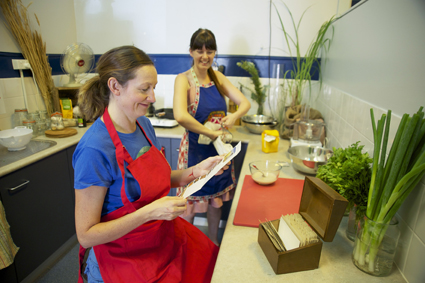
Sarah Rowbottom & participant, Slow Food Sunday (2012), Proximity Micro Festival of One-on-One Art
photo Ashley de Prazer
Sarah Rowbottom & participant, Slow Food Sunday (2012), Proximity Micro Festival of One-on-One Art
Finally, with a nod in the direction of relational art of the 1990s, Sarah Rowbottam’s Slowfood Sunday provided the chance to get back to the basics of the everyday in its mindfulness about consuming local produce. Thankfully there were more than two people to enjoy the meal. When sitting at the dinner table sharing wholesome food and talk of the day, one key point became apparent; there is something very special about being an audience of one, but there is also something poignantly lonely about it. In all the investigations of proximity, however physically close and conversationally intimate, the audience/performer divide remained. Against this background the dinner was a salvaging moment and potent reminder that gratifying proximity comes in such simple moments of everyday communal ritual.
2012 Fringe World: Proximity Micro Festival of One-on-One Art, curators James Berlyn, Sarah Rowbottam, provocateur Kelli McCluskey, presented by Blue Room & Proximity Festival; Blue Room Theatre, Perth, Jan 29, Feb 5, Feb 12, Feb 19
RealTime issue #108 April-May 2012 pg. 6
© Laetitia Wilson; for permission to reproduce apply to realtime@realtimearts.net
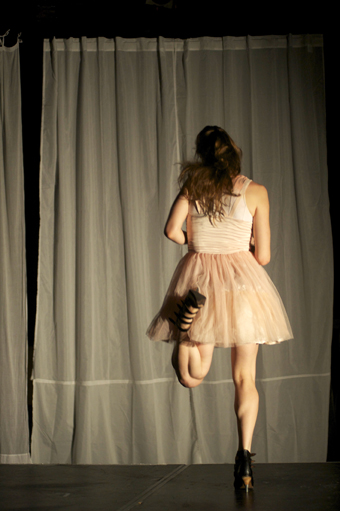
Jacqui Claus, Standing Bird
photo Ashley de Prazer
Jacqui Claus, Standing Bird
TWO INDEPENDENT PERFORMANCE WORKS GROUNDED IN DANCE FORMED A COMPELLING CHAMBER OF ECHOES IN FRINGE WORLD FESTIVAL’S DEBUT PROGRAM. ALTHOUGH COINCIDENTAL, STANDING BIRD AND TILTED FAWN’S DOUBLING IN PICA’S EARLY-AND-LATE-NIGHT SERIES INVITED REWARDING COMPARISONS ON THE NATURE OF THEATRE.
Both works centred on lone dancers and their interactions with diverse technologies that operated simultaneously as companion performers and scenographic environments. Standing Bird announced itself as a performance while Tilted Fawn chose installation as its frame but both pervaded spatial axes travelling memory, geographically determined by an Australian landscape in Standing Bird and played out in sonic terrains in Tilted Fawn.
Director Sally Richardson has long pursued sagas of women and wilderness in dance theatre modes, so Standing Bird is like a riven nugget isolated from that endeavour. In this manifestation, Jacqui Claus takes on the quasi-archetypal woman, her sinuous extent pushing against the calculated restriction of a central platform set. Alcoholic self-violation initiates the woman’s lost balance which is caught under a controlling light. The voyeuristic twist of this technical decision punctured the narrative skin, especially since the woman wielding the light was none other than the director herself. Perhaps the intention was to lay bare the workings of the production but its execution exposed power relations which left a bitter edge to the performance.
Imprisonment pervaded the radiant bride’s endless tulle and worked against typical Australian impulses of escape through the Australian coordinates of flight, sea and sand. Filmic projections of drowning on the bridal tulle—now transformed into a shroud—threw an unintentional shadow, its darkness redolent of the performer resisting victimisation. Otherwise, sand, like liberty, fell through fingers and toes, leaving Claus in a mirrored throwback of displacement, set up again by Richardson moving around the set—shackling this life of nudity and collapse.
From this baited position, the bird shudders and stands defiant, the dorsal extensions of her movement resonating with the rippling arms of Pavlova’s Dying Swan. But the angular struggle of emergence is given over once more to the creator who controls the light. Standing, this bird cannot fly.
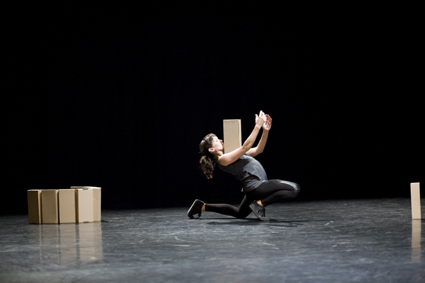
Melanie Lane, Tilted Fawn
photo Maik Reichert
Melanie Lane, Tilted Fawn
Melanie Lane and Chris Clark’s Tilted Fawn from Berlin carries its light and shade with sophistication. The dancer slowly shifts a few dozen cardboard bricks around the space, its concentrated execution enabling spectators to become attuned to the moving sound. Each brick bears a sonic voice within its taupe volume forming, under Lane’s meticulous listening and arranging, mesmerising miniature cityscapes that contribute thickness in the orchestrated space. There is a withheld dramaturgy in the pace which scatters in plaintive cries from the tiny structures when Lane leaves the stage. It is a potent moment when structures mutate into lost memories craving the substance of their being, like children grieving departing mothers.
Lane’s danced return—in fawn unitard stretched over platform footwear—introduces another sort of memory connection via Marie Chouinard and then back to Nijinsky’s Faun. Dance
lineage seems to situate this intervention, illustrating layers of recall which involve intertextuality as well as intimacy. The interlude is brief and soon the mother returns to her sonic strays. She tends her sonic memories with ever-increasing care until, no longer contained within the bricolage of individualised points of reference, they become an immovable force of sound. Her exhaustion in the final moments brings installation firmly into performance. The bricks have left home, have tilted strains of memory over into another space, the curious space of imagining.
For another response to Tilted Fawn see page 25.
2012 Fringe World: Standing Bird, director, concept Sally Richardson, performer Jacqui Claus, sound Kinsley Reeves, dramaturgy Humphrey Bower, lighting: Mike Nanning, costume Fiona Bruce; Tilted Fawn, choreographer, concept, performer Melanie Lane, sound composition, installation Chris Clark, artistic collaborator Morgan Belenguer, dramaturg Bart van der Eynde, costumes, props Melanie Lane, lighting Max Steizl; PICA Performance Space, Perth Feb 7-12
RealTime issue #108 April-May 2012 pg. 7
© Maggi Phillips; for permission to reproduce apply to realtime@realtimearts.net
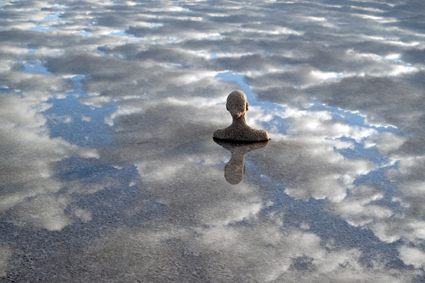
Julia Davis, Headspace, spaced 2012
courtesy the artist
Julia Davis, Headspace, spaced 2012
WESTERN AUSTRALIA IS INCREDIBLY LARGE AND QUITE EXTRAORDINARILY FLAT. OCCUPYING ALMOST HALF THE AUSTRALIAN CONTINENT, IT IS PRIMARILY DESERT AND MOSTLY UNINHABITED, WITH A POPULATION OF AROUND 2.3 MILLION. 73% OF WHOM LIVE IN PERTH, LEAVING A MERE 621,000 PEOPLE DISPERSED ACROSS 2,532,400 SQUARE KILOMETRES.
The ecology is fragile and geological features are often dwarfed by the immensity of space and sky. It is spectacular, rather than picturesque, excepting the scenic and temperate southwest corner. It’s not surprising that questions of space, place and identity are often at the forefront of artistic concern here. The downside of this preoccupation is the potential for a dreary form of parochialism. The upside is clearly visible in a project like IASKA’s inaugural Spaced exhibition, which draws on 21 Artist in Residence programs undertaken over a two-year period by artists and collectives, both Australian and from overseas.
the quality of engagement
Embedded in the curatorial ambition of the overall project is the desire to move beyond the privileging of artists parachuted into communities who make art out of the experience of ‘being there.’ Instead each project emerges from a negotiated and carefully managed partnership with groups and individuals from towns and communities spaced out (sic) across the state: from the Dampier Peninsula to Esperance, from the Abrolhos Islands to Leonora, from the mining town of Roebourne in the Pilbara to the coastal towns of Albany, Mandurah and Denmark and the very different wheat belt towns of Northam/Bakers Hill, Moora, Mukinbudin, Kellerberrin, Narrogin and Lake Grace.
Consequently Spaced is not only concerned with exhibiting art and its documentation, it also seeks to represent something of the quality of the engagements undertaken and the relationships developed in remote locations and small country towns over at least 10 weeks, and developed through what IASKA director Marco Marcon describes as a “decentred organisational structure.” The exhibition represents these relationships through an extended series of filmed interviews, encompassing the views of both artists and community members shown on wall-mounted LED screens in the hallway of the Fremantle Art Centre.
Inevitably, the exhibition represented only the tip of the residential iceberg. Of course this is true of most exhibitions. Whether socially engaged or not, few artworks speak to the experience of their coming into being. In this project the desire to foreground the experiences of not only the artists but also community members, led to a rich and complex, often paradoxical and occasionally confronting, series of artworks, conversations and engagements that will surely resonate long after the individual projects have ended.
Spaced also encompassed a weekend symposium, which sought to tease out some of the ideas, paradoxes and conundrums around ‘socially engaged practice,’ and to reflect on the processes of interaction between artists and communities. Whilst participating artists and community members spoke on panels about the experience of their respective residencies, five keynote speakers, including David Cross (NZ), Margo Handwerker (US), Ian Hunter (UK), Zara Stanhope and Ian Tully (VIC), punctuated the proceedings with reflections and provocations on thematically connected practices from other parts of the country and the world. It is ironic to consider that despite the plethora of residencies, exhibitions and artists’ projects taking place in remote and rural communities, and small towns globally, the idea that contemporary art practices are solely the provenance of first world, metropolitan centres such as New York, London and Tokyo, remains remarkably tenacious.
On the ground in WA, however, artists and collectives took up residence in small communities in strange locations. Even for local artists who might be expected to have an understanding of country and the complexity of issues confronting, for instance, Aboriginal and non-Aboriginal Australians, such projects can be as challenging as they are extraordinary. Sohan Ariel Hayes spent two months in Roebourne in the Pilbara, infamous for the tragic bashing death in custody of 16-year-old John Pat in 1983. It was clear from the outset that if a residency was to go ahead in this place, then much more would be expected than just another white fellah dropping by and building his career on the suffering of Aboriginal people.
birndi wirndi—worlds apart
Hayes worked closely with Michael Woodley, a filmmaker and CEO of the Juluwarlu Aboriginal Corporation, not only to create a meaningful art work but also running skills development workshops in editing and filmmaking. Ultimately they created a powerful and evocative projection project called Birndi Wirndi—Worlds Apart which projected images of Yindjibarndi people from Juluwarlu’s extensive digital archive, as well as footage from the two-part documentary, Exile and The Kingdom, which tells the story of the last 150 years from an Aboriginal perspective. In Roebourne, the work was projected onto the façade of the old Victoria Hotel which closed in 2003 at the request of the local Aboriginal community, given the catastrophic impact of the 1960s mining boom and alcohol. Hayes describes this project as an act of cleansing, an invocation, a summoning, and whilst the gallery-based work probably doesn’t carry the punch of the site specific original, for those of us who couldn’t be there, it remains a beautiful, powerful and poignant work.
locus deperditus
For another West Australian artist, Kate McMillan, the town of Leonora about 830 miles east of Perth, described in tourism-speak as the “historical heartland of the Goldfields,” was a transformative experience, allowing her to finally experience herself as Australian. For McMillan, this residency initially represented an opportunity to work with asylum seekers in the detention centre, however that impulse was transformed by the experience of witnessing first hand the impact of youth suicide, following the death of a teenage boy. The disparity between resources available to detained children and those for ‘free’ Aboriginal children saw McMillan adding the roles of advocate and networker to that of artist. She undertook developmental community arts projects, including drawing workshops at the Refugee Centre and cultural projects at the local Indigenous Youth Centre, persuading BHP to provide $20K per annum towards an ongoing program of artists’ workshops. McMillan also established a deep relationship with local historian, Jill Heather, whose work in recent decades has been to record the history and whereabouts of lonely 19th century graves across three surrounding shires, and it is the photographic documentation of those graves that represent McMillan’s residency in the exhibition.
ornitarium
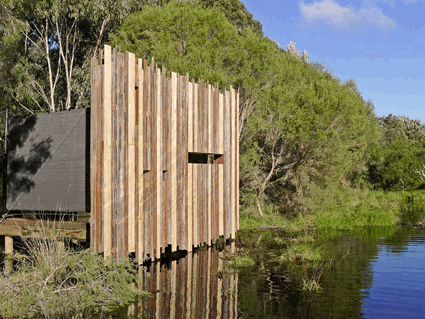
M12, Ornitarium
photo courtesy the artists
M12, Ornitarium
Not every project was so inherently confronting. Colorado-based collective M12 created the Ornitarium, an architectural sculpture situated at the Wetlands Education Centre—operated by Green Skills—in the softer climes of Denmark in the state’s southwest. The artists describe the project as being “inspired by ‘local knowledge’…specifically knowledge related to birds that populate the region’s wetlands areas, regional timber types and building methods. The work is designed and built as a bird hide and as a social space [for humans]…” The guest watcher can be in their own custom built nest inside the hide but camouflaged from the bird life on the other side. In the gallery they created an installation curated in partnership with master taxidermist Michael Buzza that included objects collected by Denmark locals, Basil Schur and Tina Smith.
headspace, levelled ground, in transit
Julia Davis created the haunting, site-specific work Headspace, casting her own head from salt harvested from Lake Brown. Over time, the head dissolved back into the lake. She developed another project called Levelled Ground, shown at the Mukinbudin Railway Station that visually represented digital information in a gold-leaf wall schematic, from recorded interviews with local people no longer able to live on their farms. At the Fremantle Art Centre she showed an interactive video work, In Transit, which documented the friendly but characteristically laconic gestures of acknowledgement made by local people as they pass by each other in cars and trucks.
the way you move me
David Chesworth and Sonia Leber’s beautiful and joyous video installation, The Way You Move Me, filmed in Moora, a wheatbelt town about 177 kms north of Perth, took its inspiration in part from Elias Canetti’s Crowds and Power. The experience is mesmerising, sometimes funny—there are sheep after all—and occasionally poignant. Handsome cattle lumber down the green hill chasing a small tractor, jostling for precedence, or cluster closely, gazing deeply into the camera lens. Sheep move constantly in and around each other, whether up close in pens or trotting down a country road, juxtaposed against paddocks of unbelievable greenness or the eye-bending golden fields of canola. Moments of intensity, changing rhythms and gaits, are interspersed with personal, almost transcendent moments of interspecies connection.
to the other end
In the gallery, the photographic documentation and blood-stained prayer rug that comprises To the Other End by Dutch artists Wouter Osterholt and Elke Uitentuis forms a savagely ironic juxtaposition to Chesworth and Leber’s bucolic video work. To the Other End follows the journey of live sheep exported from the small wheatbelt town of Lake Grace, 345 kilometres southeast of Perth, to the small island country of Bahrain in the Persian Gulf. It examines the use of sheep for both wool and for meat. Helped by local farmers and craftspeople, the artists learned how to shear a sheep and card and spin the wool, from which they wove a black and white copy of a Baluchi funeral carpet. After a year of knotting they completed the carpet and took it with them to Bahrain during the feast of sacrifice.
In Bahrain, they found an Australian sheep from Lake Grace and a local family to organise the ritual killing of the sheep on the prayer carpet during the feast. The meat was distributed to the poor. Photographic documentation included a portrait of the slaughtered sheep hanging on the wall of a small cell-like room, with the prayer rug saturated and stiff with black blood.
crayvox
Nigel Helyer spent an enviable two months travelling around the turquoise waters of the Abrolhos Islands, home of the rock lobster or crayfish, and described as the world’s first sustainable fishery site. Helyer’s interest in the future viability and sustainability of our marine economies is represented through sound and object with a beautifully constructed wooden boat, CrayVox, that resonates with the sounds and stories of fishing communities in both the Abrolhos Islands and in the restaurants and seafood importers of South-East Asia.
narrogin banksia tower
Polish artist, Jakub Szczesny and curator Kaja Pawelek, developed the concept of an 18-metre tower inspired by Australia’s banksia flower. Proposed as an interactive and functional artwork with a hairy surface responsive to passing cars and visitors, a model of the tower, animations and a prototype forms the basis of a proposal to the Shire of Narrogin to undertake its realisation. The project forms the basis of a forthcoming documentary by Polish artist and filmmaker, Matylda Salajewska for Europe’s Canal+ television.
Sadly, space precludes me from writing about every project in this inaugural biennale, but I wish to acknowledge the calibre of art works and projects developed by Australian artists Bennet Miller, Mimi Tong, Makeshift’s Tessa Zettel and Karl Khoe, Michelle Slarke and Roderick Sprigg, as well as Indonesian artist Ritchie Ned Hansel’s Abandoned Trolley Project, Japanese artist Takahiko Suzuki’s Global Store Project and French artists Marion Laval Jeantet and Benoit Mangin’s collaboration with SymbioticA.
emerging spaces for action
Spaced: art out of place, raises many vital questions about the role of art and artists, living sustainably, and the relationship of city to country. Most of us inhabit the cities and suburban margins and never really have to negotiate the complex relations that exist between species—whether domesticated or wild, indigenous or introduced, or to think about lack of meaningful infrastructure or cultural opportunities. It’s a cliché to say that we rely on country for life—for our food and water, for both physical and spiritual sustenance—and yet the divide between town and country remains a deeply felt schism in our everyday. Ian Hunter, in his provocative but stimulating paper, “Art and Agriculture–cultivating new metaphors for sustainability,” persuasively argued rural and non-metropolitan areas as new critical sites from which to think through relational, durational and ecological art and aesthetics—an emerging space of radical action. Less polemically, but equally passionate, Ian Tully talked of his more embryonic project, ACRE—Australia’s Creative Rural Economy, a project bringing together artists, arts workers and farmers in regional Victoria since 2009.
Spaced raises more questions than it could possibly hope to answer, but its ambition, generosity of spirit and willingness to experiment, and to generate what Marvin Carlson has described as “productive disagreement with itself” (1996), offered a radically different kind of biennial experience, one that actively solicited meaningful forms of ‘social engagement,’ while also allowing us to reflect on the wonder, the beauty and the terror of life on this planet we all share.
IASKA, Spaced: art out of place, inaugural biennial event of socially engaged art, exhibition Fremantle Art Centre, Perth International Arts Festival, Feb 4-March 11; spaced symposium, Feb 4, 5; www.iaska.com.au
Artists and residencies: Nigel Helyer, Abrolhos Islands; Mimi Tong, Albany; Philip Samartzis, Dampier Peninsula; M12 Collective (Richard Saxton, Kirsten Stolz and David Wyrick), Denmark; Makeshift (Tessa Zettel and Karl Khoe), Esperance; Ritchie Ned Hansel, Fremantle; Roderick Sprigg, Jakarta, Indonesia; Takahiko Suzuki, Kellerberrin; Wouter Osterholt and Elke Uitentuis, Lake Grace, and Michelle Slarke; Kate McMillan, Leonora; Art Oriente objet (Marion Laval Jeantet and Benoit Mangin), Mandurah; David Chesworth and Sonya Leber, Moora; Julia Davis, Mukinbudin; Jakub Szeczesny and Kajar Pawetek, Narrogin; Bennett Miller Northam/Bakers Hill ; Sohan Ariel Hayes and Michael Woodley, Roebourne
RealTime issue #108 April-May 2012 pg. 8-9
© Sarah Miller; for permission to reproduce apply to realtime@realtimearts.net
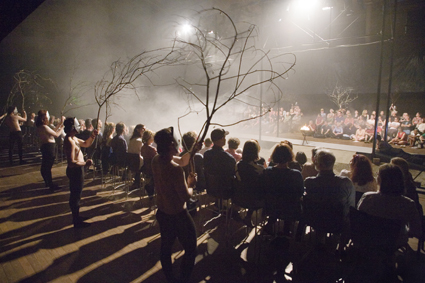
IHOS Opera, The Barbarians
photo Lucia Rossi
IHOS Opera, The Barbarians
HAVING LIVED IN TASMANIA FOR 10 VERY FORMATIVE YEARS, IT WAS A JOY TO RETURN TO THE ISLAND TO EXPERIENCE THE TRANSFORMATION THAT MONA (MUSEUM OF OLD AND NEW ART) AND ITS FOMA MUSIC FESTIVAL ARE WREAKING ON HOBART. MONA HAS SURPASSED THE HARROWING PORT ARTHUR AS THE PRIMARY TOURIST DRAWCARD IN THE STATE. THIS IS A SEISMIC SHIFT IN TASMANIAN CULTURE AND MARKS A PSYCHIC BORDER.
With the economy perpetually moribund, the state government has had no choice but to respond, spending $30 million on a long overdue upgrade of the Tasmanian Museum and Gallery, for which the first exhibition will be a combined effort with MONA. Tasmanians have certainly responded. It is deeply satisfying to see people from all walks of life happily queuing up, eager for the next MONA experience, the likes of which would only recently have been condemned in many quarters.
Everyone’s favourite Brechtian Goth-Punk, Amanda Fucking Palmer, truly made this edition of the festival her own. The Dresden Dolls’ reunion performance on the second Friday night won many converts with its vitality, the virtuosity of drummer Brian Viglione a revelation (think Terry Bozzio during his Frank Zappa years), but that was just the start. With The Death Grips sadly cancelled, Palmer and Viglione backed up the next night with a MOFO superband, joining Bad Seed Mick Harvey, PJ Harvey producer John Parrish and MONA FOMA producer and former Violent Femmes bassist Brian Ritchie to play the songs of the much-loved Violent Femmes debut album to a rapturous reception. The climax was a two-hour flat out Dresden Dolls set in the wee small hours of the final Sunday morning in the laneway of the Faux MO festival club, patrons hanging off fences and fire escapes and totally dizzy with disbelief that it was actually happening.
Wim Delvoye’s major exhibition at MONA is, according to its website, “provoking heated debate about the ethical integrity of his work” among staff. It features skins of the artist’s tattooed pigs and of “living artwork” Tattooed Tim. This comment seems surprising given MONA owner David Walsh’s well-known devotion to transgressive art, until you become aware of his vegetarianism; then the gesture becomes an admirable statement of commitment to the personal quest underlying the whole venture. This exhibition is the largest of Delvoye’s work ever assembled, with multiple Cloaca machines in addition to the one permanently installed at MONA, and numerous other works such as a life-size truck and wooden cement mixer carved in his meticulous and delicate filigree, plus playful distortions of Disney imagery that surely have that notoriously litigious franchise plotting a slow and painful retribution. Like MONA overall, the show overwhelms (most of) the senses: so much so that it ultimately creates a deficit of touch. There is so much work here about the body, yet bringing bodies and objects into contact is almost always forbidden in art museums, even a place like this.
In delicate contrast to Delvoye’s appropriation of Disney was the complete rejection of that corporate colonisation of our subconscious by the group Armiina, from Iceland. Originally an offshoot of Sigur Rós, they produced charming, winsome soundtracks to 1920s shadow-play films of classic fairytales by Lotte Reiniger, themselves a revelation. This was one of many intimate gems that were dotted about MONA FOMA. Another was Sonia Leber and David Chesworth’s sound installation Shape Shifter, which is simply one of the best explorations of interior resonances I have experienced.
I’m kicking myself at missing Michaela Davies’ While Rome Burns, featuring a string quartet powered by electro-muscular stimulation (there’s a great snippet on YouTube at http://youtu.be/6jTKfCCmT10) and not getting in early enough for a seat for Ed Kuepper. The only major disappointment, however, was oppressively stuffy (verging on unsafe) conditions for the PJ Harvey gig, which would have been far better suited to a seated auditorium.
The highlight of MONA FOMA in the week I attended was The Barbarians, a major new work by IHOS Opera commissioned for the festival. IHOS and its director Constantine Koukias are clearly revelling in their position as premier local artists for FOMA. Who wouldn’t? Brian Ritchie even supplied the poem that forms its libretto, “Welcome the Barbarians” (1904) by Constantine Cavafy. It explores the simultaneous fear of, and desire for, the other/unknown/invader, a fundamental strand in the vast expanse of Greek cultural history, overlaid with millennia of invasions, sometimes successfully resisted but many times resulting in cultural fusion.
The Barbarians is a landmark for the company, the third in the series of deeply personal major works that began with Days and Nights with Christ (Sydney Festival, 1992) and To Traverse Water (Melbourne International Arts Festival, 1995). That it has been so long in coming is a reflection of the personal journey of Koukias and his efforts to establish and maintain for 21 years a contemporary opera company. That he has managed to make work that is both cutting-edge and accessible in Hobart is all the more notable. Koukias achieves this balance through a musical language based in Byzantine Church chant, part of the root-stock of all Western music.
Scintillating visual and sound design are hallmarks, as are the sonorities of languages other than English, but what truly makes IHOS unique is the central role of movement in unfolding the text. This production saw the welcome return to IHOS of Melbourne-based Christos Linou as choreographer and dancer. His tour de force performance, naked for the entire show, was juxtaposed with the lush orchestration and polished singers and orchestra. The whole is bounded by sounds that genuinely create fear in the listener. Little wonder David Walsh attended twice and was reportedly raving in the festival club about this beautiful, transgressive masterpiece. This can only bode well for the future of IHOS and for contemporary music and performance in Tasmania.
Video excerpts from The Barbarians can be viewed on YouTube
2012 MONA FOMA, Hobart, Jan 13-22; http://mofo.net.au/
RealTime issue #108 April-May 2012 pg. 10
© Gavin Findlay; for permission to reproduce apply to realtime@realtimearts.net
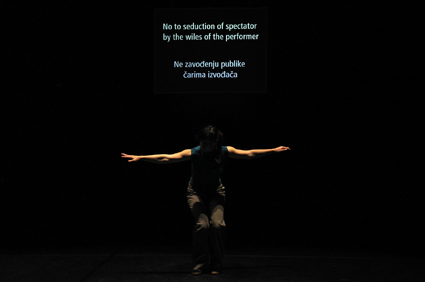
After Trio A, Andrea Božić
SOMETHING REMARKABLE HAPPENED AT THIS YEAR’S PUSH FESTIVAL. FESTIVAL DIRECTOR NORMAN ARMOUR DIED AND CAME BACK TO LIFE. HE SUFFERED A CARDIAC ARREST PART WAY THROUGH A CONCERT BY MARY MARGARET O’HARA AND PEGGY LEE. THANKFULLY, SOMEONE WAS ON HAND TO ADMINISTER CPR AND RESTART THE HEART—TEMPORARILY. ARMOUR’S PULSE AGAIN DISAPPEARED, BUT PARAMEDICS ARRIVED, APPLIED THE DEFIBRILLATOR AND THE PULSE WAS BACK. EN ROUTE TO THE HOSPITAL THE HEART WENT SILENT AGAIN. ONE MORE CHARGE OF ELECTRIC CURRENT TO THE CHEST WALL DID THE TRICK, AND ARMOUR WAS TRULY BACK AMONG THE LIVING.
Meanwhile, at the theatre, O’Hara sang “Body’s in Trouble” from her album Miss America, providing the perfect theme for a shocked audience seeking communal solace. There were those in the crowd who were friends of the fallen director, those who were simply concerned about the welfare of a fellow human being, and I suppose there were those who were unmoved. Spectators make their own meaning, even of such life-and-death theatrics. Did I say “theatrics?”
Actually, Armour’s unintentional performance was anti-theatrical—absolutely authentic, more in line with the kind of authenticity 1960s performance artists risked when they did things like deliberately get shot and slice themselves open with razor blades. Those artists are now distant progenitors of the typical hybrid performances featured at festivals like PuSh. A half-century later, 1960s notions of body-based authenticity have become just another set of aesthetic conventions, a style of performance if you will, no more and no less valid than any other. On the other hand, having a heart attack fulfills the requirements of the ‘real’ while providing the kind of high drama anti-theatricalists of the 60s viewed with disdain. Armour’s ‘performance’ collapses the argument. He becomes an appropriate symbol for a festival that welcomes traditional aesthetic opponents under the same umbrella.
andrea božić
It’s a coincidence that Andrea Božić’s contemporary dance piece After Trio A (Amsterdam) was on the program this year. Božić takes Yvonne Rainer’s iconic 1960s anti-theatrical dance solo Trio A and turns it into spectacle. The original work exemplifies principles articulated in Rainer’s 1965 tract, No Manifesto, in which the choreographer proclaims, “No to seduction of the spectator by the wiles of the performer.” The Trio A (1966) solo is non-seductive, non-narrative, and non-dramatic. There is no climax. Every part of the dance is given equal value. In theory it’s a performance stripped of pretence and artificiality. It must have felt urgent in its non-urgency back in the days when Rainer was part of a larger trend that included performance artists putting themselves through durational performances of great physical and mental rigour in order to stake a claim to authenticity while rejecting the illusionism of theatre. Chris Burden, famous for filming himself getting shot in the arm, once said, “Bad art is theatre.”
But it’s all theatre to the spectator. What constitutes too much or too little spectacle or virtuosity is always a matter of degree. In A Manifesto Reconsidered (2008) Rainer adjusts her original declaration: seduction, she writes, is “Unavoidable,” and virtuosity is “Acceptable in limited quantities.” Božić’s After Trio A, as well as her own playful tract, After No Manifesto, revises and partly refutes Rainer’s assertions. Two dancers (Claire French and Anne Cooper) learn Rainer’s original score while watching it on a monitor for the first time. They are able to approximate what they see due to their dance training. In 1966 Rainer was able to give every part of the original solo even weight due to virtuosic control of her own body. In 2012 Božić achieves in-the-moment authenticity by giving skilled performers a task they can’t rehearse.
In After No Manifesto Božić responds to Rainer’s caution against virtuosity with “Yes to imagination.” In an era in which we acknowledge that we are always performing versions of ourselves, there’s really no such thing as inauthentic performance, only authentic disguise. The ‘true’ you is a relative concept. The bare materiality of 1960s performance art—“I’m not pretending to be shot, I’ve really been shot”—has given over to “I’m really pretending to be shot.” Full circle.
chelfitsch
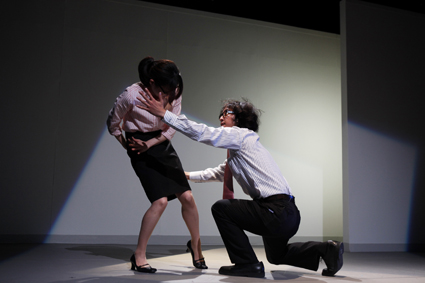
Hot Pepper, Chelfitsch
photo Toru Yokota
Hot Pepper, Chelfitsch
And yet the 1960s resistance to the cheaper sentiments of commercial theatre remains a guiding principle for much of the work at PuSh, as does the mistrust of dramatic peaks and valleys. The typical show tends to be kept within a narrow dynamic range (not too high, not too low), and performers tend to avoid over-expressing. This is certainly true of the mesmerising Hot Pepper, Air Conditioner, and Farewell Speech by Chelfitsch (Tokyo), in which choreographed movement based on everyday gesture is stretched to the edges of plausibility, but vocal and facial expression is restricted by office etiquette.
rabih mroué
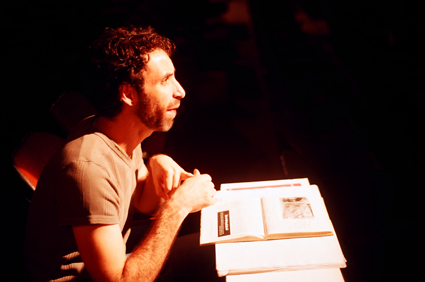
Rabih Mroué, Looking for a Missing Employee
photo Houssam Mchaiemch
Rabih Mroué, Looking for a Missing Employee
Rabih Mroué (Beirut), writer and director of Looking for a Missing Employee, adopts a Colombo-like faux naiveté while sifting through news documents that point to government collusion in the murder of a Finance Ministry worker. “Never trust a photocopy,” he says coyly while rifling through his own copies of articles from Lebanese dailies. Mroué renders even himself a copy by performing from behind the audience where a video camera projects his live image to a screen onstage. With such displacements, and with sly wit, Mroué gestures toward the guilty but never commits the aesthetic crime of shouting “Murderers!”
peter reder
Seduction of the spectator through understated personal charm is also a feature of Guided Tour by Peter Reder (London, England). This mock tour of the Vancouver Art Gallery has a thematic thread related to Walter Benjamin’s concept of “the angel of history”—a figure unable to repair the disasters of the past because it is being pushed relentlessly into the future by the fierce winds of paradise. Reder connects this concept to nostalgic constructions of our individual pasts. He provides a slideshow of family picnics at the beach, which might be from his childhood but—due to the generic quality of the images—could just as easily be from someone else’s. Like the angel of history, you can only reconstruct the past in your mind. In the meantime disasters will pile up. The success of this show ultimately depends on the rapport Reder establishes, through deft irony, with the small group of patrons he guides through the building. There are no startling revelations. Discoveries are kept in proportion. High drama is rejected in favour of intimate personal contact.
teatro linea de sombra
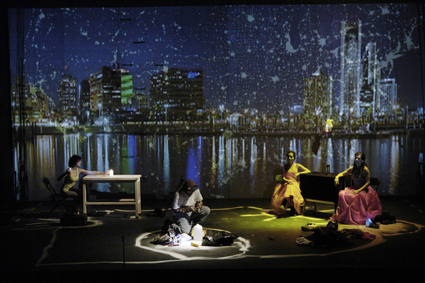
Amarillo, Teatro Linea de Sombra
photo Roberto Blenda
Amarillo, Teatro Linea de Sombra
Amarillo by Teatro Linea de Sombra (Mexico City) constructs the “probable” journey of a Mexican migrant worker who attempts a crossing into the USA. It begins with the packing of a desert survival kit that includes lemons for dehydration and painkillers for dealing with an 80-kilometre trek in 50 degree heat. It ends with death by drowning in a sea of sand. An upstage wall stands for the barrier between South and North. It is leaped at, climbed and pounded in vain by a man who will ultimately disappear. It also serves as a projection screen for the many surveillance quality cameras that shoot the action from above. Objects accumulate on the floor of the stage, and by the end we are looking through columns of sand, pouring down from above, at a projection of jugs full of blue water lit up by flashlights, as if a well-ordered and sentient constellation is trying to make sense of the dead man lying half-buried on the desert floor.
mario pensotti
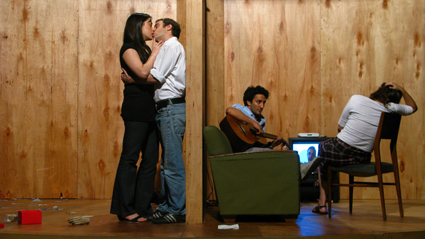
El Pasado, Mario Pensotti
photo Matias Sendon
El Pasado, Mario Pensotti
The action in El pasado es un animal grotesco by Mario Pensotti (Buenos Aires) keeps pace with the revolving stage on which interweaving stories of a number of 20-something urban Argentinians take place. The revolve itself is a beautiful plywood-clad thing, with rollers visible, and with scenic furniture stripped down to the bare living essentials. The characters that inhabit it are young and can’t afford to complete the furnishings—they are unfinished projects. Each is, in her or his own way, struggling to find a place in a globalised society in which individuals tend to be atomised worker/consumer units and personal connections are hard to sustain. Most of what happens to the characters seems accidental. As an actor exits a scene passing to the back of the revolve, she enters into and narrates another coming into view. The true narrative engine of the evening is the revolve, which is divided into quarters and is in almost continual motion throughout the performance. As a result the stories have a sense of forward momentum even though they unfold rather slowly. Like Benjamin’s angel, the characters can never go back, but neither are they propelled by a storm. Rather, they are continually nudged forward. Gentle as the push may be, the imperative of linear time is no less inexorable.
neworld/vancouver moving theatre
You might expect Fyodor Dostoyevsky’s The Idiot (Neworld/Vancouver Moving Theatre, Vancouver) to provide an old-school dramatic spike to those hungry for emotional punch. Seven years ago director James Fagan Tait (who also writes the adaptation) gave us the apotheosis of Crime and Punishment. The Idiot is a different kind of novel, slightly Chekhovian in the way character pretensions are consistently deflated. Tait’s Idiot is alternately ironic, sincere and down-to-earth, if a little liberal with the ‘F’ bombs. As with Crime we have the large, ethnically diverse cast made up of trained and un-trained actors, the spare staging, the beautiful group tableaux in which performers deliberately look like here-and-now Vancouverites in there-and-then attire, and the same quiet, unforced delivery that makes the spectator lean forward to catch every word. In keeping with much of the festival, performer expressivity is constrained. Even when Rogozhin (Andrew McNee) suffers a remorseful vocal utterance after murdering his lover Nastassia (Cherise Clarke), the momentary rupture is limited to a single, measured cry.
yes to seduction
There were a few shows at the festival that embraced melodrama, mid-20th century realism, or plain old kitsch. For me, these productions simply affirmed the value of the dominant aesthetic of the festival: don’t spoon-feed the audience. Of course, one can get over-cautious. In her 1965 manifesto Yvonne Rainer stridently demands, “No to moving and being moved.” Seriously? I want my money back. In 2008 she grudgingly acknowledges that “moving and being moved” is “unavoidable.” How terribly pinched. Andrea Božić counters, “Yes to transparency,” “Yes to enthusiasm,” “Yes to staying here.” I confess I go to performances hoping to be seduced. If you’ll indulge the allusion, seduction is acceptable as long as it occurs between mature, consenting spectators. The structure of the theatrical event provides the necessary “safe word.”
art, actually
And then there’s the fact of Norman Armour’s cardiac arrest. John Cage would have appreciated the circumstances: a chance “operation” occurring within the aesthetic frame of the festival. Parameters are established, and then what happens within them is “art.” Or is the heart attack too great a disturbance? Is it too real for art? Is it the aesthetic ‘body’ of the festival that is “in trouble,” as Mary Margaret O’Hara sings in her song? Probably not. Michael Boucher, the man who saved Armour, described the festival director’s collapse as “almost” comical. Ah, so it wasn’t tragedy, it was slapstick. Like the characters in The Idiot, we are rather impotent creatures. Our sufferings are real, but what does it all add up to? With Božić we must say, “Yes to confusion of the spectator”—ourselves. How can we authentically say otherwise? At the same time, in our relief at the survival of a fellow spectator, we can also say with Božić—and with Norman Armour—“Yes to staying here.” For as long as we can bear it.
2012 PuSh International Festival of Performing Arts, Vancouver, Jan 17-Feb 4; http://pushfestival.ca
RealTime issue #108 April-May 2012 pg. 12-13
© Alex Lazaridis Ferguson; for permission to reproduce apply to realtime@realtimearts.net
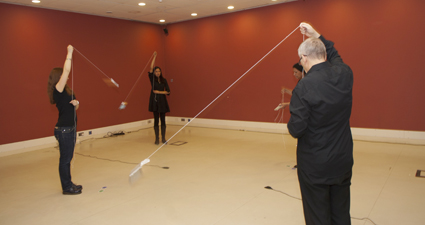
Greg Schiemer, Pocket Gamelan, Tate Britain Gallery, 2011
photo Don Boustead
Greg Schiemer, Pocket Gamelan, Tate Britain Gallery, 2011
SINCE ITS INCEPTION IN 2006 UNDER THE DIRECTION OF ITS FOUNDER, COMPOSER MATTHEW HINDSON, THE AURORA FESTIVAL OF CONTEMPORARY ART MUSIC HAS BECOME A KEY PART OF THE BURGEONING ARTS WORLD OF WESTERN SYDNEY, WHERE IT HAS BEEN PRINCIPALLY PRESENTED IN THE REGION’S FLOURISHING ARTS CENTRES.
Hindson directed three festivals 2006-10, the third playing host to the International Society of Contemporary Music (ISCM) World Music Day yielding an enormous program rich in diversity and invention.
In 2010, composer, arts manager, teacher and co-founder and co-director of Chronology Arts (RT97, p40), Andrew Batt-Rawden, was appointed director of the 2012 Aurora Festival. I spoke with him about his program and its evolution, asking how it felt to be an artistic director. “You get an opportunity to release your creative vision into the world, which is a lot of fun,” he declares with a laugh. “It’s very exciting, also very daunting and there’s a lot of work involved.”
As for the creation of the program, a committee was involved. The 27-year old admits “As a first time festival director, I was keen to surround myself with people I like and whose opinions and musical tastes I trust. We all researched projects and put them on the table. Only a couple of times did I think, no, not that event. It was a collaborative effort.”
I asked how conscious Batt-Rawden was in his programming of keeping in step with the diversity of forms of contemporary art music that take it beyond the traditional concert medium. He replies, “The last thing I wanted to do was to create a festival that didn’t reflect the culture of contemporary art music.” Consequently there are events like Super Critical Mass, a performative installation featuring 60 local musicians and an audience on the move; Pocket Gamelan, an opportunity for the public to play mobile phones that have become musical instruments; and AMPED, a performance for and with young people at the arts centre where they hang out on Thursday nights.
george lentz, zane banks
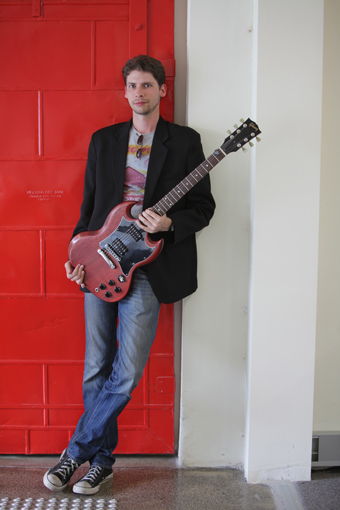
Zane Banks
Of course, there are concerts in Aurora but some of the contents might surprise: “I wanted to have a diverse range of events including some emphasis on electronics and noise,” says Batt-Rawden. He also notes the prominence of the electric guitar in the program was quite unintended. “It was organic. Originally we wanted to get Oren Ambarchi involved.” Then Zane Banks was added to the program, to play the Australian premiere of Sydney composer Georges Lentz’s Ingwe (from Mysterium, part of a large-scale cycle of works, Caeli errant…). Banks, who plays both contemporary classical and avant-garde rock and is the artistic director of Ensemble Ampere (an electric guitar outfit), premiered the 60-minute solo work in Luxembourg in 2007 and then recorded it for the Naxos label. As an admirer of what I’ve heard of Lentz’s Caeli errant… and an aficionado of the diverse capacities of the electric guitar, I’m very much looking forward to Ingwe (May 12, Campbelltown Arts Centre).
It’s fascinating to read on his website how Lentz came to write Ingwe: “One evening at the Royal Hotel, a pub in Brewarrina, northern NSW, a man sat alone tuning his electric guitar for that night’s rock gig. I was working on a piece for solo cello at the time but knew immediately that I should write something for the guitar instead—the loneliness and desolation of the place (and indeed my own loneliness) seemed to be encapsulated in that man’s sound…(www.georgeslentz.com/ingwe.html).
oren ambarchi & merzbow
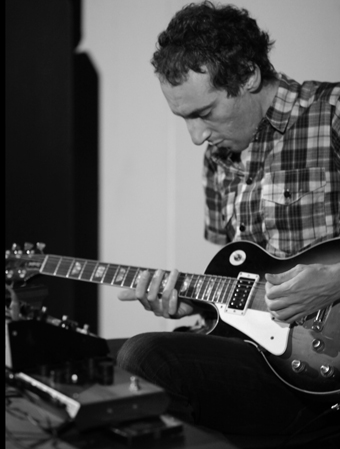
Oren Ambarchi, Judith Wright Centre, 2010
photo Brian Spencer
Oren Ambarchi, Judith Wright Centre, 2010
Oren Ambarchi’s superb electric guitar skills are widely admired—he has performed with a formidable list of adventurous fellow artists including Fennesz, Otomo Yoshihide, Keiji Haino, John Zorn, Jim O’Rourke, Keith Rowe, Dave Grohl and Phil Niblock. On March 1 this year he premiered John Cage Portrait, a work for electric guitar and orchestra, with the Iceland Symphony Orchestra at the Tectonics Music Festival. For his solo performance on May 8 at the Joan Sutherland Performing Arts Centre Ambarchi says he will be playing guitar and “some pretty antiquated effect pedals… it’s usually something quite simple that’s explored over 30-40 minutes—a motif or idea slowly unfolds over time. Hopefully it’s something where both myself and the listener lose ourselves.”
The inclusion of Ambarchi in Aurora is indicative of the increasing overlap between contemporary classical and experimental musics, an inclusiveness in this festival which extends to Tokyo guest, noisician Merzbow (Masami Akita) on his second visit to Australia to present an improvised performance of extreme noise using a combination of laptop and analog equipment at Riverside Theatre, May 11. In a second appearance at Campbelltown Arts Centre on May 13, he’ll duet with Oren Ambarchi for the closing night of the festival. Ambarchi, as part of Sunn 0))), has played with Merzbow previously in Tokyo, an experience he describes as “really special…I’ve always considered Masami’s music to be psychedelic, in the true sense of the word. Psychedelic, in the sense of losing yourself in the sound. I get a feeling of momentum, when his stuff is really working. So I’m hoping the collaboration will go down that road.”
Batt-Rawden feels that “noise is a pretty important part of contemporary music. It’s a good investment to bring Merzbow from Japan.” As well as his prodigious musical output, sound installations and collaborations with Sonic Youth, Mike Patton and others, Merzbow’s work includes musical protests against whaling.
synergy, clocks and clouds
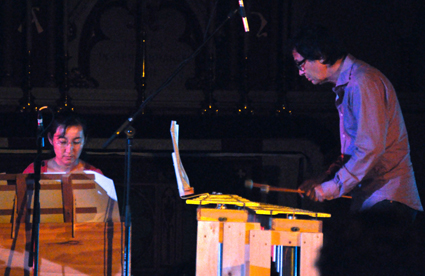
Terumi Narushima, Kraig Grady, Clocks and Clouds
On Aurora’s percussion front, at Casula Powerhouse on May 5, Synergy will interpret works by Amanda Cole, Marcus Whale, Alex Pozniak and James Rushford, the outcome of the group’s first Emerging Composer Initiative, a much-needed opportunity for composers to meet the very particular challenges of writing for percussion. Also at Casula Powerhouse on the same night, the performer-composers of Clocks and Clouds, Kraig Grady and Terumi Narushima, will doubtless feature the transcendent sounds of their distinctive, retuned vibraphone and pump organ and other instruments constructed by Grady.
marshall mcguire
Another instrument rarely privileged with solo outings is the harp. Anyone who loves virtuoso Marshall McGuire’s Rough Magic (1999) and The Twentieth Century Harp (2002) CDs—paired as a double CD, charM, by ABC Classics in 2007—will not want to miss his concert of 21st century compositions on May 6 at St Finbar’s in the Blue Mountains, an invaluable and rare opportunity to hear what’s happening with that magical instrument in our own time.
chamber made opera
At the Riverside Theatres, Parramatta, May 9-11, Melbourne’s Chamber Made Opera (see p36) will present Minotaur The Island which premiered on Bruny Island in Tasmania’s Ten Days on the Island festival last year. The work is an imagining of the lost 1608 Monteverdi opera L’Arianna: “We see the conception of Pasiphae, King Minos’ mail order bride, who has become obsessed with the bull of heaven. She gives birth to the monstrous Minotaur, part bull, part human. The Minotaur grows and becomes ferocious, needing to devour men for sustenance, and as a consequence is locked away, in a gigantic labyrinth (press release).
chronology arts & dirty feet; daniel blinkhorn
Chronology Arts and Dirty Feet dance company unite to present Vitality, a series designed to bring together composers and choreographers. The first in the series is Quest, in which choreographer Martin del Amo and composer Alex Pozniak “explore a young girl’s ‘blind’ discovery of sound and movement.” It will be presented May 12 at Campbelltown Arts Centre on the same bill as sound artist and composer Daniel Blinkhorn’s performance drawing on his field trip to Antarctica.
greg schiemer
The ever-inventive composer and electronic instrument builder, Greg Schiemer has created Pocket Gamelan for Mobile Phones (Campbelltown Arts Centre, May 13). Batt-Rawden says it was “an opportunity that came up and was not to be missed! [Schiemer] has networked a set of mobiles, programming them with music software and showing non-musicians how to use them—like swinging them around your head! It’s quite spectacular and the implications for using everyday technology instrumentally and collaboratively are amazing. It creates musical ensembles and is available to everyone.” The work, which premiered at London’s Tate Gallery in April 2011 combines electronics and voices, using Schiemer’s Mandala App (see image page 14).
luke jaaniste & julian day
Further audience engagement outside the concert sphere will be found at Blacktown Arts Centre where Luke Jaaniste and Julian Day invite their audience to amble room to room to encounter 60 musicians performing Super Critical Mass for the festival’s opening on May 4. This performative installation should offer a truly distinctive aural and spatial experience—”like wandering through a soundscape,” says Batt-Rawden. “I’m not allowed to tell you the instrumentation because it’s going to be a surprise.”
chronology arts
Chronology Arts has conducted a couple of workshops with “the young people who hang outside the Joan Sutherland Performing Arts Centre in Penrith on Thursday nights,” says Batt-Rawden, “any number from 50 to 200 playing games, basketball, dancing sporadically in a non-threatening, almost festive atmosphere and very receptive to what will engage them. For AMPED we’ll be there May 10 with interactive electronics, microphones, keyboard, guitars [Zane Banks’ guitar quartet] and a Max/MSP program to create a duet between electronics and human input—and let the kids have a go. Chronology will do a concert and hope to coax some of the kids to perform.”
alicia crossley
Also at the Joan Sutherland Performing Arts Centre, recorder player Alicia Crossley will be conducting a program aimed to get school children involved in music, a project, says Batt-Rawden, that centre hopes will have a longer life.
open access
I ask Batt-Rawden if it’s important that works like AMPED, Super Critical Mass and Pocket Gamelan provide a very accessible experience of contemporary art music. “Yes, we wanted to break down a number of barriers to contemporary music. Another of these is distance, which is why we’re doing the festival in Western Sydney. Pricing is addressed, including some free performances, like Super Critical Mass. And then there’s understanding, hoping people will be open to something possibly quite alien. You need an open mind to enjoy it—there is no fixed way to experience music. Open yourself to it and you will get something from it.”
Aurora Music Festival, Western Sydney, May 4-13
Industry forum, “Sustainable Music Business Models,” chair John Davis, CEO Australian Music Centre, Campbelltown Arts Centre, May 12 www.aurorafestival.com.au
RealTime issue #108 April-May 2012 pg. 14
© Keith Gallasch; for permission to reproduce apply to realtime@realtimearts.net
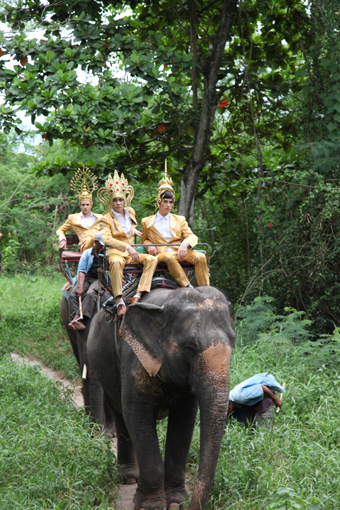
Nathan Beard, Casey Ayres, Abdul Abdullah, Greater Asia Co-Prosperity Sphere
photo Tada Hengsapkul assisted by Lee Anantwat
Nathan Beard, Casey Ayres, Abdul Abdullah, Greater Asia Co-Prosperity Sphere
THE GREATER ASIA CO-PROSPERITY SPHERE IS A TRIO OF ARTISTS AIMING TO REPRESENT ALL ASIAN NATIONS. THEY DRESS IN GOLD SILK SUITS, GO ON ELEPHANT-RIDING HOLIDAYS IN THAILAND AND ARE AMBITIOUSLY TAKING ON A DISCUSSION ABOUT THE JOYS AND ODDITIES OF MARRYING ASIAN AND AUSTRALIAN CULTURE.
Family history is something many of us only discover at funerals. Unbeknownst to us, Great Aunt Mabel was a glamorous socialite who seduced prominent thespians, or Poppa John had crossed the border into Austria as a fugitive. For Australians, discovering notoriety or exoticism in the bloodline seems a kind of jackpot. We speak with bright-eyed pride of convict ancestry or our genealogical fractions of Romany gypsy or European royalty, despite the manifestation of this rare link in our lives being minor.
Perth artists Casey Ayres, Nathan Beard and Abdul Abdullah have begun the excavation of their familial heritage early, making sure to fully absorb every ounce of romance, humour and melodrama into their ostentatiously titled collaboration, The Greater Asia Co-Prosperity Sphere. The three early career Perth artists were drawn together by their shared backgrounds: each has an Asian mother and a white Australian father, and was brought up in a Western Australian household that maintained traditions from both cultures. This meant the co-existence of primetime sitcoms with Buddhist ritual, pork buns beside fairy bread at birthday parties, and at all times a heightened awareness of the way Asian culture had been translated by their parents into everyday Australian life.
Nathan Beard’s father met his mother on holiday in Thailand in the late 1970s, during a break in his job as a federal policeman. After their move to Australia and the birth of their son, Beard’s mother ensured her traditional Thai cooking and a strong dedication to Buddhism “tethered” the boy to Thai culture. “I’d always sympathised more with my mother’s side of the family. I think as I got older and started to realise the cultural alienation that she took upon herself, divorcing herself from her heritage, I started to feel sorry about it. So I wanted to investigate that further.” Beard has been working on ‘quasi-collaborative’ pieces with his non-artist mother for years, contracting her to paint family portraits or asking her to model for his photographic recreations of classical paintings.
Casey Ayres’ mother is Malay-Chinese and his late father the son of English immigrants. He guesses this makes him a second generation Australian, though his laid-back attitude, penchant for backyard barbecuing and laddish accent suggest he’s got more than his share of the Antipodean in him. Ayres’ examination of his roots began only recently: “When the project came up, I really knew nothing about my cultural heritage whatsoever, so I thought this was a good way of exploring it. Also the food! Any place that makes so much good food, I want to know more about.” A skilled machinist with both camera and car, Ayres’ practice usually involves the photographic glorification of his beloved Ford Escort.
Clearly fascinated by the complexity of his background, Abdul Abdullah details his family biography as though he’s memorised it: “My mother is Malay, my father is Australian, I am seventh generation Australian, descendant from convicts despatched here in 1815 for stealing two stamps and a watch chain.” Abdul’s father converted to Islam and his parents moved to Australia to make their home in the early 1970s. As an Archibald finalist and 2011 winner of the Blake Prize for Human Justice, Abdul’s thriving painting practice has opened up discussion about what it means to be a Muslim Australian.
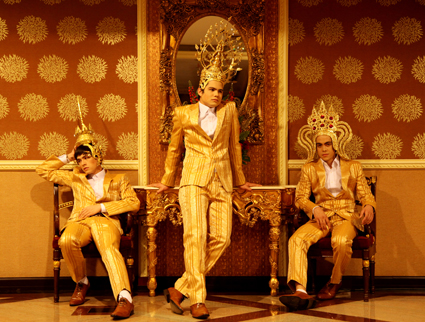
Nathan Beard, Casey Ayres, Abdul Abdullah, Greater Asia Co-Prosperity Sphere
photo Tada Hengsapkul assisted by Lee Anantwat
Nathan Beard, Casey Ayres, Abdul Abdullah, Greater Asia Co-Prosperity Sphere
Thrown together by otherness, Beard, Ayres and Abdullah have formed a kind of artistic solidarity. Not only do they have Asian mothers in common, but each has experienced parental suspicion or confusion about their art practices, particularly when it came to researching family history. Collaboration seemed natural.
The trio consider themselves emblematic of an Asian-Australian nexus. At first this led to casual experiments into culture jamming, in particular forming a hypothetical boy-band called Beige. The name had an unexpectedly decisive effect on the way the artists worked together. Beige, being the colour of non-specificity, allowed them to consider their very varied heritage under a single category—as Asian-Australian heritage in general. It gave them permission to hybridise their autobiographies, research themselves, each other, the West, the East and all Asian nations with equal attention, attachment and entitlement.
It was at this point that Abdullah, Ayres and Beard became The Greater Asia Co-Prosperity Sphere. Named after an anachronistic proposal penned by Japanese Prime Minister Fumimaro Konoe in the 1940s, the artists used their collaboration to pool their experiences with Asian culture. What formed was a kind of ambassadorial unit, documenting an often humorous “glance at all of Asia,” as Abdullah puts it. The Sphere made research trips to Singapore, a once imperialised multicultural hub, and Thailand, a country with unusually strong mercantile ties with the West.
The GACPS project, which will be exhibited at the 2012 Next Wave festival, and is supported by Next Wave’s Kick Start program, will take the form of a comprehensive, experiential and highly multi-media installation: a pan-Asian embassy. Built in Melbourne, the embassy will be filled with an array of Asian decorative objects manufactured by the artists, representing the whole spectrum from traditional to kitsch. Think brush-painted banners, red lanterns, Maneki Neko waving cats and gold thrones as well as a full program of dance, music, craft and cooking activities.
The artists have merged themselves into the project as gaudily dressed yet sombre dignitaries, for an embassy certainly requires the presence of ambassadors. They will don a uniform they call the “Plada suit,” a bright gold silken two-piece topped with a gilded Thai headdress, perhaps as incongruous to Australian life as Imperial safari outfits were to jungle outposts in the 30s, or an Indonesian batik shirt on John Howard. In costume, the trio must perform their ambassadorial duties, explains Beard: “Importantly, what we’re going to be doing is facilitating an engagement with the space for audiences, trying to get people to think beyond the immediate experience and open up a dialogue. How were they raised with ideas of multiculturalism in an Australian context?”
A kind of pastiche of a World’s Fair pavilion, the embassy will provide gallery patrons with an experience that is equal parts sincerity and humour. The GACPS ambassadors have practised developing humorous access points between themselves and an audience. Recently, they’ve appeared in full costume at karaoke bars, for studio talks at Perth Institute of Contemporary Arts and attempted to correspond with some of Australia’s most prominent Asian-Australians such as Penny Wong, Lee Lin Chin and Shaun Tan. This willingness to point out and then embody the absurd dissimilarities that exist between all cultures has quickly endeared the artists to their audiences. Ayres attributes this to their willingness to demonstrate “a sense of communal humiliation.”
While the object of the embassy never approaches social activism, it certainly exists within a climate of what Abdullah calls “increased multiculturalism” and cultural sensitivity. Perhaps it is fair to say that Australia’s complex historical relationship with Asia, the strength and diversity of Asian culture here and also the laconic Aussie sense of humour have created the perfect environment for The GACPS collaboration to thrive.
If everything about this project is loud—gold veneer, manifestos, cultural clashes and comical performance—it is still autobiography that has allowed the artists to foreground the issues of nationality, family and borrowed culture. This is a personal project for each artist. They have reclaimed a place for themselves between two cultures that would once have been described as marginal, other or “neither here nor there.” In this territory they have made themselves educators, cultural liaison officers, translators and ambassadors to both Australia and Asia, helping us to comprehend and relish a world in which language, art, music, food and tradition may all be so easily borrowed and just as easily misunderstood. The collaboration “reflects upon that innate sense of confusion that arises when you’re stepping in between two cultures. We want to open up an earnest exploration to allow people to figure out, bearing in mind all these differences, how they negotiate their own sense of identity, their own sense of cultural confusion.”
The embassy of the Greater Asia Co-Prosperity Sphere will be installed in the Ian Potter Centre by Federation Square in May 2012 during the Next Wave Festival: The Space Between Us Wants To Sing.
RealTime issue #108 April-May 2012 pg. 15
© Sheridan Coleman; for permission to reproduce apply to realtime@realtimearts.net
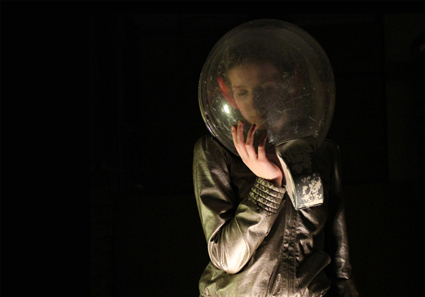
Zoe Meagher, Goodbye CSIRAC
photo Matthew Kneale
Zoe Meagher, Goodbye CSIRAC
ARTISTIC DIRECTOR EMILY SEXTON SEES NEXT WAVE 2012 AS “A SOCIALLY AND POLITICALLY ENGAGED FESTIVAL. WE WANTED TO CREATE AN EXPERIENTIAL DYNAMIC IN THE WAY YOU SEE ART.”
To this end, the festival invites you to start each day with a couple of hours at the Breakfast Club at the Wheeler Centre for Writing, Books and Ideas over coffee and the provocations of visiting international curators. Then you can spend the rest of the day exploring a variety of shows, installations and events across the city. Create your own trajectory or take up the festival’s offer of a choice of nine different day passes, each with a guide and each from breakfast to late night. That means sharing the experience with a group of fellow audience members for a day: “That’s where the cut and thrust is to be had,” says Sexton, “in the dialogue you have before and after experiencing an artwork and we wanted to make that as easy as possible.” She makes the point that the festival presents multidisciplinary works but wants to create a multidisciplinary context—hence this sharing: “It’s about our own practice as a festival.”
Consequently, Next Wave 2012 has an emphasis on “people coming together around everyday experiences expanded into intense versions: breakfasts, a wedding, markets, walks—all exploded into a contemporary art context. Next Wave is not like mainstream arts festivals that make certain promises. It’s about people exploring things and taking risks, so you have to create an environment that is about risk as well. I thought a lot about great music festivals: you go for the headliner but it’s the unknowns that everyone talks about afterwards. So we wanted to give people the opportunity to be surprised.”
Sexton emphasises the role of collaboration underpinning Next Wave: “Artists have made their work in collaboration with an amazing diversity of people in and around the arts. Elizabeth Dunn, for example, has created a beautiful project called Flyway in collaboration with birders for the last two years. Driving the great Australasian migration flyway up the east coast of Australia from Melbourne to her home in Queensland, she stayed along the way at migratory hotspots where birders live who generously opened up to her. Dunn made the journey into a metaphor, layering it over Melbourne to create a migratory walking tour from Carlton to Dockland mirroring her own journey.” Video monitors showing birds and locations will be encountered on the walk, the sightings aided by small binoculars for each walker. The sonic element will be provided by Brisbane sound artist Lawrence English.
In No Show’s Shotgun Wedding, gay artists Mark Pritchard and Bridget Balodis, who have been attending weddings and talking with priests for their research, will create an apparently very realistic wedding experience. The audience are the guests, eating, dancing and engaging with all the activities that come with, says Sexton, “one of the strongest of social rituals, one where many people fall back on tradition.” She describes this theatre work as insightful and very funny.
Next Wave 2012 features artists from across the country: “We really see it as a national festival—how many strange hotels have I been sleeping in over the last 18 months while searching for the artists who are the bravest and most curious in their practice.” As for artists beyond Australia, Sexton in her first year as director is focusing on making connections. Consequently, “Next Wave has created a residency program for emerging international festival directors and curators—people who are starting up things in different ways in the UK, Beijing, Korea, Indonesia and New York. Some we know well, some of it’s a bit of blind date, but we’re looking forward to a deep conversation with long term results.”
As for Next Wave 2012’s political dimension, Sexton describes the last two years as “a very strange time, with more and more people taking to the streets, but not always being able to articulate why they want change. I think that’s where art comes in so strongly because it uses the unconscious to help articulate our feelings. And not didactically. It’s all about discussion.” She cites Dan Koops’ The Stream/The Boat/The Shore/The Bridge, in which you’ll find yourself on a boat negotiating the Yarra, games and adventures while “thinking about our use of resources from a problem solving perspective.” Sarah-Jane Norman’s work, Bone Library (at the Melbourne City Library), about the loss of hundreds of Aboriginal languages, in which she carves their names on animal bones, is described by Sexton as “very mournful about what is dying around us that we can and can’t see.”
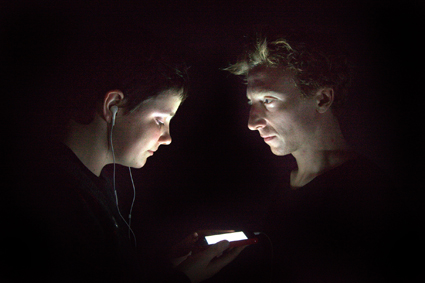
Skye Gellmann, Blindscape
photo Dom Bonnice
Skye Gellmann, Blindscape
Sexton says that she and her team started thinking about Next Wave 2012 in terms of generosity and urgency. “Urgency prompts us to make political work, while generosity is more complex—artists giving away parts of themselves and their ideas, often without reward.” Next Wave, with its mix of free and modestly priced ticketed events and the space it offers young artists to meet and challenge an audience bespeaks the political power of generosity. Sexton pays tribute to another kind of largesse, the advice received “from Next Wave alumni like Martyn Coutts, Willow S Wieland and Lara Thoms,” who in their own work in previous Next Waves, says Sexton, so effectively articulated cross-art practice which is, she emphasises, now no longer seen in terms of a clash of forms but as innate to contemporary practice.
Reading the Next Wave media kit I was struck by the sheer inventiveness, on paper, of many of the works soon to be realised. They include, from over 40 works, Team Mess’ Bingo Unit, participatory filmmaking and a backlot tour; Robin Hungerford’s Shamanic Organic Contemporary Cuisine cooking show; Talon Salon, an intimate audio theatre show and nail treatment in one, presented in an actual nail salon; The Greater Asia Co-Prosperity Sphere, a mock embassy (see p15); Fresh Produce, works presented in the Queen Victoria Market; Skye Gellman’s Blindscape, physical theatre experienced through iPhone and other intimacies; Creo Nova’s “proximity controlled xylophones, megaphone whirlwinds, singing plants and deep-sea gurglers”; and Tiffany Singh’s Drums between the Bells, one thousand strands of bells hanging from an elm tree in Melbourne’s City Square.
Zoe Meagher’s Goodbye, CSIRAC, in the Melbourne Museum, is a sound and performance work about Australia’s first computer “and its forgotten female operators”; Kel Mocilnik and Alison Currie go In the Pursuit of Repetition (fame and squalour) in a dance, visual and performance work for the duration of the festival beneath Federation Square; in Physical Fractals dancer Natalie Abbott and collaborator Rebecca Jensen “will produce intense sound effects by hurling microphones into the space and generating feedback from squeaky amplifiers”; in Exchange, Justin Shoulder will perform with Dewey Dell (Italy), an offshoot of Societàs Raffaello Sanzio; in The Warmth of the Curve, Michelle Sakaris explores cross-cultural walking practices; in Wheyface by Daniel ‘Room 328’ Santangeli, three post-apocalyptic curators “erroneously piece together the history of humankind”; and in Wintering, dancer Aimee Smith draws on her experience of the Arctic Circle to ask what it means “to live in a changing and disintegrating world?” And that’s a mere handful of works from a packed program that promises intense engagement, risk and dialogue.
2012 Next Wave, Melbourne, May 19-27, nextwave.org.au
RealTime issue #108 April-May 2012 pg. 16
© Keith Gallasch; for permission to reproduce apply to realtime@realtimearts.net
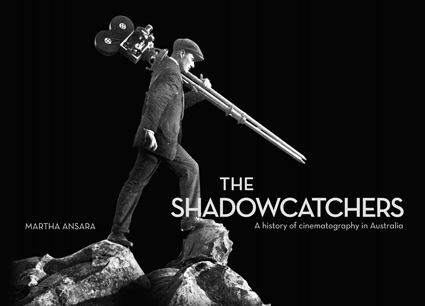
book cover The Shadowcatchers, A History of Cinematography in Australia
THE BOOK WILL BE BEAUTIFUL. IT’S COFFEE TABLE BOOK SIZE, AND IT’S FILLED WITH OVER 380 PHOTOGRAPHS OF AUSTRALIAN CINEMATOGRAPHERS WORKING ON FILM SETS FROM ALMOST THE BIRTH OF CINEMA TO THE PRESENT.
There’s a rich and detailed text, covering the history of film production in Australia but told very much from the cinematographers’ perspective, and there are fascinating and often very funny biographical sketches of many of those who have worked behind the camera throughout that history.
It’s The Shadowcatchers: a Photographic History of Australian Cinematography, and when it is finally published next month it will be the culmination of an eight-year labour of love by the Australian Cinematographers’ Society and, in particular, ACS members Calvin Gardiner and Martha Ansara.
In the very comfortable ACS clubrooms in North Sydney I talked to Gardiner and Ansara about how the book came about. (These are clubrooms which are well used by the very involved ACS members; there’s a terrific library, excellent screening facilities where they view one another’s work and an extensive and fascinating collection of donated cameras and other film equipment.)
It’s well known that Australian film crews are hugely respected in the industry, both locally and overseas, cinematographers particularly so. (There are five Australian Academy Award-winning cinematographers: Dean Semler, Andrew Lesnie, Russell Boyd, John Seale and Dion Beebe.) In fact, as I say to them, the one person who has been absolutely essential to the making of a film since filmmaking began has been the one behind the camera.
Calvin Gardiner (“a superb cinematographer,” says Ansara) who was inducted into the ACS Hall of Fame in 2009, is a committee member of both the NSW and Federal Executive and was elected as NSW President in 2008. His father, Jack Gardiner, was also ACS Federal and State President.
lunatics, obsessives & individualists
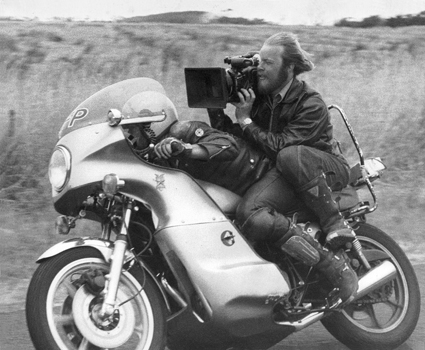
Terry Gibson (driver), David Eggby (DOP), Mad Max (1979)
courtesy David Eggby
Terry Gibson (driver), David Eggby (DOP), Mad Max (1979)
Gardiner says, “that’s what the book is really about; the cinematographers—their lunacy, their obsessiveness, their individuality. It’s about the people; what they do, how they feel, what they do to get the job done. It tries to find out, but doesn’t quite answer the question, why do they have such high standards? It used to be a fairly carefree, larrikin, fuck you mate, I’ll do it my way attitude that prevailed,” he explained, “and it’s still there, but underneath, more concealed.” “Perhaps it is, as John Seale says, ‘something they put in the beer’,” adds Ansara.
While she says that Gardiner really instigated the book, they both put the idea to the ACS Committee, back in 2004. “The original idea was to have it ready for the 50th anniversary of the ACS, which was founded in 1958; but it was much harder, and took much longer, than we expected,” she explained.
from oral origins
Ansara had interviewed many cinematographers while recording their oral histories and this was a great starting point for the project. One of the first women in Australia to work as a cinematographer, she later became a director and producer of prize-winning social documentaries, also teaching film production and writing historical and critical articles on film for a range of publications. She was the founding convener of the Film & Broadcast Industries Oral History Group, and has contributed nearly 100 oral histories to the National Film & Sound Archive.
How did that start? I asked. “In 1977, when I was a cinematography student at AFTRS, we were required to write a paper, and I wanted to write one that would teach me something about the close-knit group of cinematographers who seemed to dominate everything in those days and who, it seemed then, would never accept a woman into their ranks,” she explained. “At that time, there was so little written information (still largely the case) that I had no other choice but to ask the older cinematographers to tell me their histories. Among them was Bill Trerise, who started in film as a spool boy at the Lyceum before the First World War. It was he who said, ‘They used to call us the Shadowcatchers,’ and so that’s what I called my very naive paper—and now this book.
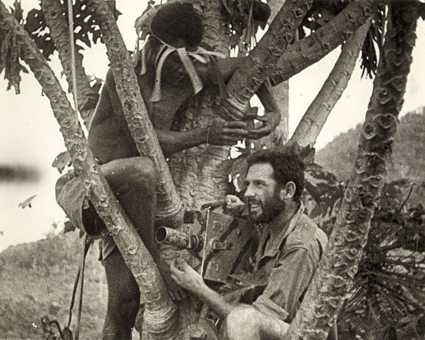
Damian Parer, cinematographer
“It turns out, however, that any woman who demonstrates real ability and love of cinematography is accepted despite the prejudice. And today, the men who run the ACS, brought up as they have been in the fiercely masculinist culture of Australian cinematography, make that extra effort to respect and promote the work of women cinematographers. And I respect them all the more for doing so because they act out of a consciousness which doesn’t come naturally and in some ways goes against their upbringing. In the book, there is quite a lot about this upbringing—the apprenticeship in attitudes as well as skills—which, until relatively recently, was how young teenage boys became cameramen,” she says.
integral to the industry
Although she’d done the oral histories and talked to people who told her about how things really were, Ansara said that once she began the research she discovered just how integral to the industry the cinematographers were. “They shot the film, they directed, they had very little film so they’d shoot so that everything they brought back to the editor was useful. Up to the 60s,” she said, “the industry was actually driven by cameraman-directors, who not only made the films but formed companies. Most of the filmmaking was in reality workplace, corporate or industrial documentaries, commercials, filmmaking that lent itself to such small-scale operations.”
“In fact,” added Gardiner, “the production of commercials actually underpinned and supported local production until it was lost through the free trade changes, when people who didn’t understand its importance didn’t fight for its retention—although it was probably doomed, anyway. In the book we highlight the role of commercials and their importance in the wider industry—you really get to hone your storytelling skills when you have to tell a story in 15, 30, or 60 seconds!”
the making of shadowcatchers
“Producing the book,” Ansara said, “was like making a film. First we gathered our material—the interviews, my background research and over 4,000 pictures. Then we did an edit, choosing the photos we would use and organising them, and then we ‘added sound’—the text. It’s just like a film, except that it doesn’t move.”
And how did they get the photos? “We put out appeal after appeal to the members; we asked for great photos that were good in themselves and said something about the art of cinematography—and we got thousands,” said Gardiner. “Martha also researched the picture archives of the NFSA and Film Australia and found some great images, and we got some from the War Memorial. And still pictures kept coming in. We literally looked at over 4,000 photos to find the 380 that are in the book, what we hope are really good pictures that satisfy the criteria we’d established.”
“And getting the captions right! You’d sometimes have to practically dig someone out of their grave to get the correct details,” said Ansara, who only recently discovered a vital piece of information for a caption when chatting to someone at the Railway Film Festival at Eveleigh. “Luckily,’ she added, “some ACS members are amateur historians with stupendous memories.”
Much time was spent in checking captions, facts, redoing scans because they weren’t good enough. There was the drama of changing printers and the search for a better black. As Ansara explained, “cinematographers love their black! But really we knew we had to take a great deal of care, as this is a once in a lifetime production for the ACS, and it has to be as close to perfection as possible.”
the risk-takers
“While we all love looking at the pictures,” Ansara thinks that “really the book is about the human side of cinematography, about the relationships, about how people get to see all those amazing places in Australia. Because that’s what they get from shooting films—they go down coal mines and inside really strange houses and into the lonely outback. And tales of danger, and even death, just don’t deter them a bit. We have some pictures showing the incredibly dangerous situations they’ll get into, just to take a shot. They laugh at danger, do things you’d never do in normal life to get a picture. The obsession is to get the best picture possible, however possible.”
As Gardiner observed, “cinematographers are like a bikie gang in their relationships—the tight knit male group, the nicknames. But gradually women and people of non-English speaking background appear in the mix. There’s a background of collectivity, of independence, and of real pride in the work.”
Martha Ansara, The Shadowcatchers, A History of Cinematography in Australia, Australian Cinematographers Society, 2012, 288p, soft cover $66, hardbound limited edition signed by Academy Award-winning Australian cinematographers, $250; May launch date to be announced.
RealTime issue #108 April-May 2012 pg. 17-18
© Tina Kaufman; for permission to reproduce apply to realtime@realtimearts.net
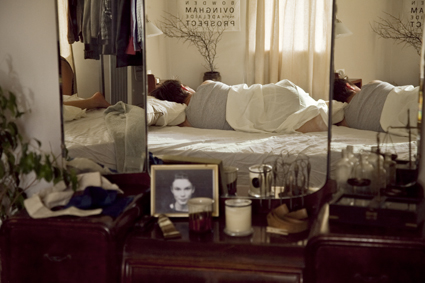
52 Tuesdays (film still), photo Bryan Mason
courtesy Closer Productions
52 Tuesdays (film still), photo Bryan Mason
“IT’S REALLY IMPORTANT FOR AN INITIATIVE LIKE THIS TO HAVE A CLEAR IDEOLOGY,” REFLECTS STEPHEN CLEARY, KEY CONSULTANT FOR THE SOUTH AUSTRALIAN FILM CORPORATION’S AMBITIOUS FILMLAB PROGRAM. FILMLAB WAS LAUNCHED IN 2009 WITH THE AIM OF FUNDING EIGHT FEATURE FILMS BY NEW DIRECTING TALENT AT BUDGET LEVELS OF $350,000 EACH, A FIGURE AROUND FOUR PERCENT OF THE 2010 AVERAGE FOR FILMS MADE WITHIN THE COUNTRY, ACCORDING TO SCREEN AUSTRALIA.
The quest to find a distinct identity for each film, and to encourage each director to find their unique authorial voice, has been at the heart of an endeavour that has actively tried to invert the usual approach of public financiers. Cleary, former head of development at British Screen and devotee of Aristotle, starts with the broad principle: “FilmLab asks, ‘What type of filmmaker do you want to be?’”
The projects selected in the two rounds of FilmLab are starting to mature, mainly sitting at the latter stages of development or on the cusp of production. One has already seen the light of day and had very notable success: Matt Bate’s pop-grunge documentary Shut Up Little Man! An Audio Misadventure (RT107, p23) which premiered at Sundance in 2011 and has had multiple territory sales and national award recognition. As the seven slower-brewing fictional pieces will start to roll out in 2012 now seems a useful juncture to have a look at what the alternative approaches championed by FilmLab are, how they are playing out and how the scheme can contribute to a wider debate about how feature films are developed and financed in Australia.
taking the pressure off
The first philosophical underpinning Cleary outlines is to create an environment of non-competitiveness and to relieve pressure on the selected filmmakers as much as possible. Instead of an intensive, bureaucracy-heavy selection process requiring final script and full production package, FilmLab asks for one-page ideas and little else. Filmmakers are not pinned down to one particular project but are encouraged to explore a range of ideas during a four-week intensive “creative laboratory” and then receive a small allocation of development funding to grow their eventual film.
This creates the unusual situation where filmmakers find themselves guaranteed production funds before they have a script or even a firm idea of what they will make. Similarly, teams are not required to have or seek extra market finance attachments. “I’m always interested in questioning the assumptions of public funding development, to turn things over, to find better ways of doing things,” explains Cleary. “The assumption in the public system is that it should mimic the private market.” To his mind public funding systems in places such as Australia and the United Kingdom act as proxy private financiers, looking for film “packages,” or triggering their funds with the attachment of market investors, and as a result harvesting a competitive, first-past-the-post culture. “For low budget films, there’s no reason why this should be so. Let’s not make filmmakers think they have to go through some gateway.”
FilmLab flips this with its financial certainty at the earliest possible stage. “This leaves what happens with the money up to the filmmaker rather than the financier, and puts the power back in the hands of filmmakers.” With the usual financing pressures alleviated, creative freedom should flourish.
low budget strength
The second ideological form of FilmLab deals with the place of low budget films in the current cultural landscape, and primarily seeks to answer the question: how can a film be a stronger work because of, rather than despite, its low budget? For fake found-footage films such as Paranormal Activity (2007), the low budget is key to the authenticity of the film’s concept, but there must be other ways to answer this question for sophisticated and rapacious audiences. “We didn’t want to dictate an answer but to create a debate for the filmmakers to engage in,” says Cleary. “One of the most interesting things about FilmLab is that there are a lot of different filmmakers wrestling with that question and coming up with different solutions…some have gone radical and innovative in their approach and others are trying to make a film that looks like it has higher production value and is made in a more conventional way.”
identity, not branding
Cleary cites FilmLab 2009 project 52 Tuesdays (director Sophie Hyde) as an example of a radical methodological approach, with the filmmakers shooting for one day a week for a year the framework of one character undergoing a change in gender identity. The frame of the story is fictionalised but the character’s transformation is real. In this way the process of the dramatised work with ambient documentary elements becomes a marketing tool for festivals that often have selectors interested in how different craft practices impact on the artistic outcomes of cinema. Other projects such as the horror film Inner Demon (Ursula Dabrowsky) and the thriller Touch (Christopher Houghton) are looking to operate within the framework of a genre: “In low budget genre, the question becomes, is the filmmaker good enough in a generic sense to thrill or excite to the extent that budget becomes a non-issue?” Cleary believes that the lower the budget, the more important clear hooks and selling points become for a film. This doesn’t necessarily mean gimmickry, but creating a distinct identity for a film that is easily processed and understood. “I’m not talking about brand, as that’s something you put on top; identity is getting to the heart of who you are, what you want to do and therefore what kind of films you want to make…I also think there is a correlation with the bravery you show as a filmmaker and the distinction of identity that your film will have.”
theory into practice
FilmLab’s theories were put into practice in the intensive four-week laboratory. Teams were tasked with a mixture of practical filmmaking exercises as well as activities in other artistic disciplines. “The idea was to get people into unfamiliar territory, to have fun doing things you hadn’t thought of, to experiment and explore things from new angles.” So alongside shooting and cutting film sequences or truncated versions of their story ideas, teams also painted, sculpted and even sang in a choir. This happened alongside more traditional script development and project initiation to get both sides of the brain spinning into action.
The practical filmmaking elements of the development lab to test ideas and hone aesthetics and tone are rare in Australia. “Public funding development is usually a literary process,” says Cleary, “an understandable necessity of the assessment process as funders need to get through a pile of ideas.” As a result the visual storytelling of the artform itself, and directors, or at least the directorial process, can get backgrounded during the development stages. “The director goes from having a minor role in development to the primary role in production,” which can end in a disjointed, unbalanced process. The FilmLab process is one attempt to redress this balance.
Cleary stresses that FilmLab is not the answer to all the problems of development in the public funding sector, but is merely part of a dialogue as the industry undergoes significant change. “Low budget filmmaking is not going to go away…and I think possibly in the end [filmmaking practice] is not going to be in the hands of public funders at all, as the methodologies and processes of filmmaking become much more democratic. I think [FilmLab] is contributing to the debate, rather than leading it.” In the end he sees FilmLab as part of a longer game and snap judgments on its impact can’t be made on the films it generates. “Ultimately, the marker of success of FilmLab will be where all the directors will be in four years’ time.”
South Australian Film Corporation, FilmLab, www.safilmlab.com.au
RealTime issue #108 April-May 2012 pg. 18
© Sandy Cameron; for permission to reproduce apply to realtime@realtimearts.net
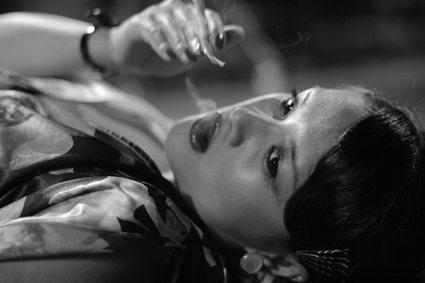
Michelle Vergara Moore, Black & White & Sex
A WOMAN IN A BLONDE WIG WALKS INTO A CIRCLE OF LIGHTS AND CAMERAS. SHE STANDS, A RABBIT IN THE HEADLIGHTS, ISOLATED AND AT SOME DISTANCE FROM THE SHADOWY DOCUMENTARY FILM CREW WHO FOCUS ON HER. A DIRECTOR/INTERVIEWER SITS AT THE EDGE OF THE CIRCLE, HIS IDENTITY OBSCURED FROM THE VIEWER. IT’S A THEATRICAL BEGINNING TO BLACK & WHITE & SEX, THE DIRECTORIAL DEBUT OF PRODUCER JOHN WINTER (RABBIT-PROOF FENCE, DOING TIME FOR PATSY CLINE), AN AMBITIOUS EXPLORATION OF THE NATURE OF SEX WORK, SEX, WOMEN AND MEN.
Winter examines these themes through a dialogue between two characters: Angie, a sex worker (a role shared by Katherine Hicks, Anya Beyersdorf, Valerie Bader, Roxane Wilson, Michelle Vergara Moore, Dina Panozzo, Saskia Burmeister and Maia Thomas) and her nameless, faceless interviewer (Matthew Holmes). Initially, the mood between these two is tense, as Angie bats back the director’s simplistic questions in a way that confronts him and sets in motion the film’s aim of demonstrating that there’s nothing black and white about sex work (and, by extension, sex itself).
The director is clearly meant to represent us, specifically a middle class liberal audience with certain well-meaning preconceptions about prostitution. Angie’s job, of course, is to confound this audience’s expectations, playing provocateur to the interviewer’s devil’s advocate. It makes for an attention grabbing, if rather hectoring first act. It’s when the discussion progresses to more general matters sexual, with some grandiose statements about the nature of men and women, that things become problematic.
The director now seems to stand for a certain kind of emasculated manhood, while Angie becomes a spokeswoman for earthy female sexuality: “Women are pleasure and pain,” she declares, effectively pulling women into a world of sensation that cannot be understood by their drily cerebral male counterparts. It’s a hazy viewpoint that sits awkwardly with an earlier statement that she has a science degree (a revelation greeted by the interviewer with sniggering surprise).
Angie is mercurial, prone to evading the truth with elliptical statements. As a character she rather brings to mind the lyrics of that Billy Joel standard, “…she only reveals what she wants you to see/ She hides like a child but she’s always a woman to me.” The interviewer compares her with a butterfly: “You’re here, you’re there, you’re everywhere,” and later on a chameleon—“I never know who I’m going to get.”
There’s an element of fantasy to Angie perhaps in keeping with her line of work, which is, after all, about fulfilling fantasy, if only one as basic as the client believing she’s “getting off on it.” Winter creates a mystique around his many-faced “unattainable” call girl, even while seeming to want to demystify her chosen career. He fights stereotypes (the “hooker with a heart of gold”; the victimised prostitute) with other stereotypes (the majority of Angie’s personae).
On the whole, Black & White & Sex is best viewed as a symbolic exercise, with the various Angies representing different sexual archetypes—mature woman, dominatrix, ingenue, earth goddess—though these tend to blend into one another. In this way, we can accept the incident where Angie-as-dominatrix forces the interviewer to strip naked and masturbate as the ice breaker it’s meant to be, as opposed to a rather nasty piece of sexual humiliation. Like Fellini’s 8 1/2 (1963), to which it bears a formal resemblance, the film is less an attempt at realism than a free-form exploration of its director’s attitudes and thoughts; a weighing-up of experience and opinions couched within the film-within-a-film format. It’s not a mockumentary, though it might appear to be at first glance.
At times, the film’s lack of realism deprives it of a rawness that would seem more in keeping with the subject matter: there’s a theatrical wordiness to these characters and their exchanges that makes them less believable as people than as mouthpieces for various arguments. This is ultimately a film about talking about sex. The character of the interviewer suffers particularly as a result of this treatment, making it difficult to share his revelatory journey. Nonetheless, Winter and his actresses are successful in their creation of a feisty, multi-faceted uber-whore. It’s in the larger questions about women, men and sex that the film’s purpose becomes lost.
Black & White & Sex premiered at the 2011 Sydney Film Festival, appeared in the Brisbane and Rotterdam International Film Festivals. Australian theatrical release March 22.
Black & White & Sex, director John Winter, cinematographer Nicola Daley, editor Adrian Rostirolla, music Caitlin Yeo, sound: Tony Vaccher, John Dennison, Craig Butters, costume designer, Yvonne Moxham, producers Melissa Beauford, John Winter, 2011
RealTime issue #108 April-May 2012 pg. 19
© Katerina Sakkas; for permission to reproduce apply to realtime@realtimearts.net
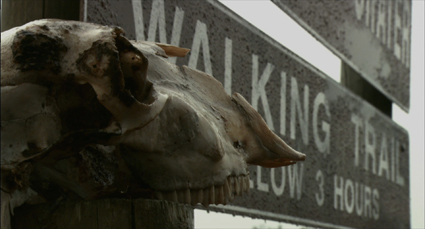
Wolf Creek
THE LATEST IN CURRENCY PRESS AND THE NATIONAL FILM AND SOUND ARCHIVE’S AUSTRALIAN SCREEN CLASSICS, A SERIES OF COMPACT VOLUMES AIMING TO “MATCH SOME OF OUR BEST-LOVED FILMS WITH SOME OF OUR MOST DISTINGUISHED WRITERS AND THINKERS,” SEES WRITER FOR YOUNG ADULTS SONYA HARTNETT DELVE INTO DIRECTOR GREG MCLEAN’S BRUTAL WOLF CREEK (2005).
Her opening chapter, which details a pivotal childhood moment, is a powerful evocation of squalor and highlights an ugly aspect of the Australian psyche that, though usually hidden, is always ready to bare its teeth. Thus Hartnett demonstrates her own affinity with Wolf Creek’s darkness, as well as positioning the film as quintessentially Australian: “two-bit antipodean horror,” as she puts it.
This deeply felt beginning raises expectations for her analysis of the film, and in many respects we’re not disappointed. Hartnett’s elegantly measured prose matches Wolf Creek’s own controlled pacing and considered atmosphere, and she brings a poetic sensibility to material that some might think of as anything but. The vast meteorite crater at Wolf Creek is “a great wound from which a scab has been gouged.” As the film’s young travellers ride closer to their fate, “the road sign they pass is blacked-out, for they have ceased to exist in the known world.”
Throughout her narration of the film’s plot (more on this narration later), Hartnett sets the scene culturally and geographically. Italicised factual inserts about the Falconio disappearance and the Backpacker murders place the film’s events alongside their real-life counterparts in a way that creates a feeling of dread in the pit of the reader’s stomach. We are never in any doubt that Australia is a dangerous land, both in fact and in fiction. Paralleling the film’s deliberate weaving of imagined and actual events, Hartnett draws upon both cultural and historic examples in discussing the traditional white Australian fear of the bush that coalesces in the enduring theme of the lost child. These observations, though not original, are pertinent to the material.
“Home isn’t homely when it can’t be trusted,” Hartnett writes, effectively making Australia the embodiment of Freud’s unheimlich—the uncanny—and, as such, a natural backdrop for horror. This idea of a menacing, predatory land is extended to encompass its human monsters, men such as Bradley Murdoch and Ivan Milat, on whom Wolf Creek’s Mick Taylor is modelled—men described here as “dust devils.”
In some of her most insightful passages, Hartnett alerts the viewer/reader to the disruption of typical horror narrative that makes Wolf Creek such a singular and unsettling experience. In the beginning, “the world being depicted is a replica of the real world, peopled with unremarkable characters, messy in its casualness, riddled with holes.” As in Hartnett’s novels, the writer is awake to Wolf Creek’s depiction of the indiscriminate nature of death.
If there’s a flaw in her approach, it comes perhaps in her decision to retell the film’s entire narrative chronologically and (if you’ll forgive the phrase) blow by blow. It’s understandable that a storyteller seeks to examine a film by telling its story, but frustrating for those readers already familiar with the film who are in search of something more theoretically meaty. The final chapter provides more in the way of straightforward criticism, with Hartnett dwelling lyrically on Wolf Creek’s subtlety and complex handling of character while simultaneously addressing its lapses in judgement. The moral ambiguities inherent in a film which takes real-life tragedy as its starting point are tackled here, as they must be, and through reference to her own work, Hartnett mounts a convincing, if qualified defence.
It is rare to come across a considered, empathetic account of a horror film, horror being a genre that usually provokes responses ranging from the flippant or asinine to the dismissive. Hartnett refers to Wolf Creek as “less a horror film than a film in which horrifying things happen.” While appreciating the distinction, for some of us this just makes Wolf Creek a particularly fine horror film. Interestingly, there is no mention of a couple of Wolf Creek’s cinematic forbears: Wake in Fright (the subject of Tina Kaufman’s book in the same series), an example of “two-bit antipodean horror” if ever there was one, and Picnic At Hanging Rock, which Wolf Creek deliberately references (though you could say Hartnett indirectly refers to the latter in her discussion of the lost child).
This is a personal reading, a storyteller’s account. The historical facts referred to will be familiar to an Australian audience, fascinating to those not from this country. What both will gain is an appreciation of the sophistication of a film that is more frequently spoken of in terms of its crude brutality.
Sonya Hartnett, Wolf Creek, Australian Screen Classics, Currency Press and the National Film and Sound Archive, Sydney, 2011
RealTime issue #108 April-May 2012 pg. 20
© Katerina Sakkas; for permission to reproduce apply to realtime@realtimearts.net
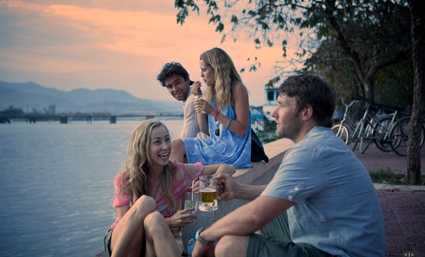
Wish You Were Here
SHIFTING BETWEEN THE MEAN STREETS OF CAMBODIAN BEACH SHANTY TOWN SIHANOUKVILLE AND THE LEAFY EASTERN SUBURBS OF SYDNEY, WISH YOU WERE HERE IS A STYLISH THRILLER PRODUCED BY THE BLUE TONGUE FILMS TEAM (WHICH INCLUDES NASH AND JOEL EDGERTON) AND WRITTEN AND DIRECTED BY KEIRAN DARCY-SMITH, WHOSE 1998 SHORT FILM BLOODLOCK WAS NOMINATED FOR AN AFI AWARD.
Dave (Joel Edgerton) and his wife Alice (Felicity Price in an elegantly measured performance) visit Cambodia with her sister Steph (Teresa Palmer) and boyfriend Jeremy (Antony Starr). After a wild night dancing under the moon and taking e’s, Jeremy disappears from the beach. As the days unfold, he fails to return. He’s listed as a missing person; it turns out none of the others really knew him. When the three return to Sydney, the film’s delicate structure gradually reveals the secrets they have been hiding from one another since that night.
Darcy-Smith and Felicity Price are a husband and wife team—and also the film’s screenwriters—and the writing and performances are particularly strong in the scenes where the couple’s family life (they have two small children) gradually unravels. The conversations around the dinner table capture the random, humorous, often surprising nature of dialogue with toddlers. And the conflict that erupts is convincing: a pregnant Alice drinks a bottle of wine as Dave loses his temper, accusing her of trying to kill their baby. The children watch as the couple’s relationship slowly disintegrates under the strain of Jeremy’s disappearance and Dave’s increasing paranoia.
What’s curious about the film is that there’s no great sense of loss at Jeremy’s disappearance—or even a real feeling that he’s missing; the tension doesn’t quite build from the beginning. Perhaps this is because the film so quickly shifts location from Cambodia to Sydney. We’re not there for those long days when minutes becomes hours; when time slows the way it does when you’re waiting for someone who doesn’t arrive, who never returns. Even the scenes with Jeremy’s parents, struggling to accommodate the news that he’s gone, are stilted—perhaps reflecting that all the characters in the end remain strangers to one another, while Jeremy can only be a mysterious figure, unknowable, untraceable.
Watching Edgerton in the central role I’m reminded of his similarly edgy performance in The Waiting City (director Claire McCarthy, 2009), an Australian film where the sense of waiting (in a foreign place, India) is palpable. In both films, there also seems to be another story waiting in the wings (from an Indian or Cambodian perspective) that’s just out of reach, tantalising: here, it’s the tale of the Vietnamese mafia, the brothel owner who parades a small girl for the Australian men who drink at his bar.
I’ve walked along the Sihanoukville beach at night, skinnydipping in the shadows. The shanty bars right on the ocean’s fringe give a wild-west frontier feel to the place. I caught a tuk-tuk ride at 3am back to my hotel, a friendly local only too happy to drop me off for a few American dollars. Even then I got the feeling that if you wanted to disappear, this would be the place to do it.
Wish You Were Here, director Kieran Darcy-Smith, writers Kieran Darcy-Smith, Felicity Price, producer Angie Felder, cinematographer Jules O’Loughlin, editor Jason Ballantine, production design Alex Holmes, costumes Joanna Park, music Tim Rogers; distribution Hopscotch Films, release April 25
RealTime issue #108 April-May 2012 pg. 20
© Kirsten Krauth; for permission to reproduce apply to realtime@realtimearts.net
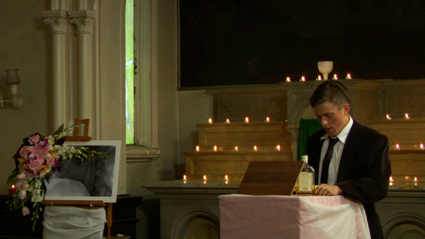
Killing Anna, Paul Gallasch
“WHERE ARE THE BOB CONNOLLYS, THE TOM ZUBRYCKIS, THE DENIS O’ROURKES OF THIS GENERATION?” THIS WAS A QUESTION THAT EMERGING DIRECTOR/PRODUCER JENNIFER PEEDOM DEEMED “ALARMING,” WHEN SPEAKING ON THE “DEFINING DOCUMENTARY” PANEL AT THE 2012 AUSTRALIAN INTERNATIONAL DOCUMENTARY CONFERENCE.
Minutes earlier, despairing veteran director Bob Connolly had taken aim at what he considered the elephant in the room: “that increasing non-person (at the conference), the auteur.” Asked to comment on a legal stoush between production company Essential Media and Screen Australia, one driven by questions concerning eligibility for producer offset funds for documentary, Connolly expressed his dismay that such discussions concerning documentary form were driven by financial rather than artistic imperatives. Peedom went on to describe her forced existence as ‘gun for hire,’ rather than independent filmmaker, evidence of what Connolly described as a shift away from independent voices in favour of agencies and broadcasters contracting with corporate entities.
“Defining Documentary” was one of several panel discussions running alongside keynote addresses in which a variety of national and international speakers discussed the current climate of documentary production and distribution. Connolly was not alone in foregrounding the challenges for independent and emerging filmmakers. Julia Overton (Jotz Productions), recipient of this year’s Stanley Hawes Award for outstanding contribution to the documentary sector in Australia, acknowledged a lack of mentoring and support for young locals, a situation she sees linked to the 2008 merging of the nation’s former ‘big three’ agencies into Screen Australia. Acknowledging the current difficulties associated with producing one-off documentaries, Overton stressed the need for producers to widen their search for funding, commenting that at the end of the day, “it’s all about storytelling.”
f4: first factual film festival
Now in its second year, the First Factual Film Festival (F4), a documentary screening program running in conjunction with AIDC, has expanded to include public screenings as part of the Adelaide Festival of the Arts. Billed as an “unrivalled professional development opportunity for Australia’s emerging documentary filmmaking talent,” the festival showcases first films from talented Australians alongside the work of more experienced international conference guests.
From four finalists (chosen from 70 entries), the F4 Award for Outstanding New Documentary Talent was this year awarded to 26-year-old South Australian filmmaker Paul Gallasch for Killing Anna. In this 29-minute film, Gallasch as protagonist tracks his heartbreak and despair following the break-up with his first long term girlfriend, Anna. Constructing a bizarre fantasy as a way to understand his loss, Gallasch decides to stage a funeral service for Anna, pretending that she has died in a tragic accident. The film covers the lead up to this event through interviews with friends, family and strangers, and then the aftermath. Ultimately disappointed with his funeral service undertakings, Gallasch questions the social acceptance of grief associated with relationship breakdowns, remarking that ultimately, the only people who care are the two parties involved in the split.
Seemingly living in a rundown Brooklyn NY neighbourhood at the time, Gallasch’s method involved carrying the camera with him for four months, during which time he was a student at the New York Film Academy. Drawing on the work of Werner Herzog, Killing Anna combines a range of storytelling devices including narration, direct address to camera, interviews and recreations, perhaps reflecting Gallasch’s progression as a filmmaker. The incorporation of footage of his editing processes means that as well as being about loss, the piece questions the process of film construction itself. In a search for authenticity Gallasch wrote more than 8,000 words of narration on the subject of grief: “I wrote the film trying to rationalise the loss and then realised I couldn’t.” What he has managed to do is articulate a grieving process that defies logical explanation in an exceptional and surprising manner. On behalf of the F4 jury, Claire Jager praised the film’s “original and bold premise” and “the playfulness of the filmmaker’s shifting relationship to the camera and the audience.”
David Tucker’s My Thai Bride, a 52-minute documentary that received a special commendation from the F4 jury, also tracks a relationship breakdown. The story centres on Ted, a 46-year old salesman from Wales, who when visiting Thailand on business, meets and falls in love with Tip, a bargirl. The two decide to marry and despite a happy beginning, things soon turn sour. As both Ted’s money and Tip’s affections dwindle, he realises that the marriage was a mistake, and eventually returns to the UK destitute. Tip remains in the village house they built together, having gained some financial security as a result of the experience. Although giving more screen time to Ted, Tucker presents both protagonists without taking sides, creating a sense that a cultural misunderstanding is at the heart of the problem. Although Ted has lost his fortune at the end of the story, one is left to ponder who is worse off in the long term considering the poverty in Tip’s village.
It is impossible to consider Tucker’s engaging work without making comparisons with Denis O’Rourke’s landmark 1991 film The Good Woman of Bangkok, which also interrogated the sex trade in Thailand. My Thai Bride differs, however, in its focus on the emotional journey of the male at the heart of the story, revealing that, in Tucker’s words, “sex tourists have feelings too.” In a Q&A session Tucker described Ted’s eagerness to set the record straight, commenting that there are a lot of western guys like Ted but there is no solidarity between them as their situation is humiliating. I was surprised to learn that much of the film was shot in retrospect, with Tucker, then living in Thailand, only meeting the couple as they were splitting up in 2006. The filmmaker recreates their initial meeting, drawing upon a collection of still photographs and narration. On the filmmaker’s return to Australia, Michael Cordell came on board as executive producer and a successful Screen Australia investment meant funds to undertake additional photography and finish the film. The result is a powerful work that sheds new light on a complex issue.
It is interesting to note that both Tucker’s and Gallasch’s outstanding films were conceived of, developed and largely undertaken without any government funding, a situation that is clearly not unusual for first time documentary makers; here it certainly does seem to be all about storytelling. Debates undertaken at AIDC 2012 raise some worrying questions as to just where these Australian filmmakers might go next.
AIDC, Australian International Documentary Conference, 2012, Stamford Grand Hotel, Glenelg, Feb 27-March 1; F4 2012, Mercury Cinema, Adelaide, March 2-4
RealTime issue #108 April-May 2012 pg. 21
© Kath Dooley; for permission to reproduce apply to realtime@realtimearts.net
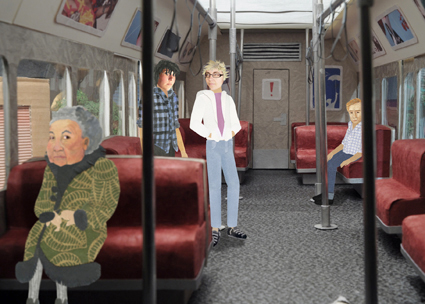
Isobel Knowles & Van Sowerwine, It’s a jungle in here
courtesy the artists
Isobel Knowles & Van Sowerwine, It’s a jungle in here
TRAVELLING BY PUBLIC TRANSPORT IS NOT AN EXPERIENCE WE TYPICALLY ASSOCIATE WITH COMFORT. AT ITS BEST CONVENIENT, AND AT ITS WORST FRIGHTENING, THIS DAILY RITUAL SEES HORDES OF URBAN COMMUTERS SILENTLY SLALOM THEIR WAY THROUGH MOMENTS OF PHYSICAL PROXIMITY AND PSYCHICAL DETACHMENT, HOPING FOR A CLEAR RUN.
It’s a jungle in here (2011), created by longtime collaborators Isobel Knowles and Van Sowerwine, uses the familiar experience of a suburban train journey to explore ideas of empowerment, complicity and individual and collective responsibility in public space. Drawing on the artists’ own personal experiences on public transport, as well as those of their friends, It’s a jungle in here is an equally enchanting but more conceptually rigorous follow-up to the duo’s You Were in My Dream (2010), winner of the coveted Premier of Queensland’s National New Media Art Award. Their latest interactive animation debuted at Screen Space for the 2011 Melbourne International Arts Festival.
A stop-motion animation made from paper puppets and a diorama, It’s a jungle in here harnesses similar technology to that employed in You Were in My Dream. Approaching the installation in pairs, participants unwittingly become involved in an ambiguous psychodrama, casting themselves in the role of either attacker or victim, depending on the seat they choose. The attacker is provided with a console button to advance the action, while the victim can yell into a microphone to derail the attack. A live video feed maps each of the users’ faces onto a different animated character, blatantly implicating them in the conflict.
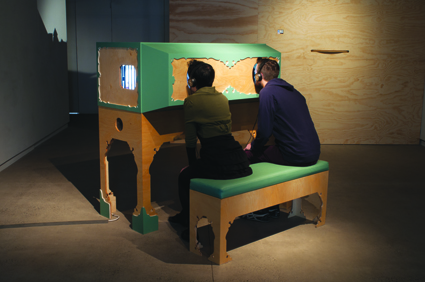
Isobel Knowles & Van Sowerwine, It’s a jungle in here, installation view
courtesy the artists
Isobel Knowles & Van Sowerwine, It’s a jungle in here, installation view
The animation is housed within a wooden peepshow cabinet: a handcrafted ‘wonder box’ with just enough old-world charm to lure participants in and encourage play. At the same time however, the structure also gestures towards less innocent, contemporary live-action exchanges. More than just encouraging an active subjectivity, the peepshow box establishes the voyeuristic mode of spectatorship necessary for the work’s unsettling narrative thrust. Both users are immediately forced into a very physical mode of looking, manoeuvering their faces into peepholes, craning necks to absorb the scene from different angles, and focusing and refocusing to register the animation’s intricate detail. It’s a jungle in here thus forces an awareness of the very act of spectatorship, and the power, complicity and responsibility it demands.
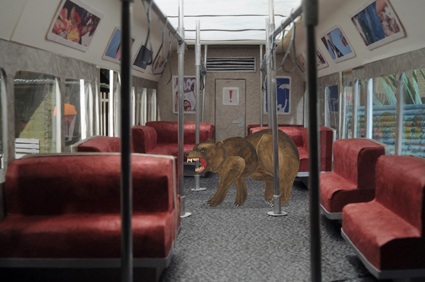
Isobel Knowles & Van Sowerwine, It’s a jungle in here
courtesy the artists
Isobel Knowles & Van Sowerwine, It’s a jungle in here
In the first vignette, a male character fiddles loudly with his mobile phone, which raises the ire of a fellow passenger. Before long, a fistfight ensues. When the victim-player remains silent or quiet, the on-screen attacker suddenly morphs into a grizzly bear, bloodily mauling the man on the carriage floor. When the player uses the microphone to signal distress, their avatar suddenly transforms into a turtle, retracting into a hardened shell to protect itself against the predator.
Other confrontations enacted in the animation include a lecherous man forcing physical contact with a female passenger, and a gaggle of boisterous schoolgirls shooting spitballs and bubblegum. In the second scenario, the harasser’s hands become snakes that slither into the woman’s blouse. In the final scene, the schoolgirls metamorphose into carnivorous black crows, filling the cramped carriage with a murderous flapping. Significantly, throughout each altercation the surrounding travellers all cower silently, immobilised in their seats.
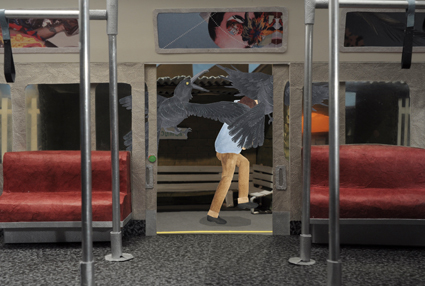
Isobel Knowles & Van Sowerwine, It’s a jungle in here
courtesy the artists
Isobel Knowles & Van Sowerwine, It’s a jungle in here
More than providing the focus for a meditation on the precarious relationship between humanity and animality, civilisation and chaos, the animal characters imbue the work with a seductive and fanciful beauty. It’s a jungle in here manipulates the participants’ allegiances and expectations at every turn, diluting the meaning and power of their violent actions through its sweet, picture-book aesthetic and whimsical calls to fantasy. By turns beautiful, dreamy, creepy and brutal, the work turns the ‘space of exception’ occupied by videogames and online social spaces in on itself, and in so doing, reveals how deeply those conventions are ingrained in the spectator psyche. In this way, It’s a jungle in here is startlingly effective in articulating an ethics of participation, both within the virtual world and outside it.
Isobel Knowles & Van Sowerwine, It’s a jungle in here, coding, interface electronics Matthew Gingold, carpentry, engineering Don Russell, sound Finn Robertson, additional coding Oliver Marriot; Screen Space, Melbourne, Oct 13-29 2011
RealTime issue #108 April-May 2012 pg. 22
© Ulanda Blair; for permission to reproduce apply to realtime@realtimearts.net
 AFTER AN EXHAUSTIVE REVIEW PROCESS, WHICH INVOLVED SEVERAL ROUNDS OF CONSULTATIONS, AN ISSUES PAPER AND A DISCUSSION PAPER AND HUNDREDS OF SUBMISSIONS TO BOTH, THE AUSTRALIAN LAW REFORM COMMISSION HAS SEEN ITS FINAL REPORT ON THE ENQUIRY INTO AUSTRALIA’S CLASSIFICATION SYSTEM, THE FIRST FOR 20 YEARS, TABLED IN FEDERAL PARLIAMENT LAST MONTH.
AFTER AN EXHAUSTIVE REVIEW PROCESS, WHICH INVOLVED SEVERAL ROUNDS OF CONSULTATIONS, AN ISSUES PAPER AND A DISCUSSION PAPER AND HUNDREDS OF SUBMISSIONS TO BOTH, THE AUSTRALIAN LAW REFORM COMMISSION HAS SEEN ITS FINAL REPORT ON THE ENQUIRY INTO AUSTRALIA’S CLASSIFICATION SYSTEM, THE FIRST FOR 20 YEARS, TABLED IN FEDERAL PARLIAMENT LAST MONTH.
While the ALRC’s recommendations do not automatically become law, and while the government will probably take several other reviews (including the important Convergence Review) into account when it decides whether and when to take action on classification, the ALRC has certainly made some brave and eminently sensible recommendations which would dramatically haul an outmoded and cumbersome system into the digital age.
“Australia needs a new classification scheme that applies consistent rules to media content on all platforms—in cinemas, on television, on DVDs and on the internet,” said Professor Terry Flew, Commissioner in charge of the ALRC review, “but the scheme also needs to be flexible, so it can adapt to new technologies and the challenges of media convergence.”
The report, Classification—Content Regulation and Convergent Media, contains 57 recommendations which would see the current complex array of classification guidelines for films, TV programs, computer games, publications and online content replaced by a streamlined, single classification system, run by the Commonwealth Government. There would be a common set of markings and criteria, using the same categories and guidelines, for all content, whether it is viewed on television, at the cinema, on DVD or online. A much greater role for industry in both the classification of content and in the development of co-regulatory codes is also proposed, informed by the fact that self-regulation has worked well for television for some years. Measures would also be introduced to remove the need to reclassify films and TV programs when they are re-released on DVD. While film festivals would remain exempt from classification, they would still be required to exclude people under 18 from unclassified films.
Recognising that media convergence, digital delivery and online distribution have irrevocably altered the landscape, as has the exponential increase in available content, the ALRC commenced the enquiry taking into account a number of issues. They range from the rapid pace of technological change in media available to, and consumed by, the Australian community, and the needs of the community in this evolving technological environment, to ways to improve available classification information and enhance public understanding of regulated content. This would be balanced by the need to minimise the regulatory burden and by the desirability of a strong content and distribution industry in Australia. Most important, of course, were the impact of media on children and their increased exposure to a wider variety of media, from television, music and advertising to films and computer games.
The ALRC also identified guiding principles in the provision of an effective framework for the classification and regulation of media content. They are: that Australians should be able to read, hear, see and participate in media of their choice; that communications and media services available to Australians should broadly reflect community standards, while recognising a diversity of views, cultures and ideas in the community; that children should be protected from material likely to harm or disturb them; that consumers should be provided with information about media content in a timely and clear manner, and with a responsive and effective means of addressing any concerns; that the classification regulatory framework should be responsive to technological change and adaptive to new technologies, platforms and services, should not impede competition and innovation, and not disadvantage Australian media content and service providers in international markets; that classification regulation should be kept to the minimum needed to achieve a clear public purpose; and that classification regulation should be focused upon content rather than platform or means of delivery.
Out of all this came the key features in the report: platform-neutral regulation with one set of laws across all media platforms; clear identification of what must be classified (feature films, television programs, and computer games likely to be MA 15+ or higher, made and distributed on a commercial basis, and likely to have a significant Australian audience); a shift in regulatory focus to restricting access to adult content, by imposing new obligations on content providers to take reasonable steps to restrict access to adult content and to promote cyber-safety; and co-regulation and industry classification, subject to regulatory oversight There is also Classification Board benchmarking, with a clear role for the Board in making independent classification decisions that reflect community standards, and the important proposal for a federal government scheme to replace the current co-operative scheme (between federal, state and territory governments) with enforcement coming under Commonwealth law, and a single regulator with primary responsibility for over-seeing the new scheme.
“Classification criteria should also be reviewed periodically, to ensure they reflect community standards,” said Professor Flew. “One category that may no longer align with community standards is “Refused Classification” or RC. The scope of this category should be narrowed, and the ALRC suggests changes for government to consider.”
ALRC President, Professor Rosalind Croucher has pointed out that Australians value classification information about films, computer games and television programs, and that “the new scheme will continue to deliver this important advice. The ALRC has recommended a balanced approach, recognising that it is not practically possible in a digital age to classify everything. An effective scheme of content regulation must address this context…(while expecting) content providers to take reasonable steps to restrict access to adult content, so that children are better protected from material that might harm or disturb them.”
While the submissions received during the enquiry offered a huge range of opinions, ranging from no need for classification at all, and the impossibility of classifying or containing internet content, to the need for more control and more stringent regulation, the ALRC has come up with substantial recommendations which, if adopted, will provide a sensible, flexible and more streamlined framework for the classification and regulation of media content. We now must wait and see what actually eventuates.
Australian Law Reform Commission, www.alrc.gov.au
RealTime issue #108 April-May 2012 pg. 23
© Tina Kaufman; for permission to reproduce apply to realtime@realtimearts.net
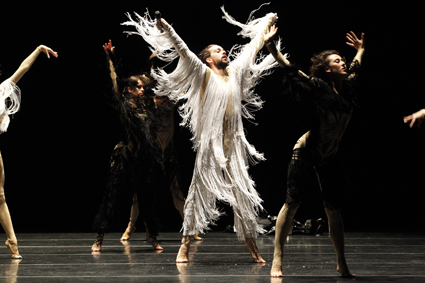
There’s definitely a prince involved, Gideon Obarzanek
photo Jeff Busby
There’s definitely a prince involved, Gideon Obarzanek
INFINITY KICKS OFF THE AUSTRALIAN BALLET’S GOLDEN JUBILEE CELEBRATIONS WITH A TRIPLE BILL ENCAPSULATING OUR COUNTRY’S CONTEMPORARY DANCE CULTURE. FROM ABSTRACT BALLET TO PULLING THE FEATHERS FROM SWAN LAKE TO A COLLABORATION WITH BANGARRA DANCE THEATRE, INFINITY EMBRACES POSTMODERN DECONSTRUCTION AND ENDS ON A SOULFUL HIGH NOTE. THE THREE PIECES ARE VASTLY DIFFERENT BOTH VISUALLY AND THEMATICALLY, YET STRIVE TO SHARE A UNIQUELY AUSTRALIAN POINT OF VIEW OF BALLET.
Graeme Murphy’s The Narrative of Nothing shuns conventional storylines and is inspired by the score, Brett Dean’s sometimes extraordinary and, some might say difficult or even discordant, Fire Music. Murphy handpicked his favourite dancers, some of whom caught his eye in his production of Romeo & Juliet. His choreography explores the human impulse to create stories from abstract work; in lieu of an actual narrative, we thread together our own. Boxes of stage lights, almost unisex costumes and Dean’s score give the performance a kind of dystopian feel. Dancer Adam Bull stands beneath a single globe that sways in an expanding circle; lit from above, he’s a perfect, anonymous figure: a living, breathing Oscar statue. Where the score clangs like construction workers on a skyscraper, the dancers are all speed and strength, either angular and hard or fluid, like molten steel. In this science-fiction world (my ballet date thought Space Odyssey, whereas I leant towards Metropolis) there are flashes of competitiveness or struggle, an unsupported head-hold of Lana Jones in a pas de deux and male-only groupings that occasionally threaten to spill into affray. Though it can be a daunting task to sustain audience interest in non-narrative performance, Murphy overcomes this with original, exciting choreography.
In There’s definitely a prince involved, Gideon Obarzanek deconstructs Swan Lake. Underscoring it with dialogue, initially as a dig at our lack of knowledge of the (seemingly ridiculous) plot of the world’s best known ballet, he too questions the role of narrative in ballet. The dialogue is less effective when it deals with the Swan’s theme of idealised romantic love via dancers’ confessions. In revisiting and pulling apart the choreography of Swan Lake (1877; but most versions derive from the1895 version), we see how potent the source is as cultural fodder (Black Swan, anyone?) and as arguably the pinnacle of narrative ballet. Obarzanek isn’t wringing the Swan’s neck but rather asking the audience to reconsider what ballet is. There were laughs at the image of a prince bringing a swan home as a date, and how irrelevant plot digressions allow the dancers to display their technical prowess in brilliant sautes. In a tribute to the dance of the cygnets, the splendour of the original is highlighted by stellar performances. Madeline Estoe is magnetic as a deconstructed Odette.
There are several complex ideas here. The fussy, satin court costumes are at odds with designer Alexi Freeman’s incredibly free-flowing, tasselled and almost naked costumes, which dancers use to full effect. This demonstrates a disjuncture between classic and contemporary ballet—the reliance on narrative, the heavy weight of the past, particularly on borrowed European notions. Freed of these, dance can be stripped bare to pure movement. Amid all these questions, Obarzanek shows us he can pull together a satisfying ballet.
The closing work, Waramuk—in the dark of night, marks the third collaboration between Bangarra Dance Theatre and The Australian Ballet, and is a fitting close to Infinity with its melancholy beauty and visual romance. Choreographer Stephen Page has been reinvigorating traditional storytelling for two decades with Bangarra, yet here ballet is the beneficiary of a new breath of life. The stories of the Yolngu of Arnhem Land speak of the link between spirituality and the land: in this ballet, the creation stories centre on the moon and constellations, myths which may be millennia old but are largely unknown to most audiences.
Rich in symbolism—a rope connects the sky and earth, or the spirit world and reality—and, informed by a dance language that borrows from Indigenous movement, Waramuk confidently avoids stereotypes. As the Evening Star, Vivenne Wong is heart-achingly graceful in bridging two genres of dance, while Elma Kris brings strength and emotion to her role as a Mother Earth figure. David Page’s haunting score of recorded voice and orchestral music, combined with the shimmering, shifting backdrops by Jacob Nash, transfix us. There were definitely goosebumps involved.
Infinity plays at the Sydney Opera House, April 5-25
–
Australian Ballet, Infinity, The Narrative of Nothing, choreography Graeme Murphy, creative associate Janet Vernon, composer Brett Dean, stage and lighting design Damien Cooper, costumes Jennifer Irwin, sound Bob Scott; There’s definitely a prince involved, choreography Gideon Obarzanek after Marius Petipa and Lev Ivanov, music Stefan Gregory after Piotr Illyich Tchaikovsky, costumes Alexi Freeman with Caroline Dickinson, stage concept Benjamin Cisterne, Gideon Obarzanek, lighting Benjamin Cisterne, original sets Hugh Colman; Waramuk—In the Dark Night, choreography Stephen Page, music David Page, costumes Jennifer Irwin, set design Jacob Nash, lighting Padraig O Suilleabhain, sound design Bob Scott; Orchestra Victoria; Arts Centre, State Theatre, Melbourne, Feb 26-March 6
RealTime issue #108 April-May 2012 pg. 24
© Varia Karipoff; for permission to reproduce apply to realtime@realtimearts.net
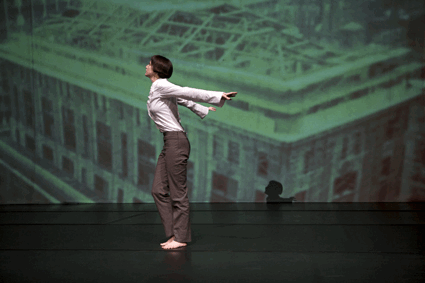
Ros Warby (image 3 – with Ria Soemardjo), The Tower Suites
photo Calista Lyon
Ros Warby (image 3 – with Ria Soemardjo), The Tower Suites
THREE BODIES ENTER THE SPACE. MY EYE IS DRAWN TO THE CORPOREAL BEARING OF EACH PERFORMER, TO THE WAYS IN WHICH EACH BODY BECOMES PERFORMATIVE.
Ria Soemardjo sings. Her whole body becomes voice. There is a kind of simplicity to her physicality that makes space for the sound to emerge as pure affect. It is different with Helen Mountfort. There is something baroque about the whole thing, the curlicues of the cello, the space between the musician and her instrument, the compositional nature of the music. In Ros Warby’s case, the body is a staging ground for many different kinds of event. It begins discombobulated, a body in bits and pieces becoming organised. Ironically, it takes a great deal of skill to allow the body to unravel so as to stage its own organisation, rather like giving birth to oneself. But then, Warby is not shy of a challenge. Her focus, in its protean forms, keeps this intricate work together.
Tower Suites is collaborative. Its multiplicity of elements—cello, voice, film and dance—guide our perceptions. The elements each come to the fore and recede. The film lends weight to our seeing. That is after all its domain. At first, I was unsure whether to privilege Warby’s dancing, how to incorporate the other onstage bodies that don’t dance yet orient themselves to their own domain of art-making. But the processional nature of the first set of images, people in ritual dress moving along, allowed me to unite the group rather than consider each one severally. By the end, we all grasp the relationships that undergird Tower Suites.
Yet, this isn’t about relations between the women. Warby makes the work through a very specific choreography which draws upon a range of artistic qualities, sounds, images and affects. These are all different events, activities which draw in the soulful singing of Soemardjo, duet with Mountfort’s compositions and utilise a palimpsest of images (Margie Medlin), mixing history with colour shots of Warby’s own dancing.
Warby threads time by building fine movement that travels across space. The pull of a curtain entangling her legs evokes all the elegance of deco drapery in silhouette. She has a kind of commedia del arte character, a bittersweet condensation of human foibles. A repeated falling echoes the filmic citation of collapsing buildings, creating a certain kind of abstraction against the very historical imagery.
For Ros Warby, dancing is not enough. Her choreography seeks to incorporate more than itself. It swallows up Warby’s face, incorporating sound, voice and image. As a result, there is a richness to Tower Suites, which is emotional, sensory and personal.
–
Tower Suites, created by Ros Warby in collaboration with Helen Mountfort, Margie Medlin, and Ria Soemardjo; choreography, performance Ros Warby, light, projection, set design Margie Medlin, composition, cello Helen Mountfort, voice Ria Soemardjo, cinematography Ben Speth; Arts House, North Melbourne, February 22-26
RealTime issue #108 April-May 2012 pg. 24
© Philipa Rothfield; for permission to reproduce apply to realtime@realtimearts.net
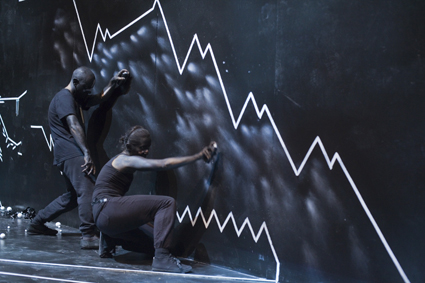
Antony Hamilton, Melanie Lane, Black Project 1
photo Ponch Hawkes
Antony Hamilton, Melanie Lane, Black Project 1
IS THERE ANY AUSTRALIAN CHOREOGRAPHER WITH A PHYSICAL GRAMMAR AS DISTINCTIVE AS ANTONY HAMILTON?
Not that he’s the most original shapemaker or that he hasn’t absorbed the influences of many of his peers and mentors. But there’s no-one quite like Hamilton, for both better and worse. He’s pursued a particular method of pop-and-lock staccato, freeze-and-reverse repetition and an organic/mechanic blurring so rigorously and for so long that not only has it become a signature, it’s become one that no-one else can forge. It always makes for compelling viewing when he’s demonstrating the results of his investigations, but when he choreographs on others they can never quite match the man himself.
Thankfully in Hamilton’s collaboration with Melanie Lane, the double bill Clouds Over Berlin, he seems to have melded minds with someone developing an art equally as striking. In Hamilton’s Black Project 1, Lane is still at times a nanosecond away from matching his stop-start brilliance, but in her own Tilted Fawn she delivers an experience quite unlike the various threads that have been woven through Australian choreography of the last decade.
There’s a mythic quality to the work which reveals itself coyly, and it’s as cool and inhuman as true myths always end up being. The audience sits in the round, bordering a space populated only by a few dozen cardboard bricks the size of shoeboxes. Lane methodically shifts and stacks and shuffles these, her movements concise and efficient enough to allow the inert objects as much presence as her own body. But gradually the onlookers become positioned as insubstantial gods watching the accelerated architectonics of human activity, each new structural formation engendering new associations. Stonehenge, a highrise ghetto, a walled estate, the Twin Towers? Sounds begin to emerge from the tiny edifices: music, whispers, conflict. The referents are never made explicit but it’s hard not to fashion your own interpretation of each configuration presented, and the cold, closed nature of these depictions subtly shifts its audience into a position of meditative spectatorship that allows us to forget our own corporeality.
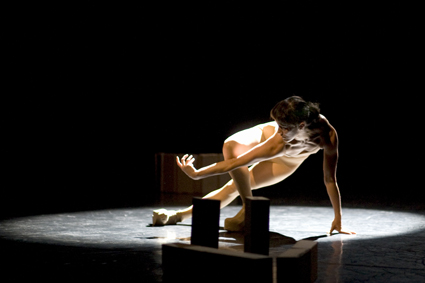
Melanie Lane, Tilted Fawn
photo Maik Reichert
Melanie Lane, Tilted Fawn
Then Lane returns as a violent, excessive vision of that vanquished bodily reality, clad in a pale and featureless skinsuit with elongated hooves that cause her to stagger across the space. The wildness of her motion extends so extremely in all dimensions that it’s almost overpowering, and the constant collapse of each ankle isn’t just resonant with the image of the tottering newborn fawn but conjures a whole species of flailing, howling, confused beings up till now sublimated by the fairy village of urban planning.
Life remains absent from Black Project 1, however. Hamilton and Lane appear as gleaming black wraiths making their way across a post-urban wasteland. It’s a vision that gestures to the choreographer’s earlier interests—aerosol art, digital tech, breakdance—while stripping away any literal referents. The dance itself may be Hamilton’s most developed and sustained exploration of his own practice; certainly, its realisation occurs in a set and lighting state that is as immediately impactful as any I can recall. It’s less curious, perhaps even less generous than Lane’s effort, but in tandem the pair make for a bewitching penumbral experience both stirring and unsettling.
Read another review of Tilted Fawn at Perth’s Fringe World on page 7.
Clouds over Berlin: Tilted Fawn, choreography, concept, performer Melanie Lane, sound composition, installation Chris Clark, artistic collaboration Morgan Belenguer, dramaturgy Bart van der Eynde, costume, props Melanie Lane, lighting design Max Stelzl; Black Project 1, choreography, concept, design Antony Hamilton, peformers Antony Hamilton, Melanie Lane, video projection Olaf Meyer, music Robert Henke, Vainio and Fennesz, costumes Antony Hamilton; Arts House, North Melbourne Town Hall, March 7-11
RealTime issue #108 April-May 2012 pg. 25
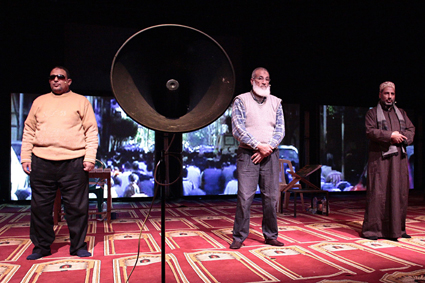
Radio Muezzin, Rimini Protokoll
photo courtesy Rimini Protokoll
Radio Muezzin, Rimini Protokoll
SITTING IN THE DARK WE EXPERIENCE THE SOUNDS AND VIBRATIONS OF THE AZAN, OR CALL TO PRAYER, SUNG BY THREE MUEZZINS FROM SEPARATE CORNERS OF THE AUDITORIUM. EVENTUALLY EACH SINGER IS REVEALED BY A SPOTLIGHT. THROUGH A MÉLANGE OF INTERMINGLING MELODIES, RHYTHMS AND TEMPI, ABDELMOTY ABDELSAMIA, HUSSEIN GOUD AND MANSOUR ABDELSALAM EVOKE FOR US THE SOUNDSCAPE OF CAIRO.
This is the opening of Radio Muezzin (RT107, p3), a documentary performance directed by Stefan Kaegi of Berlin-based Rimini Protokoll. Since 2000, directors Kaegi, Helgard Haug and Daniel Wetzel have worked in a wide range of collaborative partnerships, producing diverse and acclaimed forms of socially-engaged performance. Through Radio Muezzin, and the upcoming production in May of 100% Melbourne, Australian audiences are able to experience first hand Rimini’s unique version of Reality Theatre. This currently prominent mode of performance engages with the ‘facts’ of social reality, particularly through representing contemporary people. The representations may involve a scripted text based on interviews and documents and/or the literal appearance of the people themselves in real-life sites. What is distinctive about Rimini’s version of Reality Theatre is their replacement of professional actors with people who are specialists in other fields of life. Working with these “experts of the everyday,” Rimini open up live encounters between people unfamiliar with each other within a globalised world.
While the local adaptations of the 100% series offer insights into the seemingly familiar aspects of one’s own city, Radio Muezzin (2008–) allows a glimpse of an Egypt inaccessible to many, one inhabited by four muezzins and a radio engineer, Sayed Abdellatif. Through carefully orchestrated autobiographical stories, the presentation of religious rituals, still images, video footage and soundscape, we gain diverse insights, mainly into the lives of the less visible members of Egypt’s institutionalised Islamic faith. These ‘good souls’ of the mosque introduce us to their daily responsibilities, including housekeeping tasks, and their religious roles as teachers of the Qur’an and callers of the azan.
During the production the audience are made aware that the visibility of these muezzins is likely to be diminished even further, for, as Sayed informs us, the azan in Cairo “will no longer be called from thousands of voices but will be broadcast via radio.” As in other works by Rimini, the homogenising nature of such centralisation processes is a key concern. So too is the related issue of censorship—the withholding of information and the making absent and silencing of citizens that can accompany such centralisation. The theme of silencing is later sounded again when Mohamed Ali, a young socially empowered muezzin who only appears in a highly mediated way (via footage, sound recording and a performer who reads out his text), announces: “[t]o avoid the different voices and times the Ministry [for Religious Affairs] has decided that only one man is to call people to each prayer.” He also declares himself to be one of the 30 trained voices selected to perform this role. These brief and dispersed comments from the engineer and muezzin leave much to the imagination. For example, the reasons for the changes, date of their completion and the economic consequences are never fully fleshed out. Will the men stand to lose their jobs, or ‘only’ their public prayer voice?
As is typical of Rimini’s work, Radio Muezzin rarely presents its political and cultural concerns in a didactic manner. In part this approach stems from sensitivity to the political context and to the personal needs and safety of the experts. In the last section of the performance the production overtly acknowledges the impact of regulatory forces that limited what could be said and shown. During the blind muezzin Hussein Gouda’s rendition of a religious song, statements—presumably from the Ministry—roll silently in Arabic (accompanied by English surtitles) across the streetscape footage on the upstage screen, telling us some of what the authorities saw fit to ban: “On the screens there should be no donkeys or dogs. And also no garbage or actors. Muezzins cannot play dominoes on stage…What can’t be said in the presence of one’s mother, sister, daughter or wife one should not say in front of any woman.”
The muezzin’s function as a role model for the Egyptian citizenry and ambassador for Islamic faith is perhaps one reason why the protagonists’ political opinions and differences are only partially revealed. For example, we learn that Mohamed Ali left the show after coming into conflict with the other muezzins, but the details of the dispute are never divulged. The partial concealment here is one of the ways Rimini work to ensure that the act of making an unfamiliar person visible does not slip into the terrain of dangerous or exploitative spectacle.
Rimini’s interest in ensuring voice and visibility is memorably embodied in one of the final images of the show where the live experts (and the performer who sometimes reads the missing muezzin’s text) stand silently facing the audience alongside a large loudspeaker. Out of the ‘mouth’ of this technology we hear a recording of Mohamed Ali calling the azan, while in the background is footage of Muslim men praying with their backs to us in a street. On one level the episode can be received as a protest against forms of centralisation that make some humans (including women) partially redundant or invisible. Yet, the radio system also disseminates a powerful and beautiful voice, and, in combination with the recording and film technologies, provides broad access to a significant mode of singing and religious ritual.
In a manner typical of Rimini Protokoll’s theatre, this image from the concluding section never congeals into a simple assertion about human relations with technology. For us, both the image and the show presented the possibility of a careful intertwining of humans with machines, as modelled by Sayed the engineer, and by the elderly muezzin Abdelmoty, who while working as an electrician managed electricity’s positive and negative force. Such an interaction is also pursued by Rimini through a dialogue between the experts’ (live and mediated) bodies; the technologies of their environments featured in the show—such as the rotating fans, vacuum cleaners, clocks that tell the prayer times and the green fluorescent lighting of Cairo’s mosques; and the audio-visual technologies that help create Rimini’s stage worlds.
The non-didactic images and information gaps within Radio Muezzin also invite spectators to actively develop their own meanings. Rather than a dramaturgy based around conflict and its resolution, Rimini Protokoll frequently uses a segment-oriented structure where autobiographical commentaries offer only partial access to the performers’ actions, choices and statements and where on-stage dialogue is replaced by the juxtaposition of statements given in direct address to the audience. For example, the muezzins’ views of recent political change in Egypt are dispersed throughout the piece as snippets rather than being presented in a sustained exchange of differing opinions. While this dramaturgy of fragmentary information prompted us to engage in ongoing meaning-making, on occasion the holey fabric left us too uncertain about the nature of what was at stake for the muezzins, for Rimini Protokoll and for Egypt.
100% melbourne
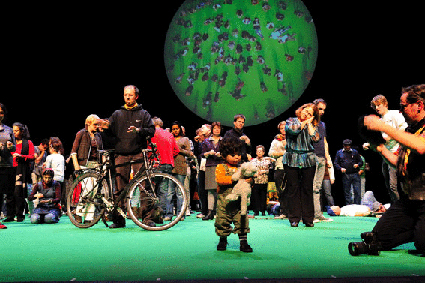
100% Köln, Rimini Protokoll
photo courtesy Rimini Protokoll
100% Köln, Rimini Protokoll
The individual human being is also put in the spotlight in Rimini’s 100% city series. Like previous shows in Berlin, Karlsruhe, Vancouver (RT102), Vienna and Cologne, 100% Melbourne will seek to give the individual a voice and a face which otherwise tends to disappear behind the statistical pie charts and graphs that are used to depict the masses for, say, political cost-benefit analyses. Rimini only chooses the first person, who then initiates a personalised statistical chain reaction by selecting an acquaintance in accordance with criteria drawn from the local statistics office. The acquaintance in turn proposes one further person, and so on, until the cast of 100 creates a mosaic of a city according to gender, age, ethnicity and suburb.
Having representatives of individual suburbs on stage, each performance can address local interests and concerns that are also shared—often enthusiastically—by their audience. After an initial self-introduction, these issues are introduced via survey-type questions, to which the individuals on stage respond by arranging themselves in groups or holding up signs. While this presentation is a clear display of individual and collective opinions, potential reasons for or tensions between the individual responses shown on stage generally have remained unexplored. For example, in 100% Köln the experts’ majority vote in favour of the recently completed mosque in their city sits without explanation alongside their lack of a majority for a public call to prayer. In the case of 100% Melbourne it will be interesting to see what issues Rimini Protokoll will leave quietly resonating in the air.
100% Melbourne by Rimini Protokoll, with the support of the Goethe-Institut and Arts Victoria, will be presented at the Melbourne Town Hall, May 4-6, 2012. In conjunction with this event, on May 5 the Goethe-Institut Melbourne will host a panel discussion, “100% Rimini Protokoll: Cutting-edge Documentary Theatre that puts ‘Real Melbournians’ on the Stage.” For further information about the company’s work see: www.rimini-protokoll.de/website/en/
Rimini Protokoll, Radio Muezzin, Seymour Centre, Everest Theatre, Sydney Festival, January 16-21; 100% Melbourne, Melbourne Town Hall, May 4-6
RealTime issue #108 April-May 2012 pg. 26
© Meg Mumford & Ulrike Gard; for permission to reproduce apply to realtime@realtimearts.net
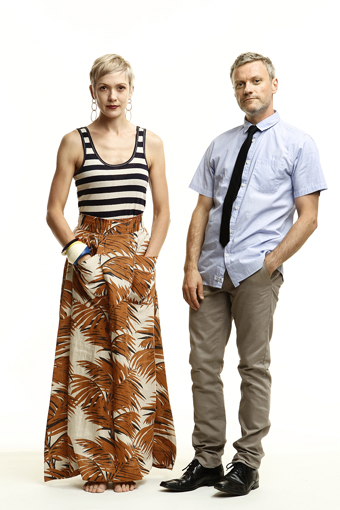
Kate Denborough, Gerard Van Dyck, KAGE
photo Jeff Busby
Kate Denborough, Gerard Van Dyck, KAGE
MELBOURNE-BASED KATE DENBOROUGH AND GERARD VAN DYCK’S PHYSICAL THEATRE COMPANY, KAGE, CELEBRATES ITS 15TH BIRTHDAY THIS YEAR, AND THE COMPANY SEEMS TO EMANATE ALL OF THE POSITIVE QUALITIES OF ITS TEENAGED YEARS WITH NONE OF THE ACCOMPANYING NEGATIVES.
Other collaborations lurching towards such an age can be overtaken by insecurities and restlessness, a wondering if things might be better elsewhere. But Denborough and Van Dyck—despite international acclaim and a series of high profile commissions across Australia—seem as curious and eager to encounter the new as they were 15 years ago.
“We still feel our best work is ahead of us,” says Denborough. “That’s still our driving impetus. We’ve still got lots of ideas and things we want to do.”
“I feel like we’re just starting now,” says Van Dyck. It’s an odd statement from such a successful creative partnership spanning more than a decade, but perhaps it’s because KAGE isn’t a brand merely churning out variations on a theme or style. The company’s brief has never been easily categorised—’physical theatre’ or ‘visual theatre’ have been bandied about, but each new work appears as if cut from a fresh cloth. There are consistencies across productions, but the differences seem to make these fade into the background.
“Our resilience and perseverance and willingness to do what we want to do and not subscribe to other people’s expectations is the only reason we’ve survived, really,” says Denborough. “If we’d worried what other people think of us too much we would have crumbled. There are enormous expectations and demands to be black and white. It’s not so much an unwillingness to be put in a pigeonhole and more a willingness to be expansive. We’ve always tried to put a positive spin on it, for our own sanity I suppose.”
The pair met while studying dance at VCA and discovered a range of affinities from the outset. “We really loved each other’s sense of drama within the movement,” says Van Dyck. “Dance as a storytelling device rather than an abstract artform. And on top of that, a sense of humour. That’s where our working relationship began, with those elements. The first handful of works we made…I wouldn’t say they were comedy but there was silliness or absurdity. Then we moved into things that were perhaps more humane or more serious. But when it comes to me and Kate working in a room together or just hanging out, none of that’s changed. All of that is still really there. Which is probably testament to why we’re still here.”
“We looked around us and wanted to create something that we didn’t see happening,” says Denborough, an impetus that still seems to drive KAGE. “Both of us were drawn to collaboration. Even at lunchtime we’d hang out with the musos, some of the visual arts production students. We already had an eclectic eye because we didn’t just hang out in the dance studio and want to dance. Right from the start, I think that’s been a key aspect in our aesthetic.”
While collaboration is a crucial tenet in contemporary performance, the company pays more than lip service to the idea and the results are another reason each KAGE production carries with it a distinct sense of vitality and reinvention. Denborough and Van Dyck have drawn on the talents of circus performers, children, bodybuilders, opera singers, poets and cartoonists, among many others. And each has not been merely a resource to be mined, but a pivotal contributor to the breathing essence of a work.
Denborough is pragmatic about this method. “In terms of performers, it’s really interesting finding dancers who’ve come from different backgrounds. Or who are not necessarily trained dancers but are amazing physical movers. Because there can be quite a sense of sameness when you see a lot of dancers who have had very similar training from one institution. The style and the methodology of the teaching can mean things can tend to look very similar. But when you get bodies who have had really different physical experiences and you work with them over a period of time, the possibilities become much more exciting.”
sundowner
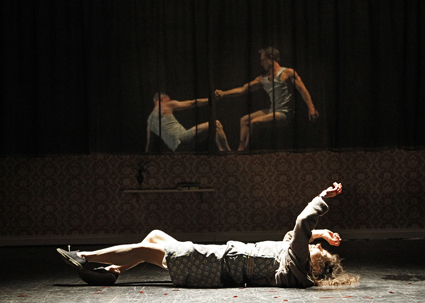
Sundowner, KAGE
photo Jeff Busby
Sundowner, KAGE
This interest in collaboration has also seen KAGE subtly move from an earlier character of abstract visual theatre towards a more grounded, socially engaged process. A case in point is Sundowner, which premiered at the Castlemaine State Festival last year and which will be staged in Geelong and Melbourne in 2012. The work explores experiences of dementia, particularly early onset dementia, and the process by which it was developed is illustrative of the company’s methodology.
Denborough conducted a series of interviews with carers, documenting their stories, and these oral encounters formed the launching point for a forum involving artists, the carers and a group of people with younger onset dementia. The discussions which resulted produced a field from which the work could draw, rather than a simple testimony which would be adapted to the stage verbatim.
“For instance there’s one woman who told us a beautiful story about her dad,” says Denborough. “He’d tell her that every morning he would meet this guy and have these fantastic chats. It turned out that it was actually him looking at himself in the mirror but he thought it was a stranger who happened to be meeting him in the bathroom every morning. Lots and lots of the stories we heard we started filtering into the show, but we really did it over a long period of time.”
team of life
Another work KAGE will be developing in 2012 is Team of Life, a piece that uses sporting metaphors to connect with young people who have experienced disadvantage. “[Working with] Aboriginal and Torres Strait Islander kids and their love of AFL, and young refugees and soccer,” says Denborough, “it’s based on a writing methodology called the Team of Life…So if your family has been massacred and you’ve got no-one, it’s about how you might begin to rebuild your ‘team’ through this metaphor from sport, which a lot of these young boys and girls have a fantastic passion for.”
flesh and bone
And then there’s Flesh and Bone, another work in progress that upends any sense of an obvious trajectory for the company. Eschewing the large sets and sprawling casts of recent works, it’s an intimate work which sees Denborough and Van Dyck sharing the stage—alone—for the first time in almost a decade. In 2001 the pair decided to demarcate their roles, Denborough as director and Van Dyck as performer. Flesh and Bone might be an appropriate 15th birthday present, then, both a return and a step in a new direction.
“That’s one of the reasons that we wanted to do it,” says Van Dyck. “We like to reinvent things, we don’t like to get too stuck in the ways things are done. Maybe here we’re going back to methods that we’ve worked with before, but we certainly haven’t for almost 10 years and it’s about time.”
Kage Physical Theatre, www.kage.com.au
RealTime issue #108 April-May 2012 pg. 27
© John Bailey; for permission to reproduce apply to realtime@realtimearts.net
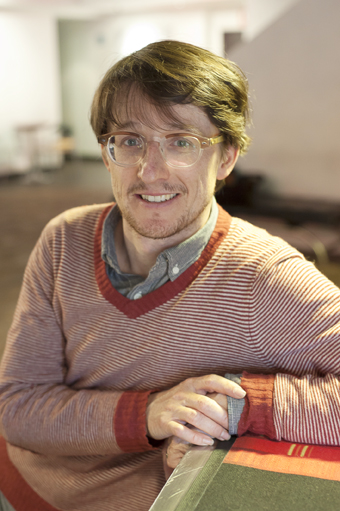
Matthew Whittet
photo Patrick Boland
Matthew Whittet
MATTHEW WHITTET WON THE PHILIP PARSONS YOUNG PLAYWRIGHTS AWARD IN 2010 WITH HIS PROPOSED PLAY, OLD MAN. NOW IT’S ABOUT TO PREMIERE IN BELVOIR’S DOWNSTAIRS THEATRE WITH A STELLAR CAST WORKING A VERY INTIMATE SPACE—AN APT ONE FOR A WORK WITH A DEEP SENSE OF INTERIORITY AND PASSAGES OF STREAM-OF-CONSCIOUSNESS DELIRIUM.
The Sydney-based actor has written five full-length plays: 12 (short-listed for the Patrick White Award in 2006 and workshopped at the Australian National Playwrights Conference), Warren, Silver (performed by Whittet as part of the 2009 B Sharp Season at Belvoir and at the National Theatre of Iceland in Reykjavik) and two commissioned works, Fugitive for Windmill Theatre and Harbinger for Brink Productions—both staged in Adelaide in 2010.
In Old Man, Daniel, a father of two young children, is subject to a profound experience of loss—his family appears to have deserted him. Or has he abandoned them? He cruelly rejects his mother’s help and, panicking, wanders the same streets as his anxious children. Underlying this deep-seated separation anxiety is his father’s desertion when he was a child. The first part of the play is addressed directly to the audience, amplifying a range of emotional crises.
I had the pleasure of reading the draft of Old Man that will go into rehearsal, where doubtless it will go through a number of changes, says Whittet, whom I met in the Belvoir offices to discuss the play.
One of the things that struck me straight off is that you’ve written a kind of dissociative play; a substantial part of it is not linear in any conventional sense. What was it that drew you to the form—the nature of the subject that you’re dealing with?
This is basically laying my cards on the table. LAUGHS. I performed in a show at Sydney Theatre Company a couple years ago, Anthony Neilson’s The Wonderful World of Dissocia, which I found a really fascinating form to work with… [but] the second half tended to explain and close doors on the magical first half. In the end it was a slightly reductive experience. So, although I really loved the structure, I kept thinking surely there must be a way of playing with this kind of form but finding a way where you open more doors in the second half that have been hinted at in the first but lead you on a completely different path.
So when you see the second part, you think back over the first—forced to consider what might have happened? It’s disorienting and sometimes quite spooky, even on the page.
It works on echoes and on memories but with more of a theatrical language to do with what’s happening to these bodies in space and what’s happening inside these people, less than necessarily the story of what has happened.
What drew you to write a play about a son and his missing father?
I have a five-year old and I really wanted to explore the idea of fatherhood and what it is. I was really curious to visit the experience of what it means to people I know who don’t have fathers or haven’t grown up with their fathers. How then do you learn to be a father? Where does that come from? It’s something that’s passed down, I think, the same way that motherhood is, in the same way anything is. I had big chats with a few friends when I was considering what this piece was and how I’d attack it before I’d even started writing. A friend said, you’re a father; you’ve got to put yourself on the line; you have to explore something of your own experience.
Exploring your own anxieties?
Yes. What I wanted to explore in the first half was my notion of the what-if, my notion of what would happen if I woke up one day and my family—whom I love and have no problems with; none of that anxiety exists—has gone. It’s about digging into, I guess, the possibility of loss, which always exists, that could be there at any moment. It’s quite challenging as a young father to try to imagine what it would be like to be without your family. It’s horrible. Hopefully that sort of feeling has gone into the play.
It’s a feeling scattered through a prism, isn’t it—all the characters at some point feel abandoned, to the extent that you wonder, is this one man’s nightmare or something larger?
In my heart I think it’s not as small as one person’s experience. What I want to do in the first half is to very much enter into an inner state for a whole lot of people. The audience sit with intense levels of intimacy with performers who basically speak directly to them for the first half of the production. There’s nothing new about that performance style, but when you play with its simplicity it actually does become quite confronting.
It reduces the opportunities for conventional staging.
Absolutely, and I’m really interested in how that affects their relationship to the text and to the audience. In the end the binary I was really interested in started with the closeness of the first half, that absolute access so that it is about touch and smell and it is all actually very, very concrete. There’s very little abstracted notion of anything except for the fact that these people are trying to grapple with a story they can’t quite get their hands on, that they can’t touch and they can’t understand. All they know is that things are missing.
I’m really interested in how that access, that closeness in the first half then leads to the second half in which all access is completely closed, where a fourth wall goes up. But, hopefully, you still have a connection with Daniel and what he experienced in the first half as it goes into the second. It’s kind of like putting a magnifying glass on an anxiety and burning it for a moment. You’re faced with how do you deal with day-to-day with horrors and fears—these enormous things. Without giving anything away, the play opens out into ‘the narrative’ of the piece, which I think, despite the strangeness, the hard-to-pin-downness of the first half, actually lands cleanly on something.
Though not with that terrible word ‘closure’ in mind. It still leaves you with plenty to ponder.
I hope so.
Daniel’s not necessarily a strong character. He doesn’t come across as a strong father. As you say, how do you learn to be a father if you haven’t had one. It’s like he doesn’t quite know the rules.
It feels to me like an honest response to the way a lot of people deal with being parents. My own family has structure but, being in the arts, our routines are not set in stone. Hopefully Old Man paints a picture of a simple, honest, modern response to what it is to be a parent.
These are not really complex people. The state they’re in is complex but they’re not complex people.
It’s dealing with the day-to-day and I think it’s the complexity of their thought that brings out the complexity to the piece. Outside of that, hopefully what it does is to create a lot of situations and characters that then become incredibly recognisable.
There’s a line, in a very moving scene in the second half of the play, where Daniel says, referring to and politely underplaying the impact of the absence of his father, “No blame, I just had a gap.” But it’s a very big gap, an emotional chasm in fact, and it’s hard to imagine that Daniel will fully survive it. He’s also worried that if he doesn’t become a proper father, one who will be remembered, that nothing will change generation to generation. I wondered if there is an element of fatalism in Daniel or is that something he’ll overcome?
I took a very, very long time—relative to the time it took to write the play—to find the last line of the play. I think it lands on something, which for me becomes the heart of the question of what is going on for this man.
With these characters I wanted them to explore particular moments very cleanly. In the second half of the play, what I’m trying to do, in a very delicate way, is to speak of a moment in time. It becomes not about an answer to an issue, or a way in which someone makes things right, but just to explore that simple, simple moment of someone meeting someone for the first time in their life and just how you can’t make such a moment heroic. You can barely speak. It’s a complicated and incredibly delicate meeting of people and I think that’s what I was interested in exploring; whatever these characters go on and do after the end of this play is in another world.
How long has the writing of the play taken you?
I write rather quickly. I won the Philip Parsons Award in 2010 and started writing in February last year.
Was the director Anthea Williams involved in the play’s evolution?
Anthea was involved from very early on as dramaturg and she fought to direct it, which is fabulous—to have someone who’s so committed to the play. It’s the sort of piece that will be very much about sitting with great actors—Ben Winspear, Alison Bell, Gillian Jones, Peter Carroll—a metre or so from your face. We’ve been doing auditions for the two roles for kids, which is really exciting. There are some phenomenal kids out there. It’s intimidating! You’re 12 and you can do that? I couldn’t do that at 12!
Do you feel the Downstairs Theatre will work well for the play?
I think that was one of [artistic director] Ralph Myer’s first responses when he heard it read—and Anthea and [associate director] Eamon Flack as well. The first thing they thought: this is the sort of experience that would be really special downstairs because of its intimacy.
Belvoir, Matthew Whittet, Old Man, Downstairs Theatre, Belvoir Street Theatre, Sydney, June 7-July 1
RealTime issue #108 April-May 2012 pg. 28
© Keith Gallasch; for permission to reproduce apply to realtime@realtimearts.net
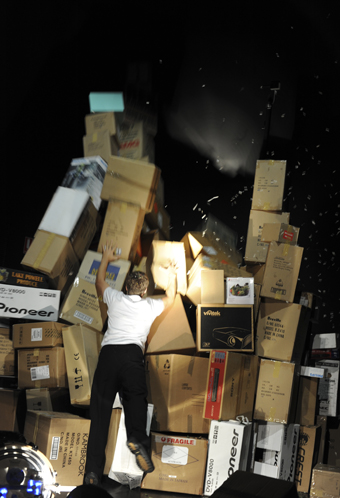
Sam Routledge, Jack & the Beanstallk
photo Heidrun Löhr
Sam Routledge, Jack & the Beanstallk
JACK AND THE BEANSTALK: A MUSICAL FAIRYTALE IS THE SECOND STAGE OF CHIARA GUIDI’S DEVELOPMENT OF THEATRE FOR CHILDREN AT CAMPBELLTOWN ARTS CENTRE. AS CO-FOUNDER, WITH ROMEO CASTELLUCCI, OF HIGH PROFILE ITALIAN THEATRE COMPANY SOCÌETAS RAFFAELLO SANZIO, GUIDI SPOKE AT THE CENTRE IN 2010 OF HER AIMS TO CONSTRUCT A “CHILDHOOD OF THEATRE” WHICH INCORPORATED THE GENIUS OF YOUTH IN A “REVERSE PEDAGOGY.”
Children can see through the senses, she explained, and thereby have access to imagination before reality impinges (RT100, p32). Listening to Guidi speak in 2010, and watching her work in a process-driven masterclass of unfolding surprises, I was struck by her intense harnessing of the life of childhood to inform a theatre of self-conscious story-ing: objects uncannily entered the space only to depart moments later; characters were suddenly bigger or smaller or absent; there was darkness and fear, but jokes and laughter too. In this workshop, children were narrative subjects, participants and teachers, leading adult performance makers on a journey into the ‘forgottenness’ of creativity.
Jack and the Beanstalk shifts Guidi’s collaboration with Campbelltown Arts Centre to a more traditional phase. This time, adults make a work for children to watch. The darkness of her 2010 workshop has been maintained, as have its fear associations, but the open participatory space has been drawn into a more static, seated set-up. We enter to an empty stage flanked by musicians, the mood already tense. The performers begin percussive spatterings of cymbal, drum and high-pitched, atonal “Jacks.” The sound is anarchic and urgent, if in a slightly aged, experimental way. Jack (Sam Routledge) is the object of our concern with the frenzied noise around him making for an ominous start to a story that most in the audience know well. Jack trades a cow for magic beans; the beans grow a giant stalk which he climbs, enabling him to steal gold, a gold-laying goose and a harp from an ogre who guards them in the sky. Jack thrice faces his fears and is rewarded by claiming the wares as his own and shafting the ogre into to the heavens for good by cutting down the stalk.
As with many fairytales, the pathos of Jack and the Beanstalk is underwritten by a number of narrative discomforts which fail to historically translate: Jack is a protagonist whose stealing we applaud and he repeatedly steals without warrant (it seems). He is greedy and devious (it seems) and yet we are on his side. None of this particularly matters, except that it becomes a blind spot the work-in-progress does not seem interested in tackling. Beyond animating a context in which children can safely live out fear, the work doesn’t really explain why Jack does what he does. Why this story of greedy heroics? Why here? Why now?
What is clear is that the tale has been used to foreground a dramaturgy of imagination. In this, terror and dread are summoned by way of narrative suggestion; little happens visually in the space but the sonic environment is full. The performers’ actions are presentational; they work ball games, task-based actions and text across a stage which refuses to visualise the gruesome ogre or his heavens. Instead, we hear the doomful clanking of his tableware and imagine the children he’s yearning to munch. The narrator (Katia Molino) does a good job of enticing us into this world of fear. Volunteers are selected to accompany Jack to the ogre’s house behind the curtains and some are visibly scared, raising their hands only to turn back. I asked one young boy after the show what the ogre’s house was like: “Great,” he said, “I got to help them with their sound effects, banging plates and cups and things.”
Guidi and her Australian collaborators had a challenging, mere two weeks in which to get to know each other to develop this showing. As a work-in-progress, the theatrical tension sustained between visible and invisible, material and imagined is meaningfully crafted. There were moments when theatre got carried away with its own imagination, rupturing the diffusely non-representational space —including the entry of a glorious golden egg-laying goose, in life-sized puppet form, animated to flex and preen and nestle at the foot of the stage to be caressed at the close of the work.
Guidi’s enmeshment of the invisible world of the story with the aural world of the musicians marks the work’s clear departure from typical children’s theatre, replete as it usually is with playful colour and scenography. What remains to unfold, however, is to imagine into imagination which is what Chiara Guidi has so passionately called for. The final work will premiere at Campbelltown Arts Centre in 2013. For this, I’m counting on seeing a theatre for children which is other to itself altogether. This is no small ask, but having observed this project from the outset, it lingers as a tantalising promise nonetheless.
Jack and the Beanstalk: A Musical Fairytale, director Chiara Guidi, facilitator Jeff Stein, performers Drew Fairly, Christa Hughes, Katia Molino, Sam Routledge, Annette Tesoriero, musicians Robbie Avenaim, Jim Denley, Veren Grigorov, Paul Prestipino, Laura Tanata, design and puppetry Scott Wright, lighting Clytie Smith, producer Annemarie Dalziel; Campelltown Arts Centre NSW, Feb 17-19
RealTime issue #108 April-May 2012 pg. 29
© Bryoni Trezise; for permission to reproduce apply to realtime@realtimearts.net
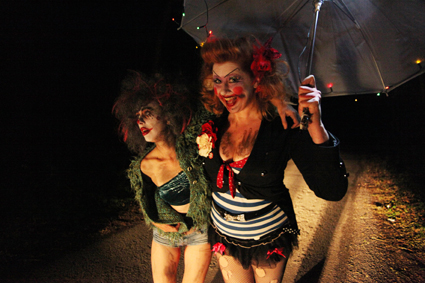
And the Birds Fell from the Sky, Il Pixel Rosso
photo Joe Murray
And the Birds Fell from the Sky, Il Pixel Rosso
I ARRIVE ON TIME AT ARTS HOUSE ONLY TO DISCOVER THAT THIS PERFORMANCE IS AT THE WAREHOUSE. ONCE INSIDE, I FIND I’M LATE FOR AN AUDIENCE WITH THREE CLOWNS. THE CLOWNS ARE CRUDE, MUCH LIKE THE EQUIPMENT THAT AN USHER HAS ATTACHED TO MY HEAD. YES, THESE DEBAUCHED ESCAPEES FROM A MISFIT’S CIRCUS EXIST NOWHERE ELSE BUT AS PROJECTIONS ON-SCREEN INSIDE A LOW-TECH, VIRTUAL REALITY HEADPIECE.
We’re sitting inside a Jaguar, travelling at night along an obtuse road. A recorded voice demands that I accept an envelope containing a mysterious letter. Made complicit by this acceptance, the clowns and I engage in our road-trip while the recorded voice directs me toward performing certain tasks. Beyond the fabulated interior of the Jaguar, an actual person sits beside me. Disconcerted because my sight has been co-opted by a virtual scenario, I can nullify this performance by not participating. But who can resist the temptation to be jocular with three dickheads wearing face-paint and speaking Spanish while sharing vodka from a filthy bottle? When the recorded voice demands that I look at my virtual hands, I realise they are covered in blood. Of course, my actual hands are clean. But as a man traversing life’s treadmill I have become the fourth clown, and therefore, the biggest dickhead of all.
We’re joined by a fifth clown, but not before a lone jogger is exterminated in a random act of violence. The recorded voice demands I stare out the passenger window. I see in my reflection not a clown but a handsome, yet slightly haunted male face. He stares at me, as I do at my unidentifiable self. Prompted to forget my present location, I nevertheless remember that I have not left The Warehouse. But when illusion is applied metaphorically, as a performance strategy within a technological context, it is difficult not to make conclusions. Actual human presence, once made cyberspatial, is also a revision of human presence. This revision is an amplification, or an augmentation, of what human presence might become once flesh and blood are replaced by mathematical equation. But this low-tech show is economically diminished because its creators wish to make a point. Faustian pacts with utopian technologies are deceitful, if not dangerous. When my road-trip ends and is replaced by a vision of my unidentifiable self standing in an open field (complete with wind on face, a sprinkle of rain and the scent of lavender), the conceptual framework for this show leaps from the technological into the philosophical.
Science, the same discipline that promotes the illusion of cyberspace, never allows us to forget that human presence, as perceived, is itself an illusion. Standing before me, as a play of light upon my optic nerve, my unidentifiable self hands me the talon of a bird that, presumably, has fallen from the sky. Then, like me, he vaporises, and my screen is black. Who are we but atomisations of energy passing through the labyrinth of Quantum Theory? Once outside The Warehouse, a person resembling myself disappears toward the end of the street. Somewhere, a clown flutters an eyelid, and I am gone.
Il Pixel Rosso (UK): And the Birds Fell from the Sky, writer-directors Simon Wilkinson, Sylvia Mercuriali, performers Xelis Del Toro, Sylvia Mercuriali, Simon Wilkinson, Matt Rudkin, Avis Cockbill, Sharon Honour Mission, Lucy Joy, Joe Kenney, Ulysses Black, Lewis Reid, Crystal Dave Reid, cinematographers Joe Murray, Simon Wilkinson, art director, script development Matt Rudkin, audio-visual editors Sylvia Mercuriali, Simon Wilkinson, supported by Brisbane Powerhouse, presented by Arts House, Melbourne, Feb 29-March 18
RealTime issue #108 April-May 2012 pg. 29
© Tony Reck; for permission to reproduce apply to realtime@realtimearts.net
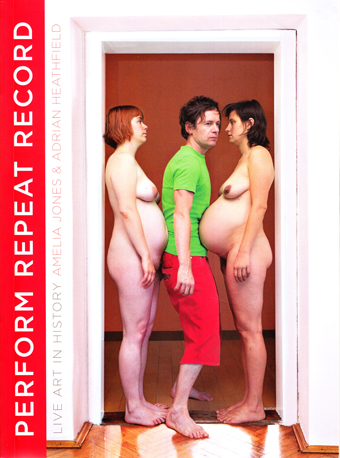 IN THE LATE 1990S, PERFORMANCE STUDIES WAS DOMINATED BY DEBATES ABOUT ABSENCE, DISAPPEARANCE AND DISPLACEMENT. PERHAPS THE MOST FAMOUS TEXT TO EMERGE FROM THIS PERIOD WAS PEGGY PHELAN’S UNMARKED: THE POLITICS OF PERFORMANCE (1993), IN WHICH SHE PROPOSED THAT:
IN THE LATE 1990S, PERFORMANCE STUDIES WAS DOMINATED BY DEBATES ABOUT ABSENCE, DISAPPEARANCE AND DISPLACEMENT. PERHAPS THE MOST FAMOUS TEXT TO EMERGE FROM THIS PERIOD WAS PEGGY PHELAN’S UNMARKED: THE POLITICS OF PERFORMANCE (1993), IN WHICH SHE PROPOSED THAT:
“[P]erformance’s only life is in the present. Performance cannot be saved, recorded, documented, or otherwise participate in the circulation of representations of representations: Once it does so, it becomes something other than performance. To the degree that performance attempts to enter the economy of reproduction it betrays and lessens the promise of its own ontology. Performance’s being…becomes itself through disappearance.”
Then suddenly, the conversation changed and we found ourselves talking not of absence, but of presence, repetition and remains. For a scholar who had only just oriented herself in the field, the switch seemed to come out of nowhere but on reflection it had been building for some time. Early indications were evident in Philip Auslander’s Liveness: Performance in a Mediatized Culture (1999), in which he argued against the ontological and instead insisted on the historical and ideological nature of the live. The shift could also be seen in Diana Taylor’s The Archive and the Repertoire: Performing Cultural Memory in the Americas (2003), in which she argued that while performance may escape the archive (text, document, history), it nevertheless endures in the repertoire (speech, gesture, memory). Shortly after this, came an abundance of books on the actor’s presence, including Joseph Roach’s It (2007) and Jane Goodall’s Stage Presence (2008). Since then, the trend has accelerated, with the arrival of Rebecca Schneider’s Performing Remains: Art and War in Times of Theatrical Reenactment (2011) and now Amelia Jones and Adrian Heathfield’s edited volume Perform, Repeat, Record: Live Art in History (2012).
theories and histories
This is a weighty book, in both senses of the word, and can be seen as a simultaneous compilation and consolidation of two decades worth of thinking and talking about Peggy Phelan’s formulations. Indeed, almost every essay in Perform, Repeat, Record refers to her. The book is divided into three sections, the first titled Theories and Histories. It consists of 13 essays which deal with three overlapping themes: disappearance and documentation; the economy of reproduction and reception; and the globalisation of performance as both form and field. In the opening essay, Auslander examines the photographs of Chris Burden’s Shoot (1971) and Yves Klein’s Leap into the Void (1960) to argue that “the crucial relationship is not the one between the document and the performance but the one between the document and its audience.” If the document produces pleasure, pain and thought in its interlocutor, then it is not simply an index of a past event but can be seen as a performance in and of itself. To put it otherwise, as Christopher Bedford does in his analysis of Shoot and its aftermath, performance can no longer be defined by, or confined to, its originary event. Instead, it “splinters, mutates, and multiplies over time in the hands of various critical constituencies in a variety of media, to yield a body of critical work that extends the primary act of the performance into the indefinite future of reproduction.” For this reason, he describes performance as having a “viral ontology.”
The language of the viral is also implicit in Mechtild Widrich’s account of the “repeated outbreaks” of VALIE EXPORT’s Genital Panic (1969). Widrich argues that this performance comes into being not through its live enactment (which may or may not have occurred) but through the artist’s descriptions of it as well as later photographs, posters and reenactments. The epidemic also finds its way into Mónica Mayer’s essay, when she states that “performance art is such a lethal virus that it has even infected the ways in which we register it.” But the broader thrust of her essay concerns the hitherto obscured history of performance art in Mexico, from the 1920s to today. In a similar move, Eleonora Fabião examines the work of Afro-Brazilian artist Arthur Bispo do Rosario, firstly to retrieve a history of South American performance but secondly to propose a theory of performance that focuses on its precarity rather than its ephemerality. She writes: “If ‘ephemerality’ denotes disappearance and absence (thus, predicating at a certain moment, something was fully given to view), ‘precariousness’ denotes the incompleteness of every apparition as its corporeal, moving, constitutive condition.” Likewise, Meiling Cheng considers Chinese performance in order to argue that “documentation reviews, repeats, records, relearns, and re-imagines a partially memorialized past to generate a present tense re-encounter with pieces from the past and to facilitate future generations’ reliving of these semi-processed pasts in their present moments. What we call ‘live,’ then, points to a perceiver’s present-tense intertwinement with the fleeting sense of being alive.”
In this way, Widrich, Fabião and Cheng reflect Schneider who, in an iteration of her 2001 article “Performance Remains,” argues against the archival logic that perceives performance as disappearance and proposes instead that performance persists “differently, via itself as repetition—like a copy or perhaps more like a ritual—like an echo in the ears of a confidence keeper, an audience member, a witness.” Jane Blocker treats the issue of repetition in more detail in her analysis of the work of Bruce Nauman and Steve McQueen, as does Andre Lepecki who discusses his reenactment of Allan Kaprow’s 18 Happenings in 6 Parts (RT83, p17). Here, instead of positioning the document as score for, or record of a performance—as is so often the case—Lepecki sees Kaprow’s scribbled papers as “nothing other than a necessary and unavoidable rehearsal.” Hannah Higgins deals with another iconic figure, George Maciunas, not so much to recuperate his reputation or work but rather to displace it and to bring other Fluxus members to the fore. Her analysis of the politics of reception sits nicely alongside Sven Lütticken’s chapter, which argues that “performance art has never been a real threat to the spectacle” or indeed to capitalism. Instead, it has become complicit in the economy of experience and when documentation is banned, as in the case of German-British artist Tino Sehgal, it merely serves to add to the event’s aura and expense.
documents
In the second section we move from theories about documents to documents themselves. The section collates 20 documents by artists as diverse as Franko B, Nao Bustamante, Tim Etchells, Guillermo Gómez-Peña, Orlan, Rabih Mroué, Santiago Sierra and Faith Wilding, among others. Some of these documents focus on a particular performance, as in the case of Sierra, who provides four pictures of Polyurethane Sprayed on the Backs of 10 Workers (2004), but leaves the brief commentary to Jones. Others consider a performance and its double, as in the case of Wilding who places the text of her iconic Waiting (1972) alongside photographs of its reenactment Waiting-With (2007). Still others take a chronological approach, as in the case of Gómez-Peña who rehearses a timeline of his life in art. Local readers will be interested in Lucas Ihlein’s account of his and Louise Curham’s recreation of Anthony McCall’s Long Film for Ambient Light at Artspace and in gallery director Blair French’s account of Aftermath (2007), which investigated the intersection of performance and installation and included works by Arahmiani, Guy Benfield, Franz Ehmann, Anne Graham, Tony Schwensen and André Stitt (all discussed and documented here; also see RT79, p8).
dialogues
In the final section there are 11 interviews and performance lectures, with Jones and Heathfield participating in three apiece. The former interviews Carolee Schneeman, Marina Abramovic and Shezad Dawood about a range of issues, but in each instance the conversation comes back to the vexed issue of copyright. For Schneemann, the issue is that she cannot access some documentation of her work as it is being withheld by the documenter. For Abramovic, the issue is not simply about documentation but also the performance and, specifically, the performer. In performing other artists’ work, she seeks not simply to reactivate the past but to model an ethical relationship to it: “to show how we should really address these pieces…in re-enacting other artists’ works you have to ask permission, you have to do your own interpretations…there has to be a kind of seriousness to it.” For his part, Dawood attempts to sidestep the issue by incorporating photography into the performance itself, so that the two become indistinguishable.
Heathfield’s interview of Teching Hsieh (RT90, p52) focuses on his One Year Performance series. Of these, Hsieh says (echoing Auslander, Bedford and Widrich), “an audience’s presence is not vital. As long as audiences know my concept and the real action I did, they can use their own experiences and imagination to feel these artworks…[In fact, sometimes] being present physically may not be helpful.” Heathfield also interviews artist Janine Antoni, whose practice is at once “object-centred, site-specific, and process work.” While these two interviews are fairly formal, Heathfield’s encounter with Tim Etchells and photographer Hugo Glendinning [who has been investigating the nature of performance photography with Forced Entertainment. Eds] is more casual, but still contains some poignant thoughts on the “professionalization of presence” and the persistence of distance.
Other interesting interviews include Joanna Scanlan and Tilda Swinton’s conversation about agency and authorship in Swinton and Cordelia Parker’s performance-installation The Maybe (1995) and Iain Forsyth and Jane Pollard’s discussion of their restagings of iconic rock gigs and the possibility of “re-witnessing…something that’s already mythologized, unwitnessed except perhaps by a lucky few.” Perhaps they could restage the work of Goat Island, the now-retired company of Lin Hixon and Matthew Goulish, but if not, we will always have their lyrical lecture performed here on the page as poem, script and image. Philosopher Jean Luc-Nancy performs a similarly poetic pas de deux with Mathilde Monnier, in which they discuss the role of repetition and medium in dance and the (im)possiblility of (im)mediation.
The breadth and depth of Perform, Repeat, Record are astonishing and the range of artists, scholars and insights invigorating. The book has been years in the making, hardly surprising when you consider the work involved in producing, sourcing and selecting all of this material, not to mention some of the writing (Jones and Heathfield’s introductions are excellent). While I initially read the book as a riff on presence and persistence, when I reread it I found this phrase from Heathfield: “Perhaps we should no longer speak of presence and absence, since there is neither one nor the other, but the tireless movement between: the continuous flux of bodies with other bodies. No more talk then of a unitary or self-coincident body. No integrities, but instead intensities of exchange and flow.” The achievement of Perform, Repeat, Record, then, is not that it recuperates presence but rather that it starts to destabilise the presence-absence polarity that has structured performance studies for the past two decades. It does so, not in order to plot a third way, but rather to facilitate the intense exchange and flow of ideas. It leaves me overwhelmed.
Amelia Jones and Adrian Heathfield, eds, Perform, Repeat, Record: Live Art in History; Intellect, Bristol and Chicago, in collaboration with the Live Art Development Agency, 2012, 656 pages; www.intellectbooks.co.uk
RealTime issue #108 April-May 2012 pg. 30
© Caroline Wake; for permission to reproduce apply to realtime@realtimearts.net
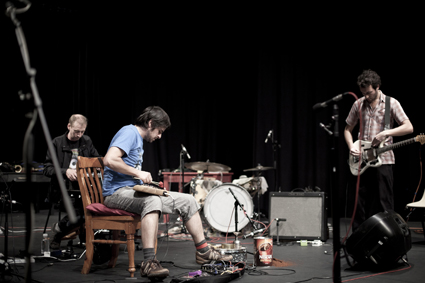
(l-r) – Michael Norris, Eric Normand, Ryan Kernoa
photo James Brown
(l-r) – Michael Norris, Eric Normand, Ryan Kernoa
SOMETIME IN THE 1950S PIANIST CECIL TAYLOR WROTE THE DECEPTIVELY SIMPLE PHRASE, “FORM IS POSSIBILITY,” WHICH ON REFLECTION MEANT THAT ARTISTS WITH ENQUIRING MINDS AND SENSIBILITIES SHOULD USE THEIR ARTISTRY TO DISCOVER NEW MUSICAL FORMS.
To break from convention and the comfortably familiar is never easy but the rewards often justify the effort. The quest to discover new forms was enthusiastically undertaken by the 16 local and international artists who performed at SoundOut 2012, a festival of improvised music that took place on the last weekend of January within the leafy, low-key environs of Theatre 3 nestled behind the School of Art on the Australian National University campus. Organiser Richard Johnson overcame what can only be described as baffling funding difficulties from those who should know better to program a world class line-up of performers from Canada, France and Japan, playing with like-minded home grown artists who mostly operate in the realm of electro-acoustic improvisation.
Featured instruments at the festival included saxophones, guitars, prepared piano, flute and percussion augmented by seemingly haphazard assemblages of electronics that littered a stage, at times looking like the aftermath of a computer technology fair. The electronics were mostly made up of exposed components used to explore tonality and pitch with barely a melody to be heard. The aim was to engender new ways of listening and engaging with music particularly when electronics and acoustic instruments melded and overlapped. On occasion the electronics became part of the physicality of the performance: Canadian guitarist Eric Normand coaxed feedback from an electric bass while hammering on an assortment of small electronic devices with an increasing intensity to match the fierce overtones in the music.
In contrast, a festival-goer wandering into Theatre 3 early on Saturday afternoon would have been greeted by trance-inducing ambient drones coming from Julian Day’s uncomplicated keyboard with which he created a dreamy minimalism that sent the listener on an introspective and altogether pleasant journey that might otherwise have been brought on by the likes of Steve Reich or Brian Eno (see RT106, p39). Then there was the Zen-like discipline with which Japanese artist Toshimaru Nakamura conjured micro-tonal sound shapes from a no-input mixing board that alternatively blended with Sabine Vogel’s (Germany) flute and Jim Denley’s hissing and chattering wind instruments to create a serene solemnity.
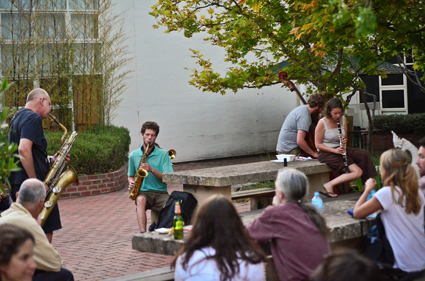
Richard Johnson, Andrew Fedorovitch, Rishin Singh, Laura Altman, Sam Pettigrew
photo James Brown
Richard Johnson, Andrew Fedorovitch, Rishin Singh, Laura Altman, Sam Pettigrew
Until Saturday evening all performances had taken place in the theatre but, in the democratic tradition that defines improvised music, a last minute collective decision was made that Richard Johnson and Andrew Fedorovitch on saxophone with Rishin Singh on trombone, Sam Pettigrew on bass and Laura Altman on clarinet would play in the theatre courtyard. As dusk came on, the audience, fellow performers and assembled instrumentalists eagerly gathered outside. The ensuing 50-minute performance, which involved gentle breathing in its creation of insect-like harmonies, transformed a pleasant natural environment into a harmonious space of free creativity where at one point trombonist Singh spontaneously rustled some leaves in response to the tactile call and response entreaties from Richard Johnson’s impressive looking and sounding baritone saxophone. In this way the music melded with the environment and the organic surround sound was a joy to behold.
This was a shining example of spontaneous field performance, but let’s contrast it with the superb Saturday afternoon theatre set from electric guitarist Ryan Kernoa (France) in combination with bassist Eric Normand (Canada) and Canberra musician Michael Norris on electronics. Normand does a lot more than merely strum his instrument in time, which one has often come to expect from a bass player. If I can be so bold as to make the comparison, Normand does for improvised music what Joy Division bassist Peter Hook did for post-punk—redefining the role of the bass so that it becomes a lead instrument allowing for harmonic interplay beyond simply laying foundations. Normand attached all sorts of devices to his instrument. He banged and stroked it in equal measure to set a scene that involved controlled feedback, theatre in the form of physical contortions in response to the sound, and a highly disciplined approach to noise-making. This was enhanced to the nth degree by the mouth-watering atonality of guitarist Ryan Kernoa who altogether dispensed with melody to explore bristling electrified string configurations which at times reminded me of Thurston Moore at his finest. When Michael Norris’ flailing tonal pitches on electronics were added to the mix the ensuing sound from the three performers was a welcome reminder that improvised music hasn’t forgotten noise.
Of the 18 performances in the festival the latter two stood out for me amidst so much activity involving all sorts of instrumental blends.
SoundOut 2012 was a special event. The mechanics of each performance, including the nightly collective improvisations, produced a beautiful harmony of artistic intent and sense-stimulating sound-making. This highlighted a dedication to the open and democratic craft of improvised music from the performers who invited audience members to experience the joys of supple creativity. Improvised music is about fulfilling the potential of uninhibited self-expression within a setting that encourages genuine engagement and there was plenty of this on offer at SoundOut 2012. It seemed that true freedom was within reach.
SoundOut 2012, artistic director Richard Johnson, Theatre 3, Australian National University, Canberra, Jan 27-28; http://soundout2012.blogspot.com.au/
RealTime issue #108 April-May 2012 pg. 31
© Dan Bigna; for permission to reproduce apply to realtime@realtimearts.net
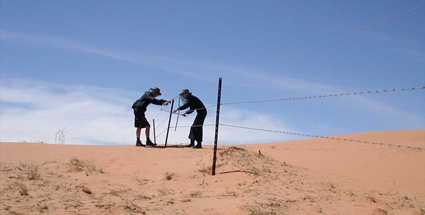
Jon Rose & Hollis Taylor, play a fence in the Strzelecki
AT THE TURA 2012 PROGRAM LAUNCH IN PERTH ON MARCH 21, JON ROSE WAS ANNOUNCED AS THE WINNER OF THE AUSTRALIA COUNCIL’S PRESTIGIOUS DON BANKS AWARD.
UK born, Rose arrived in Australia in 1976 at the age of 25 and, somehow finding this country’s idiosyncrasies to his liking, exploded into a plethora of activities, which continue to this day. As well as being a consummate violinist and versatile improviser, he has made a multitude of instruments and has also created many radio works. Most recently he has been exploring interactive music making experiences in works such as Pursuit, using musical bicycles (see RT90; RT96), an interactive netball game, Team Music! (RT96); and the multi-user festival hit The Ball project (RT102).
Rose has also embraced the Australian landscape, evidenced in his Great Fences of Australia project undertaken with his partner, violinist Hollis Taylor, which saw the couple travelling across the outback playing and recording the sounds of Australia’s many fences. This journey is beautifully documented in a book by Taylor called Post Impressions (see RT82). Another epic adventure was the Ad Lib Project, an extensive archive of weird and wonderful music-making activities from around the nation, housed on the ABC’s website. It perhaps best illustrates Rose’s conflicted love for this country and its curious history which he enticingly articulated in his 2008 Peggy Glanville-Hicks address (RT83) and which he discusses in the following conversation with equally respected musician and improviser Jim Denley.
instrument builder
Jim Denley In preparing to talk with you today, I actually went back and listened to some of your early 1980s work, like Devils and Angels [Fringe Benefit Records 1984], where you use multi-stringed instruments. If I compare it to say Derek Bailey’s solo guitar playing in the 70s it seems like what you were doing is a logical extension—this search for a kind of multiplicity through complexity and velocity.
Jon Rose A multiplicity of events—that’s a good way of describing it. First of all there was a 19-string violin which was stolen in London. Then there was the 19-string half cello to replace that, which has incidentally also been stolen…Those instruments were specifically about multiplicity, using also amplification to project certain things, so you had a stereo image and could place things within that image.
But there were other instruments…I had ideas about certain areas of experimentation and I built the instrument to try to figure out what to do with it. So there was one violin with a very long neck and 16 strings set up in a way that they were never intended to be played individually, but played as a mass. There was an instrument that was played by the wind—an Aeolian violin. There was a tromba marina [a medieval triangular bowed string instrument] that was attached to my boat which I had at the time, which used water to change the focal length of the resonating chamber. There was a megaphone violin that had an FM radio microphone in it. So it’s not true to say that it was always about finding multiplicity. Some things were about trying to get a sound happening which was not the normal sound made through applying a bow to a string—the usual hold, slip, hold, slip, sawtooth wave form.
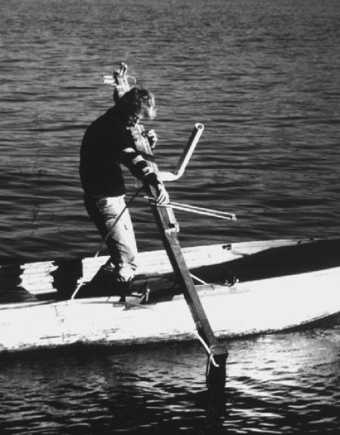
Jon Rose playing the Tromba Mariner, 1979
…In the second half of the 70s I was in this strange country and I just got on with what I thought was appropriate. There were not that many people to play with and those that were available had a certain area they wanted to go in that wasn’t so interesting to me, I was basically left to my own devices…I enjoyed that space. I think if I’d stayed in Europe I wouldn’t have done that somehow. I would have been busy in bands or in groups. And I also had the advantage of very quickly being able to get commercial work to live off. Playing in a country and western band or in Club Marconi two or three nights a week…You could be a professional musician and the rest of the time free to do whatever you wanted to.
JD In thinking about those times, as a young musician from the ‘Gong’ [Wollongong], you were kind of a mentor to me and other musicians. You just sidestepped the local inanity and if you couldn’t get a gig in Sydney, you didn’t worry about it…You presented an international agenda and a multimedia agenda. If you couldn’t operate in one sphere, you’d operate in another.
JR Well in the 70s…you could go almost anywhere except the Opera House and play a concert, because people said, ‘Sure.’ The first improvised concerts took place at the Institute of Contemporary Art—a gallery run by a couple of architects which [sound artist] Rik Rue helped set up. And they were just delighted to have people come in and do stuff. The same as Stephen Mori Gallery later. It was open. The thing that I got from Sydney was that I finally formulated what I was going to do with my life…which was this artform around the violin or strings in general.
the dominant body
JD There’s something almost paradoxical in much 21st century and late 20th century music: it’s almost as if music has been running away from the human body. I was talking to Stephen Adams, the composer and ABC broadcaster, recently and for him you represent a kind of humanist approach to phraseology and gesture. It seems to me, when you work with technology, the body dominates the technology.
JR That’s very well put. Otherwise I’m not interested. I’m not interested in pressing return and playing a file. Although that’s not to say it can’t be useful. That technology doesn’t give me much as a musical instrument, whereas if I apply it—like in The Ball project for example—[I can] use technology to try and re-engage the populace at large in the business of making music. The last time I did The Ball Project, it was in front of 400 people [at MONA FOMA 2011]. I said they shouldn’t kick it because they might hurt their feet but really they could do what they wanted with it, and they just started to make music. You couldn’t sit those 400 people down and get them to listen to a playback file of electronic music, they wouldn’t have it. But they got it immediately—they could make this stuff.
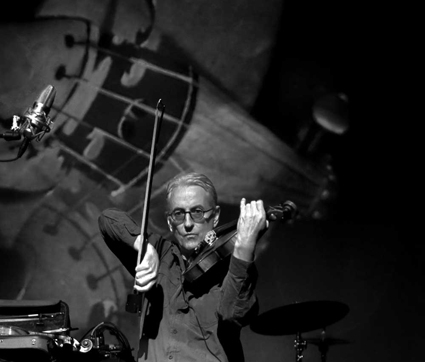
Jon Rose playing Palimpolin, with the K-Bow at Galapagos Club, New York, 2010
photo Jill Steinberg
Jon Rose playing Palimpolin, with the K-Bow at Galapagos Club, New York, 2010
All my interest in that technology comes from the bow anyway. That’s the first thing I tried to do was to make the bow interactive so that it would do other things…Now I’m working with a small company in California who’ve got real resources and can make things much better than I could…But all that interest in the technology comes through the violin. If I hadn’t been born when I was I would have been doing “what can a violin do with a horse and cart?”…I’d be looking at the context for what to do with this instrument. Because the context in which it’s usually stuck is always out of date.
historical landscapes
JD It seemed to me that you embraced Australia. And reading through Hollis Taylor’s book, Post Impressions, she documents a love—especially of the outback. What is it about Australia that makes it such a fertile place to work?
JR Culturally this is a perverse place, and it’s a uniquely perverse place. Colonialism happened all over the world but Australia is extremely distant and it’s a big place with a small population which has made people confused, psychologically really unsure of themselves, desperate to grasp at things from other places, overseas and so on. And you have this culture that is permanently in denial, even to this day.
… If you look for the history of music, particularly in the 19th century, here it’s just got these extraordinary stories. You couldn’t make them up. The first Aboriginal string Orchestra in the 1860s, founded by [Benedictine Monk] Rosendo Salvador in New Norcia in Western Australia; you meet people like Rosina Boston who plays the gum leaf. Everywhere I look, there’s some extraordinary stuff…Jamaica has come up with three genres of music: Ska, Reggae and Calypso, it’s also a colonial place. But in Australia, nobody came up with a genre. And you start looking at why…If you’re going to be a musician and live in Australia, you have to deal with the place at some level.
JD Is that why, later this year you’re going to take a bunch of young musicians out to the far west of New South Wales?
JR This is the plan… I’ve been doing this stuff (with Hollis too) pretty solidly since I got back and started living in Sydney again in 2002. Any skill or knowledge we have should be handed on…we’re the only people who have worked extensively in that part of the world, as far as I know, in what you might call…what do you call it these days…I hate the word ‘sound art’—new music, experimental music, exploratory music?
exodus australis
JD As the Ad Lib website proposes, there’s a lot of interesting stuff that’s happened here and is happening…We’re saying this is an exciting place, Australia, it’s got a great history. And yet, you’ve gone off with a DAAD scholarship to Berlin and lived in Europe again and then returned. I see generation after generation of young musicians relocating, usually to Europe. Are we always going to be parochial? To make a mark do you have to relocate?
JR Up to 1981, which was the first time I played at Moers (New Jazz Festival), I assumed that no one ever got paid for this. I thought that’s extraordinary. So after that there came more opportunities and I thought, well I’ll divide my time. Pretty much every year I lived in Berlin I did come back, mainly because there was the option of the ABC [radio] which was amazing. I could make programs and do some concerts and whatever. But it became clear to survive doing this work you have to be international. But where my passion lies is here.
Also it depends what kind of a musician you are…I have a broad output and so that makes me different really from say a classic improviser. That’s a little part of what I want, but it’s not the whole picture.
changing contexts
JD But that collaborative improvising musician which you clearly are, a lot of people might not know about that Jon Rose. With the Don Banks Award you’re presented as a composer.
JR It’s a word I hate. But eventually you give up trying to correct people. What is it? I don’t know any more because now everyone uses the word ‘improvisation’ all over the place…
…Collaboration is one thing, and with different groups—working with communities on one thing and seeing what can come out of that; working with classical musicians is another. But basically it’s the context change that interests me in a primary sort of way. Anything can sound extraordinary if you change the context. So one of the pieces I did out at Wogarno station [for Tura New Music’s Outback series] was with a front-end hoe—a digging machine basically. Just an amazing collaboration which I thoroughly enjoyed. It wasn’t because it was warped or off-centre. I really enjoyed it. It made me want to play.
I think I need to be in situations where I really want to play like it’s my last concert, that’s really important to me. And I tend to avoid situations where that’s not the case, where it’s going to be a routine….That’s not possible for me. I guess it is for some musicians and I guess that’s really important for music that there are people who will do that—keep the Mozart churning out.
…I really want to use the Don Banks to point or put a very small spotlight on the other people and other organisations that do whatever we want to call this music, this ‘other music.’ People who have worked in What Is Music?, Robbie Avenaim, The Make It Up Club, the NOW now, people like yourself Jim, Tos Mahoney in WA, Lawrence English and lately MONA FOMA, there’s a list…The funding is a joke, but somehow the stuff keeps going. And the wonderful thing about it is that it points back to a time when to be living in Australia made you look to your own resources. It was the ultimate do-it-yourself boot camp in a way and has been for most of its history.
Can I interview you now?
Jon Rose, 2012 Australia Council Don Banks Music Award; www.australiacouncil.gov.au; www.jonroseweb.com/
The Australia Council’s Don Banks Award is valued at $60,000 and is offered annually by the Council’s Music Board honouring an artist of high distinction and over 50 years of age who has made an outstanding and sustained contribution to Australia music.
Interview introduced and edited by Gail Priest.
Click here for the artv video of this interview
RealTime issue #108 April-May 2012 pg. 34-35
© Jim Denley & Gail Priest; for permission to reproduce apply to realtime@realtimearts.net
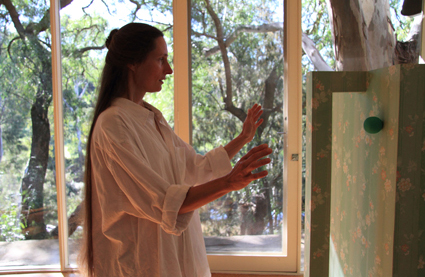
Deborah Kayser, The Box
photo Daisy Noyes
Deborah Kayser, The Box
APPOINTED IN 2009 TO THE ARTISTIC DIRECTORSHIP OF MELBOURNE’S CHAMBER MADE OPERA, DAVID YOUNG (FORMERLY ARTISTIC DIRECTOR OF APHIDS) HAD, HE SAYS, “A BRIEF TO RE-ENERGISE CMO AND TO TAKE IT IN A COMPLETELY NEW DIRECTION. SO WE’VE FOCUSED ON WHAT I THINK I CAN DO BEST WHICH IS TO MAKE NEW WORK THAT CROSSES THE BOUNDARIES OF CONTEMPORARY MUSIC, PERFORMANCE, THEATRE AND VISUAL ARTS, BRINGING ALL THESE TOGETHER, WHICH IS WHAT OPERA HAS ALWAYS DONE.”
Young also knew he had to do it “on a scale that was manageable for the company while retaining the level of quality—the pristine nature of the productions—that CMO had always been associated with. But I knew I wasn’t ever going to be able to do that on a huge mainstage and at a huge cost, not on the budget I had. Hence it wasn’t rocket science for me to look to where chamber music had started—in the home, in the living room. This gave us advantages: not just manageable scale, but it also allowed us to take risks we couldn’t with a big commission. And I’ve been able to give the artists completely free rein. It was incredible that Daniel Schlusser made a work [Ophelia Doesn’t Live Here Anymore, 2011] that he wouldn’t have made in a theatre—living room opera pushed him into a completely new space.”
CMO now has a considerable number of works in repertoire, “seven to eight within two years,” waiting to manifest in other living rooms or translate to theatres or galleries. “It depends on the particular work,” says Young, “Some are very site specific. The Box [2012, see RT109] was realised in a beautiful Robin Boyd-designed house, known as The Iris, on the Yarra Bend, a spectacular setting. It’s a very unassuming building actually, but you really feel like you’re in a tree house. The location is a big part of the experience, responding to the natural environment, the sounds, the house itself. But would The Box work without this house? Over 20 years I’ve translocated shows from one place or one city to another. Some work translates directly; you change nothing. Others have to be re-configured totally—that’s pretty much the case with the living room operas unless you can find a similar house or build one in a theatre. Malthouse is turning the Beckett Theatre into a living room for our co-production with Rawcus, Another Lament (RT101), featuring Ida Duelund Hansen, a wonderful Danish double bass player and singer. It premiered in 2011 in a home in suburban Armidale. We’re having a number of a very active conversations about placing our works.”
CMO is also involved in community engagement: “I have a very broad view of living rooms, as I have of opera,” Young quips. “The ‘Venny’ is an amazing adventure playground in Kensington located very close to a lot of public housing populated with people from very diverse backgrounds, culturally and economically. I thought it would be good for an extreme performance company to work with this community and give them access to contemporary performance. It’s very much a pilot. It will culminate in April with an opera performance involving the children and our musicians. We hope it will be of long term benefit for the community, for the playground and an opportunity for further work with us.”
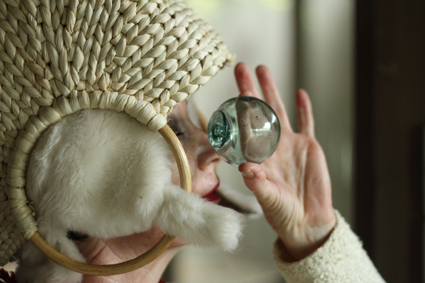
Hellen Sky, Minotaur, Chamber Made Opera
photo Daisy Noyes
Hellen Sky, Minotaur, Chamber Made Opera
Young always sees his work in an international perspective: “It’s really essential that Australian art engages with the rest of the world. It’s so easy, particularly in Melbourne, to think that the whole world is here because we’re so far away and because we have at least one of everything, of each kind of venue and company. It’s so important to work with artists from other places—as a reality check, to get a sense of what else is happening and understand where we fit in.” Chamber Made is engaging in an exchange program with LOD Music Theatre in Ghent. “It’s a contemporary chamber opera and music theatre company. It’s one of the companies most aesthetically aligned with us and also in scale. So we’ve committed to a two-year partnership which will begin with an exchange residency. First, artists will come from LOD and then Australians will go to Ghent in June. Our hope is that this will lead to a co-production which will premiere in Belgium in December 2013 and then play in Australia and, possibly, tour in Europe.”
It’s already a busy year for CMO with Fritz Hauser (Switzerland) having performed his solo gong work, Schraffur, at the Melbourne Recital Centre in March; the premiere of The Box (with Aphids, Fritz Hauser, Boa Baumann, Speak Percussion and Deborah Kayser) also in March; Minotaur (2011) travelling to the Aurora music festival in Western Sydney in May (see p14); and Another Lament at Malthouse in June as part of the XS Opera Festival.
What about the rest of the year? “Even busier,” the indefatigable Young declares. “There are the Nova Workshops with Opera Victoria: four works in two showings in December, one by Mary Finsterer which she has been working on for 10 years. The relationship with Victorian Opera has been wonderfully collegial and mutually supportive. We’re also running our second librettist workshop. There’s a real gap; very few places professionally develop librettists. It’s a kind of boot camp and one of the most successful things that came out of last year’s workshop was a ‘speed dating’ session between librettists and composers, 20 of each. We’re doing that again.” It’s clear that Young sees CMO as playing a nurturing role, whether in the development of new opportunities for composers through the living room and in-repertoire model, in community engagement and in skill development and partnering. Later in 2012, the Minotaur Trilogy will premiere and CMO will develop a new multimedia work.
It’s with a sense of jubilation and relief that Young declares, “The Box has been a breakthrough. It sold out a week before opening and I feel we now really know what we’re doing.” David Young’s idiosyncratic approach to art-making—multidisciplinary collaborations, site specificity, inventive sponsorship and commissioning models, the nurturing of new work and an international perspective—has reinvigorated and reinvented Chamber Made Opera and is breathing much-needed new life into Australian music theatre.
Chamber Made Opera, www.chambermadeopera.com
RealTime issue #108 April-May 2012 pg. 36
© Keith Gallasch; for permission to reproduce apply to realtime@realtimearts.net
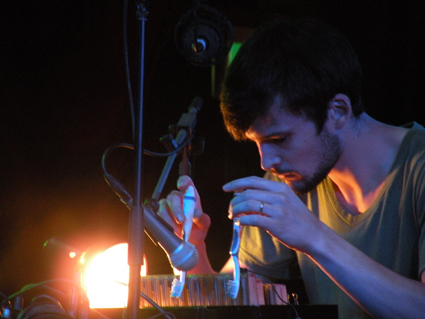
Nigel Brown, 12 Dog Cycle
photo Jess Olivieri
Nigel Brown, 12 Dog Cycle
LIKE MUCH OF THE EXPLORATORY MUSIC IT FACILITATES, THE NOW NOW FESTIVAL IS CONSTANTLY EVOLVING. BASED IN SYDNEY’S INNER WEST FOR THE SECOND YEAR, AFTER TRAVERSING THE INNER CITY AND BLUE MOUNTAINS SINCE 2002, THE 2012 FESTIVAL TYPIFIED THIS MOMENTUM WITH ONE OF THE MOST DENSE AND DIVERSE PROGRAMS YET. FEATURING TWO PUBLICATIONS, TWO SOUND WALKS, OVER 100 ARTISTS, ONE GROUP EXHIBITION AND SEVEN NIGHTS OF MUSIC OVER FOUR VENUES THERE WAS AN ABUNDANCE OF SOUND-BASED ART AND MUSIC TO ABSORB. I’LL FOCUS ON THE JANUARY 19 AND 21 PERFORMANCES.
With a sizeable crowd already ensconced in velvet armchairs or on cushioned crates at the Red Rattler Theatre, Melbourne duo 12 Dog Cycle began the evening with a low volcanic hum emanating from Nigel Brown’s dissected accordion. Amplified with contact microphones, the subterranean drone was punctuated by the scratch of electric toothbrush bristles against the exposed bass reed blocks accompanied by the shrill shrieks, gurgles and sudden silences of vocalist Alice Hui-Sheng Chang. With the uncanny ability to make her voice sound like more than one, her piercing bursts of sound roamed the warehouse rafters like a swarm of insects.
The ominous tone took a turn towards farce when Wollongong’s Gooble Gobble launched beards-first into the third set of the evening, presaged by “Santa Claus is Coming to Town” from one of the circuit bent toys littering the stage. Guitarists Gary Butler and Jariss Shead played everything, including the kitchen sink, with chaotic energy, partially reined in by the poise of laptop musician Nathan Penzer. While the resultant noise-fest would have benefited from distillation, the performance was endearingly enthusiastic, culminating in Butler fiercely grating styrofoam on his guitar strings and showering the stage in ‘snow.’
As well as being a showcase, the NOW Now Festival functions as a conference, bringing musicians together from around the world to network through events and curated groupings of performers. One such duo was the creative and ambitious pairing of turntablist Jordan Dorjee and stand-up comedian Nick Sun. Such a potentially awkward union requires excellent skills in improvisation, and though the set did feature some nice moments of spontaneity—“You want a joke? This whole situation is a joke”—there was, if slight, an overall lack of synergy. Nevertheless, it was bravely attempted and essentially one of the most experimental pieces of the festival.
On January 21, with the Red Rattler bathed in a dim blue glow, French musicians Christine Abdelnour and Ryan Kernoa began with a slow build-up of cicada-like trills that morphed into a low flapping pulse. Abdelnour’s guttural squeaks and skids from the saxophone complemented Kernoa’s icy guitar tones and waves of feedback, smoothly balancing the challenging and the pleasurable. Together they explored many terrains of sound, flowing in and out of melody and dissonance, calm and crescendo, weaving a misty sonic journey that held the audience entranced with its ethereal allure.
Next up was a trio featuring acclaimed Japanese no input mixer player Toshimaru Nakamura. With a sound at once immense and subdued, Nakamura came forth with a series of powerful, evenly spaced thumps, heralding the onset of Sam Pettigrew’s long notes on double-bass and Dale Gorfinkel’s randomised clicks and rattles. Gorfinkel’s adapted vibraphone and trumpet contraption are intriguing tactile playgrounds, as illustrated when a small boy approached mid-set to peer into the bell. Both Gorfinkel and Nakamura harness the haphazard tendencies of their instruments with masterly finesse. Pettigrew, pockets overflowing with implements, never gives the impression of overuse, instead employing each tool to timely advantage. The set peaked in a cataclysmic upsurge highlighted by Nakamura’s static spits, Pettigrew’s textured drones and the harmonic ring of mallet on vibe keys.
At the end of six sets it was somewhat taxing to drag drooping eyelids to the assembly of people awaiting the departure of Anthony Magen’s hour-long sound walk, but I’m glad I did. With a mind brimming with music it was a welcome relief to walk in silence through Marrickville. The only injunction being not to communicate, thoughts were free to roam, alighting on various heightened sensations without stress or force. Instead of a solemn procession there was a sense of playful youngsters cheekily provoking the curiousity of passersby, with some participants darting off to contemplate a vent or jump through a hole in some brickwork. The route itself was thoughtful and extensive with three stages most clearly defined by their soundtracks. After the isolated growls of passing cars inherent to the industrial precinct, the second part of the walk flowed into Sydenham Railway Station where our silent collective went virtually unnoticed amid beeps, automated voices and the occasional disengaged passenger. On the other side, wind and breath intertwined while clover heads thwacked against feet as we crossed Tillman Park and made our final stop-off under a large moonlit tree. When Magen stood up to declare the sound walk over we began to make our way back, our elated chatter contrasting with the rich magic of silent listening.
One of the aspects I love about experimental music events is the sense of communion with a crowd of people without the need for physical or verbal communication, a sensation epitomised by the sound walk and present in everything the NOW Now does. Inclusiveness and warmth is felt in all facets of the organisation; through the idiosyncratic MCs, quirky flyer design and camaraderie between all involved. As co-founder Clayton Thomas puts it, the mission is to “break down cliques” and that shared experience is what makes the NOW Now such a beloved and quintessential initiative in the Australian music scene.
The 2012 NOW Now Festival, curators Laura Altman, Sam Pettigrew, Rishin Singh, venues Stone Gallery, Hardware Gallery, the Red Rattler, Jarvie Park, Sydney, Jan 12–22
RealTime issue #108 April-May 2012 pg. 37
© Romy Caen; for permission to reproduce apply to realtime@realtimearts.net
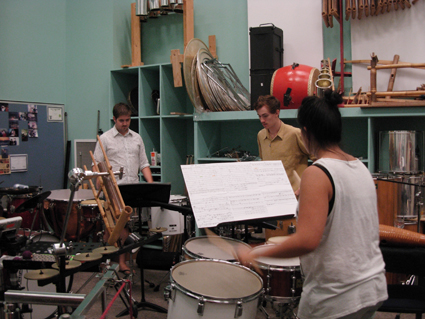
Nomad Percussion
photo courtesy the artists
Nomad Percussion
THE PERCUSSION ENSEMBLE MOUNTED THE STAGE TO DEAFENING APPLAUSE. THEY HAD TRAVELLED THOUSANDS OF MILES ONLY A WEEK BEFORE TO FIERCELY REHEARSE THE MOST CHALLENGING CONTEMPORARY REPERTOIRE FROM AROUND AUSTRALIA AND THE WORLD. THEIR BACKS ACHED AND THEIR HANDS WERE RAW FROM THE ORGANISED MAYHEM THEY REFUSED TO BLUFF. THE HALL FELL INTO AWED SILENCE. THE ENSEMBLE PAUSED, BREATHING IN UNISON.
This was not exactly the concert I attended, but rather the impression I got watching the six interstate percussion students that comprise Nomad Percussion perform their debut concert at the ANU’s School of Music. The room was small, but the courageous atmosphere surrounding their performance of such large-scale works as Anthony Pateras’ Refractions and Iannis Xenakis’ Persephassa on a week’s rehearsal was unforgettable.
When the members of Nomad Percussion met at National Music Camp it became evident that they should share their expertise and networks by forming an interstate percussion ensemble. In doing so they would build on the strengths of an already active Australian percussion scene, crossing the largely geographical but to some extent taste-driven divide between the repertoires of Synergy Percussion in Sydney and Speak Percussion in Melbourne. The welcome diversity of works on their debut program attested to the success of this formula. Last Waltz by Synergy artistic director Timothy Constable presented that group’s driving tom toms, snare drums and bongos. This tour de force contrasted well with Melbourne-based composer Mark Pollard’s minimalist reverie for vibraphone, The Heavenly Muzak Machine, the third movement of which features an undulating hymn played only with the fingertips.
In terms of scale, the highlights of the performance were the sextets Refractions and Persephassa, both pieces performed by Speak Percussion at the 2011 MONA FOMA (RT 102, p5). Steve Fitzgerald conducted Pateras’ Refractions, drawing from his experience performing the piece with Speak the previous year. The opening sextuplets where six timbres are rapidly passed between the performers were tightly executed with the relatively dead performance space lending a precision to quiet sounds and those with a fast attack. As such, the standout moments of the performance were not those of dynamic climax but the combination of wood rattles with crumpled paper and wood claps with kick drums and cymbal rolls. The intimate space also lent drama to the ear-tickling tones produced by Anna Ng’s expertly rubbed shot glasses.
While the grand spatialisation of Xenakis’ Persephassa suffered from the nigh on claustrophobic conditions, the physical energy and command of conductor William Jackson transported the audience to a hall eight times the size. Here the ensemble exhibited its greatest sense of musical intention, sustaining a uniformity of dynamics and timbres in the sounds passed around the room while deftly managing global dynamic and rhythmic changes. This strength of vision never waivered as the lengthy piece drew on the performers’ energy reserves, nor when they were called upon to blow whistles while playing.
It is thrilling to see Australia’s tradition of percussion moving from generation X to Y, especially with Nomad Percussion’s interstate vision and experience. I would like to see more concerts with this level of daring. Where is the Australian New Music String Quartet? The Oceanic Wind Ensemble for the Performance of Contemporary Music? The Intercontinental Students’ Electroacoustic Orchestra?
Nomad Percussion, A National Percussion Project, debut concert, ANU School of Music, Canberra, Feb 18
See RealTime 107 (p42) for Greg Hooper’s review of the debut of another percussion ensemble, Early Warning System. Eds.
RealTime issue #108 April-May 2012 pg. 38
© Matthew Lorenzon; for permission to reproduce apply to realtime@realtimearts.net
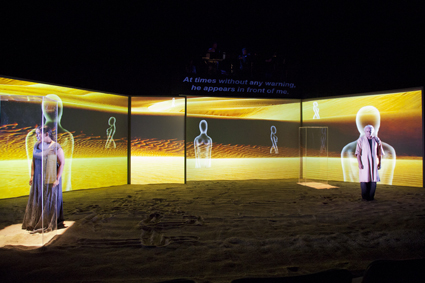
The Lady from the Sea, Abhinaya Theatre Company & Topology
photo Kevin Stallan
The Lady from the Sea, Abhinaya Theatre Company & Topology
THE LADY FROM THE SEA PRESENTS IBSEN’S PLAY AS A COLLABORATION BETWEEN BRISBANE’S TOPOLOGY AND THE ABHINAYA THEATRE COMPANY FROM KERALA (INDIA, ON THE LEFT HAND SIDE NEAR THE BOTTOM) AND TOOK ABOUT NINE MONTHS TO PUT TOGETHER, AMIDST OTHER WORK AND THE WHOLE PROBLEM OF EAST/WEST TIMEZONE DIFFERENCES. THERE’S A LOT OF TALK ABOUT COLLAB POST NET, BUT TIMEZONE STILL GETS IN THE WAY—IT’S A VERTICAL SLICE OF THE WORLD THAT’S THE EASIEST TO LINK UP. NORTH-SOUTH DIALOGUE FOR THE WIN.
The stage is a two and a bit level stack: Topology high up on the top, then below them the stage proper and surtitles in between. It’s the beach/under the ocean, the water clear, the sound of waves. Sand on the stage. Behind the stage the projection screens. Women float along, remora attached, translucent pale blue.
Rich conch drone from the bass and composer Robert Davidson’s first piece begins, exquisitely lyrical, an exceptional work. On stage, a woman struggles in argument with a disembodied, low male voice(over), soft and convincing in a language I don’t know. Doesn’t matter, tone carries all, and I seldom use the translation.
There are also three blokes on stage wearing fully head-covering flesh-coloured helmets that have a single eye. Now, generally, “fleshy helmet with single eye” induces risible penis references but these guys act as a form of mute chorus that seems to work. I feel as though I should be finding it more kitsch than I do.
The pace is slow—I think how a pulp thriller writer like Matthew Riley writes life as a rapid-fire series of short sharp episodes, zero character, zero description, the story transmitted through causal linkage of concrete actions. The Lady from the Sea presents the other view of life story, sloughed of events, immaterial. Life as Idea in Duration, rather than events jammed next to each other, strung out in a line, the more the better.
Two characters and “the voice.” The woman is emotional, distraught, histrionic. She is tempted by the voice, which seems to represent a type of counterfactual life. If only I’d done that and not the other then I wouldn’t be stuck with this, the now, the actual. She is distressed by her marriage to the actual man, the man on stage, who is not emotional, or not that you’d notice. Their marriage is breaking down, the glory days gone. The woman feels trapped by her own decision to marry and he just can’t say anything right, nothing that can make up for lost time, the dream life, the ‘if only then were now, choices would be changed, now would be better.’ She blames him for her decision. He should have been above the social, seen that she was trapped inside it. She wants to be apart, individual. He doesn’t disagree so much as can’t see the point. Unable to engage.
And underneath and throughout, the music. Like slow waves. Direct. True.
Abhinaya Theatre Company and Topology, The Lady from The Sea, in Malayalam with English surtitles, after Henrik Ibsen, composer Robert Davidson, director Jyothish M G; Brisbane Powerhouse, Feb 24-26
RealTime issue #108 April-May 2012 pg. 38
© Greg Hooper; for permission to reproduce apply to realtime@realtimearts.net
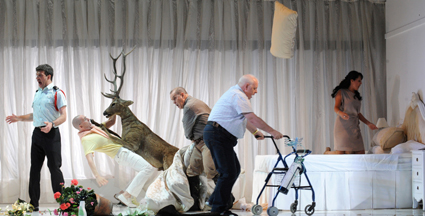
Opera Australia, The Marriage of Figaro
photo © Branco Gaica
Opera Australia, The Marriage of Figaro
THE COUNT TAKES AN AXE TO THE DOOR OF THE COUNTESS’ CLOSET, THINKING SHE HAS A LOVER HIDDEN THERE. LATER, AFTER A HUNT, HE DRAGS A DEAD STAG INTO HER ROOM. FIGARO, OVERCOME BY JEALOUSY, PLACES THE BARREL OF A SHOTGUN IN HIS MOUTH. THESE MOMENTS OF AGGRESSION, WHETHER TURNED OUTWARDS OR AGAINST THE SELF, ARE SHOCKING, HIGHLIGHTING THE MALE TYRANNY AND MISTRUST CENTRAL TO MOZART’S THE MARRIAGE OF FIGARO. THEY ARE INTEGRAL TO BENEDICT ANDREWS’ SUPERB PRODUCTION FOR OPERA AUSTRALIA.
Although we can laugh it off in due course, comedy is built on the fact of danger. The precariousness of virginity, marriage, property, status, indeed life in The Marriage of Figaro needs to be felt—it is in the music, and is on the stage. This opera is breathtakingly driven by threat and risk-taking, evasion and subterfuge, lies and delusions. Yes, entrapment and escape in Figaro are richly comic and inventively realised as such by Andrews and his adroit cast, but as with the opera’s rare moments of soulful interiority and loving embrace, the comedy needs to turn dark to reveal its deep seriousness. But Andrews, ever faithful to the work, does not dwell there. Although the impact of the shattering of the closet door reverberates for some time, the stag in the boudoir quickly becomes a comic prop in the ensuing farce to reveal who’s been duped. There is little time to linger or reflect.
Peter Conrad writes of Figaro, “If the work’s dramatic concern is living space, the musical counterpart to that is breathing space…Figaro is breathlessly overworked…[It] scrambles to keep up with the restless rearrangements of society and human relationships. The excitement of Figaro is the uniquely theatrical one of watching people thinking on their feet…” (A Song of Love and Death, The Meaning of Opera (Graywolf Press, 1996). Andrews sustains that breathlessness dramatically, even making it literal—and musical—in the character of Bartolo (Conal Coad), wheezing, grabbing for his oxygen mask, the gas cylinder attached to his walking frame.
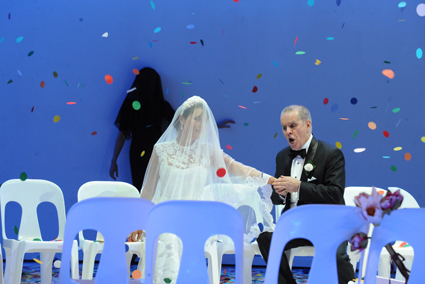
Elvira Fatykhova, Michael Lewis, ‘The Marriage of Figaro
photo © Branco Gaica
Elvira Fatykhova, Michael Lewis, ‘The Marriage of Figaro
As for living space, Andrews and his collaborators have located the opera in a large home in a gated community of our own time. Identically dressed servants and a pair of security guards, who frequently frame the action, serve the Count (Michael Lewis) and Countess (Elvira Fatykhova). During the overture, a sense of busyness and sociability is palpable as staff arrive for work and change into their uniforms. Before long, a frantic Upstairs Downstairs interplay between social castes is in motion.
For an opera that plays on a lack of privacy, on social congestion that yields invasion and farce, that interplay is, oddly enough, heightened by the spaciousness of Ralph Myers’ design. His stark white, modernist, open spaces convey the potential for vulnerability—where can one escape? Hide? From this Andrews extracts opportunities for comic invention and makes the most of the space for enlivened movement using, for example, a clothes rack on wheels, rows of overcoats, a cleaner’s trolley, plastic chairs. True to the opera’s inclination to farce, there are doors either side to small ante-rooms with which to engender constant suspense and surprise. With a bit of theatre magic at one point, the Count leaps out of a washing machine, one of the few objects in the room. With deliberately limited means Andrews, Myers and costume designer Alice Babidge dextrously make the most of what’s at hand or worn by the performers.
The Countess’ softly curtained room, with bed and vase of (tellingly deployed) flowers, looks like an immaculate Thomas Demand creation (RT107, p44), stripped of superfluous furnishing and decoration—until the Count shatters the closet door; and, later, he drags in the stag. Like the axe, the stag seems chillingly real in the rarefied world of an austere mansion removed from any reality beyond its immediate inhabitants. The contrast between the room’s potential for serenity and refuge, textured by the warm light through its wide window and the sudden invasions by violence and mortality yields indelible images as if from the Surrealist imagination.
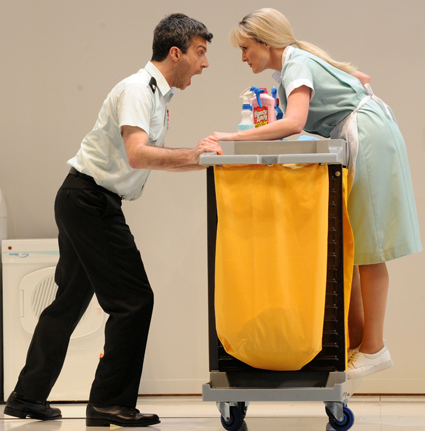
Joshua Bloom & Taryn Fiebig, The Marriage of Figaro
photo © Branco Gaica
Joshua Bloom & Taryn Fiebig, The Marriage of Figaro
The characterisations are vivid, broadly comic but textured with the minutiae of complex emotional states. Ensemble playing is constantly responsive and the large scenes finely orchestrated—not least the Lucy Guerin-choreographed wedding dance, communal, gestural and neatly articulated with its kicks and dips at the waist, strangely familiar and alien at once, part of the other-world, beyond most us, of the Count and his 21st century contemporaries.
In the end, the performers demount the wedding paraphernalia, opening out the space not into a garden but a relatively unbordered night sky, a space of possibilities, especially of forgiveness and renewal as signalled in the shower of confetti that falls through the blue and lighting designer Nick Schlieper’s contrasting of stark interiors with this cosmic outside. As David Cairns reminds us in Mozart and His Operas (Penguin, 2007), one of a number of radical elements of the opera in its own time was that the Count must beg for forgiveness in public, just like his servant Figaro. The sudden vulnerability of power is explicit here in this vast space.
The production has everything you’d expect from this opera: the evident emotional and physical affection between Figaro (Joshua Bloom, nicely played as not too much of a charmer and with just the right touch of machismo that turns dark) and Susanna (Taryn Fiebig, a lively, determined, easy presence); the Countess’ despair; Marcellina’s (Jacqueline Dark) moral turnabout; the attraction felt by the Countess and Susanna for Cherubino (played perfectly by Ann Yun, replacing an indisposed Dominica Matthews); the emerging alliance of Susanna and the Countess, at once cunning and emotionally shared; the funny-sad revelation of Figaro’s origins; and a wickedly funny and abrasive gardener (Clifford Plumpton). The orchestra was in fine form, conducted by Anthony Legge, the libretto was delivered in Jeremy Sams’ witty translation, and the overall singing was lucid to the point of little need to attend the surtitles.
It was one of ‘those’ nights when I saw Figaro—conductor Simon Hewett and soprano Dominica Matthews were indisposed, and a technical fault brought down the fire curtain during the much-praised, opening gambit in which the rooms of the house, and the characters, are revealed successively and cinematically left to right. We didn’t get to see it. Despite this, and couple of subsequent curtain-falls, the production was an impressive one, faithful, coherent, funny and sad. As we exited, after passionate applause, on one side of me someone said, “That’s it. That’s the last time. We’ve tried our hardest.” On the other, “I’d heard bad things about what it was going to be like.I’m so glad I came”
This was a superb production, capturing at once the opera’s humour and its heart-felt seriousness, its laughter and pain, and grace, by deploying a conversational, quite realistic, closely observed dramatic tone within a deeply symbolic setting, where the impossible becomes possible and cruelty is forgiven. Andrews’ production is the perfect expression of David Cairns’ observation that “Figaro is both reality and ideal—anitheses too deeply interfused to be separated.”
Opera Australia, The Marriage of Figaro, composer Wolfgang Amadeus Mozart, libretto Lorenzo da Ponte, English translation Jeremy Sams, conductor Anthony Legge, director Benedict Andrews, designer Ralph Myers, costumes Alice Babidge, lighting Nick Schlieper, choreographer Lucy Guerin, Opera Theatre, Sydney Opera House, Feb 6-March 24
RealTime issue #108 April-May 2012 pg. 39
© Keith Gallasch; for permission to reproduce apply to realtime@realtimearts.net
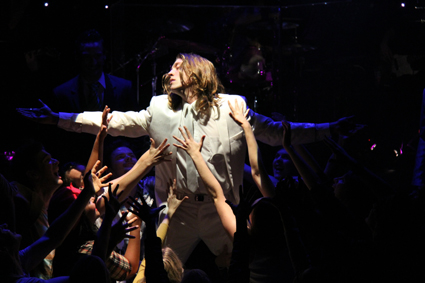
DreamSong (2011)
courtesy University of Melbourne
DreamSong (2011)
PLAY-READINGS ARE OFTEN WRITTEN OFF AS INFERIOR THEATRE EXPERIENCES, MERE SKETCHES HINTING AT THE TRUE SHAPE OF SOME FUTURE OPUS. IT’S NOT SUCH A STRETCH TO REVERSE THE EQUATION, THOUGH: AN ACCOMPLISHED READING COULD BE SEEN AS (TEXT-BASED) THEATRE STRIPPED TO ITS ESSENCE, THE PURITY OF LINE, THE SENSE OF SOMETHING UNFINISHED, THE GAPS AND SPACES SUGGESTING AN ABSTRACTION WHICH IS OFTEN THE GOAL OF OTHER ART FORMS.
A play-reading by necessity demands its audience construct theatres of the imagination, filling out these voids with colour, detail and meaning. It’s not unusual to view a full production after catching a reading and wonder why the final incarnation seems so strangely thin in comparison.
Music theatre comes up against an obstacle in this regard. It’s one thing to layer your own fantasies of set and lighting and casting and direction onto a heard text. It’s another to have to complete a half-rendered score in your own mind, unless you’re an accomplished composer yourself. This puts Arts Centre Melbourne’s annual Carnegie 18 series in a curious position. The staged readings of new music theatre aren’t just professional development showings—they’re open to the public with a ticket price attached. But neither are they simply pared-back versions of full productions. They’re abbreviated 40-50 minute presentations of works that are still in various stages of formation, and one of the most important elements of the series is that audiences are invited to offer feedback as to where a show needs serious work.
dreamsong
The three pieces that made up this year’s Carnegie 18 differed starkly in intent, style and probable outcome. The most developed of the trio, for instance, would be well suited (eventually) to the music theatre category in a comedy festival. DreamSong is a broad swipe at Evangelical Christianity – a US television preacher finds that the millions of dollars his song-and-dance showmanship have raised for his church have been all but squandered, and decides to manufacture a miracle to put the books back in the black. He grooms a young boy-band style poser to play the role of Jesus v2.0, but the reluctant arrival of the real Messiah on the scene threatens to topple his house of (credit) cards.
It’s farcical stuff—Jesus goes by the awful moniker of Chris T, though playing the Son of God as an over-the-top Woody Allen is worth a few good laughs. The score tends toward rock opera style, which suits the brash and sometimes outrageous plotting and characterisation. It’s not the most layered or sophisticated of musicals, but neither does it take itself too seriously.
cautionary tales for children
Meanwhile, there’s a seriousness to Arena Theatre’s Cautionary Tales for Children which is commendable—not towards its subject matter, but towards its young audience. It was fascinating to watch 6 and 7-year-olds polled as to whether certain elements were too scary for their age group, and which bits they wanted to see more of. Not that the crowd were silent during the showing, of course. The rambunctious outing cleverly adapts Hilaire Belloc’s dark and ironic moral fables of the early 20th century through the conceit of a time-travelling troupe journeying from the past to redeem some of history’s most wicked children—ie the viewers. Various catastrophes and deaths are played out through song (composed and performed on piano by Mark Jones) and, inevitably, each instructional tune fails to provide salvation for the terrible onlookers. It’s fine fun, and given Arena’s resources will likely be honed to a much tighter production in the near future.
the new black
The New Black was perhaps the most ambitious of the three new works, and was clearly still in the development stage. Story-wise it hops around: initially it appears a tongue-in-cheek dig at corporate hypocrisy and racism before shifting into a more emotive exploration of the conflicts experienced by young Indigenous Australians who turn their backs on their communities. The entire second half was more or less omitted, with promises that suggested a kind of road movie to Canberra, adding an extra element to the mix. I’m not sure if the script itself has been completed yet; if so, it could benefit from some dramaturgical sharpening.
But The New Black also offered the most lively and dynamic score of the three, its young musical director Hue Blanes displaying his confidence in working across a range of styles from gospel and soul to the more familiar soaring ballads of commercial music theatre. It was unfortunate—to this onlooker at least—that during the feedback session afterwards no less than two audience members asked why the music didn’t include more Indigenous Australian instrumentation; a didgeridoo, say? Kudos to Blanes for pointing out that the instrumentation is his and he is, you know, an Indigenous Australian himself. But again, when audiences are asked to fill out the curves of a work-in-progress, there’s no way of controlling what they’ll come up with.
Arts Centre Melbourne, Carnegie 18 New Music Theatre Program, The New Black, based on an idea by Leeroy Bilney, director Stephen Lloyd Helper, musical director Hue Blanes, Fairfax Theatre, Feb 1-4; Arena Theatre, Cautionary Tales for Childen, based on the verses by Hilaire Belloc, adapted by Claudia O’Doherty, composer Mark Jones, director Chris Kohn, designer Jonathon Oxlade, Fairfax Theatre, Feb 4-7; DreamSong, book & lyrics by Hugo Chiarella, music Robert Tripolino, director Michael Gurr, musical direction, arrangements Andrew Patterson, Fairfax Theatre, Feb 4-7; Arts Centre Melbourne
The work chosen to go to full production from the 2011 Carnegie 18, Contact!, is about to premier at the Arts Centre Melbourne (see RT102, p36). Written by Angus Grant and directed by Cameron Menzies, Contact! focuses on Australia’s most popular women’s sport, netball, exploring the highs and lows of the Hyatt Park Rangers under-21 team. After the premiere season in Melbourne, Contact! will also be touring regionally throughout Victoria. Contact!, Fairfax Studio, The Arts Centre Melbourne, April 11-14, 17-21, 24-28, 7pm, April 13-15, 21-22, 28-29, 2pm; www.artscentremelbourne.com.au
RealTime issue #108 April-May 2012 pg. 40
© John Bailey; for permission to reproduce apply to realtime@realtimearts.net
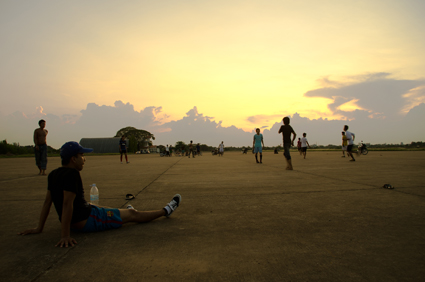
Battambang airport
photo Justin Lorenzon
Battambang airport
I AM AT BATTAMBANG AIRPORT IN NORTH-WESTERN CAMBODIA AS THE SETTING SUN GLOWS RED BEHIND A HAZE OF DUST AND SMOKE. SINCE THE ROADS TO THE NATION’S CAPITAL, PHNOM PENH, HAVE BEEN IMPROVED THE AIRFIELD HAS BECOME A HANGOUT FOR THE CITY’S YOUTH.
I am learning to ride a motorbike but don’t get far down the runway before meeting Bo Rithy. He is one of the artists enjoying the Battambang artistic renaissance promoted by recent articles in the Cambodia Daily and the New York Times (Travel, Dec 18, 2011). But where does this scene come from and what are its most pressing challenges today?
With expanding international horizons Battambang’s artists are searching for the contemporary surrounded by, but cut off from, the past. Without direct access to the mannerisms of contemporary art there is a question as to exactly what being contemporary means.
A New York Times’ article in December last year advertised Battambang’s historic palimpsest of pagodas, colonial villas and 1960s Cambodian architecture. It also hailed two new artist-run initiatives, Sammaki and Make Maek, as building on the ancient artistic legacy of the town stretching back to Angkorean times. But at the basic level of skills it is not easy for Khmer artists to turn towards the past. With the suppression of traditional culture and killing of artists by the Khmer Rouge from 1975 to 1979, this history provides contemporary artists with little more than a backdrop or narrative against which to work, one that has been appropriated by French colonial, Khmer Rouge and contemporary governments alike.
“There isn’t any link between contemporary artists and older artists, but I want there to be a link between these two generations,” Theanly Chov, manager of Sammaki art space explains. The scission in Cambodia’s cultural history has recently been addressed by organisations such as Cambodian Living Arts through their efforts to reconnect living masters of traditional arts with young students, but this model has been most successful in reviving the performing arts.
Interestingly, I was often given the names of musicians when I asked people about their favourite Khmer artists. The New York Times article also cited a principally musical lineage of artists from Battambang, notably the 1960s singer Ros Sereysothea. I think this is less an affectation on the writer’s part than an indication of the importance of music in Cambodia, in particular the 1960s golden age of Cambodian pop that commands a nostalgic fascination to this day. But where are the artists?
There are two notable artists from Battambang who survived the Khmer Rouge regime and one of them holds the key to the Battambang art scene. Vann Nath survived in Phnom Penh’s S-21 camp by painting portraits of Pol Pot and later recorded scenes from S-21 in horrifying canvases. His name is now synonymous with a Phnom Penh-based artistic reappraisal of the Khmer Rouge period. Srey Bandol learnt to paint during the Khmer Rouge period in refugee camps on the Thai border and has taught in Battambang at the French-Cambodian art school Phare Ponleu Selpak (the Shining Light of Art) since 1994. The establishment of Phare has given hundreds of students a solid grounding in drawing and painting skills, leaving them hungry for “new techniques” when they graduate.
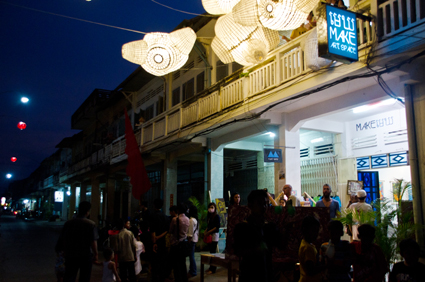
Artwalk, Make Maek Gallery
photo Justin Lorenzon
Artwalk, Make Maek Gallery
The focus of Phare’s visual arts program was evident at Battambang’s first art walk in February. Lights were hoisted into the air, colourful banners were posted outside shop fronts and tables were set up in the streets. Sammaki and Make Maek showed large collections of paintings and hosted performances from Phare’s circus school. Houses, shops and cafés on the main strip also set up easels to exhibit paintings by local artists.
“It is not hard to be an artist after school, but it is hard to find new techniques,” Rithy told me in his studio at Sammaki during the art walk. I often heard “new techniques” repeated with grail-like zeal. Artists do not always have computer skills, so there is not a widespread culture of looking online for new ideas. The exchange of ideas in Battambang happens face to face, with travel providing eye-opening opportunities for local artists. Robit Pen, a current student at Phare, has recently returned from an exchange in Nantes, in France. There he refined his technical skills and learned about art of the 20th century. Now he wants to make contemporary art, citing Pollock and Picasso as influences. Rithy has just returned from Japan where he was struck by the contrast between its bustling metropolises and cities seemingly abandoned after the tsunami. “Now I am busy thinking about Japan and art,” Rithy explains, “From now on I want to make big art, installations.” Rithy is part of the “second generation” of Phare graduates working in the wake of his older colleagues, the first wave from 2002, who set up the first artist-run spaces in Battambang and have been searching for new techniques for a decade now.
When artists do find a new way of making art they can meet with some resistance from the wider community. Long Loeurn, part of the first generation of Phare graduates, produces high definition photographs of paint dripping down blocks of ice. He performed his art at a pagoda in Phnom Penh during the Water Festival, when two to three million people descended on the city. Suspicious about what he was doing, police tried to stop him until the owners of the local Java café and gallery intervened. Elsewhere his mixing of colours has brought him under suspicion of witchcraft.
Without a tradition of artist-run initiatives in Battambang the organisation of Sammaki and Make Maek has not been easy. Katie Hallaran, one of the ex-pats who helps out at Sammaki, reports it is difficult to get artists to mind or clean the space and critical discussion of the artists’ own works is almost non-existent. Task sharing and finding time for open discussions are problems faced by any artist-run initiative, all the more so when you are building it yourself. There is no shortage of energy though. Mao Soviet, founder of Make Maek gallery, puts it well when he says, “I want Battambang to be the centre of art in Cambodia.” Battambang has an artistic history, but it is up to this generation to build an artistic tradition.
The art walk cited here was held in Battambang, Cambodia, February 3.
For more arts travels see the new online feature: RealTime Traveller
RealTime issue #108 April-May 2012 pg. 41
© Matthew Lorenzon; for permission to reproduce apply to realtime@realtimearts.net
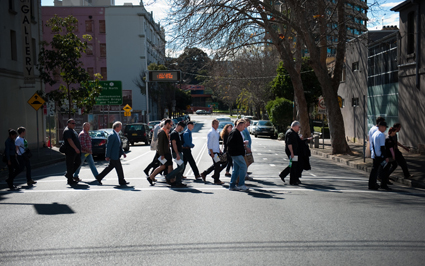
Green Bans Art Walk
photo Alex Wisser
Green Bans Art Walk
“ICI EST TOMBÉ POUR LA LIBÉRATION…”
It’s not difficult to describe the Green Ban Art Walks. They were a series of walks through Kings Cross and Woolloomooloo on five successive Saturday afternoons in August 2011. Celebrating 40 years since the first Builders Labourers Federation (BLF) bans, which saved much of the area from high-rise, the walks were sponsored by Performance Space and moved from Cross Art Projects down to Big Fag Press in Woolloomooloo.
Each walk began with a talk by a prominent urban activist of the time, while other former activists spoke at buildings, monuments and plaques along the way. In other words it resembled the architectural tourist walk so common around the world, except that many of the speakers had played a crucial part in the historical events that were being discussed. But where is the art part?
There was the obvious conventional historical connection. Victoria Street in particular has a long bohemian history with many artists living there since the late 19th century. In 1973 the hard edge painter Joe Szabo, for instance, lived in the most contested area of the street and organised an exhibition in support of the Green Ban. Other artists were active in the various resident action groups—the weaver Margaret Grafton was secretary of the Darlinghurst group and painter Vicki Varvaressos was an active member; the Victoria Street group’s Mick Fowler was a part-time jazz musician while conceptualist Dave Morrissey, cartoonist Jenny Coopes, author Sasha Soldatow and myself were all active there; Brenda Humble and Toby Zoates were involved at various times in Woolloomooloo.
In the late 1970s a Margel Hinder sculpture became a centrepiece of the Woolloomooloo public housing redevelopment while Michiel Dolk and Merilyn Fairskye led a group of painters, most of whom had lived in the area, in creating a series of murals on the railway pylons through the centre of Woolloomooloo.
The walks themselves were organised by artists, starting at Jo Holder’s Cross Art Projects gallery where prints by Fiona Macdonald based on local Green Ban imagery were part of the display, and terminating in Woolloomooloo at Big Fag Press where artists and walk co-ordinators Diego Bonetti, Lucas Ihlein, Mickie Quick and Pat Armstrong continue the tradition of artist involvement in the Woolloomooloo community.
All of this and more was discussed on the walk, yet somehow that just scratched the surface. It was clear that from its inception the walk itself was to be seen as art—after all it was being sponsored by Performance Space so surely there would be an element of performance in it?
If you regard art making as the process of generating meaning then the walks fitted the bill, almost too well. However, there is a sense in which a walk with meaning is a good walk ruined. We feel we should be able to merely observe and enjoy the scene without interpretation, or at least that’s what an “art for art’s sake” worldview would suggest.
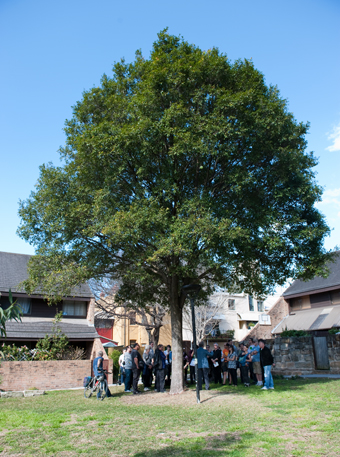
Green Bans Art Walk
photo Alex Wisser
Green Bans Art Walk
But this was not the aimless ramble of the flâneur, not the process of creating a personal map and mythology through exploration, nor was it the purposeful utilitarian walk to get from Point A to Point B. These walks were the process of imposing memory on an urban space, an almost ritualistic march through spaces loaded with historical meanings, even though they may seem to be comparatively esoteric in the eternal sunshine of our present real estate bubble.
And although walks in recent times have developed into an artistic genre of their own— mythogeography—since time immemorial they have been associated with memory, with monuments and the memorialisation of past events and people. The walk along the River Avon from Woodhenge to Stonehenge with the ashes of the year’s dead seems to have been the real reason for Stonehenge, and religious piety was manifested in the Way of St James, the great medieval Christian pilgrimage across most of Europe to Santiago de Compostela in Spain, or the Islamic Hajj that still brings millions to Mecca each year for the ritualistic circumambulation of the Ka’ba. In Australia it could probably be argued the song lines of Aboriginal migration routes memorialise the Dreamtime ancestors, while Anzac Day and May Day marches memorialise different types of political and social struggles.
It seems entirely appropriate that the Green Bans should be celebrated in walks, after all, marches and street demonstrations were so much a part of their process. The Green Ban and resident action group movements were a challenge to the idea that cities are owned by developers, rather than being a form of commons owned by the entire range of inhabitants. The struggle that followed, often an extremely violent struggle, aimed to defend not just the physical fabric and architectural heritage of Sydney but also to ensure a more equitable sharing of the city by all its inhabitants. Walking through Victoria Street, the scene of some of the most violent confrontations, and then down across Woolloomooloo, an area saved for public housing, demonstrated the movement’s range of successes and failures and also the way the movement itself accommodated a wide spectrum of social and class interests.
But finally, inherent in all this is a different understanding of the term “art.” At the time of the Green Bans only the most radical could conceive of art as anything other than individually created paintings and sculptures in galleries. In the 40 years since, our understanding has moved on and we can easily accept these walks as a form of cultural activity equally as legitimate as any painting, even though they are ephemeral events rather than objects, involve galleries only peripherally and are collaborative to the point where there are contributions by dozens of individuals—I have only named a small number of them here.
Yet I think there is another change occurring. Implicit in the art walks is not just the claim that the walks are art, but also that the events they memorialise were art—or at least an important and innovative form of cultural activity. Recognising that a series of events that are conventionally seen as political activism can be also be seen as art, implies that the official art world does not own culture any more than developers own the city.
In fact our culture´s constant process of innovation and adaptation is the work of all of us whether we call ourselves artists or not. It is only by cultural innovation that anyone can earn the title “artist,” and the BLF members’ cultural innovation in defence of a liveable city made them artists, probably the best artists of their era and greater than any of the shallow decorators we see celebrated in art museums.
At this point in human history, the cultural memes we have created, like consumerism and corporate capitalism, are beginning quite literally to destroy us, and probably much other life on the planet. This is exactly what the media tries to obscure with unrelenting propaganda, insisting that we live the best of all possible lives in the best of all possible systems, that any suggestion otherwise is crazy or treacherous. In the face of such propaganda, issues like cultural innovation are suddenly issues of survival. But there can only be change when there is an understanding that there has been change, that things were different in the past and can therefore be different in the future.
If you ignore the official cultural gatekeepers, it becomes clear that much of the time the most influential cultural players, the “artists,” are unrecognisable, anonymous even, and acting in groups, like the BLF members. If we understand that, then we also open a path to future action—they took control of the city once and we can do it again, and we can take control of other things like the media and the museums. By walking through areas they saved, recognising what they did and documenting and celebrating it, we enact a memorial to them but we also enact a memorial to ourselves because it is our city, this is part of the process of re-occupying it. Every last anonymous one of us can fight back against the destructive values of consumption, greed and narcissism that are constantly impressed upon us by the media and the profiteers bent on private control and ownership of what should be a shared world.
If events like the walks can help to keep alive the residents’ and builders labourers’ example of innovation and activism, then we also keep alive the possibility that we too could adapt our cultural memes into less toxic ones. We could help save civilisation simply by remembering that perhaps it can be saved because others also tried to.
“Ici est tombé pour la libération…” This text was commonly found on eye-level white plaques throughout Paris in memory of Resistance members killed there during the final days of the liberation of the city in the Second World War.
Green Bans Art Walk was a WALK project, part of Performance Space’s 2011 season of walks, promenades, marches and strolls in and around Sydney and beyond.
Performance Space, Big Fag Press, Cross Art Projects, First Draft Depot: Green Bans Art Walk, Sydney, Aug 6-27, 2011
RealTime issue #108 April-May 2012 pg. 42
© Ian Milliss; for permission to reproduce apply to realtime@realtimearts.net
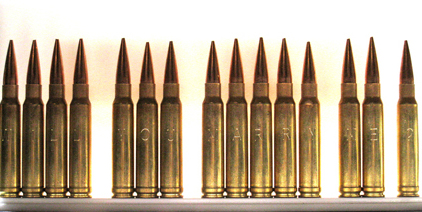
Tony Garifalakis, Anonymous
courtesy the artist
Tony Garifalakis, Anonymous
LOVE, REPRESENTATION AND POPULAR CULTURE ENTERED INTO A KNOTTY MÉNAGE À TROIS IN PROJECT 12: THIS IS NOT A LOVE SONG AT ANNA PAPPAS GALLERY IN MELBOURNE. EXPLORING WHAT LOVE IS AND ISN’T, FROM THE IMPASSIONED TO THE ETHEREAL AND THE ILLUSIVE, 15 ARTISTS FROM AUSTRALIA AND ABROAD WERE BROUGHT TOGETHER BY CURATORS ANNA PAPPAS AND LAURA CASTAGNINI AND GIVEN LICENCE TO DEPICT, UNPICK AND REMAKE THE NOTION OF LOVE IN A RANGE OF MANIFESTATIONS.
While the work of artists like Sue Dodd and Salote Tawale touched darkly and disturbingly on the twisted desire of celebrity culture, others approached love with open-hearted curiosity and candour. Malcolm Whittaker’s extension of his A Lover’s Discourse project, titled Personal Classifieds 2012—What Would You Love Someone to Love About You?, takes the form of four documentary photos of subjects sourced through personals columns. To each he asked the question of the work’s title and with each photo their response is printed on a side panel. Audacious in its simplicity, the work is realist, voyeuristic and as straightforward as the kids’ toys on the carpet in one photo, or the tidy kitchen bench in another.
Heidi Holmes also takes a straightforward premise, creating an elegant ‘lover’s discourse’ from the list of names of the people she and her husband had sex with before they met one another. The two-column list (one for him and one for her) is accompanied by a recording, on headphones, of the conversation during which the list was written. At face value The List is humorous and light, and at the same time dignified by the clean white frame and gallery setting. But between the lines—lines like “I was not really keen but sorta keen” and names like “Chris…pregnancy scare” is a powerful sense of honesty and the nitty-gritty of sex coexisting—a ‘love’ infinitely more complex than what we think of when we think about love.
Romantic love is also the subject of Tony Garifalakis’ Anonymous. As clean and elegant as Holmes’ work, Anonymous consists of 15 bullets in a neat perspex display case, each engraved with a single capital letter to form the sentence “WILL YOU MARRY ME?” If physically beautiful objects, their soft-glowing gold and bronze colouring and perfection of form disturb. Phallic but also feminine, the coppery tips like unsheathed lipsticks. Though the obvious reading is a dark and conflicted one, the bullets look less like ammunition than carefully polished brightwork, to the extent that one wonders whether perhaps they deliver something other than destruction.
In the work of Garifalakis and Danae Valenza alike, the contradictory qualities of metal—its hardness and malleability, its seeming permanence and corrodability—become metaphors that evade easy interpretation. Valenza’s It’s Just a Matter of Deciding Where to Begin creates a synaesthetic relationship between three objects around the phrase of the work’s title. On the gallery wall, the text is engraved in reverse on a small brass plate while a music box plays the same phrase, translated into Braille on the metal scroll of the instrument. A ‘blind composition’ on paper—a series of painted dots suggesting Morse code, tickertape symbols or, of course, Braille—completes a trio that balances tactility and curiosity, evoking a sensuality that ultimately cannot be contained by its constituent media.
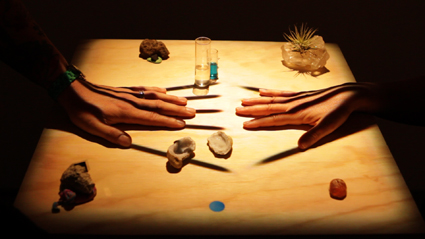
Zoe Scoglio with interaction designer Chris Heywood, Inter-radiessence
courtesy the artist
Zoe Scoglio with interaction designer Chris Heywood, Inter-radiessence
From Lucas Grogan’s enormous needlepoint Private Island and Darren Sylvester’s large-scale Lightjet prints to the intimacy of Meredith Turnbull and Ross Coulter’s almost ephemeral white stoneware in Love Wedge, the works in Project 12: This is Not A Love Song embody states of being from cynicism or nostalgia to spirituality and intimacy. Most arcane is the relational world created by Zoe Scoglio and Cait Foran in Inter-radiessence. On a plinth, under slightly twitching mauve light, a tiny landscape is created from small rocks, crystals, pieces of coloured plasticine and two small vials, one containing an eerie turquoise liquid. Two hand prints are marked out: a pair of viewers each places a hand on the outline, and then closes the circuit by placing their other hands together, over a blue dot.
Sound and light play differently for each new connection: in one, trembling shards of shadow or light grow out of fingertips and all the other objects, like crystals, creating a sense of identification with the ostensibly inanimate props. In other ‘incarnations,’ kaleidoscopic bands of colour or clouds of rainbow ‘dust’ appear—in one, tendrils of smoke seem to curl from the fingertips—all suggesting unseen energies brought to light. To a changing soundtrack of chirpy, thunderous or eerie tones, the work is both playful and finely wrought, and a fitting completion to the gamut of approaches to the theme.
Project 12: This Is Not a Love Song, artists Marco Paulo Rollo, Salote Tawale, Ben Coonley, Darren Sylvester, Heidi Holmes, Malcolm Whittaker, Zoe Scoglio and Cait Foran, Tony Garifalakis, Danae Valenza, Sue Dodd, Lucas Grogan, Irene Hanenbergh, Meredith Turnbull and Ross Coulter; Anna Pappas Gallery, Melbourne, Feb 7-March 10
RealTime issue #108 April-May 2012 pg. 44
© Urszula Dawkins; for permission to reproduce apply to realtime@realtimearts.net
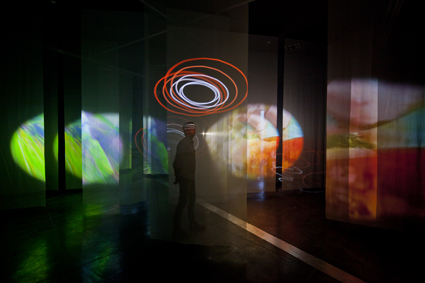
Pipilotti Rist: I Packed the Postcard in My Suitcase, 2011
photo Andrew Curtis
Pipilotti Rist: I Packed the Postcard in My Suitcase, 2011
IN THE LARGE CENTRE ROOM AT ACCA, ENORMOUS AMOEBIC BLUE BLOBS ARE CAREFULLY PAINTED ONTO AVOCADO WALLS, THEIR RANDOM BUT FAMILIAR SHAPES REPEATED ON TWO LARGE SCREENS WHICH FACE DIRECTLY DOWN FROM THE CEILING. VISITORS TO THE GALLERY ARE PASSIVELY DIRECTED TO LIE DOWN AND LOOK UP, SPRAWLED OVER THE HUMAN-SHAPED BLOBS CREATED BY ISLANDS OF TIERED CARPET, EACH SUCCESSIVE LAYER SMALLER THAN THE LAST SO THAT THE WHOLE SEEMS LIKE A SERIES OF TOPOGRAPHIC LINES.
It’s an elaborate and carefully constructed decor, reminiscent of some 70s pleasure-pad, the random shapes and textured pile evoking psychedelic dreams. But the ‘art’ is on the screens above: from below we look up at a video which looks down from above, the camera stalking a woman as she walks, climbs trees, drops her bundle of small red balls—are they fruit, are they artifice? The colour is lush, almost unreal, and things keep changing. Surfaces break and swim under swathes of hair or kelp. We surrender, passive and pacified, to an endlessly morphing series of images, elements and colours, as mesmerising and as mutable as the Northern Lights, and in many ways as inscrutable.
Gravity Be My Friend (2007) is one of several works in I Packed the Postcard in My Suitcase, the first major Australian survey of Swiss artist Pipilotti Rist’s work. The opening line of Juliana Engberg’s catalogue essay sums up the almost naïve flavour that infuses Rist’s work: “Welcome to the wonderful worlds of Pipilotti Rist.” Engberg describes “fantasy worlds born of the poetic psyche” which are “gorgeous and generous,” “ecstatic,” and “restorative.” In other words, Rist’s is a world where pleasure is privileged: while the technology and Rist’s virtuosic video composition are crucial, the purpose seems ultimately to be revelry ahead of revelation.
Rist herself speaks of “freeing the image,” “mixing it with your body, with the rooms.” Describing the gallery as “a collective living room where people meet,” she creates in it “a manual for the people to do it themselves.” “I hope,” she says, “[that] people will go home and put their flat screens on the ceiling.”
There’s an unfamiliar and perhaps refreshing artlessness in the statement. More familiar and perhaps more satisfying than the admittedly joyous hallucinations of Gravity Be My Friend are the two works first seen on entering the exhibition: one, a framed painting of a tourist view of Venice, overlaid with video; the other the polished surface of a dining table on which rich projections play.
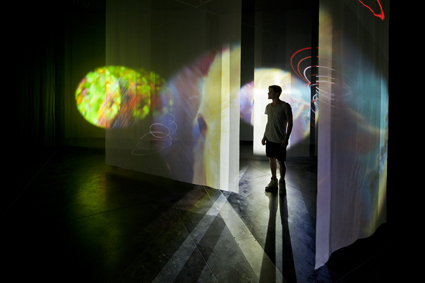
Pipilotti Rist: I Packed the Postcard in My Suitcase, 2011
photo Andrew Curtis
Pipilotti Rist: I Packed the Postcard in My Suitcase, 2011
Small Laguna (2011) begins with the taken-for-granted ‘frozen’ memory of a place—a framed oil painting of Venice—and overlays it with Rist’s eternally fluid images and colours. A cluster of cherry blossom competes with a raw red sausage; a naked, dancing woman in what seems a stark hospital room gives way to tunnels of mysterious fibre, or lush, veined lips, or wisps of smoke. The images are applied to the ‘canvas’ with the precision of a brush—it’s as though Rist determines to take the trope of a flattened and singular memory and confound it with myriad ‘real’ memories: the constant stream of visual images experienced by everyone, all the time, whose viscerality and plenitude are erased by default in every representation we manage to make.
At the dining table, with its sparse setting of dishes and wine glasses, the moving pool of light morphs from kaleidoscopic patterns to birthday candles to what seem like petals of blue gas flame. Under dim ambient light there’s a sense of the table itself beginning to move and play also; the colours catch in the glasses and seem to animate them. Upside Down Table (2011) is unsettling: a familiar domestic setting, but one where the lush play of mind-images points to a rift between the imaginative and the grounded. Rather than immersing the viewer, it shines uncanny light on the limits of freedom to a soundtrack that seems to echo conversations, muzak and the objects that form the video’s constant play.
If the sequence of the exhibition leads initially from an uncanny overlap of material and immaterial to the supine and sublime immersion of Gravity…, the immersion is completed in the third room, where drifts of voile fabric capture vignettes of pastoral scenes, graphics like smoke rings and curious breezes. Free to wander in the midst of Rist’s visuals, the visitor is, theoretically, completely within the saturated mindscape of Administrating Eternity (2011); at the same time, the tactility and the necessity to return to the body, to walk, to touch, are preparation for the final room in Rist’s series of spaces.
Entitled I Couldn’t Agree with You More (1999), this last room zooms both in and out, strangely stark: one wall of the space is taken up by a screen on which a woman walks around a supermarket, the camera solipsistically turned on herself and the shelves disorientingly slipping by, filled with products to replace the now-expected cornucopia of luscious and colourful images. Superimposed on the woman’s forehead is a vignetted film in miniature—a series of men and women, like forest-creatures, who seem to enact a clumsy, primal love-chase around her mind. Created well before the other works in the exhibition, this piece seems a seed: a suggestion of the stories within stories formed by the interplay of memory, imagination and banal reality which balloon to ecstatic proportions in the more recent work.
Unlike much contemporary video work, I Packed the Postcard in My Suitcase seems for the most part to sidestep interpretation and intellectuality in favour of unapologetic hedonism. I’m reminded of Linda Dement’s statement that her aim is “to give form to the unbearable.” Pipilotti Rist’s work seems to take an opposing but complementary trajectory, intent on going beyond words to a poetic realm and giving deliberate form to the pleasurable. But it is the slightly unsettling works—the almost-trembling dining table and the weird interior/exterior of the supermarket scene—that have deepest resonance. There is a sense that these are the places where we are allowed to think rather than simply feel. Not captive in the television-like, psychedelic lure of Gravity Be My Friend, the real wonder in these first and last seen works lies in the fragments we cannot quite absorb and must participate in to apprehend; and their suggestion both that imagination is uncontainable and that it inevitably affects and changes what’s around it.
Pipilotti Rist, I Packed the Postcard in My Suitcase, Australian Centre for Contemporary Art (ACCA), Melbourne, Dec 21, 2011-March 4, 2012
RealTime issue #108 April-May 2012 pg. 45
© Urszula Dawkins; for permission to reproduce apply to realtime@realtimearts.net
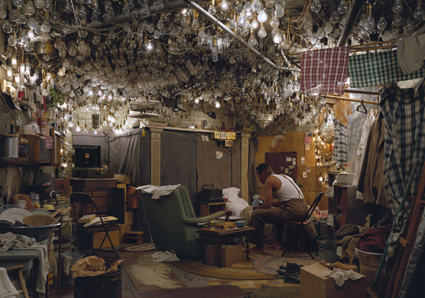
After ‘Invisible Man’ by Ralph Ellison, the Prologue, 1999-2000
photo by and © Jeff Wall
After ‘Invisible Man’ by Ralph Ellison, the Prologue, 1999-2000
jeff wall
A retrospective of the works of inventive Canadian photo-based artist and writer Jeff Wall is cause for celebration. An initiative of the Art Gallery of WA (in association with the National Gallery of Victoria) this first Australian survey of Wall’s work brings together 26 of his luminous and largely life-sized images. Jeff Wall will also be in situ for a time, in conversation with AGWA’s Chief Curator Gary Dufour at 2pm on Sunday May 27. “For Wall, the event depicted, formal composition and poetics are always important and in combination create works that extend photography as a medium and test the limits of ‘near’ documentary and conjectures built on memories. All of Jeff Wall’s photographs create distinctive imaginative new pictorial realities” (AGWA media release).
Jeff Wall Photographs, AGWA, May 26-September 10; transferring to NGV in November and to Sydney’s MCA in 2013
skater
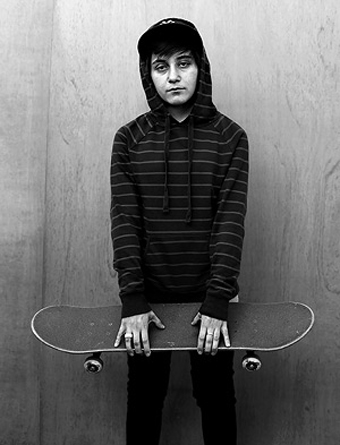
Esther Godoy, Fitzroy, Melbourne, Australia 2010
photo Nikki Toole
Esther Godoy, Fitzroy, Melbourne, Australia 2010
Skater: at The National Portrait Gallery in Canberra offers a more intimate selection of images by Melbourne photographer Nikki Toole who for the last three years has been collecting images of skateboarders around the world. She observes, “Many skaters speak of a solitary mind space while skating; of entering into another state of consciousness. To make these portraits I asked the skaters to place themselves within this meditative space.” This exhibition is a partnership between the National Portrait Gallery and Geelong Gallery.
Skater: Portraits by Nikki Toole, National Portrait Gallery until May 2 and at Geelong Gallery? June 30-September 9
RealTime issue #108 April-May 2012 pg. 46
© RealTime ; for permission to reproduce apply to realtime@realtimearts.net
In this frank and entertaining interview Jon Rose talks with fellow musician and improviser Jim Denley about his early instruments, his relationship to the Australian landscape and what really makes him play. www.jonroseweb.com
You can find a written version of this interview here.
For more artv interviews see the artv vimeo channel
related articles
post impressions
hollis taylor’s book about an epic fence-playing journey
RealTime issue #82 Dec-Jan 2007 pg. 40
the sound of bicycles singing
shannon o'neill: jon rose & robin fox, pursuit
RealTime issue #90 April-May 2009 pg. 48
looping & shimmering
andrew harper: mona foma festival of art & music, hobart
RealTime issue #96 April-May 2010 pg. 40
new music: challenge as fun
matthew lorenzon, mona foma, hobart
RealTime issue #102 April-May 2011 pg. 5
vigorous exercise & a well-balanced diet
gail priest: the now now festival 2010
RealTime issue #96 April-May 2010 pg. 39
listening to history
jon rose’s 2007 peggy glanville-hicks address
RealTime issue #83 Feb-March 2008 pg. 46
the shame of growing old gracefully
gail priest: what is music? sydney
RealTime issue #94 Dec-Jan 2009
making instruments, ears, audiences
gail priest surveys the issues and events of the REV Festival
RealTime issue #49 June-July 2002 online exlusive
RealTime issue #108 April-May 2012 pg. web
© Jim Denley & Gail Priest; for permission to reproduce apply to realtime@realtimearts.net















































 A remarkable book about the film experience, ZONA is UK writer Geoff Dyer’s acclaimed personal account of his relationship with Andrei Tarkovsky’s classic film Stalker. As Dyer recounts the events of the film and evokes its imagery, he spins a web of rich associations with other films, the nature of cinema-going, growing up, his girlfriends, stories about the making of Stalker, the role of boredom in film, Tarkovskian suspense and much else. It’s also very funny, hypercritical of other people’s favourite films (including Tarkovsky’s Nostalghia) and informed by vast cultural knowledge. As Tom Redwood writes in this edition, “What Dyer has offered by piggybacking on a masterpiece is an extension of Tarkovsky’s artistic project, a quite literal fulfilment of the creative contract Tarkovsky makes with his (devoted) viewers whereby the artist obliges the audience to…think on, further than has been stated…[putting] the audience on a par with the artist” (see
A remarkable book about the film experience, ZONA is UK writer Geoff Dyer’s acclaimed personal account of his relationship with Andrei Tarkovsky’s classic film Stalker. As Dyer recounts the events of the film and evokes its imagery, he spins a web of rich associations with other films, the nature of cinema-going, growing up, his girlfriends, stories about the making of Stalker, the role of boredom in film, Tarkovskian suspense and much else. It’s also very funny, hypercritical of other people’s favourite films (including Tarkovsky’s Nostalghia) and informed by vast cultural knowledge. As Tom Redwood writes in this edition, “What Dyer has offered by piggybacking on a masterpiece is an extension of Tarkovsky’s artistic project, a quite literal fulfilment of the creative contract Tarkovsky makes with his (devoted) viewers whereby the artist obliges the audience to…think on, further than has been stated…[putting] the audience on a par with the artist” (see 








































 THE UNIVERSITY OF NEWCASTLE’S INTERNATIONAL SPACE TIME CONCERTO COMPETITION IS UPDATING ONE OF THE WORLD’S MOST PERSISTENTLY EXCITING MUSICAL GENRES FOR THE 21ST CENTURY.
THE UNIVERSITY OF NEWCASTLE’S INTERNATIONAL SPACE TIME CONCERTO COMPETITION IS UPDATING ONE OF THE WORLD’S MOST PERSISTENTLY EXCITING MUSICAL GENRES FOR THE 21ST CENTURY. 
































































 AFTER AN EXHAUSTIVE REVIEW PROCESS, WHICH INVOLVED SEVERAL ROUNDS OF CONSULTATIONS, AN ISSUES PAPER AND A DISCUSSION PAPER AND HUNDREDS OF SUBMISSIONS TO BOTH, THE AUSTRALIAN LAW REFORM COMMISSION HAS SEEN ITS FINAL REPORT ON THE ENQUIRY INTO AUSTRALIA’S CLASSIFICATION SYSTEM, THE FIRST FOR 20 YEARS, TABLED IN FEDERAL PARLIAMENT LAST MONTH.
AFTER AN EXHAUSTIVE REVIEW PROCESS, WHICH INVOLVED SEVERAL ROUNDS OF CONSULTATIONS, AN ISSUES PAPER AND A DISCUSSION PAPER AND HUNDREDS OF SUBMISSIONS TO BOTH, THE AUSTRALIAN LAW REFORM COMMISSION HAS SEEN ITS FINAL REPORT ON THE ENQUIRY INTO AUSTRALIA’S CLASSIFICATION SYSTEM, THE FIRST FOR 20 YEARS, TABLED IN FEDERAL PARLIAMENT LAST MONTH.









 IN THE LATE 1990S, PERFORMANCE STUDIES WAS DOMINATED BY DEBATES ABOUT ABSENCE, DISAPPEARANCE AND DISPLACEMENT. PERHAPS THE MOST FAMOUS TEXT TO EMERGE FROM THIS PERIOD WAS PEGGY PHELAN’S UNMARKED: THE POLITICS OF PERFORMANCE (1993), IN WHICH SHE PROPOSED THAT:
IN THE LATE 1990S, PERFORMANCE STUDIES WAS DOMINATED BY DEBATES ABOUT ABSENCE, DISAPPEARANCE AND DISPLACEMENT. PERHAPS THE MOST FAMOUS TEXT TO EMERGE FROM THIS PERIOD WAS PEGGY PHELAN’S UNMARKED: THE POLITICS OF PERFORMANCE (1993), IN WHICH SHE PROPOSED THAT: 
























